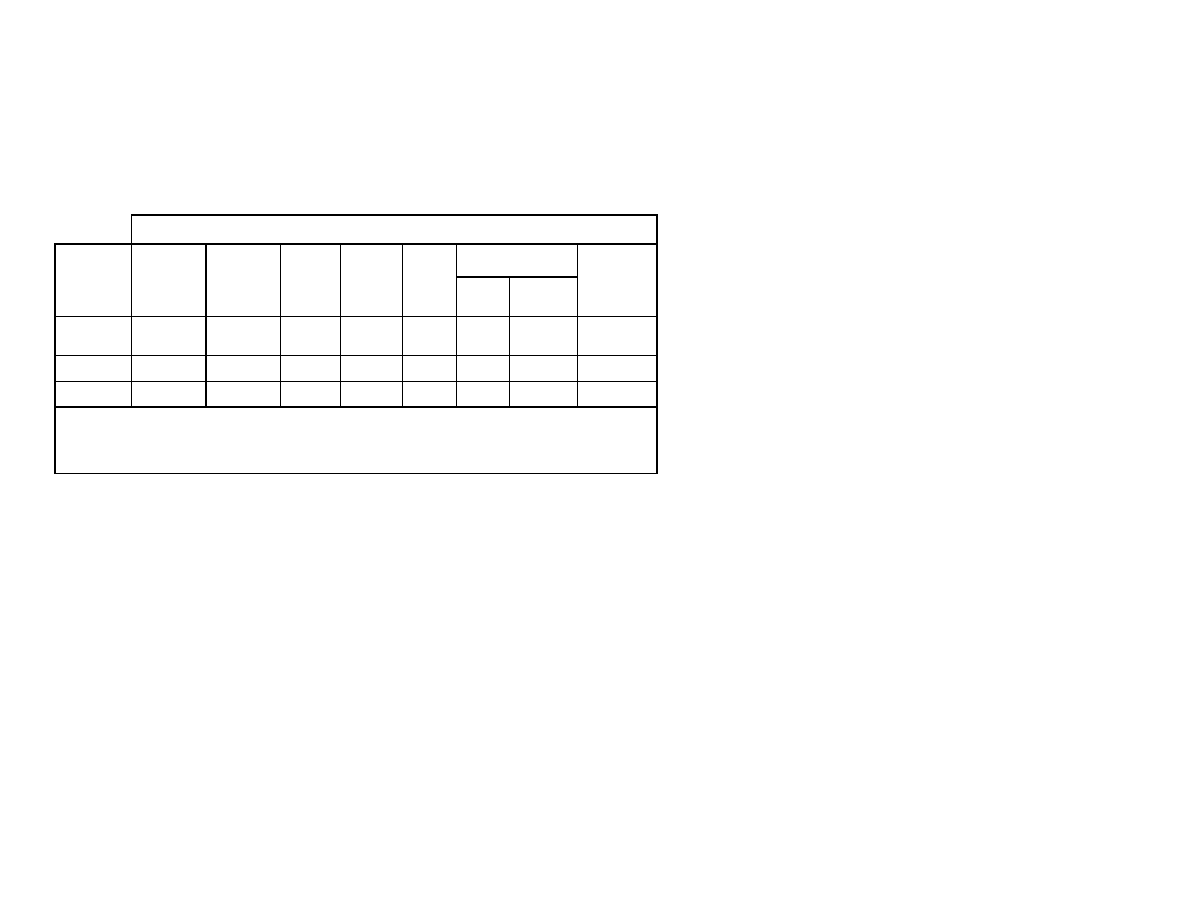
ALL USERS
This document will be replaced by the Command Support manual in the
near future. Until such time as
Staff Duties in the Field is officially
superceded, the keystone manual B-GL-300-003
Command shall take
precedence with respect to doctrinal Command and Control relationships.

B-GL-303-002/FP-000
OPERATIONAL STAFF PROCEDURES
VOLUME 2
STAFF DUTIES IN THE FIELD
(BILINGUAL)
WARNING
ALTHOUGH NOT CLASSIFIED, THIS PUBLICATION, OR ANY
PART OF IT, MAY BE EXEMPTED FROM DISCLOSURE TO
THE PUBLIC UNDER THE ACCESS TO INFORMATION ACT.
ALL ELEMENTS OF INFORMATION CONTAINED HEREIN
MUST BE CLOSELY SCRUTINIZED TO ASCERTAIN
WHETHER OR NOT THE PUBLICATION, OR ANY PART OF IT,
MAY BE RELEASED.
Issued on Authority of the Chief of the Defence Staff
Publiée avec l'autorisation du Chef d'état-major de la
Défense

B-GL-303-002/FP-000
OPERATIONAL STAFF PROCEDURES
VOLUME 2
STAFF DUTIES IN THE FIELD
(BILINGUAL)
(This publication supersedes B-GL-303-002/FP-002 Interim
2 dated Jun 1993 and B-GL-303-002/FP-003 Provisoire 2
dated Juin 1993)
WARNING
ALTHOUGH NOT CLASSIFIED, THIS PUBLICATION, OR ANY
PART OF IT, MAY BE EXEMPTED FROM DISCLOSURE TO
THE PUBLIC UNDER THE ACCESS TO INFORMATION ACT.
ALL ELEMENTS OF INFORMATION CONTAINED HEREIN
MUST BE CLOSELY SCRUTINIZED TO ASCERTAIN
WHETHER OR NOT THE PUBLICATION, OR ANY PART OF IT,
MAY BE RELEASED.
Issued on Authority of the Chief of the Defence Staff
Publiée avec l'autorisation du Chef d'état-major de la
Défense
OPI: NDHQ, DLFD 4-2
1995-02-15

B-GL-303-002/FP-000
LIST OF EFFECTIVE PAGES
Insert latest changed pages; dispose of superseded pages in accordance with
applicable orders.
NOTE
The portion of the text affected by the latest change is indicated
by a black vertical line in the margin of the page. Changes to
illustrations are indicated by miniature pointing hands or black
vertical lines.
Dates of issue for original and changed pages are:
Original . . . . . . . . . . . . . . . . .
0
. . . . . . . . . . . . . . . 1995-02-15
Zero in Change No. Column indicates an original page. Total number of pages
in this publication is 432 consisting of the following:
Page No.
Change No.
Page No.
Change No.
Title Page . . . . . . . . . . . . . . . . 0
A to C . . . . . . . . . . . . . . . . . . 0
i to xx
. . . . . . . . . . . . . . . . . . 0
1-1-1 to 1-1-2 . . . . . . . . . . . . . 0
1-2-1 to 1-2-4 . . . . . . . . . . . . . 0
1-3-1 to 1-3-4 . . . . . . . . . . . . . 0
1A-1 to 1A-2 . . . . . . . . . . . . . . 0
1B-1 to 1B-2 . . . . . . . . . . . . . . 0
1C-1 to 1C-16 . . . . . . . . . . . . . 0
2-1-1 to 2-1-4 . . . . . . . . . . . . . 0
2-2-1 to 2-2-4 . . . . . . . . . . . . . 0
2-3-1 to 2-3-4 . . . . . . . . . . . . . 0
2-4-1 to 2-4-2 . . . . . . . . . . . . . 0
2A-1 to 2A-2 . . . . . . . . . . . . . . 0
3-1-1 to 3-1-2 . . . . . . . . . . . . . 0
3-2-1 to 3-2-4 . . . . . . . . . . . . . 0
3-3-1 to 3-3-2 . . . . . . . . . . . . . 0
3-4-1 to 3-4-4 . . . . . . . . . . . . . 0
3A-1 to 3A-6 . . . . . . . . . . . . . . 0
3B-1 to 3B-6 . . . . . . . . . . . . . . 0
3C-1 to 3C-2 . . . . . . . . . . . . . 0
3C1-1/3C1-2 . . . . . . . . . . . . . . 0
4-1-1 to 4-1-2 . . . . . . . . . . . . . 0
4-2-1 to 4-2-6 . . . . . . . . . . . . . 0
4-3-1 to 4-3-4 . . . . . . . . . . . . . 0
4-4-1 to 4-4-4 . . . . . . . . . . . . . 0
4-5-1 to 4-5-4 . . . . . . . . . . . . . 0
4-6-1 to 4-6-4 . . . . . . . . . . . . . 0
4-7-1 to 4-7-8 . . . . . . . . . . . . . 0
4A-1/4A-2 to 4A-6 . . . . . . . . . . 0
4B-1 to 4B-4 . . . . . . . . . . . . . . 0
4C-1 to 4C-2 . . . . . . . . . . . . . 0
A

B-GL-303-002/FP-000
Page No.
Change No.
Page No.
Change No.
5-1-1 to 5-1-2 . . . . . . . . . . . . . 0
6-1-1 to 6-1-2 . . . . . . . . . . . . . 0
6-2-1 to 6-2-26 . . . . . . . . . . . . 0
7-1-1 to 7-1-2 . . . . . . . . . . . . . 0
7-2-1 to 7-2-2 . . . . . . . . . . . . . 0
7-3-1 to 7-3-4 . . . . . . . . . . . . . 0
7-4-1 to 7-4-2 . . . . . . . . . . . . . 0
7-5-1 to 7-5-2 . . . . . . . . . . . . . 0
7-6-1 to 7-6-2 . . . . . . . . . . . . . 0
7-7-1 to 7-7-2 . . . . . . . . . . . . . 0
8-1-1 to 8-1-4 . . . . . . . . . . . . . 0
8-2-1 to 8-2-2 . . . . . . . . . . . . . 0
8-3-1 to 8-3-6 . . . . . . . . . . . . . 0
8-4-1 to 8-4-4 . . . . . . . . . . . . . 0
8-5-1 to 8-5-2 . . . . . . . . . . . . . 0
8A-1/8A-2 to 8A-4 . . . . . . . . . . 0
8B-1 to 8B-4 . . . . . . . . . . . . . . 0
8C-1 to 8C-2 . . . . . . . . . . . . . 0
8C1-1 to 8C1-6 . . . . . . . . . . . . 0
8C2-1 to 8C2-6 . . . . . . . . . . . . 0
8D-1 to 8D-10 . . . . . . . . . . . . . 0
8D1-1 to 8D1-10 . . . . . . . . . . . 0
8E-1 to 8E-2 . . . . . . . . . . . . . . 0
8F-1 to 8F-6 . . . . . . . . . . . . . . 0
8F1-1 to 8F1-4 . . . . . . . . . . . . 0
8G-1 to 8G-2 . . . . . . . . . . . . . 0
8G1-1/8G1-2
. . . . . . . . . . . . . 0
9-1-1 to 9-1-4 . . . . . . . . . . . . . 0
9-2-1 to 9-2-8 . . . . . . . . . . . . . 0
9-3-1 to 9-3-2 . . . . . . . . . . . . . 0
9-4-1 to 9-4-12 . . . . . . . . . . . . 0
9-5-1 to 9-5-2 . . . . . . . . . . . . . 0
9-6-1 to 9-6-2 . . . . . . . . . . . . . 0
9-7-1 to 9-7-2 . . . . . . . . . . . . . 0
9A-1 to 9A-6 . . . . . . . . . . . . . . 0
9A1-1 to 9A1-2 . . . . . . . . . . . . 0
9A2-1 to 9A2-2 . . . . . . . . . . . . 0
9A3-1 to 9A3-2 . . . . . . . . . . . . 0
9A4-1 to 9A4-2 . . . . . . . . . . . . 0
9B-1 to 9B-2 . . . . . . . . . . . . . . 0
9B1-1 to 9B1-2 . . . . . . . . . . . . 0
9C-1 to 9C-16 . . . . . . . . . . . . . 0
9D-1 to 9D-2 . . . . . . . . . . . . . 0
9D1-1 to 9D1-6 . . . . . . . . . . . . 0
9D2-1 to 9D2-6 . . . . . . . . . . . . 0
9D3-1 to 9D3-10 . . . . . . . . . . . 0
9D4-1 to 9D4-6 . . . . . . . . . . . . 0
9D5-1 to 9D5-6 . . . . . . . . . . . . 0
9D6-1 to 9D6-6 . . . . . . . . . . . . 0
9D7-1 to 9D7-4 . . . . . . . . . . . . 0
9D8-1 to 9D8-6 . . . . . . . . . . . . 0
9D9-1 to 9D9-2 . . . . . . . . . . . . 0
9D10-1 to 9D10-4 . . . . . . . . . . 0
9E-1 to 9E-2 . . . . . . . . . . . . . . 0
9F-1 to 9F-12 . . . . . . . . . . . . . 0
9G-1/9G-2 . . . . . . . . . . . . . . . 0
9H-1 to 9H-4 . . . . . . . . . . . . . 0
9I-1 to 9I-4 . . . . . . . . . . . . . . . 0
9J-1 to 9J-4 . . . . . . . . . . . . . . 0
9K-1 to 9K-14 . . . . . . . . . . . . . 0
9L-1/9L-2 . . . . . . . . . . . . . . . . 0
Contact Officer: DLFD 4-2
© 1995 DND/MDN Canada
B

B-GL-303-002/FP-000
THIS PAGE IS INTENTIONALLY LEFT BLANK
C

B-GL-303-002/FP-000
PREFACE
GENERAL
1.
B-GL-303-002/FP-000, Operational Staff Procedures, Volume 2, Staff
Duties in the Field, is issued on the authority of the Chief of the Defence Staff. It
is effective upon receipt.
2.
This manual supersedes B-GL-303-002/FP-002, Interim 2, Operational
Staff Procedures, Volume 2, Staff Duties in the Field, dated June 1993 and
B-GL-303-002/FP-003 Provisoire 2 dated Juin 1993 which should be destroyed.
AIM
3.
The aim of Staff Duties in the Field is to describe procedures for staff
work prepared in support of field training exercises and for the planning and
conduct of land force operations.
SCOPE
4.
Staff Duties in the Field, with its associated supplements, is the primary
reference manual for Army officers appointed to the staff. It explains the role and
organization of formation staffs and headquarters in the field and the conduct of
routine staff activities prior to and during field deployments. It provides direction
on the preparation of written staff work, including estimates, orders, map marking
and abbreviations. The main volume also sets forth the relationship between
branches of the general staff, the special staff and the staffs of the arms and
service advisers. The following publications are supplements to Staff Duties in the
Field:
a. Supplement 1, Military Symbols - B-GL-303-002/FP-Z01;
b. Supplement 2, Field Message Formats - B-GL-303-002/FP-Z02;
c. Supplement 3, Army Vocabulary - B-GL-303-002/JX-Z03;
d. Supplement 4, Field Artillery Vocabulary - B-GL-303-002/FP-Z04;
e. Supplement 5, Armour Vocabulary - B-GL-303-002/JX-Z05;
i

B-GL-303-002/FP-000
f. Supplement 6, Signals Vocabulary - B-GL-303-002/JX-Z06;
g. Supplement 7, Field Engineer Vocabulary - B-Gl-303-002/JX-Z07; and
h. Supplement 8, Air Defence Artillery Vocabulary - B-GL-303-002/JX-Z08.
APPLICATION
5.
The focus of Staff Duties in the Field is the division operating in war;
however, its provisions are equally relevant at other formation levels. Portions of
the text provide detail that may be required at unit levels.
6.
Although the words in the Field are used in its title, Staff Duties in the
Field has equal application to staff activity carried out in garrison.
CONTEXT
7.
Staff Duties in the Field should be read in the context of operations
outlined in B-GL-300-000/FP-000, The Army; B-GL-301-001/FP-001, Land
Formations in Battle; and B-GL-301-002/FP-001, The Battle Group in Operations.
8.
Words are used in accordance with the Concise Oxford Dictionary or
B-GL-303-002/JX-Z03, Supplement 3, the Army Vocabulary. The provisions of this
manual are consistent with A-AD-121-C01/FP-000 Staff and Writing Procedures for
the Department of National Defence and the Canadian Forces.
DEFINITIONS
9.
Throughout Staff Duties in the Field, the following words have particular
meanings:
a. may is permissive;
b. shall is imperative;
c. should is informative;
d. practicable means physically possible;
e. practical means reasonable under the circumstances;
ii

B-GL-303-002/FP-000
f. intend signifies an act that shall be carried out unless countermanded by
a higher authority; and
g. propose suggests a course of action for consideration by a commander.
Unless approved, it will not be carried out.
INTERNATIONAL AGREEMENTS
10.
The following international standardization agreements have been wholly
or partially incorporated into this volume:
SERIAL
STANAG
QSTAG
TITLE
1
1001 Ed 1
Standardized System of Numbering Days
and Hours in Relation to an Operation or
Exercise
2
1059 Ed 5
National Distinguishing Letters for Use by
NATO Forces
3
2003 Ed 6,
Amdt 5
502
Patrol Reports
4
2014 Ed 7,
Amdt 1
506
Amdt 4
Operation Orders, Warning Orders and
Administrative/Logistics Orders
5
243
Surveillance (Including Night Observation)
Plan Annex to an Operation Order
6
2017 Ed 3,
Amdt 5
508
Ed 3
Amdt 1
Orders to the Demolition Guard Commander
and Demolition Firing Party Commander
(Non Nuclear)
7
2022 Ed 8,
Amdt 1
Intelligence Reports
8
2029 Ed 7,
Amdt 2
514
Method of Describing Ground Locations,
Areas and Boundaries
9
2066 Ed 5
Layout for Military Correspondence
iii

B-GL-303-002/FP-000
SERIAL
STANAG
QSTAG
TITLE
10
2101 Ed 8
533
Establishing Liaison
Principles and Procedures for Establishing
Liaison
11
163
Ed 2
Military Abbreviations
12
894
Amdt 1
NATO Glossary of Terms and Definitions
11.
The following international publications are related to this manual and its
supplements and are used in conjunction with them:
a. AAP 6, The NATO Glossary of Terms and Definitions in English and
French;
b. APP 6, Military Symbols for Land Based Units; and
c. AAP 15, Glossary of Abbreviations used in NATO documents.
CHANGES
12.
Proposals for amendments should be forwarded through normal channels
to the Secretariat, Army Doctrine and Tactics Board, Headquarters Land Force
Command.
iv

B-GL-303-002/FP-000
RECORD OF CHANGES
Identification of Change
Date Entered
Signature
Change No.
Date
v

B-GL-303-002/FP-000
THIS PAGE IS INTENTIONALLY LEFT BLANK
vi

B-GL-303-002/FP-000
CONTENTS
PAGE
CHAPTER 1 - ROLE AND ORGANIZATION OF THE STAFF
. . . . . . . . 1-1-1
Section 1 - Role . . . . . . . . . . . . . . . . . . . . . . . . . . . . . . . . . . . . . . . . . 1-1-1
Command and Staff . . . . . . . . . . . . . . . . . . . . . . . . . . . . . . . . . . . . . . 1-1-1
Authority . . . . . . . . . . . . . . . . . . . . . . . . . . . . . . . . . . . . . . . . . . . . . . . 1-1-1
Responsibility . . . . . . . . . . . . . . . . . . . . . . . . . . . . . . . . . . . . . . . . . . . 1-1-1
Section 2 - Organization . . . . . . . . . . . . . . . . . . . . . . . . . . . . . . . . . . . 1-2-1
Staff Categories . . . . . . . . . . . . . . . . . . . . . . . . . . . . . . . . . . . . . . . . . 1-2-1
Basic Organization of the General Staff . . . . . . . . . . . . . . . . . . . . . . . . 1-2-1
Advisers . . . . . . . . . . . . . . . . . . . . . . . . . . . . . . . . . . . . . . . . . . . . . . . 1-2-2
Organization of the Staff . . . . . . . . . . . . . . . . . . . . . . . . . . . . . . . . . . . 1-2-3
Duties of Staff Branches . . . . . . . . . . . . . . . . . . . . . . . . . . . . . . . . . . . 1-2-3
Section 3 - Responsibilities of Staff and Signals . . . . . . . . . . . . . . . . . . 1-3-1
General . . . . . . . . . . . . . . . . . . . . . . . . . . . . . . . . . . . . . . . . . . . . . . . 1-3-1
Responsibilities of the General Staff to Signals. . . . . . . . . . . . . . . . . . . 1-3-1
Responsibilities of Signals to the Staff . . . . . . . . . . . . . . . . . . . . . . . . . 1-3-3
ANNEXES
A
STAFF ORGANIZATION OF A DIVISION HEADQUARTERS
. . 1A-1
B
STAFF ORGANIZATION OF A BRIGADE GROUP
HEADQUARTERS . . . . . . . . . . . . . . . . . . . . . . . . . . . . . . . . . 1B-1
C
DUTIES AND RESPONSIBILITIES OF STAFF BRANCHES . . . 1C-1
CHAPTER 2 - ORGANIZATION, DEPLOYMENT AND
MOVEMENT OF A FORMATION HEADQUARTERS . . . . . . . . . . . . . . . 2-1-1
Section 1 - Components of a Headquarters . . . . . . . . . . . . . . . . . . . . . 2-1-1
General . . . . . . . . . . . . . . . . . . . . . . . . . . . . . . . . . . . . . . . . . . . . . . . 2-1-1
Main Headquarters . . . . . . . . . . . . . . . . . . . . . . . . . . . . . . . . . . . . . . . 2-1-1
vii

B-GL-303-002/FP-000
CONTENTS (CONT'D)
PAGE
Rear Headquarters . . . . . . . . . . . . . . . . . . . . . . . . . . . . . . . . . . . . . . . 2-1-2
Alternate Headquarters . . . . . . . . . . . . . . . . . . . . . . . . . . . . . . . . . . . . 2-1-2
Section 2 - Functional Groups . . . . . . . . . . . . . . . . . . . . . . . . . . . . . . . 2-2-1
General . . . . . . . . . . . . . . . . . . . . . . . . . . . . . . . . . . . . . . . . . . . . . . . 2-2-1
Command Group . . . . . . . . . . . . . . . . . . . . . . . . . . . . . . . . . . . . . . . . 2-2-1
Operations Group . . . . . . . . . . . . . . . . . . . . . . . . . . . . . . . . . . . . . . . . 2-2-1
Signal Group . . . . . . . . . . . . . . . . . . . . . . . . . . . . . . . . . . . . . . . . . . . 2-2-2
Section 3 - Deployment of a Headquarters . . . . . . . . . . . . . . . . . . . . . . 2-3-1
Siting . . . . . . . . . . . . . . . . . . . . . . . . . . . . . . . . . . . . . . . . . . . . . . . . . 2-3-1
Layout . . . . . . . . . . . . . . . . . . . . . . . . . . . . . . . . . . . . . . . . . . . . . . . . 2-3-1
Protection . . . . . . . . . . . . . . . . . . . . . . . . . . . . . . . . . . . . . . . . . . . . . . 2-3-3
Section 4 - Movement of a Headquarters . . . . . . . . . . . . . . . . . . . . . . . 2-4-1
General . . . . . . . . . . . . . . . . . . . . . . . . . . . . . . . . . . . . . . . . . . . . . . . 2-4-1
Sequence . . . . . . . . . . . . . . . . . . . . . . . . . . . . . . . . . . . . . . . . . . . . . . 2-4-1
Location of the Commander and Staff During a Move . . . . . . . . . . . . . . 2-4-2
ANNEX
A
LAYOUT OF A FORMATION HEADQUARTERS . . . . . . . . . . . 2A-1
CHAPTER 3 - ORGANIZATION OF STAFF WORK . . . . . . . . . . . . . . . . 3-1-1
Section 1 - Introduction . . . . . . . . . . . . . . . . . . . . . . . . . . . . . . . . . . . . 3-1-1
Co-operation of the Staff . . . . . . . . . . . . . . . . . . . . . . . . . . . . . . . . . . . 3-1-1
Fundamentals of Staff Work . . . . . . . . . . . . . . . . . . . . . . . . . . . . . . . . 3-1-1
Section 2 - The Operations Centre . . . . . . . . . . . . . . . . . . . . . . . . . . . . 3-2-1
General . . . . . . . . . . . . . . . . . . . . . . . . . . . . . . . . . . . . . . . . . . . . . . . 3-2-1
Responsibilities . . . . . . . . . . . . . . . . . . . . . . . . . . . . . . . . . . . . . . . . . . 3-2-1
viii

B-GL-303-002/FP-000
CONTENTS (CONT'D)
PAGE
Equipment . . . . . . . . . . . . . . . . . . . . . . . . . . . . . . . . . . . . . . . . . . . . . 3-2-1
Routine . . . . . . . . . . . . . . . . . . . . . . . . . . . . . . . . . . . . . . . . . . . . . . . 3-2-1
Section 3 - Briefings and Co-ordinating Conferences . . . . . . . . . . . . . . . 3-3-1
Briefings . . . . . . . . . . . . . . . . . . . . . . . . . . . . . . . . . . . . . . . . . . . . . . . 3-3-1
Co-ordinating Conferences . . . . . . . . . . . . . . . . . . . . . . . . . . . . . . . . . 3-3-1
Section 4 - War Diaries . . . . . . . . . . . . . . . . . . . . . . . . . . . . . . . . . . . . 3-4-1
General . . . . . . . . . . . . . . . . . . . . . . . . . . . . . . . . . . . . . . . . . . . . . . . 3-4-1
Preparation . . . . . . . . . . . . . . . . . . . . . . . . . . . . . . . . . . . . . . . . . . . . . 3-4-1
Content and Organization . . . . . . . . . . . . . . . . . . . . . . . . . . . . . . . . . . 3-4-1
Maintenance and Submission . . . . . . . . . . . . . . . . . . . . . . . . . . . . . . . 3-4-2
ANNEXES
A
STANDING OPERATING PROCEDURES FOR A
HEADQUARTERS . . . . . . . . . . . . . . . . . . . . . . . . . . . . . . . . . 3A-1
B
DOCUMENTS, EQUIPMENT AND STORES REQUIRED
IN AN OPERATIONS CENTRE . . . . . . . . . . . . . . . . . . . . . . . . 3B-1
C
OPERATIONS LOGS . . . . . . . . . . . . . . . . . . . . . . . . . . . . . . . 3C-1
APPENDIX
1
EXAMPLE OF ANNOTATED OPERATIONS
LOGS SHEET . . . . . . . . . . . . . . . . . . . . . . . . . . . 3C1-1/3C1-2
CHAPTER 4 - STAFF CO-ORDINATION OF OPERATIONS . . . . . . . . . 4-1-1
Section 1 - Warning for Movement . . . . . . . . . . . . . . . . . . . . . . . . . . . . 4-1-1
General . . . . . . . . . . . . . . . . . . . . . . . . . . . . . . . . . . . . . . . . . . . . . . . 4-1-1
Warning Procedure . . . . . . . . . . . . . . . . . . . . . . . . . . . . . . . . . . . . . . . 4-1-1
ix

B-GL-303-002/FP-000
CONTENTS (CONT'D)
PAGE
Section 2 - Control of Demolitions . . . . . . . . . . . . . . . . . . . . . . . . . . . . 4-2-1
General . . . . . . . . . . . . . . . . . . . . . . . . . . . . . . . . . . . . . . . . . . . . . . . 4-2-1
Definitions . . . . . . . . . . . . . . . . . . . . . . . . . . . . . . . . . . . . . . . . . . . . . 4-2-1
Duties and Responsibilities . . . . . . . . . . . . . . . . . . . . . . . . . . . . . . . . . 4-2-2
Planning Considerations . . . . . . . . . . . . . . . . . . . . . . . . . . . . . . . . . . . 4-2-3
Sequence for Firing a Reserved Demolition . . . . . . . . . . . . . . . . . . . . . 4-2-4
Section 3 - Co-ordination of Patrolling . . . . . . . . . . . . . . . . . . . . . . . . . 4-3-1
General . . . . . . . . . . . . . . . . . . . . . . . . . . . . . . . . . . . . . . . . . . . . . . . 4-3-1
Responsibilities . . . . . . . . . . . . . . . . . . . . . . . . . . . . . . . . . . . . . . . . . . 4-3-1
Planning . . . . . . . . . . . . . . . . . . . . . . . . . . . . . . . . . . . . . . . . . . . . . . . 4-3-2
Duties of the Officer Organizing Patrols . . . . . . . . . . . . . . . . . . . . . . . . 4-3-3
Debriefing . . . . . . . . . . . . . . . . . . . . . . . . . . . . . . . . . . . . . . . . . . . . . . 4-3-4
Section 4 - Liaison . . . . . . . . . . . . . . . . . . . . . . . . . . . . . . . . . . . . . . . 4-4-1
General . . . . . . . . . . . . . . . . . . . . . . . . . . . . . . . . . . . . . . . . . . . . . . . 4-4-1
Responsibility . . . . . . . . . . . . . . . . . . . . . . . . . . . . . . . . . . . . . . . . . . . 4-4-1
Selection of Liaison Officers . . . . . . . . . . . . . . . . . . . . . . . . . . . . . . . . 4-4-2
Composition and Equipment of Liaison Detachments . . . . . . . . . . . . . . 4-4-2
Support from the Host . . . . . . . . . . . . . . . . . . . . . . . . . . . . . . . . . . . . . 4-4-3
Access . . . . . . . . . . . . . . . . . . . . . . . . . . . . . . . . . . . . . . . . . . . . . . . . 4-4-3
Liaison Officers' Aide-Mémoire . . . . . . . . . . . . . . . . . . . . . . . . . . . . . . . 4-4-3
Section 5 - Relief of Combat Troops . . . . . . . . . . . . . . . . . . . . . . . . . . 4-5-1
Information Required . . . . . . . . . . . . . . . . . . . . . . . . . . . . . . . . . . . . . . 4-5-1
Control . . . . . . . . . . . . . . . . . . . . . . . . . . . . . . . . . . . . . . . . . . . . . . . . 4-5-2
Section 6 - Terrain Control . . . . . . . . . . . . . . . . . . . . . . . . . . . . . . . . . 4-6-1
General . . . . . . . . . . . . . . . . . . . . . . . . . . . . . . . . . . . . . . . . . . . . . . . 4-6-1
Responsibility . . . . . . . . . . . . . . . . . . . . . . . . . . . . . . . . . . . . . . . . . . . 4-6-1
Allocation of Terrain . . . . . . . . . . . . . . . . . . . . . . . . . . . . . . . . . . . . . . 4-6-1
x

B-GL-303-002/FP-000
CONTENTS (CONT'D)
PAGE
Control of Terrain Usage . . . . . . . . . . . . . . . . . . . . . . . . . . . . . . . . . . . 4-6-2
Resolution of Terrain Usage Conflicts. . . . . . . . . . . . . . . . . . . . . . . . . . 4-6-2
Section 7 - Scatterable Mines . . . . . . . . . . . . . . . . . . . . . . . . . . . . . . . 4-7-1
General . . . . . . . . . . . . . . . . . . . . . . . . . . . . . . . . . . . . . . . . . . . . . . . 4-7-1
Characteristics of SMs . . . . . . . . . . . . . . . . . . . . . . . . . . . . . . . . . . . . 4-7-1
Laid Life of SMs . . . . . . . . . . . . . . . . . . . . . . . . . . . . . . . . . . . . . . . . . 4-7-1
Employment . . . . . . . . . . . . . . . . . . . . . . . . . . . . . . . . . . . . . . . . . . . 4-7-2
Planning Considerations . . . . . . . . . . . . . . . . . . . . . . . . . . . . . . . . . . . 4-7-3
Control . . . . . . . . . . . . . . . . . . . . . . . . . . . . . . . . . . . . . . . . . . . . . . . . 4-7-5
Employment and Control Responsibilities . . . . . . . . . . . . . . . . . . . . . . . 4-7-5
Warning, Reporting and Recording . . . . . . . . . . . . . . . . . . . . . . . . . . . . 4-7-6
ANNEXES
A
EXAMPLE OF AN ORDER FOR A RESERVED
DEMOLITION . . . . . . . . . . . . . . . . . . . . . . . . . . . . . . . . . 4A-1/4A-2
B
AIDE-MÉMOIRE FOR LIAISON OFFICERS . . . . . . . . . . . . . . . 4B-1
C
SCATTERABLE MINEFIELD REPORT, RECORD AND
WARNING FORMAT
. . . . . . . . . . . . . . . . . . . . . . . . . . . . . . . 4C-1
CHAPTER 5 - AUTOMATION SUPPORT TO STAFF DUTIES . . . . . . . . 5-1-1
Section 1 - Introduction to ACIS . . . . . . . . . . . . . . . . . . . . . . . . . . . . . . 5-1-1
To be Published . . . . . . . . . . . . . . . . . . . . . . . . . . . . . . . . . . . . . . . . . 5-1-1
CHAPTER 6 - MILITARY WRITING . . . . . . . . . . . . . . . . . . . . . . . . . . . 6-1-1
Section 1 - Introduction . . . . . . . . . . . . . . . . . . . . . . . . . . . . . . . . . . . . 6-1-1
General . . . . . . . . . . . . . . . . . . . . . . . . . . . . . . . . . . . . . . . . . . . . . . . 6-1-1
Characteristics . . . . . . . . . . . . . . . . . . . . . . . . . . . . . . . . . . . . . . . . . . 6-1-1
Official Languages . . . . . . . . . . . . . . . . . . . . . . . . . . . . . . . . . . . . . . . 6-1-2
xi

B-GL-303-002/FP-000
CONTENTS (CONT'D)
PAGE
Section 2 - Conventions . . . . . . . . . . . . . . . . . . . . . . . . . . . . . . . . . . . 6-2-1
Word Use . . . . . . . . . . . . . . . . . . . . . . . . . . . . . . . . . . . . . . . . . . . . . . 6-2-1
Marking of Operational Classified Documents . . . . . . . . . . . . . . . . . . . . 6-2-3
Use of Numbers . . . . . . . . . . . . . . . . . . . . . . . . . . . . . . . . . . . . . . . . . 6-2-5
Page Numbering . . . . . . . . . . . . . . . . . . . . . . . . . . . . . . . . . . . . . . . . . 6-2-7
Addressing Correspondence . . . . . . . . . . . . . . . . . . . . . . . . . . . . . . . . 6-2-7
Urgent Marking . . . . . . . . . . . . . . . . . . . . . . . . . . . . . . . . . . . . . . . . . . 6-2-8
Copy Numbering . . . . . . . . . . . . . . . . . . . . . . . . . . . . . . . . . . . . . . . . . 6-2-8
Dates, Times and Time Zones . . . . . . . . . . . . . . . . . . . . . . . . . . . . . . . 6-2-8
Notes . . . . . . . . . . . . . . . . . . . . . . . . . . . . . . . . . . . . . . . . . . . . . . . . . 6-2-10
Tabular Information . . . . . . . . . . . . . . . . . . . . . . . . . . . . . . . . . . . . . . . 6-2-11
Signature Block Conventions . . . . . . . . . . . . . . . . . . . . . . . . . . . . . . . . 6-2-11
Supplementary Documents . . . . . . . . . . . . . . . . . . . . . . . . . . . . . . . . . 6-2-13
Description of Locations, Directions, Areas and Boundaries. . . . . . . . . . 6-2-15
Designation of Formations and Units . . . . . . . . . . . . . . . . . . . . . . . . . . 6-2-19
NATO and ABCA National Distinguishing Letters . . . . . . . . . . . . . . . . . 6-2-20
Designation of Days and Hours . . . . . . . . . . . . . . . . . . . . . . . . . . . . . . 6-2-20
Code Words and Nicknames . . . . . . . . . . . . . . . . . . . . . . . . . . . . . . . . 6-2-22
Short Titles and Acronyms . . . . . . . . . . . . . . . . . . . . . . . . . . . . . . . . . . 6-2-24
Cover Plans . . . . . . . . . . . . . . . . . . . . . . . . . . . . . . . . . . . . . . . . . . . . 6-2-25
Formats for Correspondence . . . . . . . . . . . . . . . . . . . . . . . . . . . . . . . . 6-2-25
CHAPTER 7 - MESSAGE PREPARATION . . . . . . . . . . . . . . . . . . . . . . 7-1-1
Section 1 - Introduction . . . . . . . . . . . . . . . . . . . . . . . . . . . . . . . . . . . . 7-1-1
General . . . . . . . . . . . . . . . . . . . . . . . . . . . . . . . . . . . . . . . . . . . . . . . 7-1-1
Responsibility . . . . . . . . . . . . . . . . . . . . . . . . . . . . . . . . . . . . . . . . . . . 7-1-1
Section 2 - Types of Messages . . . . . . . . . . . . . . . . . . . . . . . . . . . . . . 7-2-1
Single and Multiple Addresses . . . . . . . . . . . . . . . . . . . . . . . . . . . . . . . 7-2-1
Exercise . . . . . . . . . . . . . . . . . . . . . . . . . . . . . . . . . . . . . . . . . . . . . . . 7-2-1
xii

B-GL-303-002/FP-000
CONTENTS (CONT'D)
PAGE
Section 3 - Addressing . . . . . . . . . . . . . . . . . . . . . . . . . . . . . . . . . . . . 7-3-1
General . . . . . . . . . . . . . . . . . . . . . . . . . . . . . . . . . . . . . . . . . . . . . . . 7-3-1
Appointment Designators . . . . . . . . . . . . . . . . . . . . . . . . . . . . . . . . . . . 7-3-1
Address Indicating Group . . . . . . . . . . . . . . . . . . . . . . . . . . . . . . . . . . 7-3-2
Section 4 - Precedence . . . . . . . . . . . . . . . . . . . . . . . . . . . . . . . . . . . . 7-4-1
General . . . . . . . . . . . . . . . . . . . . . . . . . . . . . . . . . . . . . . . . . . . . . . . 7-4-1
Misuse . . . . . . . . . . . . . . . . . . . . . . . . . . . . . . . . . . . . . . . . . . . . . . . . 7-4-1
Section 5 - Reduction of Message Traffic Volume . . . . . . . . . . . . . . . . . 7-5-1
General . . . . . . . . . . . . . . . . . . . . . . . . . . . . . . . . . . . . . . . . . . . . . . . 7-5-1
Section 6 - Drafting . . . . . . . . . . . . . . . . . . . . . . . . . . . . . . . . . . . . . . . 7-6-1
Message Format . . . . . . . . . . . . . . . . . . . . . . . . . . . . . . . . . . . . . . . . . 7-6-1
Originator's Number . . . . . . . . . . . . . . . . . . . . . . . . . . . . . . . . . . . . . . 7-6-1
Message Handling Instructions . . . . . . . . . . . . . . . . . . . . . . . . . . . . . . 7-6-1
Subject Indicator Codes . . . . . . . . . . . . . . . . . . . . . . . . . . . . . . . . . . . 7-6-2
Repetition . . . . . . . . . . . . . . . . . . . . . . . . . . . . . . . . . . . . . . . . . . . . . . 7-6-2
Acknowledgements . . . . . . . . . . . . . . . . . . . . . . . . . . . . . . . . . . . . . . . 7-6-2
Section 7 - Additional Procedures . . . . . . . . . . . . . . . . . . . . . . . . . . . . 7-7-1
Cancellation . . . . . . . . . . . . . . . . . . . . . . . . . . . . . . . . . . . . . . . . . . . . 7-7-1
CHAPTER 8 - THE OPERATION PLANNING PROCESS,
ESTIMATES AND STAFF CHECKS . . . . . . . . . . . . . . . . . . . . . . . . . . . 8-1-1
Section 1 - The Operation Planning Process
. . . . . . . . . . . . . . . . . . . . 8-1-1
General . . . . . . . . . . . . . . . . . . . . . . . . . . . . . . . . . . . . . . . . . . . . . . . 8-1-1
Steps in the Operation Planning Process . . . . . . . . . . . . . . . . . . . . . . . 8-1-1
Section 2 - Mission Analysis . . . . . . . . . . . . . . . . . . . . . . . . . . . . . . . . 8-2-1
xiii

B-GL-303-002/FP-000
CONTENTS (CONT'D)
PAGE
Section 3 - Estimates of the Situation . . . . . . . . . . . . . . . . . . . . . . . . . . 8-3-1
General . . . . . . . . . . . . . . . . . . . . . . . . . . . . . . . . . . . . . . . . . . . . . . . 8-3-1
Aim . . . . . . . . . . . . . . . . . . . . . . . . . . . . . . . . . . . . . . . . . . . . . . . . . . 8-3-2
Factors . . . . . . . . . . . . . . . . . . . . . . . . . . . . . . . . . . . . . . . . . . . . . . . . 8-3-3
Courses . . . . . . . . . . . . . . . . . . . . . . . . . . . . . . . . . . . . . . . . . . . . . . . 8-3-3
Plan . . . . . . . . . . . . . . . . . . . . . . . . . . . . . . . . . . . . . . . . . . . . . . . . . . 8-3-4
Review . . . . . . . . . . . . . . . . . . . . . . . . . . . . . . . . . . . . . . . . . . . . . . . . 8-3-5
Section 4 - Types of Estimates . . . . . . . . . . . . . . . . . . . . . . . . . . . . . . 8-4-1
General . . . . . . . . . . . . . . . . . . . . . . . . . . . . . . . . . . . . . . . . . . . . . . . 8-4-1
Tactical Estimates . . . . . . . . . . . . . . . . . . . . . . . . . . . . . . . . . . . . . . . . 8-4-1
Intelligence Estimates . . . . . . . . . . . . . . . . . . . . . . . . . . . . . . . . . . . . . 8-4-1
Administrative Estimates . . . . . . . . . . . . . . . . . . . . . . . . . . . . . . . . . . . 8-4-2
Section 5 - Staff Checks . . . . . . . . . . . . . . . . . . . . . . . . . . . . . . . . . . . 8-5-1
General . . . . . . . . . . . . . . . . . . . . . . . . . . . . . . . . . . . . . . . . . . . . . . . 8-5-1
Methodology . . . . . . . . . . . . . . . . . . . . . . . . . . . . . . . . . . . . . . . . . . . . 8-5-1
ANNEXES
A
THE OPERATION PLANNING PROCESS . . . . . . . . . . . . 8A-1/8A-2
B
PLANNING DIRECTIVE OUTLINE
. . . . . . . . . . . . . . . . . . . . . 8B-1
C
NOTES ON THE FORMAT OF AN ESTIMATE OF
THE SITUATION . . . . . . . . . . . . . . . . . . . . . . . . . . . . . . . . . . 8C-1
APPENDIXES
1
LAYOUT OF A COMPLETE WRITTEN ESTIMATE OF
THE SITUATION . . . . . . . . . . . . . . . . . . . . . . . . . . . . . . 8C1-1
2
LAYOUT OF A SPLIT-PAGE ESTIMATE OF THE
SITUATION . . . . . . . . . . . . . . . . . . . . . . . . . . . . . . . . . . 8C2-1
xiv

B-GL-303-002/FP-000
CONTENTS (CONT'D)
PAGE
ANNEXES
D
NOTES ON TACTICAL ESTIMATES . . . . . . . . . . . . . . . . . . . . 8D-1
APPENDIX
1
TYPICAL DEDUCTIONS DRAWN FROM CONSIDERATION
OF MISSION AND FACTORS IN A TACTICAL
ESTIMATE . . . . . . . . . . . . . . . . . . . . . . . . . . . . . . . . . . 8D1-1
E
NOTES ON INTELLIGENCE ESTIMATES . . . . . . . . . . . . . . . . 8E-1
F
NOTES ON ADMINISTRATIVE ESTIMATES . . . . . . . . . . . . . . 8F-1
APPENDIX
1
TYPICAL FACTORS AND DEDUCTIONS IN AN
ADMINISTRATIVE ESTIMATE . . . . . . . . . . . . . . . . . . . . 8F1-1
G
DUMPING PROGRAMME STAFF CHECKS
. . . . . . . . . . 8G-1/8G-2
APPENDIX
1
EXAMPLE OF A DUMPING CALCULATIONS STAFF
CHECKS BY FIRST PRINCIPLES AND BY FORMULA
METHODS . . . . . . . . . . . . . . . . . . . . . . . . . . . . . . . . . . 8G1-1
CHAPTER 9 - ORDERS . . . . . . . . . . . . . . . . . . . . . . . . . . . . . . . . . . . 9-1-1
Section 1 - Introduction . . . . . . . . . . . . . . . . . . . . . . . . . . . . . . . . . . . . 9-1-1
General . . . . . . . . . . . . . . . . . . . . . . . . . . . . . . . . . . . . . . . . . . . . . . . 9-1-1
Types
. . . . . . . . . . . . . . . . . . . . . . . . . . . . . . . . . . . . . . . . . . . . . . . . 9-1-1
Contingency Plans/Orders . . . . . . . . . . . . . . . . . . . . . . . . . . . . . . . . . . 9-1-2
xv

B-GL-303-002/FP-000
CONTENTS (CONT'D)
PAGE
Section 2 - Grouping . . . . . . . . . . . . . . . . . . . . . . . . . . . . . . . . . . . . . . 9-2-1
Introduction . . . . . . . . . . . . . . . . . . . . . . . . . . . . . . . . . . . . . . . . . . . . 9-2-1
Fundamentals of Grouping . . . . . . . . . . . . . . . . . . . . . . . . . . . . . . . . . 9-2-1
Command and Control Relationships . . . . . . . . . . . . . . . . . . . . . . . . . . 9-2-2
Administrative Command Relationships . . . . . . . . . . . . . . . . . . . . . . . . 9-2-3
Combined Operations . . . . . . . . . . . . . . . . . . . . . . . . . . . . . . . . . . . . . 9-2-4
Combat Service Support in Combined Operations . . . . . . . . . . . . . . . . . 9-2-4
Further Delegation . . . . . . . . . . . . . . . . . . . . . . . . . . . . . . . . . . . . . . . 9-2-4
Timing . . . . . . . . . . . . . . . . . . . . . . . . . . . . . . . . . . . . . . . . . . . . . . . . 9-2-4
Precedence of Operational Relationships . . . . . . . . . . . . . . . . . . . . . . . 9-2-5
Section 3 - Warning Orders . . . . . . . . . . . . . . . . . . . . . . . . . . . . . . . . . 9-3-1
General . . . . . . . . . . . . . . . . . . . . . . . . . . . . . . . . . . . . . . . . . . . . . . . 9-3-1
Use . . . . . . . . . . . . . . . . . . . . . . . . . . . . . . . . . . . . . . . . . . . . . . . . . . 9-3-1
Content and Format . . . . . . . . . . . . . . . . . . . . . . . . . . . . . . . . . . . . . . 9-3-1
Section 4 - Operation Orders . . . . . . . . . . . . . . . . . . . . . . . . . . . . . . . . 9-4-1
General . . . . . . . . . . . . . . . . . . . . . . . . . . . . . . . . . . . . . . . . . . . . . . . 9-4-1
Written Operation Orders . . . . . . . . . . . . . . . . . . . . . . . . . . . . . . . . . . . 9-4-1
Fragmentary Orders . . . . . . . . . . . . . . . . . . . . . . . . . . . . . . . . . . . . . . 9-4-5
Oral Orders . . . . . . . . . . . . . . . . . . . . . . . . . . . . . . . . . . . . . . . . . . . . 9-4-6
Overlay Orders . . . . . . . . . . . . . . . . . . . . . . . . . . . . . . . . . . . . . . . . . . 9-4-9
Orders for Rear Area Security and Damage Control . . . . . . . . . . . . . . . 9-4-11
Section 5 - Instructions . . . . . . . . . . . . . . . . . . . . . . . . . . . . . . . . . . . . 9-5-1
General . . . . . . . . . . . . . . . . . . . . . . . . . . . . . . . . . . . . . . . . . . . . . . . 9-5-1
Use and Content . . . . . . . . . . . . . . . . . . . . . . . . . . . . . . . . . . . . . . . . 9-5-1
Section 6 - Administrative Orders . . . . . . . . . . . . . . . . . . . . . . . . . . . . . 9-6-1
General . . . . . . . . . . . . . . . . . . . . . . . . . . . . . . . . . . . . . . . . . . . . . . . 9-6-1
Content and Preparation . . . . . . . . . . . . . . . . . . . . . . . . . . . . . . . . . . . 9-6-1
xvi

B-GL-303-002/FP-000
CONTENTS (CONT'D)
PAGE
Presentation . . . . . . . . . . . . . . . . . . . . . . . . . . . . . . . . . . . . . . . . . . . . 9-6-2
Format . . . . . . . . . . . . . . . . . . . . . . . . . . . . . . . . . . . . . . . . . . . . . . . . 9-6-2
Section 7 - Movement Orders . . . . . . . . . . . . . . . . . . . . . . . . . . . . . . . 9-7-1
General . . . . . . . . . . . . . . . . . . . . . . . . . . . . . . . . . . . . . . . . . . . . . . . 9-7-1
Presentation and Format . . . . . . . . . . . . . . . . . . . . . . . . . . . . . . . . . . . 9-7-1
Preparation and Content . . . . . . . . . . . . . . . . . . . . . . . . . . . . . . . . . . . 9-7-1
ANNEXES
A
COMMAND AND CONTROL RELATIONSHIPS . . . . . . . . . . . . 9A-1
APPENDIXES
1
COMMAND RELATIONSHIPS USED IN GROUPING
FOR LAND OPERATIONS . . . . . . . . . . . . . . . . . . . . . . . 9A1-1
2
COMMAND RELATIONSHIPS USED IN GROUPING
AVIATION ELEMENTS WITH LAND UNITS AND
FORMATIONS . . . . . . . . . . . . . . . . . . . . . . . . . . . . . . . . 9A2-1
3
FIELD ARTILLERY TACTICAL TASKS AND
RESPONSIBILITIES
. . . . . . . . . . . . . . . . . . . . . . . . . . . 9A3-1
4
AIR DEFENCE ARTILLERY TACTICAL TASKS AND
RESPONSIBILITIES
. . . . . . . . . . . . . . . . . . . . . . . . . . . 9A4-1
B
COMMAND RELATIONSHIPS FOR COMBINED
OPERATIONS . . . . . . . . . . . . . . . . . . . . . . . . . . . . . . . . . . . . 9B-1
APPENDIX
1
COMPARISON OF NATIONAL AND MULTINATIONAL
COMMAND RELATIONSHIPS
. . . . . . . . . . . . . . . . . . . . 9B1-1
C
FORMAT FOR A WRITTEN OPERATION ORDER . . . . . . . . . . 9C-1
D
FORMATS FOR ANNEXES TO OPERATION ORDERS . . . . . . 9D-1
xvii

B-GL-303-002/FP-000
CONTENTS (CONT'D)
PAGE
APPENDIXES
1
FORMATS FOR AN INTELLIGENCE ANNEX TO
AN OPERATION ORDER . . . . . . . . . . . . . . . . . . . . . . . . 9D1-1
2
FORMAT FOR A SURVEILLANCE AND TARGET
ACQUISITION ANNEX TO AN OPERATION ORDER
. . . 9D2-1
3
FORMAT FOR A FIRE SUPPORT ANNEX TO
AN OPERATION ORDER . . . . . . . . . . . . . . . . . . . . . . . . 9D3-1
4
FORMAT FOR AN ENGINEER ANNEX TO
AN OPERATION ORDER . . . . . . . . . . . . . . . . . . . . . . . . 9D4-1
5
FORMAT FOR A COMMUNICATION-ELECTRONICS
ANNEX TO AN OPERATION ORDER . . . . . . . . . . . . . . . 9D5-1
6
FORMAT FOR AN ELECTRONIC WARFARE TO
AN OPERATION ORDER . . . . . . . . . . . . . . . . . . . . . . . . 9D6-1
7
FORMAT FOR A SERVICE SUPPORT ANNEX TO
AN OPERATION ORDER . . . . . . . . . . . . . . . . . . . . . . . . 9D7-1
8
FORMAT FOR A MOVEMENT ANNEX TO
AN OPERATION ORDER . . . . . . . . . . . . . . . . . . . . . . . . 9D8-1
9
FORMAT FOR A TASK ORGANIZATION ANNEX TO
AN OPERATION ORDER . . . . . . . . . . . . . . . . . . . . . . . . 9D9-1
10 FORMAT FOR A GROUPING AND TASKS MATRIX
ANNEX TO AN OPERATION ORDER . . . . . . . . . . . . . . 9D10-1
E
SPECIMEN MESSAGE FRAGMENTARY ORDER . . . . . . . . . . 9E-1
F
FORMAT FOR CONFIRMATORY NOTES . . . . . . . . . . . . . . . . 9F-1
G
SPECIMEN OVERLAY ORDERS
. . . . . . . . . . . . . . . . . . 9G-1/9G-2
H
FORMAT FOR A REAR AREA SECURITY PLAN/ORDER . . . . 9H-1
I
FORMAT FOR A DAMAGE CONTROL PLAN/ORDER . . . . . . . 9I-1
J
SPECIMEN OPERATION INSTRUCTION
. . . . . . . . . . . . . . . . 9J-1
K
SPECIMEN ADMINISTRATIVE ORDER . . . . . . . . . . . . . . . . . . 9K-1
L
FORMAT FOR A MOVEMENT ORDER . . . . . . . . . . . . . . 9L-1/9L-2
xviii

B-GL-303-002/FP-000
CONTENTS (CONT'D)
PAGE
LIST OF FIGURES
FIGURES
6-2-1
Exercise Security Classification . . . . . . . . . . . . . . . . . . . . . . . 6-2-6
6-2-2
Time-Zone Suffixes . . . . . . . . . . . . . . . . . . . . . . . . . . . . . . . 6-2-10
7-4-1
Categories of Message Precedence . . . . . . . . . . . . . . . . . . . 7-4-1
9-2-1
Operational Relationship Precedence . . . . . . . . . . . . . . . . . . 9-2-6
9-2-2
Administrative Relationship Precedence. . . . . . . . . . . . . . . . . 9-2-6
xix

B-GL-303-002/FP-000
THIS PAGE IS INTENTIONALLY LEFT BLANK
xx

B-GL-303-002/FP-000
CHAPTER 1
ROLE AND ORGANIZATION OF THE STAFF
SECTION 1
ROLE
COMMAND AND STAFF
1.
Command is the authority vested in an individual of the armed forces for
the direction, co-ordination and control of military forces. At all levels, commanders
are provided with an appropriate staff and headquarters to assist in the exercise
of command. The staff exists to assist the commander and support subordinate
commanders. It performs a myriad of tasks to fulfil this role. The purpose of this
manual is to describe the functions of the staff and the procedures the staff uses
to provide such essential support.
AUTHORITY
2.
The staff supports the chain of command but is not a part of it. It has no
authority independent of the commander. Its influence is derived from the
commander and is exercised in the latter's name. The staff must never interfere
with or impede the commander-to-commander relationship between senior and
subordinate commanders. Similarly, the staff shall not reject proposals or requests
from subordinate commanders without the commander's authority.
RESPONSIBILITY
3.
The staff serves two masters, the commander and the formations and
units of the command. Although its first loyalty is unreservedly to the commander,
the staff must work to support subordinate commanders, their staffs and the troops
of the formation.
1-1-1

B-GL-303-002/FP-000
THIS PAGE IS INTENTIONALLY LEFT BLANK
1-1-2

B-GL-303-002/FP-000
SECTION 2
ORGANIZATION
STAFF CATEGORIES
1.
There are three categories of staff appointments. They are:
a. Personal Staff. This group includes aides-de-camp (ADCs), and personal
and executive assistants (PAs) (EAs). These staff members assist the
commander by making arrangements for the latter's personal needs and
work, including visits and other activities. They co-ordinate appointments,
itineraries and transportation and prepare maps and other documents;
b. General Staff. This staff assists the commander in meeting
responsibilities for overall command. The general staff is concerned with
planning, co-ordinating and supervising the execution of operations and
training; it also arranges the combat support, combat service support and
liaison required by the formation to accomplish its mission; and
c. Special Staff. The special staff provides the commander and general
staff with advice and assistance in specific professional or technical
areas. These officers hold designated appointments in general staff
branches by virtue of their expertise in specific subjects such as
medicine, dentistry, law, religion and public information. Although they
are placed in specific branches of the general staff, the special staff
members are equally responsive to any member of the general staff who
requires their advice or assistance. Their staff responsibility is normally
limited to their area of professional expertise.
BASIC ORGANIZATION OF THE GENERAL STAFF
2.
Branches. The general staff is organized into the following five branches:
a. G1 - personnel;
b. G2 - intelligence;
c. G3 - operations;
1-2-1

B-GL-303-002/FP-000
d. G4 - logistics; and
e. G5 - civil-military co-operation.
3.
Divisions. The five general staff branches are grouped into two functional
divisions, each directed by a senior staff officer. The operations division consists
of the G2 and G3 branches; and the administration division consists of the G1, G4
and G5 branches. In accordance with the principle of operational primacy, the
chief of staff (COS) is responsible for the entire staff and heads the operations
division, while the assistant chief of staff (administration), known as ACOS (Admin),
heads the administration division. The officer holding the senior G3 appointment
understudies the COS and assumes the latter's responsibilities when necessary.
Similarly, the senior G4 officer understudies the ACOS (Admin) and assumes the
latter's responsibilities as required.
ADVISERS
4.
General. The senior commander or commanding officer of each combat
arm, support arm or service support organization has direct access to the
commander through the chain of command, and may provide advice to the
commander and the commander's staff on the capability and employment of the
formation, unit, arm or service. Although technically these officers are not a part
of the formation staff, they provide important advice and assistance. They are
therefore designated as advisers.
5.
Access. Advisers have access to the commander both as subordinate
commanders and as advisers. They have access to their counterparts at higher
and lower levels of command on technical matters.
6.
There are two categories of advisers:
a. Arms Advisers. The arms advisers are the commanders of the combat
and combat support arms who have the dual task of commanding their
troops and providing advice and assistance to the commander and staff.
Although the commander may require any subordinate commander,
including those of infantry and armour formations or units, to act in this
capacity, the requirement is normally restricted to the commanders of the
artillery, engineer, signal and aviation units. Usually commanders of the
artillery and signal elements are located at the headquarters of the
formation they are supporting. Commanders of engineer and aviation
1-2-2

B-GL-303-002/FP-000
units are normally located at their own headquarters and make frequent
visits to the formation headquarters; they also provide liaison
detachments that remain with the headquarters. The artillery commander
and other selected arms advisers form part of the tactical headquarters;
and
b. Service Advisers. At all levels, commanding officers of combat service
support functional units are located at their units and are responsible to
their formation commander. In addition, they are responsible for providing
advice to all commanders on the employment of their respective
functional personnel and sub-units, whether integral or attached, in
support of operations. They offer or provide upon request any assistance
necessary, within their area of functional expertise, to effect the efficient
and smooth provision of support.
ORGANIZATION OF THE STAFF
7.
Annex A outlines the organization of the staff at a typical division
headquarters. The organization of corps headquarters staff is similar. Annex B
outlines the organization of a typical brigade/brigade group headquarters staff and
permits comparison with division staff.
DUTIES OF STAFF BRANCHES
8.
Most of the duties of specific staff branches at formation headquarters,
whether brigade, division or corps, are similar. Typical duties and responsibilities
for key appointments at a division headquarters are described in Annex C.
9.
Regardless of specific terms of reference, the principle of the primacy of
operations has been used in the design of all land force staffs.
1-2-3

B-GL-303-002/FP-000
THIS PAGE IS INTENTIONALLY LEFT BLANK
1-2-4

B-GL-303-002/FP-000
SECTION 3
RESPONSIBILITIES OF STAFF AND SIGNALS
GENERAL
1.
A formation's signal element is responsible for providing the commander
and staff with the personnel, equipment and vehicles required to exercise
command over subordinate formations and units, for electronic warfare support and
for the administrative support and security of the headquarters. These
responsibilities cannot be met properly unless the efforts of the general staff and
signals are complementary. Each has to know and accept its responsibilities
towards the other.
RESPONSIBILITIES OF THE GENERAL STAFF TO SIGNALS
2.
Training. The general staff assists in the preparation of training plans.
The staff must ensure that these plans direct and facilitate training of all elements
of the formation in communication procedures, equipment and facilities.
3.
General responsibilities of the staff are to:
a. inform signals as to planned operations at the earliest possible time. This
includes information on tactical plans, e.g., groupings, movement of
headquarters and special communication requirements;
b. issue orders for the opening, closing and joining of communication nets;
c. allocate sites and routes for deployment of communications and electronic
warfare elements;
d. enforce communication procedures, including discipline on voice nets, use
of precedence, security classifications, special handling procedures and
measures to reduce traffic, for example;
e. enforce policy concerning the distribution and use of codes and
encryption devices;
f. establish priorities for, and authorize issue of, communication equipment;
1-3-1

B-GL-303-002/FP-000
g. establish priority of means to be used in communications and the order
of priority for establishing communications to units; and
h. authorize the use of special dispatch service.
4.
Electronic Warfare Responsibilities
a. Channel of Communication. A formation electronic warfare unit
establishes an electronic warfare co-ordination centre (EWCC) at the
formation headquarters. This element provides the link between the
general staff and the electronic warfare unit or sub-unit of the formation;
b. Planning and Policy. The G3 staff, with G2 and signals advice, develops
a commander's electronic warfare policy and provides staff direction to
the EWCC. The G3 staff carries out the following specific tasks in this
area:
(1) planning the employment of interception and direction-finding assets
based on the priority of intelligence requirements. The G3 also
provides assistance to these elements through the provision of advice
on enemy organizations, locations, capabilities and intentions;
(2) establishing formation policy on the use of jamming;
(3) preparing electronic deception plans for the formation; and
(4) establishing communications security policy, namely the application of
electronic counter-countermeasures, including policies for emission
control, such as rules for the imposition, breaking and lifting of radio
or electronic silence; and
c. Operations. Through the EWCC, the general staff:
(1) establishes lists of guarded, protected and prohibited frequencies;
(2) adjusts tasking to intercept and direction-finding elements and
disseminates intelligence received; and
(3) controls the employment of jammers.
1-3-2

B-GL-303-002/FP-000
RESPONSIBILITIES OF SIGNALS TO THE STAFF
5.
General Responsibilities. The formation signal unit has the following
responsibilities:
a. providing advice on the following communications matters:
(1) training;
(2) priority of use of communications means; and
(3) siting and moving the headquarters;
b. drafting the command and signals paragraphs and the communications
and electronics annex to operation orders and the preparation of
communications and electronics operating instructions;
c. managing and allocating the frequency spectrum, including maintaining
and disseminating lists of guarded, protected and prohibited frequencies;
d. recommending sites and routes for the deployment of communications
and electronic warfare elements;
e. advising on the state of communications, including information about
delays in handling traffic;
f. monitoring communications security and reports security breaches; and
g. maintaining and disseminating the correct time.
6.
Responsibilities of the Electronic Warfare Staff. The electronic warfare
staff has the following responsibilities:
a. providing advice on the policy and planning of electronic warfare activities
and the allocation of electronic warfare elements;
b. adjusting the employment of intercept, direction finding and jamming as
directed; and
c. controlling the execution of electronic deception tasks.
1-3-3

B-GL-303-002/FP-000
1-3-4

B-GL-303-002/FP-000
ANNEX A, CHAPTER 1
STAFF ORGANIZATION OF A DIVISION HEADQUARTERS
1A-1

B-GL-303-002/FP-000
ANNEX A, CHAPTER 1
THIS PAGE IS INTENTIONALLY LEFT BLANK
1A-2

B-GL-303-002/FP-000
ANNEX B, CHAPTER 1
STAFF ORGANIZATION OF A BRIGADE GROUP HEADQUARTERS
1B-1

B-GL-303-002/FP-000
ANNEX B, CHAPTER 1
THIS PAGE IS INTENTIONALLY LEFT BLANK
1B-2

B-GL-303-002/FP-000
ANNEX C, CHAPTER 1
DUTIES AND RESPONSIBILITIES OF STAFF BRANCHES
1.
General. The following paragraph outlines the typical duties and
responsibilities of staff branches at a formation headquarters. Terms of reference
for specific staff appointments are found in formation standing operating
procedures (SOPs).
2.
Chief of Staff (COS). The chief of staff has the following responsibilities:
a. General. The COS:
(1) is responsible to the commander for the co-ordination and direction of
all staff activities, and is the head of operations division; and
(2) deals with routine matters, leaving the commander free to deal with
the important issues confronting the division; and
b. Specific Duties. The COS:
(1) organizes, directs and supervises the staff of the operations division
and, through the ACOS (Admin), directs and co-ordinates the activities
of the administration division;
(2) ensures that there is co-ordination of staff work with higher, lower and
adjacent formations;
(3) assists the commander in decision making; and
(4) assists the commander in directing and co-ordinating the execution of
plans and orders.
3.
Assistant Chief of Staff (Administration) (ACOS (Admin)). The ACOS
(Admin) is responsible to the COS for organizing, directing and supervising the
staff of the administration division. The ACOS has direct access to the
commander on G1, G4 and G5 matters. The ACOS usually drafts administrative
plans and orders, and supervises and co-ordinates their execution. The ACOS
keeps the COS and the commander advised of combat service support
considerations that could affect operations.
1C-1

B-GL-303-002/FP-000
ANNEX C, CHAPTER 1
4.
G1 Branch.
a. The G1 is responsible to the ACOS (Admin) for the detailed co-ordination
and direction of the G1 branch. The role of the G1 is to assist the
commander in the personnel administration of the force, namely manning
and arrangements for the efficient employment, discipline and well-being
of the soldier as an individual. There are two components of the G1
function:
(1) Personnel Management. This involves developing policy as well as
planning, directing, supervising and co-ordinating activities leading to
the sustainment of personnel levels; and efficiently employing the
soldier as an individual. Specific responsibilities include the following:
(a) personnel replacements;
(b) personnel allocation (in conjunction with G3 requirements);
(c) personnel evaluation;
(d) enrolment and release;
(e) promotions, commissioning and appointments;
(f) postings, attachments and secondments;
(g) selection of personnel for courses; and
(h) personnel records keeping, including individual documentation and
all personnel states, reports and returns; and
(2) Personnel Services. This involves developing policy, as well as
planning, directing, supervising and co-ordinating activities leading to
the discipline and well-being of the soldiers. Specific responsibilities
include:
(a) administering the Code of Service Discipline, including courts
martial and crime prevention;
1C-2

B-GL-303-002/FP-000
ANNEX C, CHAPTER 1
(b) convening boards of inquiry and summary investigations;
(c) administering redress of grievance procedures;
(d) notifying the next of kin of casualties;
(e) administering honours and awards;
(f) administering the leave program, including rest and recuperation;
(g) administering the dress and ceremonial program;
(h) administering the graves registration program;
(i) administering the provision of amenities program;
(j) administering pay, postal, chaplaincy and legal services;
(k) administering medical and dental services, including policy
concerning and planning of casualty evacuation and hospitalization;
(l) administering veterinary services;
(m) administering prisoners of war; and
(n) controlling stragglers; and
b. Divisional Surgeon (Div Surg). The Div Surg is responsible for the
following:
(1) advising the commander and staff on medical matters;
(2) assisting with developing policy as well as planning, co-ordinating, and
controlling the following:
(a) patient evacuation and management;
(b) ancillary services such as lab, blood, and optical;
1C-3

B-GL-303-002/FP-000
ANNEX C, CHAPTER 1
(c) preventive medicine;
(d) the provision of medical matériel;
(e) medical activities in support of civil-military agreements;
(f) medical support to other armed services; and
(g) medical training;
(3) determining requirements for medical resources and making
recommendations for their employment; and
(4) co-ordinating medical reports, returns and documentation;
c. Divisional Dental Officer (Div Dent O). The Div Dent O is responsible for:
(1) advising the commander and staff on dental matters;
(2) organizing, directing and supervising the G1 dental sections;
(3) co-ordinating the dental care program;
(4) establishing priorities for dental care and treatment;
(5) ensuring that adequate dental resources are available;
(6) collecting, evaluating and disseminating professional and technical
dental instructions, and dental literature and information; and
(7) co-ordinating professional training for dental officers and non-
commissioned members (NCMs);
d. Assistant Judge Advocate General (AJAG). The AJAG is the legal
adviser to the division commander. Although remaining under the
command of the judge advocate general (JAG), the AJAG is responsible
to the commander and staff for:
1C-4

B-GL-303-002/FP-000
ANNEX C, CHAPTER 1
(1) advising and assisting with proceedings under the Code of Service
Discipline, including the appointment of legal officers at courts martial;
(2) arranging the appointment of judges advocate at general and
disciplinary courts martial and for presidents at standing and special
general courts martial;
(3) reviewing court martial and summary trial records and proceedings
with respect to the legality of findings and sentence, severity of
sentence and collateral matters;
(4) advising about international law, including the laws of armed conflict
and status of forces;
(5) investigating and processing claims by members of the Canadian
Forces; and
(6) interpreting the meaning of regulations, orders and statutes;
e. Senior Protestant Chaplains and Senior Roman Catholic Chaplain (Sr
Chap (P) and Sr Chap (RC)). These are responsible for:
(1) advising the commander and staff on chaplaincy matters;
(2) co-ordinating the employment of chaplain resources;
(3) ensuring the provision of religious ministrations;
(4) co-ordinating chaplaincy administration requirements;
(5) co-ordinating ecclesiastical requirements;
(6) collecting, collating and disseminating information and statistics relative
to chaplaincy services; and
(7) ensuring burials are conducted in accordance with regulations; and
f. Public Information Officer (PIO). The PIO is responsible for:
1C-5

B-GL-303-002/FP-000
ANNEX C, CHAPTER 1
(1) advising the commander and staff on public information activities;
(2) establishing security measures that relate to the dissemination of
information to the public;
(3) establishing and operating an information centre that:
(a) provides advice to officers performing public information duties;
(b) provides movement control and censorship guidance for media
representatives;
(c) arranges for the transmission of civilian media reports through the
military communications network; and
(d) prepares the public information annex to operation orders; and
(4) preparing daily public information situation reports; and
(5) implementing the troop information program.
5.
G2 Branch. The G2 is responsible to the COS for the detailed co-
ordination and direction of G2 branch staff activities. The role of the G2 is to
provide the commander with the intelligence required to plan and conduct
operations. Although this involves gathering information on the environment of the
area of operation, the G2's primary task is the timely determination of the enemy's
location, activities, capabilities and intentions. Specific tasks include:
a. preparing intelligence estimates, the intelligence annex to operation
orders and instructions, intelligence reports and intelligence summaries;
b. assisting the G3 in the identification of intelligence requirements;
c. preparing and co-ordinating the intelligence collection plan;
d. assisting the G3 in preparing surveillance and patrol orders;
e. co-ordinating requests for air reconnaissance;
1C-6

B-GL-303-002/FP-000
ANNEX C, CHAPTER 1
f. co-ordinating the analysis of incoming information that may be of
intelligence value, including information from arms advisers and
intelligence staffs;
g. directing interrogation of prisoners of war and the exploitation of captured
documents and equipment for intelligence purposes;
h. disseminating intelligence within the headquarters and to higher, adjacent
and lower formations and units;
i. liaising with intelligence staffs of higher, adjacent and lower formations;
j. preparing and disseminating meteorological information, less artillery
ballistic meteorological data;
k. planning and co-ordinating counter-intelligence;
l. advising the G3 on deception measures;
m. providing the G3 with intelligence for psychological operations;
n. controlling and allocating code words and nicknames;
o. controlling special security lists, material and activities;
p. controlling distribution of maps, air photographs and military geographic
information; and
q. advising G3 on the tasking of electronic warfare (EW) resources.
6.
G3 Branch. The G3 understudies the COS and assumes the latter's
responsibilities as necessary. The G3 is responsible to the COS for the detailed
co-ordination and direction of G3 branch staff activities. The G3 assists the
commander to plan, direct, supervise and co-ordinate operations and training.
Because all staff effort must support these activities, the G3 branch is the
pre-eminent staff branch. Specific responsibilities include:
a. preparing staff estimates of the situation;
1C-7

B-GL-303-002/FP-000
ANNEX C, CHAPTER 1
b. assisting with the preparation of the commander's estimate of the
situation;
c. identifying intelligence requirements in conjunction with the G2;
d. preparing and distributing operation orders and instructions;
e. assisting the commander by supervising and co-ordinating the execution
of operations;
f. planning, co-ordinating and supervising in consultation with other staff
officers, such specific activities as the following:
(1) movement;
(2) surveillance;
(3) deception and concealment;
(4) nuclear, biological and chemical (NBC) defence measures;
(5) denial measures;
(6) psychological operations;
(7) operations in enemy-controlled territory;
(8) terrain control; and
(9) liaison;
g. co-ordinating the staffs of the arms advisers to ensure the commander's
policies are adhered to, particularly in the following areas:
(1) electronic warfare;
(2) communications;
(3) engineer support;
1C-8

B-GL-303-002/FP-000
ANNEX C, CHAPTER 1
(4) fire support; and
(5) tactical aviation;
h. providing the G1 and G4 with forecasts of operations activities and the
anticipated support required;
i. assisting in establishing policy for public information, including censorship;
j. keeping the other staff branches informed of anticipated operations and
the staff of higher, lower and adjacent formations advised of the current
operational situation;
k. planning and directing the deployment and movement of main and
alternate headquarters;
l. authorizing the release or repositioning of controlled stores;
m. establishing priorities for the allocation of personnel and matériel;
n. planning, supervising and co-ordinating training;
o. establishing policies and procedures for the security of information,
personnel and matériel;
p. planning, co-ordinating, and supervising equipment trials and evaluations;
q. maintaining tables of organization and equipment, and preparing
proposals for changes;
r. establishing safety guidelines for operations and training, and
co-ordinating and directing formation safety programs;
s. maintaining the war diary; and
t. Provost Marshal (PM). The PM is responsible for:
(1) advising the commander, staff, and subordinate formations and units
on military police matters;
1C-9

B-GL-303-002/FP-000
ANNEX C, CHAPTER 1
(2) developing policy regarding military police matters;
(3) establishing procedures for the security of information, personnel and
matériel;
(4) providing technical advice to the G3 and G4 staff on:
(a) the capacity and adequacy of routes;
(b) the degree and type of movement control required; and
(c) requirements for military police (MP) resources; and
(5) in conjunction with G1:
(a) co-ordinating the enforcement of discipline and criminal
investigations;
(b) planning and co-ordinating the handling of prisoners of war,
stragglers, and refugees;
(c) planning and co-ordinating the operation of field detention facilities;
and
(d) staffing military police reports to and from higher formation
headquarters.
7.
G4 Branch. The G4 understudies the ACOS (Admin) and assumes the
latter's responsibilities as necessary. The G4 is responsible to the ACOS (Admin)
for the detailed co-ordination and direction of G4 branch staff activities. The role
of the G4 is to assist the commander by arranging the logistical aspects of combat
service support, i.e., supply, accommodation, maintenance, transportation and
administrative movement. The G4 branch has following areas of responsibilities:
a. General. The G4 branch:
(1) with assistance from other staff branches, prepares staff estimates of
the administrative situation;
1C-10

B-GL-303-002/FP-000
ANNEX C, CHAPTER 1
(2) with assistance from other staff branches, prepares orders and
instructions for combat service support;
(3) advises the G3 on the assignment of additional logistics support units;
(4) arranges, with the G3, locations for logistics units and facilities;
(5) in co-ordination with the G3, determines the locations and times of
operation of commodity and delivery points;
(6) advises the G3 on the grouping, deployment and employment of
logistics support elements;
(7) arranges, through the G5, for the acquisition of matériel and services
from local resources;
(8) determines engineer tasks to be carried out in support of logistical
activities and allocates priorities to these; and
(9) plans and directs the deployment and movement of rear headquarters;
b. Supply. The G4 branch:
(1) plans, co-ordinates and supervises the provision of supply services;
(2) assists in developing supply policy;
(3) controls the issue of matériel in short supply and not controlled by the
G3;
(4) co-ordinates the issue of controlled matériel as directed by the G3;
(5) provides technical direction and advice to subordinate units and
formations on supply matters; and
(6) plans, co-ordinates and supervises decontamination services in
response to the G3 direction;
c. Maintenance. The G4 branch:
1C-11

B-GL-303-002/FP-000
ANNEX C, CHAPTER 1
(1) assists in the development of maintenance policy;
(2) advises on maintenance procedures and the employment of
maintenance personnel;
(3) plans and co-ordinates maintenance and repair activities;
(4) plans and supervises recovery;
(5) recommends repair-parts scaling;
(6) provides technical direction, orders and data for maintenance, repair
and recovery procedures;
(7) directs and co-ordinates the collection of technical data, defect, failure
and misuse reports; and
(8) directs and co-ordinates technical investigations and corrective
measures of equipment failures due to battle damage, misuse,
technical incapacity and operation in extreme climates; and
d. Transportation. The G4 branch:
(1) plans, supervises and co-ordinates the use of transportation resources,
including specialist transport and airlift;
(2) assists in the development of transportation policy;
(3) plans and co-ordinates administrative movement in response to G3
direction;
(4) plans, supervises and co-ordinates movement control services;
(5) advises subordinate formations and units on transportation matters;
and
(6) provides technical control of transportation activities in subordinate
units and formations.
1C-12

B-GL-303-002/FP-000
ANNEX C, CHAPTER 1
8.
G5 Branch. The G5 is responsible to the ACOS (Admin) for the detailed
co-ordination and direction of G5 staff activities. The G5 assists the commander
in developing and executing policies relating to local and national authorities and
the civilian population. Specific G5 branch activities include:
a. with assistance from the G2 branch, collecting, interpreting, collating and
disseminating information on civil-military matters, such as information on
the state of civilian defence and political, psychological and economic
factors affecting the civilian population;
b. preparing civil-military estimates;
c. preparing the civil-military portions of operations and administrative plans
and orders;
d. advising the G3 on the formation's requirement for civilian-military
co-operation elements;
e. dealing with liability claims from civilians;
f. assisting in establishing military government when required;
g. assisting other staff branches and advisers in dealing with activities
involving national authorities and the civilian population. Some examples
may be:
(1) For the G1 branch - providing advice and assistance in arranging for
the use of civilian labour and local medical facilities, as well as medical
assistance to the civilian population;
(2) For the G2 branch - exchanging information on the effects of friendly
and enemy psychological operations, incidents of sabotage,
subversion, and espionage, and the maintenance of public order;
(3) For the G3 branch - providing information or assistance with regard to:
(a) terrain;
(b) population movement control;
1C-13

B-GL-303-002/FP-000
ANNEX C, CHAPTER 1
(c) rear area security and damage control;
(d) movement control;
(e) barrier and denial measures; and
(f) mutual engineer assistance; and
(4) For the G4 branch - providing assistance with regard to:
(a) procuring accommodation or matériel from local sources; and
(b) negotiating mutual logistics assistance.
9.
Personal Assistant (PA). The PA is responsible to the commander. PA
duties include:
a. preparing and maintaining the commander's itinerary, including visits,
appointments, inspections, and other functions;
b. preparing and distributing correspondence dealing with the commander's
schedule;
c. making arrangements for the commander's transportation and
accommodation;
d. briefing the commander on the details of the latter's participation in
activities, including location, dress, ceremonies, attending VIPs,
transportation and accommodation;
e. advising the senior staff, formations and units of the commander's
intended visit activities;
f. ensuring that the headquarters is aware of the commander's location;
g. ensuring that the commander's maps, radio diagrams, codes, and
documents are up to date;
h. accompanying the commander unless directed otherwise;
1C-14

B-GL-303-002/FP-000
ANNEX C, CHAPTER 1
i. keeping the commander informed of the current situation when the
commander is away from the headquarters;
j. keeping the COS advised on the results of the commander's meetings
with other commanders if no general staff officers of the headquarters
were present; and
k. supervising other members of the commander's personal staff.
1C-15

B-GL-303-002/FP-000
ANNEX C, CHAPTER 1
THIS PAGE IS INTENTIONALLY LEFT BLANK
1C-16

B-GL-303-002/FP-000
CHAPTER 2
ORGANIZATION, DEPLOYMENT AND MOVEMENT
OF A FORMATION HEADQUARTERS
SECTION 1
COMPONENTS OF A HEADQUARTERS
GENERAL
1.
The headquarters is the facility from which the commander exercises his
command of the formation. The headquarters consists of the staff officers, support
personnel, vehicles, equipment, communications and automatic data-processing
facilities required to plan, direct, co-ordinate and supervise operations.
2.
In the field, a complete headquarters is separated into functional
components that are positioned where they are best able to perform their functions.
The bulk of the intelligence and operations staffs are located at the main
headquarters, which is sited forward, close to the manoeuvre formations or units.
In addition, a commander requires a small, highly mobile, tactical command post
which may be deployed in the immediate area of operations and from which the
commander can sense and influence the battle more directly. The administrative
staff may be located further from the forward edge of the battle area (FEBA) at a
rear headquarters. Finally, alternate headquarters for both main and rear
headquarters provide a capability to ensure continuity, should the latter be
destroyed, lose contact or be moving.
MAIN HEADQUARTERS
3.
Corps and Division. At these levels, main headquarters is responsible for
the planning, supervision and co-ordination of the tactical aspects of operations.
The COS and most of Operations Division, meaning G2 and G3, as well as
selected arms advisers and their staffs, are located here. Other arms and services
advisers visit main headquarters as required. A small administrative co-ordination
section from rear headquarters is located with main to assist with tactical and
combat service support activities. The ACOS (Admin) and senior combat service
support staff officers make frequent visits to the main headquarters, particularly
during the planning of major operations.
2-1-1

B-GL-303-002/FP-000
4.
Brigade/Brigade Group. At this level, main headquarters is responsible
for the planning, supervision and co-ordination of both tactical and combat service
support activities.
5.
Tactical Command Post. This consists of selected personal and general
staff officers and arms advisers, a signal element and a protective party that may
be deployed away from the main headquarters. From this austere facility, the
commander exercises a more direct influence over a critical part of the battle for
a limited time.
REAR HEADQUARTERS
6.
At corps, division and brigade/brigade group levels, a rear headquarters
is formed. It is responsible for the planning, supervision and co-ordination of the
combat service support of the formation. It consists of the ACOS (Admin) and the
bulk of the administrative division, i.e., G1, G4 and G5. It is administratively
self-contained with its own vehicles, communications facilities and support
personnel. Although it is geographically separate from main headquarters, the
administrative staff works as part of a single formation headquarters staff.
ALTERNATE HEADQUARTERS
7.
An alternate headquarters ensures continuity when the main or rear
headquarters is not in operation, either because of enemy action or because the
headquarters is moving. If the main or rear headquarters is destroyed, the
alternate headquarters contains the minimum staff, advisers, equipment and
vehicles necessary to plan, supervise and co-ordinate tactical activities until it is
reinforced or until main headquarters is ready to resume operation in a new
location after a move.
8.
To avoid simultaneous destruction or neutralization, alternate
headquarters does not co-locate with main or rear headquarters. To minimize the
risk of detection when it is not active, the alternate headquarters maintains
electronic silence to the maximum extent practicable.
9.
Except when moving, an alternate headquarters is located in a position
from which the commander can command the formation. Although it avoids
transmission when not active, the alternate headquarters monitors the tactical
situation so it can become fully operational on order.
2-1-2

B-GL-303-002/FP-000
THIS PAGE IS INTENTIONALLY LEFT BLANK
2-1-3

B-GL-303-002/FP-000
SECTION 2
FUNCTIONAL GROUPS
GENERAL
1.
All headquarters are organized into three functional groups: a command
group, an operations group and a signal group.
COMMAND GROUP
2.
The composition of a command group varies, but normally it consists of
the commander, the commander's personal staff and selected general staff officers
and arms advisers. The group is located where the commander can best exercise
command. Most frequently this is adjacent to the operations group at main
headquarters. On other occasions, the command group deploys as a part of the
tactical command post or joins the alternate headquarters.
OPERATIONS GROUP
3.
The operations group includes staff sections and communications facilities
essential for the supervision and co-ordination of operations. It consists of the
following elements:
a. Operations Centre. The operations centre is the focal point of the
operations group. It is the focal point for all staff because it provides the
facilities for the overall supervision and co-ordination of operations. It is
manned by the G3 Ops section at main headquarters, and G4 Ops at
rear headquarters. The commander maintains direct contact with the
operations centre during operations;
b. Supporting Staff Elements. The other staff sections and supporting
elements required for the supervision and co-ordination of operations are
located either with, or immediately adjacent to, the operations centre.
These staff elements are drawn from one of three sources:
(1) Elements Organic to the Headquarters. These are staff sections other
than G3 Ops at main and G4 Ops at rear headquarters. At main
headquarters, they consist of the intelligence, plans, staff duties and
NBC defence staffs and the administrative co-ordination section. At
2-2-1

B-GL-303-002/FP-000
rear headquarters, they consist of personnel administration, logistics
and civil-military co-operation staffs;
(2) Headquarters or Detachments of Arms Advisers. The arms advisers
establish staff elements at main headquarters. They have a dual role:
they advise and support the general staff and they provide liaison to
their own formations or units. The elements provided include the fire
support co-ordination centre (FSCC), which in turn includes air
defence, tactical air support and representatives from any other fire
support group; engineer and aviation liaison detachments; and the
electronic warfare co-ordination centre (EWCC); and
(3) Adjacent and Higher Formations' Liaison Detachments. Orders or
SOPs include the requirement for liaison detachments from adjacent
and higher formations to be attached to main headquarters.
SIGNAL GROUP
4.
Composition. The signal group consists of five elements: signal
command, communications, communications equipment maintenance,
administration, and defence and security. The responsibilities of these elements
are as follows:
a. the signal command element advises the commander and staff on signal
and automatic data-processing matters, including electronic warfare. It
implements signal policy and provides technical control of
communications, such as the issue and control of frequencies,
communications-electronics operating instructions (CEOI), and
cryptographic codes and equipment. The formation signal officer also
functions as the commander of the formation signal unit;
b. the communications element provides communications and automatic
data-processing services to the headquarters and formation.
Communications support includes combat net radio, trunk
communications and signal dispatch services. Organic or assigned
electronic warfare resources are a part of this element;
c. the maintenance element performs all first-line repairs of formation
communications equipment. It also performs second-line repair of
cryptographic equipment;
2-2-2

B-GL-303-002/FP-000
d. the administration element provides logistics and personnel administrative
support to the headquarters; and
e. the defence and security element provides protection for the commander
when the commander is away from the headquarters and some protection
for the headquarters itself. The officer in charge of this element
co-ordinates the defence and security of the headquarters on behalf of
the commanding officer of the signal group.
5.
Echelons. Like a combat arms unit, the signal group is organized into
echelons. The F echelon consists of the personnel and equipment committed to
the command and operations groups. The personnel and equipment required to
provide combat service support to the F echelon is the A echelon that, depending
on its positioning, may be subdivided into A1 and A2 echelons. An A echelon
contains resources or facilities such as spare equipment, repair, medical and
feeding facilities. An A echelon may be configured in one of two ways:
a. one configuration co-locates the A echelon with one of the components
of the headquarters, either main, alternate or rear. In this case, the A
echelon is concealed away from the operations centre, but its defence is
included in the overall perimeter defence plan of the headquarters. This
option is convenient for support but, since the A echelon requires a large
area in which to deploy, the whole headquarters complex becomes larger
and therefore more difficult to conceal and move. A small A1 echelon is
then deployed to each of the other headquarters components, meaning
that if A echelon is with main, A1 echelons will be sent to co-locate with
alternate and rear; and
b. in the other configuration, the A echelon may be located separately,
several kilometres from the headquarters, with a small A1 echelon
attached to each of the headquarters components. The overall size of
the headquarters is increased marginally, making its concealment and
movement easier than in the first configuration; however, combat service
support becomes more complex and the increased movement required
between this A2 echelon and each of the A1 echelons could compromise
the headquarters components.
2-2-3

B-GL-303-002/FP-000
SECTION 3
DEPLOYMENT OF A HEADQUARTERS
SITING
1.
When selecting a headquarters location, the following factors are
considered:
a. Communications. The location must allow good communications with the
formation's subordinate elements. This is especially important for radio
park sites. The site should facilitate communications with higher,
adjacent and subordinate headquarters;
b. Access. The location must provide easy access to routes and have
entrances and exits that permit rapid occupation or evacuation. A
helicopter landing site must be available;
c. Security. The selected location must provide cover for concealment and
space for dispersion and it must be defensible; and
d. Site preparation. The location should require little signal and engineer
preparation or improvement.
LAYOUT
2.
Stereotypical headquarters layouts should be avoided for reasons of
security. Headquarters reconnaissance officers must consider the factors of
enemy and ground as well as the technical aspects mentioned earlier. Annex A
illustrates the relative positioning of the major elements of a headquarters.
3.
The following should be considered in laying out a headquarters:
a. General. The first requirement is good communications. The location
selected must allow the operations centre to be connected to the various
communications systems;
b. Operations Group. This is the hub of the headquarters and should be
located centrally. It must be easily accessible to all, especially the
command group and those using the visitors' vehicle park. SOPs indicate
2-3-1

B-GL-303-002/FP-000
the size of area required and specify the arrangement of the operations
group;
c. Command Group. The command group is situated adjacent to the
operations centre. The location selected should provide space for the
vehicles of the arms advisers who must remain immediately available to
the commander. The commander's tactical command post is located near
the main headquarters unless deployed;
d. Support Facilities.
(1) Signal Command Post. This facility must be sited close to the
operations and signal centres;
(2) Signal Centre. The signal centre includes the communications access
node facilities, line detachments, and dispatch rider vehicle park. It
must be close to the operations centre and near to the entrance of the
headquarters so that it is readily accessible to couriers, liaison officers
and visitors;
(3) Information Post and Visitors' Vehicle Park. These should be adjacent
to each other near the entrance to the headquarters and en route to
the operations group;
(4) Landing Site. There should be covered ground approaches to the
helicopter landing site. Ideally, the site should be within easy walking
distance of the operations group;
(5) Clerical Staff. The clerical support staff should be readily available to
the operations group; and
(6) Radio Park. It is normal to locate the radios and antennas in a radio
park some distance from the operations group. The radio park is
usually deployed in a remote location several kilometres away from the
operations group; and
e. Administrative Areas. Administrative areas should be arranged around
the operations group to afford it some protection from ground attack, yet
be far enough away to avoid crowding. Rest areas should be separate
from administrative facilities and activities.
2-3-2

B-GL-303-002/FP-000
PROTECTION
4.
General. Invariably an enemy will attempt to attack its opponent's
command and control system. In doing so, the enemy's efforts focus on the
headquarters because the headquarters is the most easily detected and vulnerable
part of the system. The enemy will use all available means to destroy or neutralize
the headquarters. Commanders and their staffs must implement measures to
protect the headquarters from this threat.
5.
Measures. Protection is achieved through a combination of the following
measures:
a. Concealment. The single most important method of protecting a
headquarters is to conceal it from enemy visual and electronic
observation. The use of terrain, forests and buildings, supplemented by
camouflage and the rigid enforcement of movement, track, light and noise
discipline, is essential. Aircraft traffic to the headquarters must be
minimized and visiting aircraft must either be concealed or leave the area
while waiting for passengers. Emission control measures must keep the
amount of detectable radiation to the minimum. Radios should be located
in a radio park at a distance from the rest of the headquarters.
Alternative methods of communications should be used;
b. Keeping the Headquarters Small. There is continual pressure for more
and more elements to co-locate with headquarters; however, the larger
it is, the more difficult headquarters is to conceal and defend. The
pressure to increase the size of the headquarters must be resisted, even
when this entails accepting minor operational risks and administrative
inconvenience;
c. Cover. Personnel, communications equipment and key vehicles must be
dug in or otherwise protected from enemy fire;
d. Dispersion. The vulnerability of a headquarters to air and artillery attack
is reduced by dispersion; however, this dispersion must be consistent with
the need for communications, administration and local defence;
e. Defence and Security. Defence and security is achieved through the
following measures:
2-3-3

B-GL-303-002/FP-000
(1) General. The commanding officer of the headquarters and signal unit
is responsible for the defence of the headquarters;
(2) Air Defence. A headquarters is defended by air defence elements,
either as point defence or as part of an area defence. Headquarters
SOPs should establish measures for both passive and active air
defence;
(3) Ground Defence. Although the headquarters defence and security
element provides the basis of the defence, it is inadequate for the
overall security of the area. Every member of a headquarters must be
prepared to fight in its defence; consequently, clear SOPs for the
defence must be developed. The area occupied by the operations
group should be capable of all-round defence. Elements sited away
from it, such as the signal centre or radio park, form their own
defensive perimeter; and
(4) Security in a Headquarters Area. Entrances and exits to a
headquarters must be concealed and controlled by sentries. Foot
patrols, standing patrols and observation posts watch the perimeter.
Access to the operations group area should be controlled; the area
should be protected by barbed wire and intrusion devices. It may be
necessary to guard or patrol the ground communication lines between
the operations group and the radio park; and
f. Movement.
(1) movement is an important method of avoiding detection or attack. The
frequency of headquarters moves should be determined by operations
and signals staff on the basis of enemy threat and the friendly tactical
situation; and
(2) upon completion of a move, the next headquarters location is selected
and reconnoitred.
2-3-4

B-GL-303-002/FP-000
SECTION 4
MOVEMENT OF A HEADQUARTERS
GENERAL
1.
Headquarters, particularly brigade and division main headquarters, must
be capable of moving quickly between locations. Movement is necessary, either
to keep up with the battle, i.e., to maintain good communication with subordinate
formations or units, or to avoid detection or attack.
2.
There are two major hazards associated with movement:
a. the elements of a headquarters are placed in increased danger of
detection or attack; and
b. the movement may interfere with the continuity of command.
3.
The foremost consideration in planning movement is that there must be
a capability to maintain control of the formation at all times.
SEQUENCE
4.
The normal sequence of events for a headquarters move is as follows:
a. a reconnaissance party is sent to the proposed new location well before
the move. This party is normally commanded by a signal officer;
b. when main headquarters is ready to move, it orders alternate
headquarters to assume control of operations. Alternate headquarters
does so and main headquarters ceases transmission. An advance party
moves to the new location and prepares it for operation. Any staff
appointments that are not filled in alternate headquarters move to the
alternate headquarters location;
c. with alternate headquarters controlling operations, the main headquarters
moves to its new location, where guides from the advance party lead the
various elements into position. During this period, the main headquarters
maintains electronic silence to the maximum extent practicable, but
2-4-1

B-GL-303-002/FP-000
operations are monitored so that the staff remains abreast of the
situation;
d. alternate headquarters continues operating until directed to hand over to
main;
e. the commander, COS or G3 decides when main or rear headquarters
should resume operation. This procedure should be described in
formation SOPs; and
f. following the transfer of operations back to main headquarters, the
alternate headquarters returns to radio-listening watch and moves to a
new location where it again monitors operations.
LOCATION OF THE COMMANDER AND STAFF DURING A MOVE
5.
Location of the Commander. Normally the commander is at the main
headquarters. When the main headquarters passes control to the alternate
headquarters, three options are open to the commander. The commander may:
a. deploy with the tactical command post;
b. move to alternate headquarters; or
c. stay at main.
The commander's decision is based on the tactical situation at the time.
6.
Distribution of Staff. Under normal circumstances, the staff of the
alternate headquarters is capable of supervising and co-ordinating tactical and
combat service support activities. If the pace of operations is intense, selected
staff officers, typically the COS or G3 and the ACOS (Admin) or G4, with selected
members of their staffs, may be required to join alternate headquarters. Not all of
the attached elements from the arms advisers have facilities and personnel located
at the alternate headquarters. When alternate headquarters begins operation,
some of these elements must send detachments to that location. Should the
alternate headquarters be required to function as the main headquarters for longer
than 12 hours, it will need reinforcement.
2-4-2

B-GL-303-002/FP-000
CHAPTER 3
ORGANIZATION OF STAFF WORK
SECTION 1
INTRODUCTION
CO-OPERATION OF THE STAFF
1.
The staff cannot work efficiently without full co-operation between all of
its branches and members. Good relations with the staffs of subordinate
formations and units and with higher headquarters are also essential.
2.
Each part of the staff must know what the other parts are doing; all
branches must be kept informed of events. Frequent informal briefings and
conferences should be held to exchange information, examine problems and co-
ordinate policy and procedures.
3.
The staff forms a single whole that is responsible collectively for the
quality of advice and assistance provided to the commander, as well as to
subordinate formations and units. The actions of individual staff officers, sections
or branches reflect on the credibility of the staff as a whole. Staff officers visiting
other headquarters or units must be prepared to listen to problems affecting other
branches of the staff and to take action as required.
FUNDAMENTALS OF STAFF WORK
4.
Timely, thorough staff work is dependent not only on the personal
qualities of the individual staff officers or the co-operation and team work of the
branches of the staff. It also requires sound staff procedures that are workable
and effective in spite of fatigue and frequent changes of staff members due to
casualties and adverse working conditions.
5.
The following fundamentals shall be applied consistently:
a. Maintain a Sense of Priorities. Routine must not delay urgent messages
or other priority staff matters. The staff must respond to each task with
an urgency appropriate to the subject;
3-1-1

B-GL-303-002/FP-000
b. Establish Simple, Flexible Procedures. Procedures for staff work must be
established to guide both officers and clerical personnel; however, the
nature of operations demands that procedures be kept as simple as
possible;
c. Use Standing Operating Procedures. Comprehensive, proven SOPs are
essential. These should outline such matters as individual duties,
changes of shifts, drills for the handling of messages, the preparation of
orders, the security of information, movement, and the layout of the
headquarters, whether located in vehicles or buildings, or dug in. Each
member of the headquarters must be familiar with and apply the
provisions of these procedures. SOPs are discussed more fully in
Annex A;
d. Minimize Paperwork. The staff should make a deliberate effort to avoid
burdening formations or units with non-essential paperwork. Frequently,
arrangements can be made more quickly and easily by use of automated
data-processing facilities, telephone, radio, visits or conferences instead
of correspondence. The staff must be prepared to give and receive
orders and information verbally and without written confirmation. The
essential details of important conversations must be recorded in the log;
and
e. Maintain a System of Reliefs. There must be a system of reliefs which
includes everyone from key staff officers to sentries. Senior staff
appointments must have understudies. Duty officer rosters must be able
to accommodate possible moves and the requirement for liaison officers.
3-1-2

B-GL-303-002/FP-000
SECTION 2
THE OPERATIONS CENTRE
GENERAL
1.
The operations centre is the nucleus of a headquarters. It is the source
of the most current and accurate information on operations and it passes most
orders, directions and information to subordinate formations and units.
2.
The operations centre never closes. Manning and duties should be
described in SOPs.
RESPONSIBILITIES
3.
General. The G3 Ops at main and the G4 Ops at rear headquarters are
responsible for the functioning of the operations centre.
4.
Duty Officer. The duty officer acts with the authority of the commander
and at the direction of the principal staff officers. Specific responsibilities of duty
officers, shift composition and hand-over procedures are detailed in SOPs.
5.
Chief Clerk. The chief clerk is responsible for procedures for the handling
of correspondence; control of the registry and acknowledgement registers;
arrangements for the production and distribution of orders; and for the training,
duty shift roster and supervision of clerks.
EQUIPMENT
6.
An extensive but not exhaustive list of the documents, equipment and
stores required in an operations centre is set forth in Annex B.
ROUTINE
7.
Information Handling. Procedures for the handling of information in an
operations centre are outlined in Annex C.
8.
Registering and Filing Correspondence. Correspondence should be
managed as follows:
3-2-1

B-GL-303-002/FP-000
a. an efficient registration system for incoming and outgoing correspondence
is essential. A simple system ensures the prompt handling of information.
A headquarters has only one registry and it is controlled by the chief
clerk. Automated data processing may be used;
b. the range of files is kept to a minimum; and
c. during periods of intense operations, one or two temporary files may be
opened for the filing of all documents. Later in a quiet period, these
temporary files are integrated into the permanent files.
9.
Acknowledgements. The procedure pertaining to acknowledgements
should be as follows:
a. acknowledgements shall be called for only when they are necessary;
b. acknowledgement of receipt of a document is the responsibility of the
staff officer receiving it; it is sent with the same precedence as that of the
document being acknowledged; and
c. the chief clerk must establish a method of recording the receipt of
acknowledgements from the lower formations or units.
10.
Reports and Returns. Procedures pertaining to reports and returns should
be as follows:
a. the number of reports and returns required shall be kept to the minimum.
Frequency and timings for them must be laid down in formation SOPs;
and
b. reports and returns shall conform to the standard format detailed in
B-GL-303-002/FP-Z02, Supplement 2, Field Message Formats.
11.
Security of Information. The following procedures pertain to ensuring
proper handling and securing of information:
a. General. A high standard of information security is required in all
headquarters. Personnel should be reminded regularly that lives,
including their own, depend on good security;
3-2-2

B-GL-303-002/FP-000
b. Responsibility. The G3 Ops is responsible for the security of information
in the headquarters; and
c. Security Measures. Arrangements for the security of information and the
responsibilities of individuals should be laid out in SOPs. SOPs should
ensure that:
(1) detailed arrangements are made for the receipt, custody,
dissemination and destruction of classified documents;
(2) headquarters' locations are searched after being vacated to ensure
matériels has not been left behind which may breach security;
(3) classified information, either displayed or broadcast from radio
speakers in the headquarters, is not seen or heard by unauthorized
personnel;
(4) strict control of access to the operations centre and operations
complex is maintained; and
(5) provisions are made for the emergency destruction of files, documents,
maps and displays.
3-2-3

B-GL-303-002/FP-000
THIS PAGE IS INTENTIONALLY LEFT BLANK
3-2-4

B-GL-303-002/FP-000
SECTION 3
BRIEFINGS AND CO-ORDINATING CONFERENCES
BRIEFINGS
1.
General. Briefings are a normal part of headquarters routine. They may
be used either to pass on information or to seek direction from commanders or
senior staff. The purpose should be clearly stated in the aim.
2.
Sequence. Briefings should conform to the following sequence:
a. introduction, including aim;
b. enemy situation;
c. friendly situation;
d. past, current and planned operations;
e. supporting arms;
f. administration;
g. miscellaneous; and
h. decision required.
3.
Format. Most commanders expect material contained within briefings to
follow a standard format. For example, the disposition of units should be described
LEFT to RIGHT and FRONT to REAR. This permits commanders to concentrate
on the substance of the briefing.
CO-ORDINATING CONFERENCES
4.
General. Face-to-face meetings at a conference are another means to
ensure understanding, to co-ordinate actions or to solve a problem. In some
circumstances, a conference could provide the venue for the commander or a
senior staff officer to reach a decision. Co-ordinating conferences are an important
element of battle procedure, particularly at formation level, where a plethora of
3-3-1

B-GL-303-002/FP-000
detail must be sorted out and co-ordinated. They should be conducted only when
time allows and their need must be balanced against the requirement for the
attendees to get on with their own tasks.
5.
Timing. Co-ordinating conferences are most often conducted during the
period when subordinate commanders and headquarters are in the heart of their
own battle procedure. If time permits between the issuing of orders and their
execution, a commander usually visits his subordinate commanders to discuss their
plans, and at these meetings some changes to the original plan are sometimes
agreed to. If changes are made, they must be communicated to all concerned,
and this can often be done most effectively by holding a co-ordinating conference.
It is often better, however, to disseminate changes in the operation order by
message or liaison officer, except in circumstances when there is ample time. In
short, a co-ordinating conference should only be held when absolutely necessary
and when there is sufficient time available.
3-3-2

B-GL-303-002/FP-000
SECTION 4
WAR DIARIES
GENERAL
1.
The purpose of war diaries is to provide accurate and authoritative
historical records for analyses and official histories. They replace annual historical
reports beginning when a formation or unit is warned for operations.
PREPARATION
2.
Level. War diaries are written and maintained by all units and formations
using forms CF 301 WAR DIARY and CF 302 WAR DIARY FORM.
3.
Responsibility. In a formation headquarters, the G3 Ops is responsible
for drafting entries and assembling the war diary parts and initialling each entry.
A junior staff officer, such as a liaison officer, normally assists the G3 Ops in this
task. At corps and division headquarters, the G4 Ops drafts, assembles and
initials the administrative diary and passes it to the G3 Ops for consolidation. Each
periodic diary report is signed by the commander.
CONTENT AND ORGANIZATION
4.
Content. War diaries form the basis of official accounts of events. These
accounts must be coherent, accurate and comprehensive. This is not possible
unless war diaries are factual, precise and complete. Diaries record both unusual
and routine events of day-to-day operations. They should include not only obvious
things such as accounts of combat operations and important combat service
support activities, but also commonplace matters such as lower-level training,
personnel strength reports and weather reports. Occasional short, informal
comments on operational and administrative concerns, problems and activities are
valuable. Important events or deeds involving individual soldiers should also be
recorded.
5.
Organization. Diaries are prepared in duplicate on the War Diary Form.
A completed diary is enclosed in the form War Diary CF 301. Diaries consist of
two parts:
3-4-1

B-GL-303-002/FP-000
a. Narrative. The narrative contains an account of the events of each day.
It supplements and connects the annexes, but need not summarize them;
b. Annexes. These are either original significant documents issued or
received or copies of them. They are extremely important to the diary.
In operations, any piece of paper recording information received or action
taken should be preserved as an annex. The following are some
examples:
(1) orders of all types, e.g., operation, administrative, warning, routine;
(2) important reports, including situation reports, intelligence reports and
summaries, personnel and equipment states, and unusual incidents;
(3) records of operations, including logs, messages and minutes of
conferences; and
(4) documents relating to honours or awards, disciplinary matters or
morale;
c. special effort should be given to obtaining documents relating to the
commander's estimate of the situation or to recording discussions and
decisions at the commander's conferences; and
d. annexes are designated alphabetically, beginning with the letter A at the
first of each month. When it is necessary to designate more than 26
documents, the alphabet is repeated, i.e., AA, AB.
6.
Security. War diaries are classified as SECRET. TOP SECRET
information and documents are not included.
MAINTENANCE AND SUBMISSION
7.
Annexes are assembled and the diary narrative is drafted daily. At the
end of each month, the diary is closed, approved and signed by the commander.
Both the original and duplicate diaries are forwarded directly to the director of
history at National Defence headquarters. The original is to be posted by the tenth
day of the following month at the latest. To avoid possible simultaneous loss in the
mail, the duplicate is not forwarded until some later time in the following three
months.
3-4-2

B-GL-303-002/FP-000
3-4-3

B-GL-303-002/FP-000
THIS PAGE IS INTENTIONALLY LEFT BLANK
3-4-4

B-GL-303-002/FP-000
ANNEX A, CHAPTER 3
STANDING OPERATING PROCEDURES FOR A HEADQUARTERS
1.
General. Standing Operating Procedures (SOPs) are used to state the
routines and drills for tactical and administrative activities. SOPs are the means
by which doctrine, policy and service-wide operational orders and instructions are
adapted to and brought into use by a headquarters.
2.
Preparation and Management. SOPs must be:
a. as brief as is practical;
b. widely circulated; and
c. current.
3.
Contents. The following list of headings, although not exhaustive, may
be used as a guide in drafting SOPs for a formation headquarters:
a. Organization of the Headquarters. SOPs should include:
(1) composition of main headquarters, including the tactical command post
and the composition of rear and alternate headquarters;
(2) composition of the commander's reconnaissance and orders groups;
(3) composition of echelons and vehicle packets for moves;
(4) composition and responsibilities of the signal command post;
(5) general layout of the headquarters;
(6) arrangements for detachments from arms or services and liaison
elements arriving to join the headquarters;
(7) signalling;
(8) vehicle parking; and
(9) landing site drills;
3A-1

B-GL-303-002/FP-000
ANNEX A, CHAPTER 3
b. List of Duties, Procedures and Drills. SOPs should include:
(1) responsibilities of staff officers and clerks, including the appointment
of understudies;
(2) responsibilities of duty officers and duty clerks;
(3) maintenance of duty rosters;
(4) drills for shift changes;
(5) operation centre procedures for receiving and sending messages,
registering acknowledgments, filing correspondence, controlling and
stripping files;
(6) drills for the transfer of main or rear to alternate headquarters;
(7) drills for the holding of briefings and oral orders;
(8) maintenance of maps;
(9) drills for the issue of operation and administrative orders; and
(10) standard distribution lists and message address indicating groups;
c. Communications. SOPs should include:
(1) normal distribution of communications and automatic data-processing
equipment;
(2) issue of communications-electronic operating instructions;
(3) use of combat net radio, automatic data-processing facilities, area
trunk system, signal dispatch service;
(4) procedures for emission control;
(5) drills for radio-listening watch, radio silence and electronic silence; and
3A-2

B-GL-303-002/FP-000
ANNEX A, CHAPTER 3
(6) telephone allocation and numbers;
d. Move instructions. SOPs should include:
(1) composition and duties of reconnaissance and advance parties;
(2) vehicle loads, including personnel;
(3) grouping of vehicles and appointment of commanders;
(4) standard order of march;
(5) route signing and movement control;
(6) responsibility for manning start and release points;
(7) march discipline, halts, use of vehicle lights;
(8) action in the event of enemy attack;
(9) drill for establishing headquarters on arrival and priority of work;
(10) responsibility for issue of movement orders for headquarters; and
(11) inspection of vacated sites for security purposes;
e. Defence and Protection. SOPs should include:
(1) responsibility for air and ground defence;
(2) organization of the headquarters for ground defence;
(3) wearing or carrying of protective clothing and equipment and the
carrying of arms and ammunition;
(4) digging and overhead protection;
(5) camouflage, concealment and track, light and noise discipline;
3A-3

B-GL-303-002/FP-000
ANNEX A, CHAPTER 3
(6) sentries;
(7) alarms and action on stand-to; and
(8) action to be taken in the event of air, ground, NBC, or artillery attack;
f. Security measures. SOPs should include:
(1) appointment of a unit security officer and list of corresponding duties;
(2) security instructions for the handling of classified documents, including
destruction of classified waste;
(3) control of access to the headquarters' operations complex and
operations centre;
(4) handling of visitors to the headquarters; and
(5) orders for the emergency destruction of documents and equipment to
prevent enemy capture; and
g. Administrative Details. SOPs should include:
(1) administrative responsibilities;
(2) functions and operation of the signal command post;
(3) discipline;
(4) feeding arrangements;
(5) orders for the control of transport;
(6) arrangements for the provision of mail, rations, petroleum, oil and
lubricants (POL), water and ammunition;
(7) medical support;
(8) burial procedures and grave registration;
3A-4

B-GL-303-002/FP-000
ANNEX A, CHAPTER 3
(9) replacement procedures; and
(10) handling of prisoners of war.
3A-5

B-GL-303-002/FP-000
ANNEX A, CHAPTER 3
THIS PAGE IS INTENTIONALLY LEFT BLANK
3A-6

B-GL-303-002/FP-000
ANNEX B, CHAPTER 3
DOCUMENTS, EQUIPMENT AND STORES REQUIRED
IN AN OPERATIONS CENTRE
DOCUMENTS
1.
The following documents should be kept readily available in an operations
centre:
a. SOPs for the formation, the formation headquarters itself and the next-
higher level formation;
b. formation routine orders;
c. operation orders, including fragmentary orders and operation instructions
of own and higher formations, and those of subordinate and adjacent
formations or units;
d. administrative orders and instructions; and
e. appropriate doctrinal publications.
DIAGRAMS, CHARTS AND TABLES
2.
Diagrams, charts and tables should be available in convenient locations.
The following information at least should be displayed:
a. order of battle and location states;
b. personnel location board and duty roster;
c. communications diagrams and states;
d. lists of call signs, address groups, net identification signs, telephone
diagrams and directories;
e. lists of passwords, code words and nicknames, as well as their meanings
and the issuing authority;
3B-1

B-GL-303-002/FP-000
ANNEX B, CHAPTER 3
f. signal dispatch service schedule;
g. diagrams of the headquarters showing locations of the principal staff
offices or vehicles and the local defence plan;
h. list of alarm signals and their meanings;
i. timings and detail for the receipt and submission of reports;
j. equipment, gun and armoured fighting vehicle (AFV) states;
k. NBC level; and
l. personnel casualty states.
MAPS, OVERLAYS AND AIR PHOTOS
3.
Maps. Normally the following maps are required:
a. Battle Map. This is a 1:50,000-scale map at division or a 1:250,000-scale
map at corps in the operations centre. It is used by the senior staff to
monitor and co-ordinate operations. The following information should be
displayed on this map on attached overlays:
(1) formation and unit locations and boundaries of both friendly and
enemy forces;
(2) the forward line of own troops, the forward edge of the battle area and
all control measures;
(3) obstacles, fortifications and heavy weapons;
(4) locations, times and yields of nuclear strikes;
(5) areas of nuclear and chemical contamination;
(6) installations relevant to operations and movement plan details such as
landing sites, waiting areas and logistics installations;
3B-2

B-GL-303-002/FP-000
ANNEX B, CHAPTER 3
(7) topographical information which supplements the detail of the map;
(8) routes, ferries and bridges showing bridge classifications; and
(9) the time at which the map was brought up to date, or the time of the
situation it portrays;
b. Battle Map, Small Scale. This may be a 1:50,000-scale or 1:250,000-
scale map, depending on the formations area of responsibility which
provides the commander and the principal staff officers with a larger
perspective of current operations;
c. Duty Officers' Working Maps. These are 1:250,000-scale or 1:100,000-
scale maps used by duty officers to make the initial record of information,
which is later transferred to the master operations map;
d. Planning Map. This is the map of the G3 plans section. It is used by the
commander, COS or the principal staff officers for planning purposes;
e. Terrain Control Map. This is a map, usually on a scale of 1:50,000, that
is used by the G3 staff for planning the allocation of terrain within the
area of responsibility;
f. Intelligence Maps. The G2 staff maintains a 1:50,000-scale working map
and either a 1:100,000-scale or 1:250,000-scale map for use in the
information centre;
g. Commander's Battle Map. This is a portable map for the personal use of
the commander. It is kept current by the commander's personal staff;
and
h. 1:100,000 Maps. Maps with a 1:100,000 scale are widely used by US
forces but are not available on a normal basis in Canada.
4.
In addition to the foregoing, special maps may be issued or maintained,
such as going maps; road and bridge classification maps; terrain analysis maps;
maps displaying minefields and prepared demolitions; layer-tinted maps; patrol
maps; and map enlargements.
3B-3

B-GL-303-002/FP-000
ANNEX B, CHAPTER 3
5.
Any or all of these may be embedded in supporting ADP systems.
6.
Overlays. The G3 is responsible for overlays, which may be used to
display information such as the following:
a. fire plans;
b. patrol tasks;
c. the barrier plan;
d. artillery manoeuvre areas (AMAs);
e. the going (terrain);
f. contaminated areas; and
g. air defence and attack helicopter plans.
FORMS
7.
Sufficient blank log sheets, shelling reports, air requests and other field
message formats should be kept readily available.
MISCELLANEOUS
8.
The following is a suggested partial list of other miscellaneous items that
should be readily available:
a. copies of completed operations log sheets;
b. the reserve demolition list and copies of demolition orders;
c. patrol programs and task tables;
d. staff data tables;
e. ammunition scales, including any restrictions;
3B-4

B-GL-303-002/FP-000
ANNEX B, CHAPTER 3
f. lists of controlled stores;
g. standard distribution lists for correspondence;
h. the acknowledgement register;
i. copies of incoming and outgoing messages, and orders;
j. emergency lighting;
k. stationery; and
l. stores for the emergency destruction of classified documents and
equipment.
3B-5

B-GL-303-002/FP-000
ANNEX B, CHAPTER 3
THIS PAGE IS INTENTIONALLY LEFT BLANK
3B-6

B-GL-303-002/FP-000
ANNEX C, CHAPTER 3
OPERATIONS LOGS
GENERAL
1.
Procedures for handling information in the Operations Centre are
established to reduce this activity to a routine. This minimizes the effort required
and the likelihood that important actions will be overlooked. All information is
recorded in operations logs maintained by each element within the headquarters.
OPERATIONS LOG
2.
A sample page of an operations log is provided at Appendix 1 to this
annex and should be referred to when reading the next paragraphs.
3.
The log provides an abridged chronological record of all incoming and
outgoing information, actions taken and decisions made. It provides a continuous
story of the operation in progress, a check upon action yet to be taken and a basis
for the writing of the war diary. Because of its importance, a log must be
maintained accurately and thoroughly.
4.
The following information is recorded in the log:
a. the pertinent details of all incoming and outgoing radio messages and
reports, such as contact reports;
b. incoming and outgoing written messages and reports (lengthy messages
and reports may be paraphrased in the log or they may be merely noted
and reference made to the location of the files holding the documents);
c. information and verbal messages from visiting commanders, liaison
officers, other visitors, patrols, prisoners, agents and friendly civilians;
d. the location of the commander and principal staff officers;
e. the issue of operational and administrative orders, and the time of
dispersal of orders groups and conferences;
f. the interruption or loss of communication facilities and their restoration;
and
3C-1

B-GL-303-002/FP-000
ANNEX C, CHAPTER 3
g. other information which enables situation reports and the war diary to be
written from the log.
5.
It is important that log entries accurately record the date and time of
events. The source of origin and time of receipt of information must also be
recorded. A duty officer must initial in the appropriate column that action has been
taken, if required, so that people can refer to the duty officer if clarification is
necessary.
6.
Below division level, operations and intelligence matters may be recorded
in one log if the G2 and G3 are co-located in the headquarters. If separate logs
are maintained, the officers responsible must ensure that the other staff branch is
fully informed of any new information within minutes of its receipt. The G1 and G4
maintain separate logs.
7.
Copies of the log are circulated to the commander and to the other
branches of the staff. Log sheets must be closed off frequently and circulated to
the principal staff officers while the information they contain is still current.
8.
Eventually ADP systems may replace manual logs.
3C-2

B-GL-303-002/FP-000
APPENDIX 1
ANNEX C, CHAPTER 3
EXAMPLE OF AN ANNOTATED OPERATIONS LOG SHEET
3C1-1/3C1-2

B-GL-303-002/FP-000
CHAPTER 4
STAFF CO-ORDINATION OF OPERATIONS
SECTION 1
WARNING FOR MOVEMENT
GENERAL
1.
Prior to an operation, staffs must ensure that units are kept well informed
and that appropriate degrees of warning are provided. The provision of such
information is an essential element of battle procedure.
WARNING PROCEDURE
2.
To give subordinate elements sufficient direction as to when they can
expect to be involved in further operations, warning orders issued by the staff must
state a time before which there is to be no move of at least the main body of the
formation or unit, e.g., no move of main body before 181800Z OCT 95. When this
order has been given, a further order must be issued before 1800Z 18 October,
giving the timings for the move, or extending the period during which there will be
no move.
3.
It is better for the units if the no move before order is coupled with a
second order placing the units at a degree of notice to move, as in the following
example:
a. No move of main body before 181800Z OCT 95; and
b. 30 minutes notice to move from 181800Z OCT 95.
This order not only indicates that there is to be no move for the majority of
personnel before 1800Z 18 October, but also that these personnel will have 30
minutes warning before having to begin the move. This permits continuation of
administrative activities which would be impossible if units had to be 100 per cent
ready to move at 1800Z.
4.
Upon receipt of a notice to move warning time, commanders must assess
whether the full time may be made available to subordinate elements. It may be
4-1-1

B-GL-303-002/FP-000
necessary to reduce this because of time required to pass the order to move, i.e.,
if radio silence has been imposed and the order to move must be passed by
dispatch rider or liaison officers. This must, however, be weighed very carefully
with the requirement to give subordinates the maximum time possible, i.e., if each
commander down the chain of command reduces the move warning time, the
fighting soldiers at section level will be placed at a very short
notice to move time.
4-1-2

B-GL-303-002/FP-000
SECTION 2
CONTROL OF DEMOLITIONS
GENERAL
1.
This section describes the measures used to control the firing of
demolitions. The objective is to ensure that the control measures pertaining to all
aspects of demolitions are simple, clear and well understood. Doctrine for the
tactical employment of demolitions is contained in B-GL-301-001/FP-001 Land
Formations in Battle.
DEFINITIONS
2.
Demolitions. A demolition is the destruction of structures, facilities or
matériel by use of fire, water, explosives, mechanical methods or other means.
Unless otherwise noted, this section deals with demolitions carried out using
explosives. There are two types of demolition targets:
a. Reserved Demolition Target. This is a target for demolition, the
destruction of which must be controlled at a specific level of command
because it plays a vital part in the tactical or strategical plan, because of
the importance of the structure itself, or because the demolition may be
executed in the face of the enemy. Any demolition affecting movement
on a reserved route is a reserved demolition. Reserved demolitions play
such an important part in the tactical plan that they are guarded until the
demolition has been completed, unless the commander directs otherwise;
and
b. Preliminary Demolition Target. This is a target other than a reserved
demolition target. It is earmarked for demolition and the demolition order
can be executed as soon as preparation is complete, provided prior
authority has been granted. A preliminary demolition seldom requires a
demolition guard or written demolition orders and is normally fired as soon
as it has been prepared; however, it must still be protected until it has
been fired. Consideration should be given to the preparation and issue
of written orders for the demolition firing party only when political
constraints or factors of tactical deception are affected by the times of
firing.
4-2-1

B-GL-303-002/FP-000
3.
Demolition Order. DND 913 Demolition Order is the only document to be
used to control the firing of reserved demolitions. It is in a bilingual format.
Instructions for its completion are printed on the reverse side of the form and are
to be followed exactly. The demolition order is not to be used for the passage of
information. Proper and secure control of demolitions demands that distribution of
the forms be restricted. Normally, copies are prepared in limited quantities only for
those appointments directly involved in the task. The required distribution is listed
on the form. Copy Number 1 is to be held by the demolition guard commander
and Copy Number 2 is to be held by the demolition firing party commander. One
copy is to be retained by the authorized commander, but provision should be made
for copies to be kept at Alternate and Rear Headquarters.
4.
States of Readiness. There are two states of readiness. A demolition at
State 1 (SAFE) has all charges in place, but detonators are not installed and the
firing mechanism is not connected. At State 2 (ARMED), detonators are attached
and the firing mechanism is connected. The demolition can then be fired as soon
as the order is given. The length of time taken to change from State 1 (SAFE) to
State 2 (ARMED) must be determined by the commander of the firing party and
communicated to all concerned.
DUTIES AND RESPONSIBILITIES
5.
Key Appointments. There are several key appointments with interest in
the control of demolitions:
a. Authorized Commander. This is the officer who classifies a demolition
target as preliminary or reserved and who is empowered to order its
firing. The officer's staff prepares and issues the demolition order over
the officer's signature. The authorized commander may delegate the
responsibility for ordering firing as the tactical situation develops;
b. Engineer Adviser. The senior engineer of a formation advises on the
technical aspects of a demolition. Of particular interest is the estimate of
time and resources required to prepare the target and the expected
results of the demolition. The senior engineer assigns engineer units to
prepare the target and to provide the demolition firing party. The senior
engineer assumes responsibility for the security of the target until the
demolition guard arrives;
4-2-2

B-GL-303-002/FP-000
c. Demolition Guard Commander. The Demolition Guard Commander
receives orders on the demolition order form DND 913. This officer
commands all troops at the demolition site, including the demolition firing
party. The officer must ensure that the target is not captured by the
enemy before it has been demolished. The officer is also responsible for
transmitting the order to fire the demolition to the demolition firing party
and reporting results to the authorized commander;
d. Demolition Firing Party Commander. Once the target has been prepared,
the Demolition Firing Party Commander is responsible for all technical
aspects of the demolition and for firing it upon receipt of the order from
the Demolition Guard Commander; and
e. The Staff. The staff is responsible for the development and co-ordination
of the barrier plan. It considers political, geographical and tactical factors
in order to advise the commander on the selection of demolition targets,
both reserved and preliminary. Once decisions are made and plans
finalized, the staff must ensure that orders are issued and reach all
concerned, that actions are properly co-ordinated, and that troops are
assigned to the tasks. The staff prepares and distributes the demolition
order as necessary.
PLANNING CONSIDERATIONS
6.
To ensure that demolitions are successful, the following are considered
during the planning stage:
a. provision to delegate the authority to fire the demolition allows more
tactical flexibility at lower levels. Such provisions are included in the
demolition order;
b. demolitions should remain at State 1 (SAFE) for as long as possible to
prevent premature detonation. The decision to change from State 1
(SAFE) to State 2 (ARMED) must be balanced against the time it takes
to carry out the change. This varies with the target size, distance from
the firing point to the target, and enemy activity, but should not exceed
twenty minutes;
c. the size of the demolition firing party varies with the size and complexity
of the task. Should mining and cratering be included in the demolition
4-2-3

B-GL-303-002/FP-000
plan, more troops are needed, and the target needs to be guarded for a
longer time after firing. Use of scatterable mines should be considered;
d. secure and reliable communications must be established between the
authorized commander and the Demolition Guard Commander; and
e. the authorized commander should consider placing a liaison officer at the
site. Further redundancy can be ensured through use of combat net
radios, including those of guard units, artillery, engineers and aviation.
Line should be laid.
SEQUENCE FOR FIRING A RESERVED DEMOLITION
7.
The following sequence is normally followed:
a. the Demolition Guard Commander reports to the authorized commander
that the demolition is at State 1 (SAFE). The Demolition Guard
Commander also provides an estimate of the time required to change to
State 2 (ARMED), based on advice from the Demolition Firing Party
Commander;
b. the authorized commander orders the state of readiness to be changed
to State 2 (ARMED). The Demolition Guard Commander completes the
applicable paragraphs on Copies Number 1 and 2 of the demolition order;
c. the authorized commander orders the firing of the demolition through one
of the channels spelled out on the demolition order;
d. the Demolition Guard Commander orders the Demolition Firing Party
Commander to fire the demolition by signing the necessary paragraph on
Copies Number 1 and 2 of the demolition order;
e. the Demolition Firing Party Commander fires the demolition, ensures that
the firing is successful, reports the results verbally to the Demolition
Guard Commander, completes any mining or booby trapping, and
completes Copy Number 2 of the demolition order, which is then
forwarded to the engineer commander; and
4-2-4

B-GL-303-002/FP-000
f. the Demolition Guard Commander reports the results of the demolition to
the authorized commander and returns Copy Number 1 to the latter after
properly completing the applicable paragraphs.
8.
A specimen demolition order for a reserved demolition with notes is
attached at Annex A.
4-2-5

B-GL-303-002/FP-000
THIS PAGE IS INTENTIONALLY LEFT BLANK
4-2-6

B-GL-303-002/FP-000
SECTION 3
CO-ORDINATION OF PATROLLING
GENERAL
1.
Patrolling is an important part of operations. It assists the commander in
retaining the initiative, gaining information and providing security to the formation.
The success of a well-planned and executed patrol can raise the morale of forward
units. Conversely, an unsuccessful or costly patrol may affect morale adversely.
2.
Staff officers responsible for the planning and co-ordination of patrolling
must bear in mind that it is a dangerous and exacting task. The success and the
safe return of the patrol depends heavily on the thoroughness of staff work.
RESPONSIBILITIES
3.
The commander's policy establishes the aim, level and frequency of patrol
activities. Within this guidance, the following responsibilities are assumed:
a. G2. The G2 staff assumes the following duties:
(1) providing information on enemy locations, strengths, procedures and
terrain, including obstacles;
(2) developing a patrol task table as part of a surveillance and target
acquisition plan that is thoroughly co-ordinated with the G3 staff; and
(3) providing assistance in briefing and debriefing patrols, depending on
the type of patrol conducted;
b. G3. The G3 staff plans, directs and co-ordinates patrols, and may brief
and debrief them; and
c. Units. Units carry out patrols in accordance with the formation patrol
plan. In addition, depending upon the commander's policy, commanding
officers may order patrols in their area of responsibility.
4-3-1

B-GL-303-002/FP-000
PLANNING
4.
Extent of Staff Planning. The staff should limit its planning to matters
essential to the development and co-ordination of the formation patrol plan.
Beyond these matters, patrol commanders are left maximum scope to plan their
patrols as they see fit. The amount of direction provided by formation
headquarters varies with the circumstances. Planning should include the following:
a. the staff should develop a comprehensive patrol plan covering the
formation area. This designates the essential arrangements required to
ensure co-ordination and avoid conflict, e.g., number and type of patrols,
their missions, time of departure and approximate time of return. The
patrol plan is incorporated into a patrol task table; and
b. in fast-paced operations, there may be insufficient time or information on
the ground or enemy to permit the planning of individual patrols. In such
cases, units may only be given the commander's policy for patrolling.
5.
Warning Units. The most frequent error of the staff is failure to provide
sufficient warning to units. Thorough liaison and co-ordination are essential.
Patrol commanders must have time to study the terrain, prepare their plan, co-
ordinate all aspects, brief and rest their troops, and conduct a rehearsal. Units
should be warned of patrol tasks at least 48 hours in advance. Even a simple
short-range reconnaissance patrol cannot be prepared with less than four daylight
hours.
6.
Co-ordination of Plans. The staff is responsible for co-ordinating the
following plans:
a. Support to Patrols. This may include aviation troop lifts, fire support or
deception measures by adjacent units; and
b. Co-ordination with Adjacent Units. The operations of flanking units must
be co-ordinated with patrol plans to ensure that activities such as
harassing fire or illumination tasks do not interfere with patrols. Co-
ordination also alerts units in contact to anticipate possible enemy
counter-action in response to patrol activity.
4-3-2

B-GL-303-002/FP-000
7.
Surprise. Patrols are highly vulnerable to enemy counter-action if the
enemy can anticipate crossing points, routes, objectives or timings. Staff and unit
officers can reduce this threat by developing imaginative and varied patrol plans.
DUTIES OF THE OFFICER ORGANIZING PATROLS
8.
The staff officer responsible for patrol planning has the following specific
responsibilities:
a. visiting the forward units to become fully familiar with the problems of the
terrain, obstacles, weather and enemy that confront patrol commanders;
b. ensuring that patrol tasks are clear, realistic and worthwhile;
c. developing patrol plans and co-ordinating these with supporting arms and
adjacent units;
d. passing patrol tasks to units at the earliest practicable time;
e. either briefing and debriefing patrol commanders or arranging for their
briefing and debriefing;
f. ensuring that patrol commanders receive all available information on the
enemy, terrain, and obstacles;
g. obtaining confirmation that co-ordination arrangements have been passed
along to the sub-units concerned;
h. anticipating additional help that patrols may need at short notice, and
making preliminary arrangements for this, such as additional fire support
or air evacuation of casualties; and
i. ensuring that units are advised of results of their patrol efforts.
DEBRIEFING
9.
Patrol commanders are debriefed by either a staff or unit officer, who
completes the written patrol report. The debriefing officer ensures that important
information gained by the patrol is examined and disseminated immediately. Other
4-3-3

B-GL-303-002/FP-000
information is submitted to the G2 for intelligence processing. The format for a
patrol report is contained in B-GL-303-002/FP-Z02, Field Message Formats.
4-3-4

B-GL-303-002/FP-000
4-4-1

B-GL-303-002/FP-000
SECTION 5
RELIEF OF COMBAT TROOPS
INFORMATION REQUIRED
1.
The G3 staff of the headquarters controlling a relief in place or a passage
of lines operation must determine:
a. the specific timings within which the relief will be conducted or the
detailed timings for the passage of lines;
b. the detailed control measures, including specific routes, axes and holding
areas;
c. details of the traffic control plan and traffic organization to support the
operation;
d. the allocation of tasks for the operation;
e. the sequencing of the operation;
f. the outline of the reconnaissance plan, including the size of and timings
for reconnaissance parties and arrangements for the exchange of combat
intelligence;
g. the outline of the liaison plan, including the size of and timings for
reconnaissance parties and arrangements for the exchange of combat
intelligence;
h. the outline of security, deception and other protective measures to be
instituted during the period leading up to and including the operation;
i. confirmation of arrangements made for the exchange of combat
information;
j. any direction necessary for arranging the passage of command or
assumption of responsibility during the operation;
4-5-1

B-GL-303-002/FP-000
k. details for the co-ordination of all fire support and tactical air support
available for the operation;
l. details for the co-ordination of all engineer or other combat support
available for the operation;
m. direction and co-ordination of details pertaining to barriers and field
fortifications that may affect movement of friendly forces;
n. the confirmation of all communications to be established or maintained
during the operation, including frequencies, codes, passwords and any
electronic support measures available;
o. details for the co-ordination of all combat service support for the
operation, including a detailed movement plan and associated traffic
control organization; and
p. the confirmation of policies and direction regarding the exchange of
compatible equipment and supplies between the forces involved.
CONTROL
2.
The G3 staff of both headquarters involved in executing the relief or
passage of lines must, whenever possible, co-locate control elements and provide
direction as to:
a. the confirmation of timings for the relief or passage of lines operation;
b. the confirmation of all control measures and features and the signing and
marking of them, including the provision of guides where required;
c. the establishment of the traffic control plan and siting and accommodation
of the traffic control organization;
d. the detailed groupings and tasks for the operation;
e. the confirmation of and, if required, the adjustment of the sequencing of
a relief operation;
4-5-2

B-GL-303-002/FP-000
f. the detailed co-ordination of the reconnaissance plan, including
arrangements for the reception;
g. the detailed co-ordination of the arrangements required for the exchange
of liaison personnel, guides and sentries;
h. the detailed co-ordination of security, deception and local protection
measures in effect to support the operation;
i. the detailed arrangements to be made for the exchange of combat
information;
j. confirmation as to when command responsibility will pass between the
commanders of the units involved;
k. details as to any personal contact and/or co-location on the part of the
commanders involved in the operation;
l. the detailed co-ordination of all fire support and tactical air support
available for the operation and the hand-over of existing fire plans;
m. arrangements to effect airspace control and to co-ordinate air defence
activities;
n. for relief in place, the hand-over of all barriers and field fortifications
affected by the relief operation;
o. the detailed co-ordination of NBC defence assets, including reconnoitred
or prepared decontamination sites and NBC survey and observation
posts;
p. the detailed co-ordination of all combat service support, including local
traffic control, guides, feeding, rest, and holding areas, and other
administrative arrangements; and
q. the detailed co-ordination and confirmation of compatible equipment and
supplies to be exchanged between forces.
4-5-3

B-GL-303-002/FP-000
THIS PAGE IS INTENTIONALLY LEFT BLANK
4-5-4

B-GL-303-002/FP-000
SECTION 6
TERRAIN CONTROL
GENERAL
1.
Terrain control, defined as the allocation and control of the use of terrain
for the purposes of movement, deployment and manoeuvre, is a key aspect of the
command and control of operations.
RESPONSIBILITY
2.
The G3 is responsible to the COS for the planning, co-ordination and
supervision of terrain control activities. The G3 is assisted in the execution of this
responsibility by the G3 Staff Duties. Authority to exercise terrain control in a
formation rear area may be shared with the G4 staff located at the formation rear
headquarters.
ALLOCATION OF TERRAIN
3.
The initial allocation of terrain is determined by the commander's estimate
and plan, and is promulgated in the division operation order. Notwithstanding the
priority that must be given to meeting the needs of the combat arms, this allocation
reflects the co-ordinated requirements of all terrain users. It includes:
a. routes and assembly areas;
b. sectors, areas of responsibility and zones of action of subordinate
formations;
c. deployment areas for division troops, including artillery manoeuvre areas
(AMAs) and the division administration area (DAA);
d. deployment areas for in location elements;
e. areas reserved for future use; and
f. division headquarters locations.
4-6-1

B-GL-303-002/FP-000
4.
During the co-ordination of the initial allocation of terrain, it is particularly
important to consult the Commander Division Artillery (CDA) and Commander
Division Engineers (CDE) with respect to the impact of AMA and barrier planning.
5.
At the brigade level, initial allocation of terrain is similarly determined and
promulgated.
CONTROL OF TERRAIN USAGE
6.
Effective control of the usage of terrain depends upon a thorough
knowledge of the commander's concept of operations and plan; an accurate and
up-to-date database of locations and movement; and an understanding of the
special terrain requirements of specific arms and services. Control is facilitated by
ADP applications.
7.
The operations staff branch at division collates brigade and division troops
locations and manages reserved areas and routes. Detailed control of terrain is
executed by the operations staff branch at brigade level.
8.
Once terrain is allocated to a formation or unit, the formation or unit
commander becomes the authority for terrain control within the boundaries of that
area of responsibility, less any areas or routes reserved by a superior commander
for specific uses.
9.
Permission to enter, exit or transit an area of responsibility on other than
a predesignated or reserved route must be obtained from the controlling
headquarters. Similarly, in location elements must co-ordinate their intentions with
the headquarters of the formation or unit in whose area of responsibility they are
required to deploy.
RESOLUTION OF TERRAIN USAGE CONFLICTS
10.
Terrain usage conflicts will be rare when the requirements of all users are
carefully co-ordinated prior to the initial allocation of terrain. Should a dispute
occur, it is the responsibility of the users in conflict to make every attempt to
resolve the problem at the lowest level possible. This may involve an adjustment
of boundaries or an agreement to share or co-occupy the terrain in question.
When the conflict cannot be resolved locally, it shall be referred to the first level
of the common superior headquarters for arbitration. Changes to terrain allocation
4-6-2

B-GL-303-002/FP-000
arising from the resolution of a conflict must be made known quickly to all
concerned.
4-6-3

B-GL-303-002/FP-000
THIS PAGE IS INTENTIONALLY LEFT BLANK
4-6-4

B-GL-303-002/FP-000
SECTION 7
SCATTERABLE MINES
GENERAL
1.
This section discusses and sets out the procedures for the employment
and control of scatterable mines (SMs).
CHARACTERISTICS OF SMS
2.
Scatterable minefields differ from conventionally laid minefields in two
regards: they take considerably less time to lay and, unlike conventionally laid
minefields, they can be placed directly in the face of the enemy or in the depth of
enemy positions.
3.
SMs may be:
a. anti-tank, anti-personnel or a mix of both;
b. Delivered by a launching system to produce a surface-laid, random-
pattern minefield;
c. remotely detonated or neutralized after emplacement;
d. emplaced more quickly by fewer personnel than placed mines;
e. fitted with anti-disturbance devices;
f. blast resistant; and
g. capable of discriminating amongst targets.
LAID LIFE OF SMS
4.
SMs are designed so that their explosive capability may be automatically
terminated after a specified period. The length of this period may be set by the
manufacturer or by the user. Lives of laid mines are categorized as:
a. Short. Less than 24 hours;
4-7-1

B-GL-303-002/FP-000
b. Long. 24 hours or more; and
c. Adjustable. From a minimum of three hours to a maximum of 96 hours
(current technology).
5.
Lives of laid mines are terminated by:
a. self-destruction;
b. self-neutralization; or
c. self-sterilization.
EMPLOYMENT
6.
Scatterable minefields may be planned in anticipation of an enemy action
or quickly improvised in the face of an unexpected tactical development. They
may also be laid in enemy-occupied areas as an offensive measure. In all cases,
they are used to cause attrition to the enemy as well as to create obstacles.
Employment of SMs is either situation-oriented or target-oriented.
7.
Situation-Oriented Emplacement. The intent of situation-oriented
emplacement is to reinforce existing obstacles as dictated by the tactical situation.
Such emplacement is considered during the operation planning process to:
a. lay minefields forward of the forward line of own troops (FLOT) to impede
the deployment and movement of enemy elements;
b. reinforce minefields in the covering force area and main defence area;
c. mine areas trafficable by tanks but which are not suitable for placed
mines;
d. close areas between obstacles;
e. close gaps (normally 100 metres or wider) or lanes (normally eight metres
or less) in a placed minefield or obstacle; and
f. improve the effectiveness of other obstacles.
4-7-2

B-GL-303-002/FP-000
8.
Short-notice planning and execution of situation-oriented scatterable
minefields may also be required to:
a. protect the front or flanks of friendly positions when attack is imminent;
and
b. impede obstacle breaching operations by the enemy.
9.
Target-Oriented Emplacement. The intent of target-oriented emplacement
is to directly engage identified enemy forces. Such emplacement may be
authorized to:
a. block and cause early attrition to attacking forces, especially echelons in
depth;
b. increase the effectiveness of artillery engagements and air attack by
delaying enemy forces or forcing them to concentrate;
c. fix forces in assembly areas and firing positions, especially command and
combat service support facilities;
d. engage enemy airborne or airmobile forces in drop or landing zones; and
e. harass the enemy (if in accordance with the formation commander's SM
policy).
PLANNING CONSIDERATIONS
10.
Planning the use of SMs must take into account the aim of the barrier
plan and the following additional considerations:
a. Type of Mine. SMs complement rather than replace laid mines. They are
only used if the situation does not allow the employment of laid mines or
if their emplacement is the sole means of meeting the tactical
requirement;
b. Target Type and Desired Effect. The targets to be engaged and the
effects desired will determine the nature of the mining to be undertaken;
c. Delivery Systems. There are four types of SM delivery systems:
4-7-3

B-GL-303-002/FP-000
(1) Ground Dispensers. These are best suited for situation-oriented
minefields, as the location of the minefield can be accurately
controlled;
(2) Artillery Systems. Artillery delivery systems, utilizing both field guns
and rocket launchers, may be selected for situation-oriented or target-
oriented minefields in areas where friendly forces will not be
endangered;
(3) Helicopter Systems. Helicopter systems are normally used to lay all
situation-oriented minefields; however, if the situation permits, they
may also lay target-oriented minefields; and
(4) Aircraft Systems. Aircraft may deliver SMs during close air support
(CAS) or interdiction missions;
d. Minefield Location and Size. The location and size of scatterable
minefields are determined primarily by the number of delivery systems
available and the need to achieve the maximum disruptive effect on the
enemy;
e. Effective Date and Time. The date and time at which a scatterable
minefield is to be effective must be specified. Scatterable minefields
should be laid as late as the situation allows to preserve freedom of
manoeuvre for friendly forces and to utilize their full laid life; and
f. Laid Life. The laid life chosen should be that which minimally restricts
friendly manoeuvre. It must also be remembered that the expiration of a
scatterable minefield may be noticed by the enemy, encouraging the
enemy to manoeuvre over that terrain. For these reasons, the use of
self-sterilizing or remotely-neutralised mines is preferable to self-
destructing mines.
CONTROL
11.
Authorization to use SMs is a command decision that is not delegated to
staff or advisors. No mines may be placed in a commander's area of responsibility
without the commander's request, authorization or order.
4-7-4

B-GL-303-002/FP-000
12.
SMs provide a commander the flexibility to react quickly to tactical
developments; their use, however, may also affect the conduct of operations by
friendly forces. Commanders, therefore, must have an intimate knowledge of their
superiors' tactical plans and the current situation of adjacent or other potentially
affected formations and units.
13.
Guidance for the use of SMs shall be issued at the highest level at which
plans may be affected by their use. This is generally the corps level. Based on
corps guidelines, divisional commanders must determine which of their
subordinates shall be authorized to employ SMs. Such authorization is normally
delegated to those commanders already authorized to emplace mines in their
areas of responsibility. Authority to emplace a minefield with a life exceeding 24
hours shall not normally delegated below division.
14.
A commander authorized to emplace all types of minefields is known as
an authorized commander and is responsible for the planning and execution of
scatterable minefield strategy. The authorized commander co-ordinates and
obtains siting concurrence with friendly countermove forces, and may impose time
and location limitations to ensure that the use of SMs does not interfere with the
conduct of planned operations.
15.
The engineer commander is responsible for advising the authorized
commander and for producing the minefield record.
16.
Commanders of the delivery means should be included in the planning
phase. They lay the minefields on orders from the authorized commander and are
responsible for reporting completion of the delivery task.
EMPLOYMENT AND CONTROL RESPONSIBILITIES
17.
The flexibility of SMs make them a powerful battlefield tool but raises the
potential for catastrophe if co-ordination between operations staffs and engineers
is not maintained. Specific responsibilities pertaining to the use of SMs are
detailed below:
a. the division or brigade G3 staff has overall co-ordination responsibility for
the employment of SMs. The staff resolves conflicts and sets priorities
to ensure adherence to the commander's plan;
4-7-5

B-GL-303-002/FP-000
b. the CDE at division level or the engineer unit commanding officer at
brigade level advises the commander on the employment of SMs. The
engineer adviser recommends siting composition, laid life and delivery
means in consultation with artillery, air and aviation advisers;
c. locations of minefields, as part of the barrier plan (which includes SMs),
are jointly co-ordinated by manoeuvre commanders and their engineer
advisers at all levels. Engineer staffs at each level then prepare inputs
for the barrier plan. This plan is passed to G3 staffs for final approval by
the commander;
d. engineer, artillery, air or aviation units lay the minefields;
e. the engineer group liaison officer at the formation headquarters maintains
information on all scatterable minefields and ensures that division staff
has accurate and current information. The staff also completes and
updates applicable minefield records for the emplacing element; and
f. the division G3 staff promulgates information on SMs as appropriate.
18.
Scatterable Minefield Marking. The following guidelines apply:
a. SMs laid in enemy areas, in the path of the enemy, or in contested areas
are not marked;
b. SMs laid in friendly areas are marked where possible in the same way as
placed minefields; and
c. SMs laid within existing marked minefields need no additional marking.
WARNING, REPORTING AND RECORDING
19.
Because of the rapid decision and implementation cycle for executing
scatterable minefields, the need to warn troops, report delivery and record the
minefield is of the utmost importance. Staffs at all levels must be diligent in this
matter. Reporting during offensive operations is critical.
20.
Report Formats. When scatterable minefields are laid, or are about to be
laid, they shall be reported using the Scatterable Minefield Report format. This
4-7-6

B-GL-303-002/FP-000
report also serves as a scatterable mine record (SCATMINREC). The format is
presented and explained in Annex C of this chapter.
21.
Report Responsibilities. The following staff organizations are responsible
for producing SM reports as per the format:
a. G3 - SCATMINWARN;
b. mine laying organization or unit - SCATMINREP; and
c. engineer staff at higher headquarters - SCATMINREC.
22.
SM map traces showing relevant information on the type and laid life of
the minefields should be disseminated in accordance with formation SOPs.
4-7-7

B-GL-303-002/FP-000
THIS PAGE IS INTENTIONALLY LEFT BLANK
4-7-8

EXAMPLE OF AN ORDER FOR A RESERVED DEMOLITION

EXAMPLE OF AN ORDER FOR A RESERVED DEMOLITION (CONT'D)

B-GL-303-002/FP-000
ANNEX A, CHAPTER 4
NOTES FOR THE PREPARATION OF A DND 913 DEMOLITION ORDER
1.
General. This order is normally prepared by the formation G3 staff with
advice from the formation engineer commander or the engineer liaison officer.
Once completed, this order constitutes a direct order from the authorized
commander to the commander of the demolition guard. It is normal for the G3
staff to contact the unit tasked in orders to provide the demolition guard and
determine the name and sub-unit of the demolition guard commander. Additional
copies of the demolition order should be considered for issue to the parent units
of the demolition guard and the firing party.
2.
Specific Details.
a. Serial. This is a sequential folio number assigned by the G3 in
accordance with formation SOPs for the control and dispatch of orders;
b. From. The full appointment of the authorized commander;
c. Para 1.a. A short, crisp description that conveys a mental picture of the
demolition target;
d. Para 1.b. Includes a map sheet series number, alphabetic universal
transverse Mercator (UTM) grid indicator, and six-figure grid reference;
e. Para 1.c. The demolition NICKNAME and/or the target serial number
(Engr) are entered here. They should be exactly the same as those
given in the formation orders and the barrier plan;
f. Para 2.a. Include the full designation of the unit tasked with providing the
Demolition Guard Commander. The sub-unit and/or the name of the
sub-unit commander may be included if known;
g. Para 2.b. Include the full designation of the engineer unit tasked with
providing the firing party. The engineer commander normally provides
this;
h. Para 3.a. This is written in the date-time group format. Care must be
taken to ensure that the time zone indicated is exactly as specified in the
initial formation order. Ensure that the non-applicable state of readiness
is struck out;
4A-5

B-GL-303-002/FP-000
ANNEX A, CHAPTER 4
i. Para 8 - CODE. Internationally the code could be a word, a number, or
a serial of letters. Canadian procedure is to use CODEWORDS which
can be obtained from the formation nickname and code word custodian,
usually the G2 or G3; and
j. Para 9. The order is normally signed by the authorized commander
personally. In unusual circumstances, it could be authenticated by the
formation COS; however, this situation should be avoided.
4A-6

B-GL-303-002/FP-000
ANNEX B, CHAPTER 4
AIDE-MÉMOIRE FOR LIAISON OFFICERS
PREPARATION
1.
Operations:
a. consult current maps;
b. familiarize yourself with tactical solutions;
c. stay informed of current operations;
d. be aware of future plans;
e. be familiar with all applicable locations;
f. know what information is required by both gaining and parent
headquarters;
g. visit operations and message centres for outgoing material or information
prior to departure;
h. become as familiar as possible with host formation order of battle
(ORBAT), doctrine, recent actions and key personalities; and
i. know appropriate passwords, security arrangements, etc.
2.
Communications:
a. draw required days' worth of communications-electronics operating
instructions (CEOI);
b. draw ADP remote-entry device if available;
c. obtain necessary radios, spare parts, batteries, antennas, etc.;
d. confirm emission control state in effect; and
4B-1

B-GL-303-002/FP-000
ANNEX B, CHAPTER 4
e. discuss alternate communications arrangements with support signals
staff.
3.
Administration:
a. arrange draw and mechanical check of vehicle;
b. obtain emergency rations;
c. brief driver and other liaison team members; and
d. have the driver and/or radio operator draw and inspect required kit,
weapons, etc.
IN LOCATION
4.
Operations:
a. contact gaining formation or unit operations staff;
b. pass on and seek appropriate information;
c. carry out instructions as briefed; and
d. continue to monitor situation, reporting information back as necessary.
5.
Communications:
a. confirm emission control measures or state in effect at gaining
headquarters;
b. re-establish communications on primary and alternate means; and
c. supervise communications activity.
6.
Administration:
a. confirm gaining headquarters routine, meals, shift changes, briefing times,
etc.;
4B-2

B-GL-303-002/FP-000
ANNEX B, CHAPTER 4
b. ensure knowledge of gaining headquarters camouflage, light, weapons
policies, local defence SOPs, etc.; and
c. establish routine within liaison detachment.
UPON RETURN
7.
Operations:
a. return with the same type of information as per preparatory stage; and
b. brief G3, G4, COS, and commander as applicable, including views of
headquarters staff and intentions and perceptions of the commander of
the host unit.
8.
Communications:
a. update all information obtained during preparatory stage; and
b. resolve any communications problems noted.
9.
Administration:
a. carry out maintenance; and
b. resolve any administrative problems noted.
4B-3

B-GL-303-002/FP-000
ANNEX B, CHAPTER 4
THIS PAGE IS INTENTIONALLY LEFT BLANK
4B-4

B-GL-303-002/FP-000
ANNEX C, CHAPTER 4
SCATTERABLE MINEFIELD REPORT, RECORD AND WARNING FORMAT
SCATMINREP ( )
SCATMINREC ( )
SCATMINWARN ( )
Indicate type of report
Line Information/Data Required
A. APPROVING AUTHORITY
B.
TARGET/OBSTACLE NUMBER
If the minefield is part of a barrier plan, enter the name of the engineer
unit and the engineer obstacle number.
If the minefield is not part of the barrier plan or does not have an
artillery target number, then leave blank or enter non-applicable.
C. EMPLACING SYSTEM TYPE
Enter the type of system that laid the minefield.
D. TYPES AND NUMBERS OF MINES
Enter AP for anti-personnel mines, AT for anti-tank mines, and AT/AP
for a mix of both. Enter the number and density of each type.
E.
SELF-DESTRUCT/SELF-STERILIZE/SELF-NEUTRALIZE
Enter the time period in which the minefield will self-destruct, self-
sterilize or self-neutralize.
F.
AIM POINT/CORNER POINTS OF MINEFIELD
If the system used to emplace the minefield employs a single aim
point to deliver the mines, enter that aim point. If the system requires
4C-1

B-GL-303-002/FP-000
ANNEX C, CHAPTER 4
more than one aim point, enter the left and right aim points. If the
system has distinct corner points, enter those corner points.
The delivery unit uses this information to determine the necessary
centre line and the aim points. When multiple aim points are required,
that data is provided in SCATMINWARN, SCATMINREC or otherwise
and is originated by the delivery unit.
G.
SIZE SAFETY ZONE FROM AIM POINT/CORNER POINTS
If an aim point is given in Line F, enter size of safety zone from that
aim point. If corner points are given in Line F, enter size of safety
zone from these corner points.
H. UNIT EMPLACING MINE REPORT NO.
Reports should be numbered consecutively by each unit. Enter the
emplacing unit and their report number.
I.
PERSON COMPLETING REPORT
Enter rank and name of individual who completes the report.
J.
DATE-TIME GROUP OF REPORT
Enter the date-time group (DTG) based on information provided by the
delivery unit for SCATMINWARN.
K.
REMARKS
Enter any other items that may be considered important by the
reporting unit or that are required by the authorized commander.
4C-2

B-GL-303-002/FP-000
CHAPTER 5
AUTOMATION SUPPORT TO STAFF DUTIES
SECTION 1
INTRODUCTION TO ACIS
(To be published)
5-1-1

B-GL-303-002/FP-000
THIS PAGE IS INTENTIONALLY LEFT BLANK
5-1-2

B-GL-303-002/FP-000
CHAPTER 6
MILITARY WRITING
SECTION 1
INTRODUCTION
GENERAL
1.
Commanders depend upon the staff to transmit their intentions and plans
to subordinates in the most effective manner possible. Since this is often done in
writing, it is clear that staff officers must be able to write well.
2.
This chapter outlines the major and most relevant characteristics,
conventions and formats used in operational military writing. It is consistent with
A-AD-121-C01/FP-000, Staff and Writing Procedures for Department of National
Defence and the Canadian Forces, and amplifies those areas of military writing
dealing specifically with army operation and administrative orders and plans.
CHARACTERISTICS
3.
Military writing must be:
a. Clear. Each word, phrase, sentence and paragraph must have a clear
and unambiguous meaning. The sense of the text must be easily
understood at first reading;
b. Accurate. Facts and figures must be correct;
c. Concise. Ideas must be expressed as concisely as possible, consistent
with the requirement for clarity, completeness and accuracy;
d. Relevant. Only ideas germane to the topic should be included.
Digressions and extraneous ideas impede the examination of the actual
subject; and
e. Logical. Ideas must be developed in an orderly sequence so that each
deduction or conclusion is preceded by the facts or premises upon which
it is based.
6-1-1

B-GL-303-002/FP-000
OFFICIAL LANGUAGES
4.
The language used in correspondence is determined by the language
designation of a unit or formation. Replies from units and formations should be
sent to other units and formations of equal status in the recipient's language of
work. All correspondence from a superior headquarters shall be in the language
of work of the receiving unit or formation.
6-1-2

B-GL-303-002/FP-000
SECTION 2
CONVENTIONS
WORD USE
1.
Spelling. English spelling is in accordance with the Concise Oxford
Dictionary and French spelling is in accordance with Le Petit Robert. Where two
spellings are given, the first is used.
2.
Hyphenation. The hyphen is an aid to understanding and should be used
when it is necessary for clarity. Specifically, it is used:
a. to indicate that two or more words are read together as a single word with
its own meaning, e.g., off-the-shelf item;
b. in compound nouns, e.g., counter-attack; and
c. in compound modifiers, e.g., close-in protection, tank-heavy formation.
3.
First Letter Capitalization. Capital letters are used for the first letter of:
a. a proper noun;
b. the opening word of a sentence; and
c. each word of the title of a specific formation, unit, or appointment, e.g.,
Brigadier General Q.R. Smith, Commander 12 Canadian Mechanized
Brigade.
4.
Full Capitalization. Capital letters are used for every letter of:
a. code words;
b. nicknames;
c. messages;
d. lettergrams;
6-2-1

B-GL-303-002/FP-000
e. security classifications and annotations to classification or designation,
e.g., "(UNPROTECTED LESS ATTACHMENTS)", "(CONFIDENTIAL
AFTER 3 APRIL 1996)";
f. additional restrictions to security classifications such as "(
CANADIAN
EYES ONLY)";
g. message precedence;
h. acronyms;
i. names and classes of ships;
j. the designation of annexes and appendices;
k. centre, subject, and group headings;
l. the term URGENT when used to speed up the staffing of
correspondence; and
m. in accordance with everyday practice, such common abbreviations as
NATO and UN.
5.
Orders and Plans Capitalization. In operation and administrative orders
and in plans and their attachments, every letter is capitalized for:
a. paragraph headings, i.e., 1. SITUATION;
b. place names;
c. cardinal points of the compass, i.e., NORTH, SOUTH, EAST and WEST;
d. directions LEFT, RIGHT and CENTRE; and
e. the names of rivers, mountain ranges and other prominent features on a
map.
6.
Abbreviations. Abbreviations help save time. Abbreviations authorized
for CF use are detailed in A-AD-121-F01/JX-000 Canadian Forces Manual of
Abbreviations.
6-2-2

B-GL-303-002/FP-000
MARKING OF OPERATIONAL CLASSIFIED DOCUMENTS
7.
Classification. The drafter of an operational document is responsible for
determining whether or not it contains information requiring a security classification.
When protection is required, the document is marked with the appropriate security
classification, that is, CONFIDENTIAL, SECRET, TOP SECRET or
UNCLASSIFIED; or, when a document is addressed to a NATO agency, NATO
RESTRICTED, NATO CONFIDENTIAL, NATO SECRET or COSMIC TOP
SECRET.
8.
Warnings. Where necessary, additional restrictions such as
CANADIAN
EYES ONLY or CANADIAN-UK EYES ONLY may be added in brackets to the
security classification, e.g.,
SECRET (CANADIAN EYES ONLY)
9.
Marking Pages and Documents. Each page of a document containing
classified information shall be conspicuously marked, top left margined and bottom
margined, with the appropriate security classification. The first page shall bear the
grading of the highest classification of the information in the document.
Succeeding pages are marked with the grading of the most sensitive information
on that page. Pages that do not contain sensitive information are graded
UNCLASSIFIED. Marked maps, overlays and other documents that are folded are
also marked with a security classification left margined top and bottom.
10.
Marking Subject Headings and Paragraphs. The subject heading and
each paragraph of a classified document shall be classified if the document is to
be retained and used over a period of time. This procedure is unnecessary in
fast-paced tactical operations when events quickly outdate documents such as
operation orders. When this procedure is adopted, the subject and each
paragraph shall be graded as either UNCLASSIFIED or classified at a level
appropriate to the information contained. This designation is indicated by use of
the letters (U), (C), (S), and (TS); or, in documents for use in NATO, the letters
(NU), (NR), (NC), (NS), or (CTS) (COSMIC TOP SECRET). The abbreviated
indicator is placed after the text of the subject heading, e.g.,
DEEP FORDING OF LEOPARDS (U)
6-2-3

B-GL-303-002/FP-000
and after the number at the beginning of the paragraph, e.g.,
10.(NS) Text ....
11.
Subparagraphs. The classification of subparagraphs may be designated
at the discretion of the writer.
12.
Covering Documents. Covering letters, memos and receipts are classified
at the level of the most highly classified information covered. When it is possible
to do so, the classification includes instructions for downgrading or declassification
of the document when separated from the sensitive enclosure or attachment, e.g.,
SECRET (UNCLASSIFIED WITHOUT ENCLOSURE)
Where a document bears a cover, the front and back outside surfaces shall be
marked conspicuously with the highest classification therein.
13.
Automatic Downgrading and Declassification. Whenever practical,
drafters of classified documents should include directions for automatic
downgrading or declassification. Downgrading instructions appear at the top and
bottom of the first page. Downgrading or declassification can be related to either
an event or a date, e.g.,
SECRET (CONFIDENTIAL AFTER ENDEX)
SECRET (UNCLASSIFIED AFTER 0800 HOURS 3 APRIL 1996)
CONFIDENTIAL (UNCLASSIFIED AFTER 3 APRIL 1996)
14.
Exercise Security Classification. Documents relating to an exercise where
simulation of real operations is intended may be classified by the author in the
normal fashion and, if applicable, declassified after ENDEX. Alternatively, where
documents are reused, as happens in training establishments, a locally adopted
format may be used where the real classification is placed centred top and bottom
and a dotted line separates the exercise material. See Figure 6-2-1.
USE OF NUMBERS
15.
Numbers are normally expressed using figures, e.g., 15 Mar 96 and
VP174329. However, written words are used instead when:
6-2-4

B-GL-303-002/FP-000
a. numbers from zero to nine are used in the text of a document;
b. numbers appear at the beginning of a sentence;
c. two related numbers appear together, in which case both are expressed
in words, e.g., nine or ten ammunition vehicles will be needed;
d. one numerical expression directly follows another, e.g., sixteen 14mm
bolts;
e. fractions stand alone or modify words that are not units of measurement,
e.g., one quarter of the contents and one-quarter full; and
f. monetary amounts of less than one dollar are represented, e.g.,
twenty-five cents.
6-2-5

B-GL-303-002/FP-000
CONFIDENTIAL (UNCLASSIFIED AFTER 3 APRIL 1996)
Annex A
4500 (COS)
15 Mar 96
-------------------------------------------------------------------------------------------------------------
EX SECRET
EXERCISE LIGHTNING BOLT
GENERAL IDEA
1.
................................................................................................
.............................................................................................................
.............................................................................................................
2.
................................................................................................
.............................................................................................................
.............................................................................................................
3.
................................................................................................
.............................................................................................................
.............................................................................................................
EX SECRET
-------------------------------------------------------------------------------------------------------------
A-1/1
CONFIDENTIAL (UNCLASSIFIED AFTER 3 APRIL 1996)
Figure 6-2-1 Exercise Security Classification
6-2-6

B-GL-303-002/FP-000
PAGE NUMBERING
16.
Documentation. All pages shall be numbered in sequence with Arabic
numerals in the style of 1/15. The number preceding the oblique indicates the
page; the number following the oblique indicates the total page count in the
document. The number shall appear at the bottom left of each page, 25mm
(1 inch) from the bottom, or two spaces above the classification or designation.
The numbering of a single-page document is at the originator's discretion.
17.
Annexes. Annex pages are numbered with a combination of the annex
letter and the page number at the bottom left margin on each page, 25mm (1 inch)
from the bottom, or two spaces above the classification or designation. Example:
a. A-1/2 (first page of Annex A, a two-page attachment); and
b. B-2/4 (second page of Annex B, a four-page attachment).
18.
The page numbering of a single-page document is left at the originator's
discretion.
19.
Appendices. Appendix pages are numbered with a combination of the
annex letter, the appendix number and the page number at the bottom left margin
on each page, 25mm (1 inch) from the bottom, or two spaces above the
classification or designation. Example:
a. A2-1/4 (first page of Appendix 2, a four-page attachment to Annex A);
and
b. B4-3/3 (third page of Appendix 4, a three-page attachment to Annex B).
20.
The page numbering of a single-page appendix is left at the originator's
discretion.
ADDRESSING CORRESPONDENCE
21.
Official correspondence is normally addressed to an individual by
appointment, not by name. If correspondence is intended for only one individual
or agency, it is directed to the receiving unit or formation using an address in the
heading of the document. Correspondence to more than one agency is addressed
6-2-7

B-GL-303-002/FP-000
using a distribution list. A distribution list may include both action and information
addresses, each of which may include internal and external agencies.
22.
Correspondence to a formation is addressed to either the commander or
the headquarters. If it is addressed to the headquarters, it is normally directed to
a particular staff appointment by the use of an attention line, e.g.,
Attention: G3 Ops
23.
Correspondence to a unit is addressed to the commanding officer.
URGENT MARKING
24.
Correspondence that requires immediate attention may be marked
URGENT above the address.
COPY NUMBERING
25.
Copy numbering permits the control of documents containing classified
information. TOP SECRET documents shall be copy numbered; less highly
classified documents may be copy numbered. Copy numbers shall be shown as
Copy No....of.... in the upper right hand corner of Page 1 of the document.
Distribution to the various addressees shall be recorded by copy numbers, either
in the text of the covering correspondence or in the distribution list.
DATES, TIMES AND TIME ZONES
26.
Dates. Dates are written in the order of day-month-year, e.g.,
15 March 1996. Abbreviated dates are used in memoranda, messages and
orders. When abbreviated, the first three letters of the month and the last two
digits of the year are used; the first letter of the month is capitalized, e.g., Mar 96.
A zero is not used to precede the digits 1 to 9 in dates except in the date-time
group of messages, e.g., 151630Z MAR 96. In operational correspondence, the
year is not repeated once established in the date-time group, unless the operation
is to be conducted in a different year than that shown in the date-time group of the
document heading.
27.
Night. A night is described by both dates over which it extends, e.g.,
night 15/16 Mar 96 or night 31 Mar/1 Apr 96.
6-2-8

B-GL-303-002/FP-000
28.
Time. Time is expressed in four figures using the 24-hour clock, followed
by the word hours, i.e., 0230 hours or 1955 hrs. The first moment of the day shall
be expressed as 0000 hours and the last moment as 2400 hours.
29.
Date-Time Groups. Date-time groups are used in messages and in the
headings of orders, instructions and plans. They always consist of six numbers
followed by a suffix. The first two numbers represent the day of the month.
Single-digit days are preceded by a zero. The next four numbers are the time
expressed on the 24-hour clock, e.g., 2200 hrs on 05 Mar is expressed as 052200
hrs. The suffix following the six numbers in a date-time group can be any one of
the following:
a. the abbreviated word for hours, i.e., 011229 hrs;
b. the time zone expressed as a capital letter, i.e., 152359Z;
c. the abbreviated month or month and year, i.e., 071943 Mar or 071943
Mar 96; or
d. a combination of time zone letter and abbreviated month, or time zone,
abbreviated month and year, i.e., 291427Z Jul or 291427Z Jul 96.
30.
Time Zones. Variations of local mean time from Greenwich Mean Time
(GMT) shall be indicated by a letter suffixed to the date-time group. GMT is
indicated by the suffix Z. The chart at Figure 6-2-2 contains all time zone suffixes
and their relationship to GMT. When the local time is a one-half hour increment
ahead of or behind GMT, a two-letter suffix is used, e.g., using the chart, 1500
hours at a location where local mean time is 3-1/2 hours behind GMT would be
indicated by 1500 PQ. When a time zone suffix is not stated, it is assumed that
local time is used.
6-2-9

B-GL-303-002/FP-000
PART 1
PART 2
Number of Hours
Number of Hours
Serial
Local Mean
Time is Ahead
of GMT
Zone
Suffix
Serial
Local Mean
Time is
Behind GMT
Zone
Suffix
(a)
(b)
(c)
(a)
(b)
(c)
1
1
A
1
1
N
2
2
B
2
2
O
3
3
C
3
3
P
4
4
D
4
4
Q
5
5
E
5
5
R
6
6
F
6
6
S
7
7
G
7
7
T
8
8
H
8
8
U
9
9
I
9
9
V
10
10
K
10
10
W
11
11
L
11
11
X
12
12
M
12
12
Y
Figure 6-2-2 Time Zone Suffixes
NOTES
31.
Notes may be used to amplify points in text, tables or figures.
Attention is drawn to the relevant note by inserting an Arabic numeral in
parenthesis in the text or diagram at the appropriate location. The amplifying
information is provided either at the foot of the page or at the close of the
6-2-10

B-GL-303-002/FP-000
document. Notes are arranged in numerical order following the heading, which is
underlined, e.g.,
NOTES: 1.
Amplifies point one of the text.
2.
Amplifies point two of the text.
3.
Amplifies the last point mentionned in the text. This third note also
demonstrates an example of a note that requires more than one line of text.
TABULAR INFORMATION
32.
It may be necessary to present information, especially in supplementary
documents, in tabular form. In order to facilitate precise reference to items in a
table, lines and columns are identified as follows:
a. lines (or where appropriate, individual items containing more than one
line) with a serial number (Arabic numeral) in the left-hand column. If
serials need to be subdivided, sub-serials will be identified in the same
way as subparagraphs; and
b. columns (including that containing the serial number) with lower case
letters in parentheses that should be on a separate line below the column
heading. The column heading itself need not be repeated on subsequent
pages.
SIGNATURE BLOCK CONVENTIONS
33.
The following conventions are observed:
a. a signature block normally consists of three lines: the name, rank, and
appointment of the signing authority, e.g.,
T.D. Snow
Major-General
Commander
b. when one officer signs for another officer, the name and rank of the
former is typed above the appointment of the latter, e.g.,
6-2-11

B-GL-303-002/FP-000
E.R. Spinnt
Major
for Commander
c. when an officer signs for a commander or commanding officer, it is
frequently desirable advise the reader of the appointment of the officer
signing the document, e.g.,
E.R. Spinnt
Major
G2 Estimates
for Commander
d. signature blocks may be abbreviated in accordance with CF policy on the
use of abbreviations, e.g.,
T.D. Snow
E.R. Spinnt
E.R. Spinnt
MGen
Maj
Maj
Comd
for Comd
G2 Est
for Comd
e. Orders should be closed by the signature of a commander or the COS at
division and corps levels, or G3 at brigade level. It is permissable for the
ACOS or the G4 at brigade level to sign administrative and movement
orders over the commander's signature block, as long as it has been co-
ordinated with the COS or G3. When these officers are not available to
approve an order, it may be authenticated by a staff officer's signature
and signature block; however, the commander or the commander's
specifically authorized representative must sign the original copy (No. 1)
as soon as possible. If the original is signed and reproduced for
distribution, the authentication block is not used. The authentication
signature block appears as follows:
6-2-12

B-GL-303-002/FP-000
Ack Instrs:
T.D. Snow
MGen
Comd
Authentication:
V. Ramsbottom
Maj
G3 Plans
SUPPLEMENTARY DOCUMENTS
34.
Attachments. The term attachment refers to annexes and appendices.
The conventions governing annexes and appendices are as follows:
a. Annexes. An annex is an addition to a document or piece of
correspondence; it contains details which amplify or explain any part of
that document or correspondence. An annex is always referred to in the
body of the parent document. Annexes are subject to the following
conventions of form:
(1) left margin headings are capitalized and underlined;
(2) annexes are designated by a capital letter beginning with A and a
reference to the parent document. In all correspondence, plans and
orders, this information is placed in the top left corner of each page,
and is written all in capital letters, e.g.,
Annex B
2810-1 (1 CDN Div)
15 Mar 96
(3) in plans and orders, parent documents are designated and identified
in their annexes by an underlined, left-margined heading in capitals.
See page 9D1-2 for an example; and
6-2-13

B-GL-303-002/FP-000
(4) annexes are copy numbered if their parent document is copy
numbered. The distribution of annexes may be different from that of
the parent document; and
b. Appendices. An appendix is an addition to an annex; it contains detail
which amplifies or explains any part of that annex. An appendix is
referred to in the body of the annex it supports. The following
conventions apply to appendices:
(1) left margined headings are capitalized and underlined;
(2) appendices are designated by an Arabic number beginning with 1 and
a reference to the parent annex and parent document. In all
correspondence, plans and orders, this information is placed in the top
left corner of each page, e.g.,
Appendix 1
Annex B
2810-1 (1 CDN Div)
15 Mar 96
(3) in plans and orders, appendices are designated in the same manner
as annexes on the first page with an underlined, left-margined heading
in capitals.
35.
Method of Indicating Annexes, Appendices. The heading "Annex(es):"
appears at the bottom left corner of the last page; it immediately follows the
signature blocks and precedes the distribution lists of the main document or piece
of correspondence to which the annexes and appendices belong. This heading is
followed by a list of annexes and appendices showing their letter and numeral
designations and titles. Appendices are listed immediately after the annex to which
they refer, e.g.,
6-2-14

B-GL-303-002/FP-000
Annexes:
Annex A Locations and Boundaries
Appendix 1 Minefields
Annex B INTSUM
36.
References. When referring to another document. The identification shall
include the file number, file suffix and date. Regulations shall be identified by
number, e.g., QR&O 1.02. The term "Reference(s)" or "Ref(s)" will be used to
introduce the list of referenced document(s), and each document listed is identified
by an uppercase letter e.g., "A". Any reference not available to all addressees
shall be suffixed "(NOTAL)" - (not to all). References included with the document
shall be suffixed "(enclosed)" or "(encl)", e.g.,
Refs: A. 11 CMB 5200-1 (G1) 15 Mar 96 (NOTAL)
B. QR&O 202.8 (encl)
DESCRIPTION OF LOCATIONS, DIRECTIONS, AREAS AND BOUNDARIES
37.
Identification of Maps. Documents that state locations with reference to
a map shall clearly identify the specific map used. Map identification is shown at
the top of the document as follows:
a. map series number (and country or geographic area, if required);
b. sheet number (and name, if required);
c. edition; and
d. scale (if required).
38.
Example. Paragraph 37 information can be shown as follows:
Map series numbers
1501 EUROPE
Sheet
NM 32-1 ESSEN
Edition
3-DMG
Scale
1:250,000
6-2-15

B-GL-303-002/FP-000
or as it would appear in the references of a document, e.g.,
Ref: A. 1501 EUROPE, Sheet NM 32-1 (ESSEN), Edition 3-DMG, 1:250,000
39.
Place Names. Names of places are spelled exactly as they appear on the
map used. In operation and administrative orders, plans, annexes and enclosures,
the place name is written in capital letters. In other correspondence, normal
capitalization is used. The first time at least that a place name is used in an order
or plan, the location of the place shall be indicated; the name is followed by two
capital letters to indicate its 100-km square and a four-figure reference to its grid
square, e.g., YEROLAKKOS DF 1535. If there are two places of the same name
in the grid square, a six-figure grid co-ordinate shall be used to identify them.
Latitude and longitude should be used if the map does not have the military grid
system of eastings and northings. The name of a river shall be preceded by the
word River, e.g., River ALTMUHL.
40.
Designation of Locations and Points on the Ground. Locations and points
on the ground may be described by:
a. military grid reference co-ordinates;
b. longitude and latitude, if the maps available do not have the military grid
system; or
c. their distance and direction from a reference point, e.g., Crossroads 1,000
metres SW of the church tower in NAPIERVILLE NV 6235.
41.
In written orders and reports, grid co-ordinates or geographic co-ordinates
shall always be given the first time a location is referred to. Thereafter,
co-ordinates should be given only when repetition is necessary for clarity or
convenience.
42.
Roads, Tracks and Railways. These shall be described by the names of
places located along them. Enough places shall be named to ensure that the
correct feature is identified. The words road, track or railway shall precede the
place names, e.g., road LAPRAIRIE-DELSON.
43.
Routes. Routes are described in the same way as are tracks, roads and
railroads, i.e., by a series of place names along the route. Where movement is not
involved, the sequence of place names is indicated either:
6-2-16

B-GL-303-002/FP-000
a. from LEFT to RIGHT (when viewed facing the direction of enemy); or
b. REAR to FRONT (when viewed facing the general direction of enemy).
44.
If movement is involved, places are named in the same sequence as the
movement. Points of the compass may be added if required, e.g., The route is
NW along the road LAPRAIRIE-DELSON; and, if a route has already been
allocated a nickname (e.g., LAME DOG), the route may be referred to using only
that designator.
45.
Directions. A direction may be indicated in one of four ways by using:
a. a point of the compass, e.g., NORTH, NE;
b. two locations or places, e.g., direction ECKENTAL PV 6690-PEGNITZ PA
6851;
c. a magnetic, grid or true bearing in either degrees or mils; the type of
bearing and the unit of measure must be stated, e.g., a magnetic bearing
of 85 degrees; or
d. UP or DOWN in the definitions of directions reflecting common labelling
of main supply routes (MSRs), where UP refers to a direction toward the
FEBA and DOWN refers to a direction away from the FEBA.
46.
Boundaries. Boundaries between units or formations are designated by
military grid, geographic co-ordinates or named terrain features, e.g., a river. The
locations or features selected should be easy to identify on the ground.
Boundaries are described:
a. from REAR to FRONT during an advance to contact, attack, or pursuit;
b. from FRONT to REAR in a withdrawal, delay or defence; or
c. from LEFT to RIGHT, facing the enemy when the boundary is parallel to
the front.
47.
The designation of a boundary shall state specifically which of the
adjacent units or formations has responsibility and authority for the place, feature
or location referred to in the description. This is done by stating that each location
6-2-17

B-GL-303-002/FP-000
is either inclusive or exclusive to one or other of the adjoining forces. This
indication is made before the designation of place or location, e.g., exclusive road
LAPRAIRIE-DELSON.
48.
The following is an example of the application of these conventions. 11
Brigade and 12 Brigade are advancing together. Because the manoeuvre is an
advance, the inter-brigade boundary is described from REAR to FRONT. The
most concise way of listing the various locations to establish the boundary is to link
them with one of the units or formations concerned. Thus, the boundary between
these two brigades could be described by linking it to 11 Brigade, i.e., 11 Brigade,
your boundary is exclusive LAPRAIRIE LB 6134, exclusive crossroads LB 621352,
inclusive wood LB 624366, and exclusive road LAPRAIRIE-DELSON LB 6238.
49.
River Banks. River banks are identified:
a. as NEAR or FAR in crossing operations; or
b. as cardinal points of the compass if there is a possibility of confusion; or
c. as RIGHT or LEFT from the point of view of an observer facing
downstream (not authorized for Canadian use; however, this method of
identification may be used by some allied forces).
50.
Areas. Areas are normally described by naming the northernmost location
first, i.e., at the 12 o'clock position, and giving additional locations in a clockwise
order.
51.
Positions. Both friendly and enemy positions are described from LEFT
to RIGHT and FRONT TO REAR as one faces the enemy. To avoid confusion,
cardinal points of the compass should be used to describe flanks, rather than
RIGHT or LEFT.
52.
Security of Information on Location. Information on the location of
headquarters, units, installations, facilities or dumps shall be safeguarded from the
enemy. Such information shall not be included in the address on documents
unless:
a. it is essential to delivery; and
b. the method of transmission provides appropriate security.
6-2-18

B-GL-303-002/FP-000
DESIGNATION OF FORMATIONS AND UNITS
53.
The designation of formations, units and attachments or detachments is
as follows:
a. Abbreviations. Names are normally abbreviated, e.g., RCR rather than
The Royal Canadian Regiment, and QOR of C rather than the Queen's
Own Rifles of Canada;
b. Use of Numbers. The following conventions apply when a numeric
indicator is essential to the identification of a specific unit or formation:
(1) At Corps Level. At corps level the numeric designator is written in
upper case Roman numerals, e.g., II Corps (Second Corps) and VII
Corps (Seventh Corps); and
(2) Other Levels. At all echelons above and below corps level, the
designation is written as an Arabic numeral, e.g., 1 RCR, 11 CMB, 5
Div and 1 Army; and
(3) Quantity. When indication of the quantity of formations, units or sub-
units is necessary, the number is written in words, e.g., two infantry
battalions, three field squadrons.
54.
Attachments and Detachments. When a formation or unit has a unit or
sub-unit temporarily assigned away from it, it is described as being less the
detached element, e.g., 3 Fd Sqn less one troop, 1 RCR less two companies, 11
CMB less one battalion. The detached element is described with reference to its
parent formation or unit, e.g., one troop 3 Fd Sqn, two companies 1 RCR, one
battalion 11 CMB. After reinforcement, the gaining formation or unit is referred to
as plus the additional element, e.g., RCD plus two companies 1 RCR, 12 CMB
plus one battalion 11 CMB. A unit with unspecified elements detached or attached
is referred to by use of the words minus, or plus, e.g., B Sqn minus or 1 PPCLI
plus.
NATO AND ABCA NATIONAL DISTINGUISHING LETTERS
55.
In combined operations there may be more than one formation with the
same numeric designation and name. Confusion is avoided by the use of national
6-2-19

B-GL-303-002/FP-000
distinguishing letters. The following national distinguishing letters are used in
NATO and ABCA:
Australia
AS
Italy
IT
Belgium
BE
Luxembourg
LU
Canada
CA
Netherlands
NL
Denmark
DA
New Zealand
NZ
France
FR
Norway
NO
Germany
GE
Portugal
PO
Spain
SP
Turkey
TU
Greece
GR
United Kingdom
UK
Iceland
IC
United States
US
56.
When used to identify a formation, national distinguishing letters are
placed in parentheses immediately following the numeric designation, e.g., 1 (NO)
Div (First Norwegian Division), 12 (GE) Div (Twelfth German Division), VII (US)
Corps (Seventh US Corps).
57.
National distinguishing letters are used only when necessary to avoid
confusion. They are not normally used when referring to formations or units below
division level and should not be necessary in identifying Canadian army units that
have the word Canadian in their official designation.
DESIGNATION OF DAYS AND HOURS
58.
General. Normally it is advantageous to control operations by designating
a commencement day (D day) and/or hour (H our). This provides a reference
point from which other timings of the operation can be organized, e.g.,
EX BRAVE ARCHER - D day, OP CRUSADER - H hour.
Days, hours or minutes before or after the designated time are expressed as plus
or minus the reference day or hour. The words hour(s) or minute(s) must be used
in conjunction with H designations. Examples are:
D+2, D-3, H-1 hour, H-30 minutes.
59.
Specific Designations.
6-2-20

B-GL-303-002/FP-000
a. C Day. The day on which the deployment for an operation commences
or is due to commence;
b. D Day. The day on which an operation commences;
c. E Day. The day on which a NATO exercise commences;
d. G Day/Hour. The day on and/or time at which an order (normally
national) is given to deploy a unit or formation;
e. M Day. The day on which mobilization commences or is due to
commence;
f. T Day. The day and time of Transfert of Authority;
g. F Hour. The time designated for the start of cross-FLOT aviation
operations;
h. H Hour:
(1) the specific time at which an operation or exercise commences or is
due to commence. It is also the time at which the line of departure is
crossed by the leading elements in an attack; and
(2) in amphibious operations, the time at which the first water-borne wave
of an amphibious assault touches down;
i. L Hour. In amphibious and airmobile operations, the time at which the
first helicopter of the helicopter-borne assault wave touches down in the
landing zone;
j. P Hour. In airborne operations, the time at which the lead parachute
element is to arrive over the parachute impact point to begin assault
operations; and
k. Y Hour. In airmobile operations, the time at which the first helicopter in
the first wave departs the pick-up-point (PUP).
60.
Reservations. Further to the above, the following letters shall not be
used:
6-2-21

B-GL-303-002/FP-000
a. K, this letter has a special meaning in NATO;
b. I, O and Z, as these letters may cause confusion; and
c. J (in English) and D (in French) to avoid confusion in document
translation.
61.
Free Letters. The letters A, B, N, Q, R U, V, W, and X are available for
allocation to operations or exercises.
CODE WORDS AND NICKNAMES
62.
General. Code words and nicknames may be used to provide either
security of information or ease of reference to operations, plans, exercises, projects
or geographical locations.
63.
Selection. In the selection of code words and nicknames, care should be
taken to avoid words or phrases that might provoke an adverse public reaction.
64.
Code Words.
a. Meaning. A code word is a word that has been assigned a classification
and a classified meaning to safeguard intentions and information
regarding a classified plan or operation;
b. Use. A code word is used in place of an actual name. It may be applied
to a plan, project, operation, trial, exercise or location. Because in itself
the code word is meaningless, it protects the information of fundamental
importance inherent in the real name. At the same time, the less
important aspects of the project can become as widely known as is
necessary for detailed planning and co-ordination;
c. Security Classification.
(1) the meaning of a code word, i.e., the project or subject it conceals, is
classified as appropriate in light of its information value to the enemy;
(2) code word itself may be classified at the same or a lower level as its
meaning or it may be unclassified. Classification provides better
security for the project or subject, but reduces the usefulness of the
6-2-22

B-GL-303-002/FP-000
code word. As a result, code words themselves are normally not
classified;
(3) code word and its meaning may be linked as long as the combination
is classified appropriately; and
(4) available but unallocated code words are classified
CONFIDENTIAL;
d. Selection.
(1) a code word shall not suggest or allude to the project or nature of the
project it conceals; and
(2) families of words, such as names for birds or trees, should not be
used for similar or related activities or locations that constitute
objectives because the obvious association makes decoding easier;
and
e. Issue. Code words are provided by the G2.
65.
Nicknames.
a. Meaning. A nickname is a designator consisting of two short, easily
pronounced words used as a substitute for the full or proper name of a
location, place, event, project, operation, exercise or other activity.
Nicknames afford no security; they are used only for convenience and
simplicity;
b. Use. Nicknames are used where the local commander or the
commander's staff find it convenient to use simple, easily pronounced and
easily remembered English or French language names in place of the real
names, e.g.,
AYIOS ERMOLAOS might become MARTINS MOUND;
c. Security Classification. Neither nicknames nor their meanings are
classified. They should not be used to identify personalities, units,
formations or operations where these might be of intelligence value to the
enemy;
6-2-23

B-GL-303-002/FP-000
d. Issue. Nicknames are selected and issued by the unit or formation that
requires them. To avoid confusion due to duplication, it may be
necessary to use names beginning with an allocated letter. Care must be
exercised when allocating set letters as this makes enemy signals
intelligence analysis and identification of units that much easier; however,
set letters can be used as part of a deception plan if they are
interchanged prior to a critical stage of an operation. Control and
co-ordination of nicknames is the responsibility of G2; and
e. Selection and Construction.
(1) nicknames consist of two words, not a hyphenated word;
(2) words chosen should not be capable of being run together
inadvertently to become a single word, e.g., PIG and SKIN - PIGSKIN;
(3) neither of the words selected may be a colour or a code word; and
(4) the words exercise, operation, project, and route shall not be used.
SHORT TITLES AND ACRONYMS
66.
Short titles and acronyms may be used instead of nicknames. They
consist of a combination of letters or letters and figures, usually a contraction of the
name to which they refer. Typical short titles or acronyms are ABCA and NATO.
COVER PLANS
67.
A cover plan is a false or deceptive explanation of a classified project,
operation, exercise, trial, facility, unit or other subject. It is used when the
existence of real activity cannot be concealed and security considerations prevent
disclosure of the facts.
FORMATS FOR CORRESPONDENCE
68.
The use of standard formats for military correspondence save time and
trouble. They should be used whenever practical.
69.
Standard formats are available for all commonly used types of
correspondence. A comprehensive examination of these is found in
6-2-24

B-GL-303-002/FP-000
A-AD-121-C01/FP-000 Staff and Writing Procedures for Department of National
Defense and the Canadian Forces.
6-2-25

B-GL-303-002/FP-000
THIS PAGE IS INTENTIONALLY LEFT BLANK
6-2-26

B-GL-303-002/FP-000
CHAPTER 7
MESSAGE PREPARATION
SECTION 1
INTRODUCTION
GENERAL
1.
A comprehensive examination of procedures involved in preparing and
releasing messages is found in Part 5 of A-AD-121-CO1/FP-000, Staff Writing
Procedures for Department of National Defense and the Canadian Forces. This
chapter provides a brief review of key points to be considered when employing
message traffic in operational field staff work.
RESPONSIBILITY
2.
The originator of a message is the authority, usually a commander or
commanding officer, in whose name the message is being transmitted. Originators
are responsible for drafting the message and releasing it for transmission.
7-1-1

B-GL-303-002/FP-000
THIS PAGE IS INTENTIONALLY LEFT BLANK
7-1-2

B-GL-303-002/FP-000
SECTION 2
TYPES OF MESSAGES
SINGLE AND MULTIPLE ADDRESSES
1.
A single-address message is directed to one address. A multiple-address
message is sent to two or more addressees; every recipient knows who the other
recipients are.
EXERCISE
2.
Messages sent during exercises or relating to them are designated as
exercise messages to avoid confusion with real operational and administrative
traffic. The word EXERCISE , followed by the name of the exercise, shall appear
early in the text, if it has not been used in the subject. The expression
EXERCISE
EXERCISE EXERCISE shall appear as the last line of the text.
7-2-1

B-GL-303-002/FP-000
THIS PAGE IS INTENTIONALLY LEFT BLANK
7-2-2

B-GL-303-002/FP-000
SECTION 3
ADDRESSING
GENERAL
1.
The address portion of a message shall contain:
a. the originator on the FROM line;
b. the action address(es) on the ACTION and successive lines; and
c. the information address(es) on an INFO and successive lines, when
applicable.
2.
Each unit or formation address shall begin on a separate line.
APPOINTMENT DESIGNATORS
3.
To facilitate delivery, one or more appointments may follow an address.
These are separated from the address by two oblique strokes. When more than
one appointment is used, they are separated from each other by a single oblique
stroke and the last appointment is followed by two oblique strokes, e.g.,
TO MAIN HQ 1 CDN DIV WAINWRIGHT//G2/G3//
4.
The same procedure can be used to designate the appointment of the
officer releasing the message, e.g.,
FROM MAIN HQ 1 CDN DIV WAINWRIGHT//PM//
5.
The same address may appear in both the action and information portions
of a message when the message is directed to one or more appointments for
action and to one or more different appointments for information, e.g.,
7-3-1

B-GL-303-002/FP-000
FROM HQ 11 CMB CALGARY//G3//
TO MAIN HQ 1 CDN DIV WAINWRIGHT//G3 OPS//
INFO MAIN HQ 1 CDN DIV WAINWRIGHT//G2//
6.
The term ZEN is used to indicate to all recipients that other appointments
at the originator's location will receive a copy of the message. The term ZEN is
placed one space after the second set of two oblique strokes after appointment
designators, e.g.,
FROM MAIN HQ 1 CDN DIV WAINWRIGHT//G3//
TO LFCHQ ST HUBERT//DCOS OPS//
INFO REAR HQ 1 CDN DIV WAINWRIGHT//G4// ZEN
In this procedure, the agency preparing the message, not the message centre, is
responsible for making arrangements for its local delivery. This procedure shall not
be used in lieu of internal distribution.
ADDRESS-INDICATING GROUP
7.
An address-indicating group (AIG) is a convenient, short identification of
a frequently used standard list of five or more message addresses. The following
points should be noted:
a. each AIG is numbered for identification, e.g., AIG 2659;
b. formation SOPs state the identification and composition of formation
AIGs;
c. two or more AIGs may be used together;
d. addresses may be added to an AIG as required, e.g.,
7-3-2

B-GL-303-002/FP-000
TO AIG 2659
1 PPCLI CALGARY
3 RCR WINNIPEG
e. addresses may be deleted by use of the letters XMT, e.g.,
TO AIG 2659
XMT 1 CDHSR KINGSTON
NOTE : All addresses appearing after the XMT are exempted.
7-3-3

B-GL-303-002/FP-000
THIS PAGE IS INTENTIONALLY LEFT BLANK
7-3-4

B-GL-303-002/FP-000
SECTION 4
PRECEDENCE
GENERAL
1.
A system of precedence exists to permit messages to be handled in the
order of their importance to current or impending operations. There are four
categories of precedence; each category has a maximum handling time objective
from acceptance at the message centre to delivery to the recipient.
Serial
Precedence Category
Delivery Time Objective
(a)
(b)
(c)
1
ROUTINE
by the start of next working day
2
PRIORITY
within six hours
3
IMMEDIATE
within 60 minutes
4
FLASH
as fast as humanly possible, within 10
minutes
Figure 7-4-1 Categories of Message Precedence
MISUSE
2.
Originators shall guard against the unnecessary use of high precedence.
The decision to communicate by message, rather than letter, is in itself an
escalation of precedence.
7-4-1

B-GL-303-002/FP-000
THIS PAGE IS INTENTIONALLY LEFT BLANK
7-4-2

B-GL-303-002/FP-000
SECTION 5
REDUCTION OF MESSAGE TRAFFIC VOLUME
GENERAL
1.
During operations or field training, the volume of message traffic may
overload facilities so that vital messages are unacceptably delayed. Message
traffic volume may be reduced by imposing control procedures.
2.
Controls are adopted only when they become essential. The decision to
impose controls is made by the commander upon advice from the COS or G3 and
the formation signal officer.
3.
The three procedures for controlling message volume are:
a. Minimize.
Minimize means that normal message traffic must be
drastically reduced by originators. This is achieved by reduction of the
amount of traffic being prepared for electronic transmission;
b. Vetting. Vetting means that, at a selected choke point in the message
system, traffic is examined manually by operations staff to remove
non-urgent and non-operational traffic from overloaded circuits; and
c. Screening. Screening means that, at a selected choke point, message
traffic is examined and reduced by the removal and destruction of
duplicate messages, outdated weather reports and messages that have
exceeded their cancellation time.
7-5-1

B-GL-303-002/FP-000
THIS PAGE IS INTENTIONALLY LEFT BLANK
7-5-2

B-GL-303-002/FP-000
SECTION 6
DRAFTING
MESSAGE FORMAT
1.
Detailed instructions for the completion of a message format are to be
found within A-AD-121-CO1/FP-000, Staff and Writing Procedures for Department
of National Defense and the Canadian Forces.
ORIGINATOR'S NUMBER
2.
In Canadian staff work, the originator's number and the date-time group
are the primary methods of identifying a message. The originator's number
normally consists of two parts:
a. a prefix from either the short title of the originator's appointment, e.g.,
COMD; organization, e.g., 8 CH; or the abbreviation of a function, e.g.,
LOG; and
b. a serial number allotted by the originator.
MESSAGE HANDLING INSTRUCTIONS
3.
In certain cases, diplomacy, security, discipline or other considerations
may require that a message be seen only by specified individuals or groups. The
special handling instruction is normally stated as:
a. "EXCLUSIVE ...". This expression means that the message is to be
delivered only to the person named or a person nominated by the person
named;
b. "... EYES ONLY". This expression is used to restrict the release of a
document or information to personnel of indicated nationalities; or
c. "CRYPTOSECURITY". This term is used in messages containing
cryptographic information.
7-6-1

B-GL-303-002/FP-000
4.
In addition to appearing in a message format for the benefit of message
centre personnel, the special handling instruction must also appear in the opening
of the text for the benefit of the recipient.
SUBJECT INDICATOR CODES
5.
Messages addressed to NATO agencies or to Maritime Command
Headquarters, naval units or establishments include a subject indicator code (SIC)
for purposes of automated distribution. Instructions on the use of the SIC are
contained in A-AD-133-003/AG-000, Canadian Forces Message Subject Indicator
Codes.
REPETITION
6.
Words may be repeated to ensure understanding, e.g., GEUNYELI
REPEAT GEUNYELI. Abbreviations, short titles, letters, numbers and fractions are
spelled in full, not repeated, when added clarity is necessary.
ACKNOWLEDGEMENTS
7.
Where confirmation of receipt is essential, the originator may require
recipients to provide an acknowledgement by closing the text with:
a. ACK, meaning action addresses must acknowledge not only the receipt,
but also the understanding of the message;
b. ALL ACK, meaning both action and information addresses must
acknowledge receipt and understanding of the message; or
c. ACK IMMEDIATELY, meaning action addresses must acknowledge
receipt and understanding even if this requires breaking radio silence.
7-6-2

B-GL-303-002/FP-000
SECTION 7
ADDITIONAL PROCEDURES
CANCELLATION
1.
Only the originator can cancel a message. Cancellation of a message
is effected by a second message.
7-7-1

B-GL-303-002/FP-000
THIS PAGE IS INTENTIONALLY LEFT BLANK
7-7-2

B-GL-303-002/FP-000
CHAPTER 8
THE OPERATION PLANNING PROCESS, ESTIMATES AND STAFF CHECKS
SECTION 1
THE OPERATION PLANNING PROCESS
GENERAL
1.
At higher levels of command, one individual or staff section cannot hope
to gather and consider all material relevant to effective planning and decision-
making. A formal operation planning process is therefore required to assist in
determining what has to be done and how to do it. This involves a logical
sequence of collective reasoning leading to the "best" solution to a problem.
2.
The operation planning process can be defined as "the process by which
a commander, assisted by his staff, carries out the analysis of a given situation,
decides on a plan of action, issues orders to his subordinates, controls the
execution of his plan and prepares for further contingencies and actions". The
operation planning process involves action by the commander, his staff and his
subordinates. The overall process includes other processes such as mission
analysis, estimates of the situation, staff checks, modelling or wargaming, orders
and battle procedures.
STEPS IN THE OPERATION PLANNING PROCESS
3.
The operation planning process can be broken down into eight major
steps:
a. Step 1 - Receipt or assumption of a mission or task;
b. Step 2 - Analysis of the mission or task received and determination of
what has to be done (commencement of the estimate process/selection
of the aim).
c. Step 3 - Issuance of the Commander's planning guidance to the staff;
d. Step 4 - Preliminary staff checks (course of action development and
information briefing);
8-1-1

B-GL-303-002/FP-000
e. Step 5 - Final staff checks (refine courses of action and commencement
of administrative estimate process);
f. Step 6 - Selection by the Commander of a course of action (decision
briefing, and an articulation of the concept of operations, including the
Commander's intent);
g. Step 7 - Preparation and issue of orders; and
h. Step 8 - Execution of orders and changes to those orders made by the
Commander in light of events, and anticipation of subsequent tasks.
4.
Step 1. Tasks are normally received in the form of an order from a higher
commander or headquarters. The higher the level the more broad the tasks are
apt to be. Tasks may be anticipated through personal contact by commanders or
contained in a warning order. The planning process may also be conducted to
examine a specific contingency and the task involved may, of necessity, be vague.
5.
Step 2. The mission analysis varies little from that required for an
individual estimate. The purpose remains the same; to determine the mission of
an operation and the Aim paragraph of the estimate. It is conducted by the
commander in conjunction with his key staff.
6.
Step 3. The "what" of the mission, having been determined, must be
articulated to the staff and subordinate commanders. The Commander, possibly
aided by key staff officers, would issue planning guidance including the initial
intent, and possibly a broad concept for operations. This may include some
thoughts on possible courses of action, deception, use of major resources,
acceptable risks, and a preliminary time estimate. A warning order and a planning
directive could be issued at this time. Annex B provides an outline for a planning
directive.
7.
Step 4. Based on the Commander's planning guidance the various staff
cells initiate a series of staff checks or full staff estimates to determine if the
preliminary concept is feasible and supportable. Possible enemy and friendly
courses of action are also identified and analyzed. These are then presented at
an information briefing where the Commander is briefed on the staff's progress and
the tentative courses of action. The Commander would then focus the staff on
specific courses of action to be refined or developed further.
8-1-2

B-GL-303-002/FP-000
8.
Step 5. The final staff checks phase would involve the further refinement
of staff branch estimates and finally bring them together into an overall estimate
package where the courses of action would be modelled and compared in
preparation for the decision briefing. This step also involves the majority of the
administrative estimate where administrative options and concepts are developed
for each of the operations courses of action.
9.
Step 6. The formal decision briefing would involve a presentation and
comparison of the proposed operation courses of action and the administrative
courses available to support each. It would also include recommendations by the
Chief of Staff and ACOS (Admin) as to the preferred course of action. It will
conclude with the Commander's decision on the course to be followed, and the
Commander's articulation of the intent and concept of operations for the operation.
10.
Step 7. The preparation and issue of orders or instructions will involve
continued co-ordination and consultation between staff branches to ensure
consistency and the ability for efficient adjustment as necessary during execution.
Back-briefs by subordinate commanders, after they have completed their own
planning process, will ensure all elements are similarly focussed on the
Commander's intent.
11.
Step 8. During execution, the staff must continue to monitor the
implementation of the Commander's plan in order to resolve conflicts and
uncertainties and make adjustments where necessary. The Commander and staff
must also anticipate and begin again the planning process for the next phase of
operations, even during the execution of the current plan.
12.
Annex A provides a detailed flowchart (including notes) of the Operation
Planning Process.
8-1-3

B-GL-303-002/FP-000
THIS PAGE IS INTENTIONALLY LEFT BLANK
8-1-4

B-GL-303-002/FP-000
SECTION 2
MISSION ANALYSIS
1.
Of all the steps in the operation planning process, defining and selecting
the correct aim is the most important (the meanings of "mission" and "aim" are
somewhat synonymous in this respect). At lower levels of command the mission
may be readily obvious in the superior commander's orders. However, at higher
levels, the mission might not be clear or readily evident and a careful examination
of the available information will be required before the definition and selection of
aim/mission are possible. Under such circumstances, commanders will have to
give full attention to a proper mission analysis. This will ensure that a commander
fully understands the mission assigned by a superior commander and the concept
of operations of the commander two levels higher. In other words, the subordinate
commander understand no only the tasks he has been given, but also the purpose
behind them. Mission analysis allows the subordinate commander to:
a. identify any secondary tasks implicit in carrying out his superior's orders;
b. exploit a situation in the way in which the superior commander would
intend if were present, without waiting for further orders; and
c. react to a changed situation of which the superior commander may not
be aware.
2.
The mission analysis normally involves the following sequence to ensure
the full understanding of the framework within which the aim is to be achieved:
a. study of the higher commander's analysis of enemy intentions;
b. study of the higher commander's concept of operations including any
political, operational, or administrative limitations;
c. deduction of own assigned and implied tasks; and
d. definition of own aim, including the limitation as required.
3.
The mission analysis should put in context the task(s) assigned by the
immediate superior commander by identifying:
8-2-1

B-GL-303-002/FP-000
a. the intentions of the superior commander;
b. the essential requirements leading to success in the assigned mission;
c. the constraints limiting one's own actions; and
d. whether the situation has changed fundamentally since the mission was
given and what conclusions can be drawn from this.
8-2-2

B-GL-303-002/FP-000
SECTION 3
ESTIMATES OF THE SITUATION
GENERAL
1.
The estimate of the situation (estimate), is the orderly analysis of a
problem leading to a reasoned solution. The procedure involved in preparing the
estimate is an aid to clear thinking. By its use, a commander or staff officer
considers what must be done and the circumstances affecting how it is to be done
in order to arrive at a sound course of action. As the estimate is primarily an
orderly thought process, it is applicable to all operations and administrative
activities.
2.
In operations there are often many problems which have no single correct
answer. To solve these, all relevant factors must be considered and all feasible
courses of action identified. The solution reached may not be the only practical
one, but if the thought process has been logical and thorough, it will be more
workable than one selected by hunch or intuition.
3.
An estimate may be prepared by the commander or on his behalf by a
staff officer. If the latter, the commander will give the officer preparing the estimate
direction on how to proceed, particularly the aim and any constraints or limitations
on it.
4.
The operation estimate format provides a basis for all types of estimates.
The preparation of an estimate involves the following major steps:
a. a study of the situation (mission analysis) to decide on the aim to be
attained and to define imposed limitations;
b. identification and consideration of the relevant factors and drawing
deductions from these;
c. consideration of possible course of action including advantages and
disadvantages of each;
d. selection of the best course of action; and
e. translation of the best course of action into a plan.
8-3-1

B-GL-303-002/FP-000
5.
An estimate prepared for a commander or senior staff officer may be
presented in written or oral form. Even if given verbally, notes are required.
6.
A standardized format is used insofar as it is relevant to the problem at
hand. This format helps to ensure that all aspects of the problem are considered.
Notes on the format of an estimate of the situation are attached at Annex C.
7.
The four principle parts of an estimate are the aim, factors, courses and
the plan.
AIM
8.
Mission analysis is the initial step in the estimate process by which a
subordinate commander translates the tasks received from a higher commander
into the aim (including limitations) for the estimate.
9.
The purpose of mission analysis is to ensure a full understanding of a
mission and to identify those tasks that are essential to the accomplishment of that
mission. To fully understand the mission, a commander must thoroughly
understand the mission of the immediate superior commander and the concept of
operations of the commander two levels higher. The commander must identify
what must be accomplished, preferably in sequence, to trigger the necessary chain
of events which will logically lead to accomplishing the mission.
10.
The higher commander may state additional tasks or constraints that will
have an important influence on the statement of the aim. Where there is no
practical alternative to these they must be included as stated limitations to the aim.
Where alternatives exist they are considered as factors. There can be a single aim
only and mission analysis ensures the correct one is selected.
11.
The aim of an estimate is expressed in the infinitive beginning with the
word "to". The verb used must be carefully chosen because it will reflect the
essence of the commander's intent. Negative verbs such as "prevent" or "stop"
should be avoided whenever possible. Other words to avoid in the aim are "if",
"by" (except as a time limitation) and "in order to" because they imply a
qualification that should be treated as a stated limitation or factor. Once the aim
has been selected it must be kept in mind throughout the estimate and all
reasoning must be directed to its attainment.
8-3-2

B-GL-303-002/FP-000
FACTORS
12.
A factor is defined as a circumstances, fact or influence contributing to a
result. In an estimate it is an element in a situation which will influence the
execution of the operation. These are usually discussed in sequence - enemy,
ground, forces and resources available, time and space.
13.
In preparing an estimate, it is essential that all relevant factors be
identified and examined. All pertinent information is collected and considered.
When factors have been selected, they are arranged in a logical order.
14.
Each factor is examined in relation to the aim. Examination should lead
logically to one or more deductions or reasonable assumptions which are relevant
to the attainment of the aim. An initial deduction often yields other deductions. If
a factor produces no deductions, or if it does not bear upon the aim, it is
discarded.
15.
If the discussion of factors is lengthy, or if there are a large number of
deductions, it is useful to summarize major deductions before considering courses.
16.
A more detailed examination of factors to be considered in the preparation
of various types of estimates is to be found within the appropriate annexes to this
chapter.
COURSES
17.
Based on the deductions, one or more feasible courses of action will be
evident. A combination of courses is also possible. Courses are stated in the
infinitive and identify the major forces or resources involved.
18.
New factors or deductions should not be introduced at this stage. If they
are, it is necessary to go back to the appropriate point in the factors step, revise
this and then review all subsequent arguments to determine what effect the new
consideration may have on the estimate.
19.
The advantages and disadvantages are outlined for each course of action.
20.
Each course open to the enemy is also analyzed to determine the
likelihood of it being adopted and the effect that its use might have on the
attainment of the aim. A judgement must then be made as to both the likelihood
8-3-3

B-GL-303-002/FP-000
of a particular enemy course of action and its danger to friendly forces. Because
this judgement is often subjective, care must be taken to ensure that unexpected
enemy courses of action can be countered.
21.
If the enemy has the initiative, their courses open are considered before
deciding on own courses. If the friendly forces have the initiative, one's own
courses should be considered first to exploit this advantage. If neither side has the
initiative, own courses open should be considered first as a step toward seizing the
initiative.
22.
Selecting the best course is the culmination of the estimate procedure.
To do so, a careful comparison of opposing courses is necessary. The
comparison should be developed logically so that the best course becomes
obvious. An estimate prepared on behalf of the commander stops here. The
commander will then select the appropriate course and then give direction on the
development of a plan to support it.
PLAN
23.
The plan must be the logical outcome of the consideration of the relevant
factors and the various courses. It should not introduce any matter that has not
been considered in the estimate, and must make use of previous deductions.
Lastly, it must fully achieve the aim. It need not be in the form of a draft execution
paragraph of an operation order, however, this form is a convenient and easily
understood method of explaining a plan.
24.
The plan must be in sufficient detail to allow a trained staff officer to draft
the operation order from it, but it need not include routine details. The plan portion
of a tactical estimate should include:
a. the mission stated in full, less any limitations, except time;
b. general outline;
c. grouping and tasks;
d. reorganization and exploitation details;
e. command and control arrangements for any special or contingency tasks;
8-3-4

B-GL-303-002/FP-000
f. essential coordinating instructions; and
g. essential service support and command and signal items.
REVIEW
25.
After completion an estimate, it should be reviewed to ensure that:
a. it will achieve the aim;
b. all the aim's limitations are catered for;
c. all the major deductions arrived at in the estimate are reflected in the
plan;
d. all courses open have been considered and the plan will cater to likely
enemy actions or reactions;
e. the principles of war relevant to the situation are not being violated or, if
they are, the possible consequences have been carefully appreciated;
and
f. the overall plan includes sufficient details of the relevant sub-plans.
8-3-5

B-GL-303-002/FP-000
THIS PAGE IS INTENTIONALLY LEFT BLANK
8-3-6

B-GL-303-002/FP-000
SECTION 4
TYPES OF ESTIMATES
GENERAL
1.
The estimate procedure may be used to solve any operation problem,
e.g., tactical, administrative, intelligence, electronic warfare, psychological
operations or communications. They all make use of basic concepts presented in
Section 3, albeit from a particular perspective. Their formats may vary, however
they will endeavour to consider all things relevant in logical manner.
2.
This section provides some detail on tactical, intelligence and
administrative estimates. Annex C provides considerable detail on the format of
the generic estimate, while Annex D provides detail on the operations or tactical
estimate. All other types of estimates are explained in their applicable branch or
specialist manuals.
TACTICAL ESTIMATE
3.
General. A tactical estimate is made to produce a plan for an operation.
It requires consideration of tactical and administrative factors. These are two
methods of preparation:
a. Written. When time is available, a written estimate is prepared.
b. Combat. A combat estimate is made at lower echelons when a force is
in contact with the enemy or when time available does not permit
preparation of a written estimate.
4.
Additional notes on tactical estimates, and in particular written tactical
estimates, are at Annex D.
INTELLIGENCE ESTIMATE
5.
General. The intelligence estimate is the end product of the G2's
Intelligence Preparation of the Battlefield (IPB) process, either in response to the
commander's priority intelligence requirements, or by personal initiative. Its primary
purpose is to determine the courses open to the enemy and, if possible, the enemy
course most likely to be adopted. A commander may then use this information in
8-4-1

B-GL-303-002/FP-000
planning. An intelligence estimate may also be used to disseminate information
and intelligence, on both the area of operations and the enemy, to the commander,
the staff, higher and adjacent formations, lower formations and units; and to
determine information requirements for an Intelligence Collection Plan.
6.
The basic intelligence estimate is done in the same manner as a tactical
estimate, but from the enemy point of view. The G2 staff must have the
knowledge and experience to think as the enemy thinks. The estimate is usually
made with the assumption that the enemy is aware of our capabilities and
intentions, but not our deception plan. The estimate must be reviewed and
corrected as information is received. This is a continuous process which may lead
to a complete revision of deductions, probable order of enemy courses, information
requirements and the collection plan.
7.
Intelligence Preparation of the Battlefield. This is a four step process
leading to the intelligence estimate. It includes defining and describing the
battlefield, evaluating the enemy, and determining enemy courses of action. IPB
is a systematic and continuous process by which enemy capabilities, vulnerabilities
and probable courses of action are determined for a specific area. The purpose
of IPB is to define information requirements and help the staff answer these
requirements. This in turn provides the commander with intelligence necessary to
synchronize combat power on the battlefield.
8.
Additional notes on IPB and the intelligence estimate are provided at
Annex E and in B-GL-315-002/FT-001 Security and Intelligence, Volume 2, Combat
Intelligence.
ADMINISTRATIVE ESTIMATE
9.
General. An administrative estimate is done by the ACOS (Admin) staff.
Such an estimate results in a plan that enables the most effective use to be made
of the matériel resources available and ensures that the commander's ultimate plan
has been formulated with due consideration for administration, and will not be
limited or delayed by the lack of essential combat services support CSS). An
administrative estimate takes into account both tactical and administrative factors.
It must be completed in ample time to have a considered impact on the operations
or tactical estimate and the operations plan. It will allow the most effective
application of available CSS resources, and will ensure any risks undertaken have
been calculated. The consideration of the administrative estimate, in conjunction
with the operations or tactical estimate, ensures that all staff effort is focused on
8-4-2

B-GL-303-002/FP-000
reaching the best overall plan. Additionally, it will provide for adequate planning
and preparation time for CSS elements to execute their tasks.
10.
Factors. In general, the factors considered are similar to those in a
tactical estimate although they may appear in a different order and are analyzed
from an administrative perspective. In considering factors, account must be taken
of CSS requirements, priorities, restrictions and availabilities.
11.
Additional notes on the administrative estimate are provided at Annex F.
8-4-3

B-GL-303-002/FP-000
THIS PAGE IS INTENTIONALLY LEFT BLANK
8-4-4

B-GL-303-002/FP-000
SECTION 5
STAFF CHECKS
GENERAL
1.
A staff check is a calculation to confirm, within limits, the feasibility of
tentative courses of action. Various staff checks will be conducted throughout the
operation planning process and, in particular, during the early portions of the staff
branch estimates. Numerous staff checks will be required during the process of
developing a single plan, and more will be required to support adjustments to the
plan once issued. Staff checks are crucial to the administrative consideration in
the planning process and equally important for other staff branches. The artillery
and the engineers in particular, need to perform early and continuous staff checks,
as their functions are heavily dependent on the support of other branches.
2.
In a staff check all pertinent factors must be considered, using known
facts and limitations. Absolute accuracy is not necessary, as detailed confirmation
may take place later in the planning process; however, speed and timeliness, in
order to contribute to decision-making, are paramount. Examples of areas to be
staff checked are transport availability and allocation, material consumption rates
crucial for artillery and engineer planning), matériel availability, road movement,
dumping, repair resources allocation, and medical resources allocation. A staff
check is the most rudimentary of estimates and may involve automated
calculations, manual calculations, or simply interpersonal queries.
METHODOLOGY
3.
The essence of the staff check is to determine requirements and compare
them against resources available. This will allow the staff to determine the
feasibility of some portion of a course of action in planning or some adjusted task
during execution. Where a course of action or task proves unfeasible, it may be
discarded, adjusted to allow effective execution, or prioritization effected to cover
conflicts. Any resolution must be coordinated with all staff branches and affected
formations.
4.
The information required to conduct a staff check may come from a
myriad of sources. These include: data bases, other staff branches, higher and
lower headquarters, and units. Timeliness is the key consideration.
8-5-1

B-GL-303-002/FP-000
5.
A staff check may be somewhat simplified by reducing a unit of measures
to a common denominator like tonnes, truckloads, standard pallets, or standard
maintenance loads.
6.
An example of a typical dumping programme staff check is at Annex G.
8-5-2

THE OPERATION PLANNING PROCESS

B-GL-303-002/FP-000
ANNEX A, CHAPTER 8
NOTES TO THE OPERATION PLANNING PROCESS
1.
Commander may have already received warning order from higher
headquarters.
2.
Results in Commander's mission statement.
3.
Operations estimate process begins.
4.
Intelligence preparation of the battlefield process begins.
5.
The Commander's planning guidance will include an initial intent and a
broad concept for operations (If the Commander has formed one).
6.
G3 issues preliminary warning order if not done previously.
7.
COS issues planning directive (including planning tasks and timetable),
with input from other key staff, as appropriate.
8.
Staff identifies key issues, resolving them as appropriate.
9.
Staff checks are initiated as required to support analysis of factors, and
to rule out unsupportable courses.
10.
Detailed administrative planning commences.
11.
A staff co-ordination meeting will preceded the briefing where the
commander and staff exchange information.
12.
The staff identify issues requiring resolution from agencies outside the
formation.
13.
Commander identifies courses for further development and issues
additional guidance.
14.
Staff checks result in modifying courses of action.
15.
Staff resolves issues identified in info briefing.
8A-3

B-GL-303-002/FP-000
ANNEX A, CHAPTER 8
16.
Administrative estimate process beings, identifying and analyzing
administrative options for each operations course.
17.
Comparison of courses of action produces branches and sequels.
18.
All staff monitor wargaming (CFCSC model is US JCS Theatre Analysis
Model (TAM), overseen by DLOR).
19.
COS briefs the outcome of the comparison and is assisted by the ACOS
(Admin) in recommending the administrative and operations courses.
20.
Commander decides on administrative and operations courses of action,
and articulates his concept of operations, including a statement of intent and a
deception concept.
21.
Commander and staff resolve outstanding issues.
22.
The ACOS (Admin) staff now match available resources to the identified
tasks.
23.
The Commander will most likely issue his orders orally to his subordinate
commander in a group.
24.
Back briefs resolve issues among subordinate formations.
25.
During the execution phase the commander, COS and staff begin the
planning process for subsequent operations.
8A-4

B-GL-303-002/FP-000
ANNEX B, CHAPTER 8
PLANNING DIRECTIVE OUTLINE
(SECURITY CLASSIFICATION)
Copy No of
(Issuing Headquarters)
(Place of Issue)
(Date-Time Group)
ESTIMATE OF THE SITUATION (for Operation, OPLAN, or a number)
Refs: A. Maps or charts; and
B. Pertinent documents.
1.
MISSION
a. Aim. A clear and concise statement of the mission; and
b. Tasks
(1) Assigned Tasks,
(2) Implied Tasks.
2.
COMMANDER'S ANALYSIS
a. This paragraph contains the Commander's analysis of the mission and,
in broad terms, the expected conduct of the mission.
b. Outline, in broad terms, the phases of the operation.
1/3
(SECURITY CLASSIFICATION)
8B-1

B-GL-303-002/FP-000
ANNEX B, CHAPTER 8
(SECURITY CLASSIFICATION)
3.
ASSUMPTIONS
a. State the assumptions necessary to continue planning. They should be
treated as facts by the staff and subordinate commanders.
b. The list is not final; assumptions may be added, dropped or changed
during the planning.
4.
FORCES APPORTIONED. Provides information on the type and
availability of assigned and augmentation forces.
5.
GUIDANCE. Any special or specific planning guidance should be
provided in this section. A commander might specify some of the following:
a. centre of gravity and vital ground;
b. any special orders or direction for specific operations or administrative
actions or activities that must be completed as a matter of priority prior
to or during the operation;
c. critical timings (for phases, etc);
d. any special operations or weapons policies, including appropriate
information or direction on nuclear and chemical usage, warning or
protective measures;
e. limitations on preparations or preliminary movement; and
f. administrative requirements or arrangements.
2/3
(SECURITY CLASSIFICATION)
8B-2

B-GL-303-002/FP-000
ANNEX B, CHAPTER 8
(SECURITY CLASSIFICATION)
6.
TASKS. This paragraph outlines the staff responsibilities which are
peculiar to this particular iteration of the planning process. If the tasks do not
change from well established operating procedures, there is no need to dwell on
them or alter the routine.
7.
CO-ORDINATION
a. Planning Schedule
(1) planning conferences scheduled (Information and Decision Briefings),
and
(2) planning completion times (Wng O, outline plan, supporting annexes,
Flag O, etc.).
b. Other key timings.
c. Liaison. Outline any special co-ordination that must occur between staff
cells, and between the staff and subordinate formations and units.
3/3
(SECURITY CLASSIFICATION)
8B-3

B-GL-303-002/FP-000
ANNEX B, CHAPTER 8
THIS PAGE IS INTENTIONALLY LEFT BLANK
8B-4

B-GL-303-002/FP-000
ANNEX C, CHAPTER 8
NOTES ON THE FORMAT OF AN ESTIMATE OF THE SITUATION
1.
Layout. The layout for a complete written estimate of the situation is
attached as Appendix 1 to this annex. A split-page layout suitable for most
estimates is attached as Appendix 2 to this annex. The following points are
applicable to layout:
a. Copy Numbers. These are used only if distribution is required.
b. Originator. The rank, name and appointment of the originator are stated
to indicate the level and scope of the estimate. If a staff officer makes
the estimate on behalf of a superior, the superior is still identified as the
originator; however, the originator is stated as
for rather than by ... (rank,
name, appointment).
c. References. All maps, charts, air photographs and other documents from
which information is obtained are identified.
d. Courses. Courses are numbered sequentially commencing with 1; listing
all courses for the first side selected (enemy or friendly), then continuing
the sequence for all courses for the other side.
e. Plan. The sequence of the plan is mission, general outline, grouping and
tasks. Important aspects of co-ordinating instructions, service support,
and command and signal are included. The plan is stated in sufficient
detail that a staff officer can prepare an order or instruction from it. A
marked map, sketch or overlay is helpful and saves time.
f. Grouping and Tasks. A commander may name specific formations and
units to particular tasks. Staff officers recommend types of formations
and units.
g. Signature. The signature block and signature are required only if the
estimate is written for a superior.
2.
Conventions. The argument must be clear, concise and logical. It must
be presented in a sequence which allows the reader to follow the train of thought.
Certain conventions are observed:
8C-1

B-GL-303-002/FP-000
ANNEX C, CHAPTER 8
a. Subparagraphs and further subdivisions are written with unnecessary
words omitted.
b. Abbreviations are used to the maximum.
c. The aim, courses and mission are expressed in the infinitive.
d. When considering factors and courses, it is normal to use the conditional
tense, e.g., would, might, could. The present and future tense
can and
will are used only when stating facts.
3.
Presentation. Often a staff officer is required to present an estimate
verbally. Brief notes are required and the sequence and content should follow the
format of a written estimate. Normally the presentation of a tactical estimate will
include the use of a graphic portrayal such as a map overlay to explain the plan.
8C-2

B-GL-303-002/FP-000
APPENDIX 1
ANNEX C, CHAPTER 8
LAYOUT OF A COMPLETE WRITTEN ESTIMATE OF THE SITUATION
(SECURITY CLASSIFICATION )
Copy No of
ESTIMATE OF THE SITUATION
by (or for)
(Name)
(Rank)
(Appointment)
at ...............(location) at ..........(time) hours on ..........(date)
Refs: A. .....
B. .....
C. .....
Time Zone: ..........
1.
AIM. To ................. with the following limitations:
a. ..................; and
b. ...................
2.
FACTORS .
a. (Applicable Factor).
1/5
(SECURITY CLASSIFICATION )
8C1-1

B-GL-303-002/FP-000
APPENDIX 1
ANNEX C, CHAPTER 8
(SECURITY CLASSIFICATION )
(1) ..... (Discussion)
(2) .....
(3) Deductions.
(a) .....
(b) .....
b. ..... (as for sub-paragraph 2a)
c. .....
d. .....
e. Summary of Major Deductions (necessary only if estimate is long or
complicated).
(1) .....
(2) .....
3.
COURSES .
a. Own (This will be sub-paragraph 3b if enemy courses are considered
first).
(1) Course 1.
2/5
(SECURITY CLASSIFICATION )
8C1-2

B-GL-303-002/FP-000
APPENDIX 1
ANNEX C, CHAPTER 8
(SECURITY CLASSIFICATION )
(a) To ..... (Description).
(b) Likelihood .
(c) Effect(s).
(d) Deductions.
(2) Course 2 (as for sub-sub-paragraph 3a(1)).
(3) Most Probable Course (or Priority of Courses .....).
b. Enemy (This will be sub-paragraph 3a if enemy courses are considered
first).
(1) Course 3.
(a) To ..... (Description).
(b) Advantages .
(c) Disadvantages .
(2) Course 4 (as for sub-sub-paragraph 3b(1)).
(3) Course 5.
(4) Best Course.
c. Comparison of Opposing Courses.
3/5
(SECURITY CLASSIFICATION )
8C1-3

B-GL-303-002/FP-000
APPENDIX 1
ANNEX C, CHAPTER 8
(SECURITY CLASSIFICATION )
(1) 1 vs 3.
(a) Advantages (Own).
(b) Risks (Own).
(c) Deductions.
(2) 1 vs 4 (as for sub-sub-paragraph 3c(1)).
(3) etc.
(4) etc.
(5) etc.
(6) 2 vs 5.
d. Decision (or Recommendation if estimate made for a superior.) .....
(Identify course chosen).
4.
PLAN.
a. Mission. To .....
b. Execution.
(1) General Outline.
(2) Grouping and Tasks.
4/5
(SECURITY CLASSIFICATION )
8C1-4

B-GL-303-002/FP-000
APPENDIX 1
ANNEX C, CHAPTER 8
(SECURITY CLASSIFICATION )
(3) Co-ordinating Instructions.
c. Service Support.
d. Command and Signal.
Ack Instr:
(if required)
(Signature) (if required)
(Name)
(Rank)
(Appointment)
DISTR:
(if required)
5/5
(SECURITY CLASSIFICATION )
8C1-5

B-GL-303-002/FP-000
APPENDIX 1
ANNEX C, CHAPTER 8
THIS PAGE IS INTENTIONALLY LEFT BLANK
8C1-6

B-GL-303-002/FP-000
APPENDIX 2
ANNEX C, CHAPTER 8
LAYOUT OF A SPLIT-PAGE ESTIMATE OF THE SITUATION
(SECURITY CLASSIFICATION )
Copy No of
ESTIMATE OF THE SITUATION
by (or for)
(Name)
(Rank)
(Appointment)
at ...............(location) at ..........(time) hours on ..........(date)
Refs: A. .....
B. .....
C. .....
Time Zone: ..........
PART
FACTS/DETAILS
DEDUCTIONS/REMARKS
(a)
(b)
(c)
AIM
1.
Review the situation.
-
Identification of some
factors
2.
Review the stated and
implied tasks.
-
Aim and limitations
1/6
(SECURITY CLASSIFICATION )
8C2-1

B-GL-303-002/FP-000
APPENDIX 2
ANNEX C, CHAPTER 8
(SECURITY CLASSIFICATION )
PART
FACTS/DETAILS
DEDUCTIONS/REMARKS
(a)
(b)
(c)
-
AIM. To.....with the
following limitations:
a. .........., and
b. ...........
FACTORS
1.
Definition and Selection.
(Group and list factors
in sequence of
consideration.)
2.
(Factor).
-
(Discussion)
-
-
-
-
-
-
3.
(Factor).
-
-
-
4.
(Factor).
-
-
5.
(Factor).
-
2/6
(SECURITY CLASSIFICATION )
8C2-2

B-GL-303-002/FP-000
APPENDIX 2
ANNEX C, CHAPTER 8
(SECURITY CLASSIFICATION )
PART
FACTS/DETAILS
DEDUCTIONS/REMARKS
(a)
(b)
(c)
6.
Summary of Major
Deductions. (Or the
major deductions above
could be underlined.)
-
-
-
-
-
COURSES
1.
Enemy. (This will be
paragraph 2 if own
courses are considered
first.)
-
(a)
Course 1.
-
...... (Description)
-
Likelihood . ........
-
Effect(s)
-
-
-
-
-
(b)
Course 2.
-
(c)
Most Probable
Course (or Priority
of Courses)
-
3/6
(SECURITY CLASSIFICATION )
8C2-3

B-GL-303-002/FP-000
APPENDIX 2
ANNEX C, CHAPTER 8
(SECURITY CLASSIFICATION )
PART
FACTS/DETAILS
DEDUCTIONS/REMARKS
(a)
(b)
(c)
2.
Own. (This will be
paragraph 1 if own
courses are considered
first).
(a)
Course 3.
-
..... (Description)
-
Advantages
-
Disadvantages
-
-
-
-
-
(b)
Course 4.
(c)
Course 5.
(d)
Best Course.
3.
Comparison of
Opposing Courses.
(a)
1 vs 3.
-
Advantages (Own)
-
-
-
Risks (Own)
-
-
-
-
-
-
(b)
1 vs 4.
4/6
(SECURITY CLASSIFICATION )
8C2-4

B-GL-303-002/FP-000
APPENDIX 2
ANNEX C, CHAPTER 8
(SECURITY CLASSIFICATION )
PART
FACTS/DETAILS
DEDUCTIONS/REMARKS
(a)
(b)
(c)
(c)
etc.
(d)
etc.
(e)
etc.
(f) 2 vs 5.
or:
4.
Comparison of
Opposing Courses:
OWN
3
4
5
ENEMY
+
-
+
-
+
-
1
2
5.
Decision. (Or
Recommendation if
estimate made for a
senior officer.)
5/6
(SECURITY CLASSIFICATION )
8C2-5

B-GL-303-002/FP-000
APPENDIX 2
ANNEX C, CHAPTER 8
(SECURITY CLASSIFICATION )
PART
FACTS/DETAILS
DEDUCTIONS/REMARKS
(a)
(b)
(c)
PLAN
1.
Mission. To....
2.
Execution.
a. General Outline.
b. Grouping and Tasks.
c. Co-ordination
Instructions.
3.
Service Support.
4.
Command and Signal.
(Signature) (if required)
(Name)
(Rank)
(Appointment)
DISTR:
(if required)
6/6
(SECURITY CLASSIFICATION )
8C2-6

B-GL-303-002/FP-000
ANNEX D, CHAPTER 8
NOTES ON TACTICAL ESTIMATES
DETERMINING THE AIM
1.
General. The validity of an estimate depends upon the correct
determination of the aim. In some cases, particularly at lower levels of command,
the aim can be taken directly from the task allotted by the superior commander.
At higher levels, it is normally necessary to conduct mission analysis to be certain
it has been correctly determined.
2.
Definition. The aim is a concise statement of what is to be achieved. The
aim comes from those tasks or constraints that are imposed by the higher
commander and to which there is no practical alternative. Other considerations to
which there are clear alternatives are not a part of the aim; they are factors.
3.
There can only be one aim and this is expressed as a single task. When
there are multiple tasks or conditions, the aim is the one undertaking that is
indispensable to the fulfilment of all others. For example, a corps commander may
give a divisional commander orders that the division will:
Establish a bridgehead over the River SOUTH SASKATCHEWAN by
0600 hrs 11 Jul using no more than one brigade. The bridgehead must
be large enough to accommodate a second brigade while it prepares to
break out.
All of these requirements are fixed, being corps commander's orders, but only one
is indispensable to the others: the establishment of a bridgehead. This is the aim.
4.
Aim. The aim must be within the bounds of immediate planning. Often
when there are several sequential tasks, there is insufficient information available
to plan beyond the first or second of these. In this situation, the aim is limited to
an earlier task and subsequent tasks become limitations for consideration later.
This is true even when a subsequent task is the more important or final objective.
A further estimate will be prepared to achieve this task when the necessary
information is available. As an example, a corps commander may give a division
commander orders to:
Advance to the CHIN LAKES.
Establish a bridgehead over the CHIN LAKES.
8D-1

B-GL-303-002/FP-000
ANNEX D, CHAPTER 8
Capture STERLING junction.
All of these are essential tasks and the capture of STERLING junction may
ultimately be the more important, but initially only the advance to CHIN LAKES is
within the bounds of immediate planning and this becomes the aim of the tactical
estimate. The other tasks are recorded as constraints for subsequent
consideration.
5.
Constraints. Usually there are, as in the preceding example, other
conditions affecting the aim, such as the time by which the task is to be completed,
the choice of terrain, forces available for commitment, method of operation and
subsequent tasks. Where these constraints are imposed by the higher commander
and there is no practical alternative to them, they must be expressed with the aim.
This may be done in two ways:
a. constraints can be stated as limitations to the aim. Thus in the first
example above the complete aim might be stated as: To establish a
bridgehead over the River SOUTH SASKATCHEWAN, with the following
limitations:
(1) the bridgehead must be established by 0600 hrs 11 Jul;
(2) not more than one brigade shall be used; and
(3) the bridgehead must be large enough to accommodate a second
brigade while it prepares to break out; and
b. the aim statement can be extended by the inclusion of additional tasks
through use of such terms as ... and permit ..., ... with a view to, ... or, ...
in order to .... Thus in the preceding example, the aim statement might
have been extended as:
To advance to CHIN LAKES with a view to crossing the lakes and
capturing STERLING junction.
6.
Expressing the Aim. The aim statement always begins with the word
to.
It must be expressed in simple unequivocal language. It must not contain the
uncertainty suggested by words such as if.
8D-2

B-GL-303-002/FP-000
ANNEX D, CHAPTER 8
7.
Role. The aim constitutes the tactical problem that the estimate must
solve. The aim answers the questions regarding who has to do what, where and
when. The remainder of the estimate provides the answer to the question of how.
DETERMINATION AND ANALYSIS OF THE FACTORS
8.
General. After selecting the aim, it is possible to determine the factors
to be considered and the order in which they will be analyzed. It is essential to
analyze all the factors that will affect the execution of the aim.
9.
Approach. Once all available information has been collected from all
possible sources, it must be organized under logical headings and in an
appropriate sequence to allow for its systematic analysis.
10.
The estimate must follow a clear and logical sequence; the consideration
of one factor must lead naturally to the next. Two important guidelines to follow
are:
a. identifying the key factor - probably enemy, possibly ground; and
b. when organizing factors that ensure the sequence, providing for a logical
flow of ideas to aid the thought process.
11.
Included within Appendix 1 to this annex is an example of an estimate;
it includes key factors to be considered and a series of potential deductions that
could be drawn from an examination of them.
12.
Sequence. Usually the sequence of consideration is as follows:
a. the ground: this includes ground general, vital ground, approaches, key
terrain, obstacles, including built-up areas, and weather;
b. enemy or own forces capabilities, depending on which side should be
examined first (normally the side with the initiative is considered first);
c. time and space, when the analysis of both forces' capabilities is
completed; and
8D-3

B-GL-303-002/FP-000
ANNEX D, CHAPTER 8
d. assessment of tasks, two levels down the chain of command, deducing
those tasks that must be done to achieve the aim and the forces required
to carry them out.
13.
Additional points may be particularly relevant to a specific problem, e.g.,
refugees. They may be considered under one of these basic headings or have a
group heading of their own.
14.
Level of Thinking. A commander examines the tasks to be allotted two
levels down to ensure subordinates will not be tasked beyond their resources.
This procedure is followed at each level of command. Allied with two-down
planning is one-up consideration. Both friendly and enemy forces one level up
from the planner's level should be examined to determine if they have a bearing
on the estimate.
15.
Deductions. Deductions must result following an examination of the
factors. Deductions are not simply restatements of principles and fundamentals.
They must lead to decisions and concrete actions. In other words, deductions lead
to decisions that will appear in the plan. They will influence the grouping, tasks,
fire plan, etc.
16.
Ground. This factor should be subdivided or it will become unwieldy. The
suggested breakdown and sequence of analysis is ground general, vital ground,
approaches, key terrain, and obstacles. To avoid cumbersome descriptions and
use of grid references, an overlay or marked map should be used. Terrain
features are identified by numbers; approaches are identified alphabetically and by
arrows.
a. Ground General. The entire area of responsibility should be examined to
obtain an overall assessment of the terrain. Size and shape, lie of the
land, going, soil conditions, cover, vegetation and major obstacles should
be examined from both own and enemy point of view;
b. Obstacles. Built-up areas, steep slopes, large water courses and large
woods disrupt movement. They present obstacles that should be avoided
or overcome, or which may be developed as part of a barrier plan;
c. Approaches. The lanes or gaps between the major disruptive features
must be identified. The useable width of each lane must be determined
8D-4

B-GL-303-002/FP-000
ANNEX D, CHAPTER 8
accurately in order to estimate the strength and type of force that could
move along or through it. Approaches should be described from LEFT
TO RIGHT as one faces the enemy. In defensive operations, consider
enemy approaches to and through the covering force area, across the
FEBA, through the defence area to the enemy's estimated final
objectives. In offensive operations, consider approaches from assembly
areas, through attack positions, across the line of departure to final
objectives. Approaches are examined from the attacker's point of view;
they are analyzed for going, cover, concealment, observation, fire
positions and time to travel;
d. Key Terrain. Terrain overlooking the approaches and, if applicable,
objectives, is identified. From this it is possible to identify possible
defence, delay and ambush positions; possible killing zones; terrain that
should be occupied, controlled or obscured; intermediate objectives; and
terrain that is suitable for surveillance, communications and electronic
warfare facilities;
e. Vital Ground. The vital ground should be identified. In the defence, this
is the terrain that must be retained or controlled for the success of the
mission. In the offence, the enemy's vital ground must be identified;
f. Populated areas. The size and behaviour of the population as well as the
characteristics of built-up areas must be assessed for their effect on the
operation. At brigade level and below, this factor may have limited
application; and
g. Meteorology. The influence of weather on terrain and on the capabilities
of both sides must be assessed. Changes in weather or light conditions
can result in different capabilities on the same terrain. This may be
particularly critical for air operations and operations in an NBC
environment.
17.
Forces Capabilities. It is essential to have a thorough understanding of
the capability and limitations of both the enemy and own forces in order to arrive
at a reasonable deduction of courses open to both sides and to make a logical
decision on own best course of action. Forces should be examined relative to one
another. A deduction drawn about the enemy should result in an activity that our
own troops should or must carry out in order to counter or defeat the enemy action
8D-5

B-GL-303-002/FP-000
ANNEX D, CHAPTER 8
or capability. Normally the side that has the initiative, i.e., the attacker, is
examined first. If neither side has the initiative, own courses are considered first.
In general, the forces of each side are examined in the following sequence:
a. Level of Command. Decide on the level of command to be examined and
used to express units of strength;
b. Intention. Examine the intentions of the commander. This may have
been done while defining and selecting the aim;
c. Disposition. Examine the general disposition of troops under command,
adjacent and flanking forces;
d. Order of Battle. Examine the forces available from the point of view of
identity, type, armament, strength, in position, in reserve, reinforcements
available and ammunition. Examine them in the following sequence:
(1) security forces (reconnaissance, surveillance, protection);
(2) manoeuvre units;
(3) fire support units;
(4) mobility and counter-mobility units;
(5) command and communications units (headquarters, communications,
EW); and
(6) combat service support and medical units;
e. NBCW/NBCD. Examine capabilities and activities;
f. Doctrine. Examine effects on own operation if there should be
divergence from accepted doctrine;
g. Activities. Examine recent, present and foreseeable activities;
h. Morale. The state of troop morale will have an effect on the capability of
forces and on the psychological operations plan;
8D-6

B-GL-303-002/FP-000
ANNEX D, CHAPTER 8
i. Leadership. The quality of leadership at all levels impacts greatly on
combat effectiveness. The personal strengths, weaknesses and habits
of opponents are relevant in deducing their capabilities; and
j. Weaknesses and Vulnerabilities. Consider those that can be readily
exploited.
18.
Enemy Capability. Once enemy capabilities have been examined as
outlined above, they should be related to the ground. This analysis should take
into account time and space factors.
19.
Own Capability. This factor should be analyzed in the same manner as
for the enemy. Only compare capabilities if they yield worthwhile deductions
relative to the aim.
20.
Time and Space. The characteristics of the ground and the possible time
limitations or considerations affecting the aim will have a definite influence on the
capabilities of opposing forces. These effects must be defined prior to assessing
tasks.
21.
Assessment of Tasks. The purpose of this factor is to consolidate all the
deductions made from the study of the other factors and to draw appropriate
conclusions as to the nature and scope of tasks that may have to be accomplished
to achieve the aim. From this, it is possible to establish the type and size of the
forces that may have to be assigned to each task. The procedure is as follows:
a. possible tasks are normally expressed in numbers and types of
organizations two levels down the chain of command. No attempt to task
specific units should be made at this stage;
b. although military plans must take note of enemy intentions, they should
be based primarily on enemy capabilities. A plan based on defined
capabilities can reasonably be expected to counter all enemy intentions.
It is therefore normally best to complete the assessment of tasks prior to
defining and analysing courses open to the enemy. This decreases the
chance of situating the estimate by giving too much emphasis to a
particular enemy course and of losing sight of the primacy of your aim;
and
8D-7

B-GL-303-002/FP-000
ANNEX D, CHAPTER 8
c. after the tasks have been assessed, the number and scope of major
tasks should be confirmed, and those that are mandatory or optional,
simultaneous or sequential, should be identified as such.
DETERMINATION AND ANALYSIS OF COURSES OPEN
22.
Sequence of Analysis. After analysing both enemy and own intentions
and capabilities, it is now possible to arrive at and analyze courses open to each
side. Since, to this point, undue weight has not been given to enemy intentions,
it is usually best to determine and analyze enemy courses first. This ensures that
enemy courses influence the determination and analysis of own courses. This
sequence should permit assigning an appropriate degree of precedence to each
of own courses.
23.
Determination of Courses. Potential courses of action are determined in
terms of why (purpose of the action), what (attack, defend, withdraw), where (area
of responsibility, objective), when (timings) and how (fire plan, movement).
Potential courses should not be so narrow in concept as to cause an
unmanageable number of course options to be considered; nor should a course
be so broad as to offer no distinguishable features worthy of analysis.
24.
Enemy Courses. Enemy possible courses are determined and analyzed
as follows:
a. list all possible and reasonable courses of action open to the enemy to
meet enemy goals. These must stem logically from deductions made
during consideration of factors;
b. make deductions as to the advantages and disadvantages to the enemy
of each course; base these deductions on previous analysis of the
factors. By comparing the advantages and disadvantages of each
course, it should be possible to deduce the most likely enemy course or,
if that is not possible, the course most dangerous to the accomplishment
of own aim; and
c. draw conclusions that will influence the definition of own courses.
25.
Own Courses. Own courses are defined and analyzed as follows:
8D-8

B-GL-303-002/FP-000
ANNEX D, CHAPTER 8
a. all possible and reasonable courses open for the accomplishment of own
aim should be listed. If it is concluded that only one course is open, a
review of previous steps should be made to ensure that feasible options
were not hastily or arbitrarily dismissed;
b. own courses should be analyzed in the sequence that best responds to
the threat posed by enemy courses. For each course, deductions are
made as to the advantages and disadvantages to own troops relative to
achieving the aim, in light of the degree of risk involved; and
c. the comparison of advantages and disadvantages for each course should
permit the deduction of the best of own courses.
26.
Comparison of Opposing Courses. This step is necessary to ensure that
the estimate has not been "situated." The comparison involves checking whether
own courses can stand the test of all foreseeable enemy courses. It should also
clearly bring out the advantages and risks of each of own courses in the face of
each enemy course. At the end of the comparison, it should be possible to:
a. assess possible enemy reactions during each phase of a course;
b. assess flexibility of own courses in the face of enemy reactions;
c. identify critical areas and possible changes, either in the planning or
execution phases; and
d. confirm the best course of action open to own troops.
27.
Selection of the Best Course of Action. This is a simple statement of the
choice of course selected and a summary of the main reasons that led to it. If this
is prepared by the staff for the commander's approval, the choice is a
recommendation, not a decision. The selected course of action must:
a. follow logically from the earlier parts of the estimate;
b. accomplish the aim within imposed restraints;
c. be flexible enough to deal with potential enemy reactions; and
8D-9

B-GL-303-002/FP-000
ANNEX D, CHAPTER 8
d. provide the least risk, or else an accepted degree of risk.
PLAN
28.
The estimate is complete when the selected course of action has been
translated into an outline plan that is sufficiently detailed to enable a staff officer
to prepare an order or instruction. The plan must answer the following questions:
why? (the overall purpose of the action); what? (the mission); how? (the general
outline); by whom? (specific tasks and groupings); where? (areas of responsibility);
and when? (time constraints).
8D-10

B-GL-303-002/FP-000
APPENDIX 1
ANNEX D, CHAPTER 8
TYPICAL DEDUCTIONS DRAWN
FROM CONSIDERATION OF MISSION AND
FACTORS IN A TACTICAL ESTIMATE
FACTS/DETAILS
DEDUCTIONS/REMARKS
MISSION/TASK RECEIVED
-
Analysis and understanding of
superior commander's intentions
and desires.
-
Review superior commander's
analysis of enemy intentions.
-
Review superior commander's
concept of operations, including
political, operational and
administrative limitations.
-
Examine own assigned and
implied tasks.
-
Superior commander's intentions
-
Enemy objective(s) in own area of responsibility
-
Enemy concept of operations for defensive operations
-
Identification of some factors
-
Priority intelligence requirements, information requirements
-
Determination of own aim and limitations
FACTORS
1. Definition and Selection.
-
Determine which are
applicable, including those
determined from definition
and selection of aim.
-
Group and list factors in a logical sequence of consideration
2.Ground General.
-Enemy and own point of view
-Size and shape
-Lay of the land
-Dominant features
-Major obstacles
-Going
-Cover
-Major communication networks
-
Strength and composition of forces required
-
Terrain favourable for offence, defence, delay, withdrawal
-
Mobility and counter-mobility tasks
-
Key terrain
-
Form of manoeuvre
-
Movement (method, speed)
-
Combat Service Support
-
Security (surveillance, reconnaissance, camouflage, digging, dispersion)
-
Command and control (communications, location of HQ)
-
Tasks
Offence
-
Assembly areas
-
Exploitation
-
Intermediate objectives
-
Phasing
-
Frontage
-
Waiting areas
-
Landing zones
-
Flight routes
-
Drop zones
-
Tasks
Defence
-
Digging requirements
-
Depth
-
Frontage
-
Hides
-
Tasks
Withdrawal
-
Routes and alternates
-
Waiting areas
-
Tasks
3. Obstacles.
-
Built-up areas
-
Steep slopes
-
Large water courses and
bodies on water e.g., lake
-
Large wooded areas
-
Marshes and swamps
-
Deserts and sand dunes
-
Mobility and counter-mobility tasks
-
Time and space
-
Fire plan
-
Combat Service Support
-
Reconnaissance tasks
-
Plan for manoeuvre
-
Approaches
-
Air defence
Offence
-
Movement plan
-
Control measures
-
Strength and composition
of forces
-
Bridgehead
-
Crossing area
-
Landing zones
-
Flight routes
-
Drop zones
Defence
-
Priority of work
-
Strength and
composition of forces
-
Anti-armour plan
-
Reserved demolitions
-
Defence and delay
positions
-
Countermoves plan
-
Demolitions guards
Withdrawal
-
Delay positions
-
Reserved demolitions
-
Routes and alternatives
-
Movement plan
-
Control measures
-
Demolition guards
-
Intermediate positions
4. Approaches .
-
Described from LEFT to
RIGHT as facing enemy and
in direction of movement;
considered as an entity.
-
Width
-
Going
-
Cover
-
Concealment
-
Observation
-
Fire positions
-
Time to travel
-
Key terrain
-
Mobility and counter-mobility tasks
-
Strength and composition of protective elements
-
Surveillance tasks
-
Fire plan
-
Plan for manoeuvre
-
Time and space
-
Combat Service Support
-
Control measures
-
Communications
-
EW
-
Deception
-
Air defence
-
Other tasks
8D1-1

FACTS/DETAILS
DEDUCTIONS/REMARKS
Offence
-
Frontage
-
Strength and type of
manoeuvre units
-
Assembly areas
-
Attack positions
-
Line of departure
-
Assault formation
-
Exploitation
-
Location and movement of
HQ
-
Waiting areas
-
Phasing
-
Consolidation
-
Bridgehead
-
Crossing area
Defence
-
Reconnaissance tasks
-
Anti-armour plan
-
Priority of work
-
Reserved demolitions
-
Countermoves plan
-
Demolition guards
-
Hides
Withdrawal
-
Routes
-
Reserved demolitions
-
Delay positions
-
Intermediate positions
-
Waiting areas
5. Key Terrain.
-
Ground dominating
approaches and objectives
-
Choke points
-
Fire plan
-
Surveillance tasks
-
Communications
-
EW
-
Vital ground
-
Mobility and counter-mobility tasks
-
HQ location
-
Air defence
-
Strength and composition of protective elements
Offence
-
Enemy defence, delay,
ambush positions
-
Plan for manoeuvre
-
Phasing
-
Objectives
-
Consolidation
-
Exploitation
-
Strength and composition
of attack forces, main
body
-
Bridgehead
-
Landing zones
-
Flight routes
-
Drop zones
Defence
-
Defence, delay,
ambush positions
-
Killing areas
-
Anti-armour plan
-
Blocking positions
-
Countermoves plan
-
Priority of work
-
Reserved demolitions
Withdrawal
-
Delay, ambush
positions
-
Priority of work
-
Reserved demolitions
-
Intermediate positions
6. Populated areas.
-
Nature/type
-
Movement
-
Attitude
-
Frontage
-
Plan for manoeuvre
-
Fire plan
-
EW
-
Communications
-
Time and space
-
Morale
-
Combat Service Support
-
Psychological operations
-
Grouping and tasks
-
Control measures
-
Security
-
Surveillance tasks
-
CIMIC
-
Form of manoeuvre
-
Air defence
7. Meteorology .
-
Weather
-
Temperature and humidity
-
Light data (hours of
darkness, phase of moon)
-
Fire plan
-
Recce
-
Time and space
-
Grouping
8. Enemy Capability .
-
Intentions
-
Disposition
-
Order of battle (identity,
type, weapons)
-
Strength (in position,
reserves, reinforcements,
ammunition, logistics)
-
NBCW
-
Air situation
-
Doctrine
-
Activities (recent, present,
foreseeable)
-
Morale
-
Leadership
-
Force ratios required
-
Reconnaissance tasks
-
Surveillance tasks
-
Priority, intelligence requirements, information requirements
-
Weaknesses that can be exploited
-
Form of manoeuvre
-
Plan for manoeuvre
-
EW
-
Combat Service Support
-
Time and space
-
Fire plan
-
Control measures
-
Mobility and counter-mobility tasks
-
Deception
-
Security measures
-
Protective measures
-
Air defence
-
Countermoves plan
-
Reserves

FACTS/DETAILS
DEDUCTIONS/REMARKS
Offence
-
Objective(s)
-
Movement plan
-
Assembly areas
-
Attack positions
-
Line of departure
-
Fire plan
-
Bypass policy
-
Assault formation
-
Strength and composition
of attack forces, main
body
-
Consolidation
-
Exploitation
-
Bridgehead
-
Crossing area
-
Landing zones
-
Flight routes
-
Drop zones
Defence
-
Dispersion
-
Depth
-
Frontage
-
Fire plan/FPF
-
Obstacle plan
-
Security/Early warning
Withdrawal
-
Movement plan
-
Sequence of
withdrawal
-
Delay positions
-
Intermediate positions
-
Fire plan
-
Other tasks
9. Own Forces.
-
Intentions
-
Disposition
-
Order of battle (identity,
type, weapon)
-
Strength (in position,
reserves, reinforcements,
ammunition)
-
NBCW
-
Administration and logistics
-
Morale
-
Readiness
-
Air situation
-
Strength and composition of forces
-
Mobility and counter-mobility tasks
-
Form of manoeuvre
-
Reconnaissance tasks
-
Surveillance tasks
-
Timings
-
Fire plan
-
Countermoves plan
-
Weaknesses
-
Security
-
EW
-
Control measures
-
Plan for manoeuvre
-
Combat Service Support
-
Passage of lines
-
Liaison
-
Reserves
Offence
-
Bypass policy
-
Exploitation
-
Assembly areas
-
Attack positions
-
Line of departure
-
Location and move of HQ
-
Movement plan
-
Assault formation
-
Strength and
composition of attack
forces
Defence
-
Anti-armour plan
-
Reserved demolitions
-
Frontage
-
Security/Early warning
Withdrawal
-
Sequence of
withdrawal
-
Movement plan
-
Intermediate positions
10.
Time and Space.
-
Hours of daylight, darkness,
moonlight
-
Movement conditions
-
Deployment distances
-
Imposed time restrictions
-
Movement timings and rates
(include time required for
alternate positions and
deception measures.)
-
Time available for planning and preparation
-
Time required for planning and preparation
-
Degree of preparation possible
-
Priority of work
-
Location, strength and composition of
protective elements
-
Location, strength and composition of
countermove forces
-
Delay required of covering forces
-
Ability of enemy and own troops to reinforce
-
Time of contact/H hr
-
Control measures
Offence
-
Form of manoeuvre
Defence
-
Frontage
-
Delay positions
Withdrawal
-
Intermediate positions
-
Delay positions

FACTS/DETAILS
DEDUCTIONS/REMARKS
11.
Assessment of Tasks.
-
Identification of combat
functions or tasks (from
previous deductions)
-
Security tasks (covering
forces, advance guards,
demolition guards,
reconnaissance,
surveillance)
-
Manoeuvre tasks (attack
forces, defence at the
FEBA, defence in depth,
reserves, countermove
forces, anti-armour plan)
-
Fire support tasks (artillery,
mortar, air defence, air,
nuclear)
-
Mobility and countermobility
tasks
-
Communications tasks
-
Combat service support
tasks (transport, supply,
maintenance, police,
medical)
-
Group and list in sequence of consideration
-
For each task and for each approach, determine from previous deductions the
forces which the enemy can bring to bear
-
Deduce, in terms of elements two down, the minimum type and strength of own
forces required to achieve the aim
-
Deduce - possible surplus and deficiencies
-
scope and number of major tasks
-
possible phasing requirements
-
significant strengths and weaknesses on both sides
FACTS/DETAILS
DEDUCTIONS/REMARKS
This could be done in tabular form:
Serial
Tasks
Approach
A
Priority
Approach
B
Priority
Approach
C
Priorit
y
1
2
3
4
5
TOTAL

B-GL-303-002/FP-000
ANNEX E, CHAPTER 8
NOTES ON INTELLIGENCE ESTIMATES
1.
Format. The format of an intelligence estimate follows that shown in
Annex A to this chapter as far as is practical. The body of the estimate is
developed around nine main paragraph headings:
a. mission and intentions of own forces;
b. review of the enemy situation;
c. enemy aim;
d. factors affecting enemy capabilities, including ground and meteorology;
e. possible enemy courses of action and analysis;
f. enemy's most probable course;
g. probable enemy plan;
h. enemy vulnerabilities and potential for friendly exploitation of these; and
i. information requirements.
2.
Review of the Enemy Situation. This provides a record of the situation
at the time the estimate was completed and the background for subsequent
assessments of enemy capabilities. Most importantly, the review assists in the
determination of the enemy aim and allows for a review of the information on which
the remainder of the intelligence estimate is based.
3.
Enemy Aim. This should be the enemy's immediate aim, as it will affect
the friendly forces' commander.
4.
Factors. The definition and analysis of factors is made as for any tactical
estimate as described in Annex D. The following are also pertinent:
a. every attempt must be made to consider factors objectively from the
viewpoint of the enemy commander;
8E-1

B-GL-303-002/FP-000
ANNEX E, CHAPTER 8
b. the courses open to own commander and the effects of any feasible
deception plan are considered as factors;
c. some factors will be based on existing intelligence and may be treated as
fact. Full consideration must be given to the reliability of information and,
where necessary, an estimate of the reliability of any associated
deduction should be noted; and
d. in the examination, some enemy vulnerabilities will be exposed. These
should be noted under deductions.
5.
Possible Enemy Courses of Action. Where possible, these courses
should be listed in decreasing order of probability and should include an
assessment of the forces likely to be involved. The advantages and disadvantages
are considered from the enemy's point of view.
6.
Enemy's Most Probable Course. The reasons for the selection of the
most likely course are stated.
7.
Probable Enemy Plan. The probable plan or plans for the course or
courses selected are stated.
8.
Enemy Vulnerabilities. Vulnerabilities deduced while making the estimate
are summarized.
9.
Information Requirements. The G2, after consultation with the G3,
recommends information requirements in order of priority. These are presented
to the commander for approval. Requirements are listed in the following priority:
a. items critical to the commander's plan;
b. items which confirm or deny the adoption of specific enemy courses; and
c. items required to further develop the intelligence picture.
8E-2

B-GL-303-002/FP-000
ANNEX F, CHAPTER 8
NOTES ON ADMINISTRATIVE ESTIMATES
FORMAT
1.
The format of an administrative estimate follows the one set out in
Annex A to Chapter 8.
2.
Selecting the Aim. The aim must be clear, concise, simple and directly
related to the operational plan. It is usually stated in one of the following forms:
a. To maintain ... (formation) during ... (name or description of operation);
b. To build up stocks to ... (number of) days by ... (date); or
c. To determine the date by which stocks can be brought up to ... (number
of) days.
3.
Consideration of Factors. The most frequently considered factors are:
a. Own Troops. Considerations include:
(1) concept of operations;
(2) tactical groupings; and
(3) boundaries;
b. Enemy. An assessment of the enemy's capabilities and intentions as
they pertain to administrative planning;
c. Ground. All ground, including that within the friendly area of operations,
is considered. Special note may be taken of built-up and populated
areas;
d. Personnel. This factor should include resources, capabilities, casualties
and replacements;
e. Logistics. This factor should contain all resources available including
local civilian capabilities;
8F-1

B-GL-303-002/FP-000
ANNEX F, CHAPTER 8
f. Meteorology. In addition to weather conditions, this factor includes hours
of light, atmospheric phenomena and related environmental
considerations;
g. Time and Space. The time allotted in which to complete the task and the
physical limitations extant or imposed, such as capacity of roads, are very
important factors. Unlike a tactical estimate, where time and space are
considered as limitations on the aim, in administrative estimates, time and
space become separate and unique factors unto themselves.
h. Assessment of Tasks. Assessment of tasks is done in a manner similar
to that for tactical estimates. From this assessment, conclusions are
drawn with regard to the nature and scope of what must be done to
accomplish the aim.
4.
The following additional considerations are then examined:
a. the tactical phases and tasks, so as to identify the related or
corresponding administrative phases and tasks; and
b. for each administrative phase and task:
(1) detailed requirements, including replenishment, repair, recovery, traffic
control, casualty evacuation and treatment, security and protection,
and routes;
(2) support priorities, particularly those established by G3;
(3) any restrictions; and
(4) availability of resources and routes.
5.
The consideration of factors leads to deductions as to requirements,
including supplies, repair, recovery, traffic control, casualty evacuation and
treatment, engineer tasks, security and protection, civil-military co-operation
(CIMIC), and air and land routes. Typical factors and deductions in an
administrative estimate are contained in Appendix 1.
8F-2

B-GL-303-002/FP-000
ANNEX F, CHAPTER 8
6.
Requirements for supplies, particularly combat supplies and defence
stores, are normally expressed in terms of tonnage to be lifted. Requirements for
other services may be expressed in terms of the numbers and types of
organizations required to execute tasks.
7.
Priority should be related to the order in which supplies should be brought
forward or to the relative importance of the various components that make up the
total requirement. Priorities should be assigned by the G3 staff.
8.
Consideration of Courses. When consideration of factors is complete,
courses open are identified and analyzed for advantages and disadvantages. The
feasibility of courses should be adjusted by the reconciliation of competing
requirements where this is practical.
9.
At any stage it may become clear that the administrative requirements to
support the operation cannot be met. The officer preparing the estimate must then
explain to the COS and the commander what cannot be done and to what extent
the operational plan cannot be supported. The commander may then request
additional resources, change or modify the plan, or accept the administrative
support risk.
10.
Drafting the Plan. When a course of action has been selected, it
becomes the basis of the outline administrative plan. The plan is stated in
sufficient detail to permit preparation of an administrative order or instruction, the
service support annex of an operation order or the administration/logistics
paragraph of an operation order.
11.
The following example illustrates the identification of administrative phases
and tasks:
a. Tactical Phases and Tasks.
(1) Phase 1.
(a) 1 Division advance to River STYX; and
(b) 3 Brigade secure bridgehead across River STYX by 251200Z SEP
95;
8F-3

B-GL-303-002/FP-000
ANNEX F, CHAPTER 8
(2) Phase 2.
(a) 1 Division continue advance to AWESOME HILL;
(b) 1 Division capture AWESOME HILL by 272359Z SEP 95; and
(3) Phase 3. 1 Division defend AWESOME HILL for until 012359Z OCT
95; and
b. Administrative Phases and Tasks.
(1) Phase 1.
(a) build up stock levels in preparation for the advance;
(b) bring equipment to battle-worthy condition;
(2) Phase 2.
(a) support 1 Division advance to River STYX;
(b) support 3 Brigade securing bridgehead across River STYX;
(c) replenish 3 Brigade after securing bridgehead;
(3) Phase 3.
(a) support 1 Division advance to AWESOME HILL;
(b) support 1 Division attack on AWESOME HILL;
(c) replenish 1 Division after attack; and
(d) recover damaged vehicles and equipment;
(4) Phase 4. Provide defence stores, mines and combat supplies for 1
Division defence of AWESOME HILL; and
(5) Phase 5.
8F-4

B-GL-303-002/FP-000
ANNEX F, CHAPTER 8
(a) restore equipment to battle-worthy condition; and
(b) provide daily replenishment to 1 Division during defence phase
(four days).
12.
Restrictions that must be considered when developing the administrative
plan include:
a. Operational. Restrictions on administrative movement and use of terrain
and airspace, requirements for certain resources, e.g., helicopters for
operational tasks;
b. Enemy. Capability to attack, interdict or sabotage by conventional and
unconventional forces;
c. Road. Surface, number of lanes, defiles, fords, road and bridge
classification;
d. Speed. Night move, cross-country movement, state of equipment,
weather and route conditions;
e. Vehicles and equipment. Time required for servicing, restrictions on the
use of equipment forward of a certain line, driver availability;
f. Turnaround Times. Availability of matériel handling equipment and
labour; and
g. Weather. Effects of weather and environment on payload and on
availability of air and aviation resources.
8F-5

B-GL-303-002/FP-000
ANNEX F, CHAPTER 8
THIS PAGE IS INTENTIONALLY LEFT BLANK
8F-6

B-GL-303-002/FP-000
APPENDIX 1
ANNEX F, CHAPTER 8
TYPICAL FACTORS AND DEDUCTIONS
IN AN ADMINISTRATIVE ESTIMATE
FACTORS
DEDUCTIONS
Own Troops
- Concept of operations
- Order of battle
- Boundaries
- Replenishment and personnel requirements
- Administrative grouping
- Location of administrative areas
- Method of replenishment
- Casualty evacuation system
Enemy
- Capabilities and intentions
-
terrain
-
air
-
nuclear
-
chemical
-
sabotage
- Dispersion
- Air defence
- Security
- Decontamination
- Location of reserves
- Refugees
- Need for employment of civilian resources, i.e., labour
- Restriction on use of air and ground routes
- Communication
- Prisoners of war
Ground
- Concealment
- Routes
- Communication network
- Populated areas
- Hard standing
- Air
- Security and protection
- Dispersion
- Mobility tasks
- Recovery tasks
- Speed and capacity
- Road restrictions
- Turnaround times
- Refugee control
- Traffic control
- Administrative grouping
- Location of service support units and installations
- Refugees
- Location of service support units and installations
- CIMIC requirements
- Maintenance requirements
- Landing zones, drop zones
- Replenishment system
Personnel
- Casualty estimates
- Medical resources available
- Refugees, stragglers
- Reinforcement/replacement
capabilities
- Graves registration
- Civilian labour pool
- Resources required
- Grouping
- Routes
- Military police requirements
- CIMIC
- Priority for replacements
- SOP or details of burial and registration
- CIMIC
- Labour taskings
- Priorities for employment of labour gangs
Logistics
- Availability of combat
supplies
- Location of depots
- Forecasted requirements
- Special supply requirements
- Availability of own resources
- Postal
- Repair, recovery,
reclamations
- Replenishment and dumping requirements
- Replenishment cycle
- Replenishment requirements
- Dumping requirements
- Availability and replenishment capabilities
- Use of civilian resources
- Need for reserves
- Priorities
- Need for additional resources
- Priority of work
- Location of units, installations
8F1-1

FACTORS
DEDUCTIONS
Meteorological
- Weather
- Seasonal patterns
- Precipitation
- Temperature
- Effects on air and aviation missions
- availability
- payload
- turnaround times
- Restrictions on road speeds and capacities turnaround times
- Recovery tasks
- Maintenance tasks - turnaround times
- Weather proofing
- Accommodation requirements
- Reserves
- type
- quantity
- location(s)
- Personnel acclimatization
- Casualties
- types
- evacuation
- treatment
- Prophylaxis
Time and Space
- Distances
- Hours of daylight and
darkness
- Imposed time restrictions
- Turnaround times
- Time available
- Time required
- Method of replenishment
- Dumping
- Reserves
- type
- quantity
- location
- Move of combat service support units and installations
-
time
-
new location
-
priority
- Convoy movement timings and densities
- Control measures

B-GL-303-002/FP-000
ANNEX G, CHAPTER 8
DUMPING PROGRAMME STAFF CHECKS
1.
Dumping Calculations. A key staff check in any dumping programme
requires the answer to one of the following questions:
a. how long it will take to dump a given number of tonnes of stores with a
given number of vehicles; or
b. how many vehicles will be required to dump a given number of tonnes of
stores within a given time.
2.
The two recognized staff check methods used to answer these questions
are:
a. By Formula. This method is suitable when large tonnages and many
vehicles are involved and when accuracy is less important than the speed
of calculation, e.g., for a staff check that will be followed later by more
detailed planning; and
b. From First Principles. This method is likely to be employed for dumping
problems at divisional level and below.
3.
Solution by Formula. The formula method relies on an accurate
averaging of the factors that affect the turnaround time of vehicles. Turnaround
time is applicable at both the loading and unloading points. It consists of:
a. the time taken by a vehicle to move from its release point to its loading
or unloading point;
b. the time taken to physically load or unload the stores;
c. the time needed for marshalling, vehicle maintenance, refuelling and crew
rest; and
d. the time taken by a vehicle to reach the start point for the return trip or
next journey.
4.
The formula for calculating how long a dumping program will take or how
many vehicles will be required is:
8G-1

B-GL-303-002/FP-000
ANNEX G, CHAPTER 8
or
where:
a. V is the number of vehicles required or available;
b. L is the total number of vehicle loads;
c. T is the total time needed or available for the dumping program;
d. K is the total distance for one round trip;
e. S is the average speed; and
f. D is the delay or turnaround time. This does not include delays for rest
throughout the dumping program; rest delays must be added to the
formula solution for T at the end.
5.
A safety factor of 10% is added to either answer.
6.
Solution from First Principles. This method examines in detail how long
each journey will take and traces the movement of packets of vehicles or individual
vehicles. The timings, stage by stage, are then noted or recorded pictorially on a
graph.
7.
Examples. An example of staff checks done by the formula method and
from first principles is shown in Appendix 1.
8G-2

B-GL-303-002/FP-000
APPENDIX 1
ANNEX G, CHAPTER 8
EXAMPLE OF A DUMPING CALCULATIONS STAFF CHECKS
BY FIRST PRINCIPLES AND BY FORMULA METHODS
DATA
LIFT
DISTANCE
SPEED
FIRST LT
LAST LT
= 200 X 10 ton lds from A to B
= 40 km from A to B
= 20 km/h by day, 15 km/h by night
= 0400 hrs
= 2000 hrs
PASS TIME
REST AND SVC
VEHS AVAL
LOADING TIMES
COMPLETION TIME
-
Very small. Ignore
-
4 hrs during daylight
-
0400 hrs D Day
-
2 hrs for ld, 2 hrs for unload
-
Programme to be completed by 1600 hrs
D+1 (last veh unload at B)
PROBLEM
How many 10 ton vehs are required?
FORMULA
1.
Lds (L) = 200; km (K) = 80
FIRST PRINCIPLES
FIRST PRINCIPLES BY GRAPH
2.
Time Aval (T)
Vehs arr A 0400 hrs ld by
Arr B (40 km at 20 km/h)
Leave B (2 hrs unload)
Arr A (40 km at 20 km/h)
Reload at A
Rest (4 hrs)
Arr B (40 km at 20 km/h)
Leave B (2 hrs unload)
Arr A (40 km at 15 km/h)
Leave A (2 hrs ld)
Arr B (1 hr 20 mins at 15 km/h)
(1 hr at 20 km/h)
Leave B (2 hrs unload)
Arr A (40 km at 20 km/h)
Leave A (2 hrs ld)
Arr B (40 km at 20 km/h)
Unload at B
Hrs
0600
0800
1000 First ld
complete
1200
1400
1800
2000
2200 Second ld
complete
0040
0240
0500
0700 Third ld
complete
0900
1100
1300
1500 Fourth ld
complete
0400 D Day
0500
0600
0700
0800
0900
1000
1100
1200
1300
1400
1500
1600
1700
1800
1900
2000 Dark
2100
2200
2300
2400
Arr A
Ld
Arr B
First ld
Complete B
Arr A
Ld
Rest
Arr B
- - - - - - - -
Second ld
Complete B
0100 D+1
0200
0300
0400 Lt
0500
0600
0700
0800
0900
1000
1100
1200
1300
1400
1500
1600
Arr A
Ld
- - - - - - -
Arr B
Third ld
Complete B
Arr A
Ld
Arr B
Fourth ld
Complete B
DEADLINE
Daylight (28 hrs less 4 hrs rest) = 24 hrs
Ni
= 8 hrs
= 32 hrs
3.
Average Speed (S)
(24 hrs day x 20 km/h + 8 hrs ni x 15 km/h) = 32 hrs
4.
Ld/Unload time per round trip (D) = 4 hrs
5.
Formula
V = 6.25 x 8.2 = 51 + 10%
51 + 10% safety factor = 56 x 10 ton vehs reqr
NOTES
1.
Four lds per veh can be del at B within the 36 hrs aval. Therefore 200/4 = 50 x 10 ton vehs will be reqr.
2.
In this case vehs would then rtn to unit where they would have their rest for D + 1. Sometimes it is nec to take into ac ct the
time reqr for rtn to unit and, in the case of sec line tpt, reload inthe time aval.
3.
In this example note that a two hr time was used for ld and unload. The usual ld/unload time for 10 ton truck is three h rs.
4.
Pass time was ignored in this example. It is not a factor in Formula solutions, but it may be nec to consider it for com plete
accuracy in First Principle Solutions.
8G1-1/8G1-2

B-GL-303-002/FP-000
APPENDIX 1
ANNEX G, CHAPTER 8
8G1-2/8G1-2

B-GL-303-002/FP-000
CHAPTER 9
ORDERS
SECTION 1
INTRODUCTION
GENERAL
1.
Orders convey the commander's intentions and plans to subordinates.
They are the primary means by which the commander directs, co-ordinates and
controls operations.
2.
Orders differ by subject, length and method of delivery but, in every case,
they must state:
a.
what is to be done;
b.
when it is to be done;
c.
how it is to be done;
d.
by whom it is to be done; and
e.
with what resources.
TYPES
3.
Orders are classified according to their specific subject area, method of
presentation and the amount of detail they contain:
a.
Subject. Any military function or activity may become the subject of
an order and be designated as such. The most common orders are:
(1) warning orders;
(2) operation orders (including fragmentary orders);
(3) administrative orders; and
9-1-1

B-GL-303-002/FP-000
(4) movement orders;
b.
Method of Presentation. The substance of a commander's direction
may be presented to subordinates:
(1) verbally as oral orders;
(2) in writing as written orders; or
(3) graphically as overlay orders; and
c.
Amount of Detail.
(1) Warning Orders. Warning orders alert formations and units to forthcoming
activities. They contain as much detail as can be made available to assist
subordinate commanders in their preparations.
(2) Full Orders. Full orders, e.g., operation orders, administrative orders, and
movement orders, contain considerable detail.
(3) Fragmentary Orders. Fragmentary orders include only those details relevant to
changes related to earlier operation orders.
(4) Instructions. Instructions are issued to initiate operational and administrative
activity when subordinates are to be permitted a considerable degree of discretion.
They contain general direction rather than extensive detail.
CONTINGENCY PLANS/ORDERS
4.
A commander may find it necessary to prepare orders that will be used
only in certain circumstances, e.g., for a counter-attack against an enemy force in
a certain area.
5.
Orders for such a contingency are normally designated as plans, e.g.,
operation plans..., administrative plans.... Contingency plans are virtually identical to
orders, however, and must include instructions stating the circumstances under
which they will become effective for execution as orders, e.g.:
"On receipt of code word OMEGA, this plan is effective as Operation Order
101."
9-1-2

B-GL-303-002/FP-000
9-1-3

B-GL-303-002/FP-000
THIS PAGE IS INTENTIONALLY LEFT BLANK
9-1-4

B-GL-303-002/FP-000
SECTION 2
GROUPING
INTRODUCTION
1.
Grouping is the tailoring of a force for a particular operation. Through
appropriate grouping, the commander deploys resources to accomplish the various
specific tasks essential to accomplish his mission. Grouping may entail
adjustments to the normal organization of units and is generally determined by the
tasks the force has been assigned to undertake and by what additional elements
have been provided for the operation. When establishing groupings, the
commander must state the command relationships for the various elements of the
force.
FUNDAMENTALS OF GROUPING
2.
The procedures for stating command relationships permit the commander
to establish various degrees of command and control between the elements of the
force. In determining the appropriate command and control relationships, the
following points are considered:
a. Unity of Command. A senior commander establishes appropriate
command and control relationships between the elements of his force
which permit subordinate commanders to exercise sufficient authority over
the elements assigned to them;
b. Flexibility. It is seldom possible to anticipate accurately all the events of
an operation. Commanders at every level must be prepared to regroup
forces so as to be able to respond to requirements and changing
situations as the operation proceeds. In so doing, a major consideration
is the nature of the unit or element to be regrouped or retasked. Some
units can be easily and quickly retasked and redeployed, while others
require more time, co-ordination and support. An important consequence
of this need for flexibility is that the continued availability of grouped
resources cannot be guaranteed. Subordinate commanders must accept
that elements placed at their disposal may be withdrawn with little or no
warning by the senior commander as the latter reorganizes the formation
to meet a changing situation; and
9-2-1

B-GL-303-002/FP-000
c. Affiliation. Operational effectiveness is enhanced by familiarity between
commanders, staffs and troops of units who know one another and have
established and practiced operational procedures together. In configuring
a force for a specific operation, already established affiliations should be
considered.
COMMAND AND CONTROL RELATIONSHIPS
3.
General. When a formation or unit is placed at the disposal of a
commander, the degree of authority granted is established by the command or
control relationship stated by the commander releasing the force to the gaining
subordinate or adjacent commander. Relationships are stated in standard terms
that have a precise meaning. These relationships are intended to clearly establish
the gaining commander's authority to direct, as well as what responsibilities the
commander has to the unit allocated.
4.
Command Relationships. The following authorized command
relationships for grouping in Canadian land operations are explained in detail at
Annex A:
a. under command;
b. in support; and
c. in location.
5.
Modification of Command Relationships. Any of the preceding
relationships may be modified for a specific activity or operation by the addition or
deletion of a function, e.g., in support and under command for movement adds
responsibility and authority to control movement of all echelons of an element to
the normal in support relationship.
6.
If a unit that has been under command is to be returned to the command
of the parent formation or unit which previously allotted it, it is shown as
reverting
to under command of that formation or unit. Detached to under command is used
when an organic unit is sent by its parent formation or unit to another. The
expressions detached to under command and reverting to under command
dissolve existing groupings.
9-2-2

B-GL-303-002/FP-000
ADMINISTRATIVE COMMAND RELATIONSHIPS
7.
General. In developing groupings, the commander and staff must keep
in mind the requirement to establish an operational grouping that can be
administratively supported. Although the detail of combat service support plans
may be published in separate orders, the commander's operation order must
establish the important administrative command relationships and responsibilities.
8.
Degree of Administrative Command or Control. When the commander's
operational grouping results in a change from the formation's normal order of
battle, the operations staff determines the appropriate command and control
arrangements for the grouping's combat service support requirements. Under
normal circumstances, these arrangements are identical to those for the
operational grouping. Under some circumstances, this may not be practicable and
different combat service support relationships are established. As a result, it is
necessary to understand that combat service support relationships may be handled
separately from operational relationships. The following should be considered:
a. Complete Transfer. When a unit or formation is placed under command
and there are no special considerations with respect to its service
support, full responsibility for its service support is transferred to the
gaining commander. Thus an unqualified statement of under command
places an element under the command of the gaining commander for
both operations and administration. This transfer of administrative
command entails transfer of responsibility and support capability to the
gaining commander and therefore adjustment of combat service support
arrangements in the higher support echelons to accommodate the revised
unit and formation needs; and
b. Partial Transfer. Where the nature of the operation, time, distance, or
resources make full transfer of administrative command and control
impossible or uneconomical, the relationship is stated as a qualification
to the statement of operational relationship. It could be either:
(1) under command for administration less ...; or
(2) under command for daily maintenance.
9.
Further amplification and discussions of both of the above terms are
provided at Annex A.
9-2-3

B-GL-303-002/FP-000
COMBINED OPERATIONS
10.
In addition to terms used in national operations, two additional terms may
be required for NATO, ABCA, UN or CANUS operations. They are:
a. operational command; and
b. operational control.
11.
These terms are defined and discussed in Annex B.
COMBAT SERVICE SUPPORT IN COMBINED OPERATIONS
12.
Transfer of operational command or control of units or formations to the
forces of another nation or to the command of a NATO or ABCA commander does
not normally include a transfer of authority or responsibility for combat service
support. The definitions of operational command and operational control at
Annex B should be noted. As a rule, logistics are a national responsibility. In
combined operations, there may be extensive mutual support and co-operation in
support activities, but specific arrangements for this are made as separate and,
normally, bilateral agreements.
FURTHER DELEGATION
13.
In grouping a force, a gaining commander may further delegate command
or control of the gained element to a subordinate commander or to the commander
of an adjacent force, but only at the same or a lesser degree of command or
control. For example, when divisional engineers have been placed in support of
a subordinate brigade, the brigade commander cannot subsequently place them
under command of a subordinate battle group.
TIMING
14.
The timing of grouping or regrouping is important as it entails,
momentarily at least, a break in tactical cohesion. Changes to groupings should
take place either before battle or during lulls in the fighting to permit the
reorganized elements to establish communications and liaison and to receive new
or adjusted orders. The time at which transfer of administrative command occurs
may be related to the replenishment cycle rather than the time of change of
operational command.
9-2-4

B-GL-303-002/FP-000
PRECEDENCE OF OPERATIONAL RELATIONSHIPS
15.
It is essential that operational relationships existing between a
headquarters and its subordinate formations or units be made clear in orders and
instructions. This can be done by listing the operational relationships in a task
organization paragraph or annex, in the attachments and detachments
subparagraph or in the groupings sub-subparagraph of operation orders.
16.
Operational relationships vary according to:
a. Degree of Relationship. The degree of an operational relationship varies
from complete tactical subordination, i.e., under command to the
dissolution of existing relationships, i.e.,
detached to under command; and
b. Time. The time at which an operational relationship is effective extends
from confirmation of an existing relationship, e.g., remaining under
command to prescribing the time at which a new relationship becomes
effective, e.g., under command from 170100Z JAN.
17.
The following tables show the precedence for listing operational and
administrative relationships. The degree of relationship in
Column (a) is linked with
the appropriate time relationship in Column (b).
9-2-5

B-GL-303-002/FP-000
DEGREE OF OP RELATIONSHIP
TIME RELATIONSHIP
EFFECTIVE
(a)
(b)
1.
Under comd
2.
In support
3.
In location
a.
Remaining ... until ... (if
known)
b.
... from ... until ... (if known)
4.
Revert to under comd
a.
... from ... until ...
5.
Detach to under comd
6.
Detach to in support
a.
... from ... (date/time)
b.
... from ...
Figure 9-2-1 Operational Relationship Precedence
DEGREE OF ADMIN RELATIONSHIP
TIME RELATIONSHIP
EFFECTIVE
(a)
(b)
1.
Under comd for admin
2.
Under comd for admin less...
3.
Under comd for daily maint
a.
Remaining ...
b.
... from ... (date/time)
Figure 9-2-2 Administrative Relationship Precedence
18.
The order in which relationships are shown is determined as follows:
a. the higher the degree, the earlier the listing;
b. among those of equal degree, the earlier the time prescribed, the earlier
the listing;
9-2-6

B-GL-303-002/FP-000
c. among those assuming equal relationship at the same time, the order is
as follows:
(1) subordinate formations;
(2) own subordinate armoured and infantry units;
(3) other armoured and infantry units under command;
(4) own subordinate combat support arms formations and units and other
combat support arms formations and units under command;
(5) sea element or naval units co-operating; and
(6) air element or air force units co-operating;
d. formations are listed in order of size, and then in order of numerical
designation; and
e. units and sub-units are listed in order of corps/regimental seniority, then
in order of precedence within corps/regiments or in order of numerical
designation.
19.
The grouping relationship for parties of specialists, as well as air
resources, is expressed with the term
allocation. A tactical air control party (TACP)
is normally allocated to a formation headquarters. Air sorties are normally
allocated to a formation and can be further allocated down to units and sub-units
for specific tasks by the formation commander. In operation orders produced
below brigade level, the allocation of forward observation officers, fire controllers,
forward air controllers and liaison officers may be listed under the grouping
sub-subparagraph of the sub-unit being allocated the resource, as well as under
the relevant sub-sub-paragraph under co-ordinating instructions. In the grouping
subparagraph, the term allocated is used and appears after in support and before
in location in the sequence of operational relationships.
9-2-7

B-GL-303-002/FP-000
THIS PAGE IS INTENTIONALLY LEFT BLANK
9-2-8

B-GL-303-002/FP-000
SECTION 3
WARNING ORDERS
GENERAL
1.
To prepare for an operation, formations and units must receive notice of
the impending task at the earliest practicable time. The commander provides such
information through the use of a warning order.
2.
Receipt of the warning order initiates battle procedure in the formation or
unit. A timely, complete order permits maximum use of the time available for
operational and administrative preparations. Thorough preparation, in turn, has a
positive effect on the readiness, morale and frame of mind of the fighting troops
earmarked for the operation.
USE
3.
Timing. A commander sends a warning order as soon as there is
sufficient information to merit doing so. Frequently a supplementary warning order
is sent as more information or direction becomes available. For example, a
division commander prepares and sends an initial warning order on receipt of the
corps commander's warning order. The commander sends a supplementary
warning order after receipt of the corps operation order and the development of a
plan.
4.
Transmission. To gain preparation time for their formations or units,
commanders pass their warning orders by the fastest secure method available.
Warning orders are normally short and can therefore be sent by automated data
link, radio, telephone, message, liaison officer or dispatch rider.
CONTENT AND FORMAT
5.
A warning order must contain all of the available useful information
required for preparations prior to receipt of the operation order. As a minimum it
must state:
a. the nature of the task;
9-3-1

B-GL-303-002/FP-000
b. the location and time for the presentation of oral orders or the time of
distribution of a written order; and
c. the degree of notice for movement of the main body of the formation or
unit.
6.
Whenever possible, a warning order should also include:
a. enemy situation;
b. orders for, or limitations on, the movement of reconnaissance or advance
parties; and
c. directions for special logistics or administrative preparations.
7.
There is no standard format for a warning order. The only requirement
is that it begin with the words Warning Order and end with a demand for an
acknowledgment.
8.
A warning order, sent as a message, might be worded as follows:
"WNG O. EN ATTEMPTING ESTB DEF SOUTH HWY
EIGHT. BDE WILL CAPTURE HIGH GRD WEST
RITTERSHOF NV 7462 BY 071930Z MAR. NO MOV
MAIN BODY BEFORE 061930Z MAR. O GP RV XRD
ROCKERSBUHL NV 7357 AT 061200Z MAR. REPLEN
TO BE COMPLETED BY 061500Z MAR. ACK."
9-3-2

B-GL-303-002/FP-000
SECTION 4
OPERATION ORDERS
GENERAL
1.
An operation order gives subordinate commanders, commanding officers
and staff the direction and information essential to execute the commander's plan.
An operation order is arranged in five major parts: situation, mission, execution,
service support and command and signal.
2.
The order must be complete, clear and concise. It should contain only as
much detail as is necessary for subordinate commanders to prepare their orders
and the staff to co-ordinate the operation. The inclusion of unimportant or widely
known information or procedures covered in SOPs shall be avoided.
WRITTEN OPERATION ORDERS
3.
Use. A written operation order is used when considerable detail must be
included and sufficient time is available. Full written operation orders are only
likely to be given to start a campaign or a phase of a campaign. Once an
operation begins, orders are more likely to be issued verbally, either in person or
via secure means.
4.
Format. The following standard layout is used for written operation
orders:
1. SITUATION
a.
Enemy Forces.
b.
Friendly Forces. (Includes statement(s) on the intentions of the
issuing commander's superior.)
c.
Attachments and Detachments.
2. MISSION
(This paragraph is not subparagraphed. It should be a clear,
concise statement of what is to be accomplished.)
9-4-1

B-GL-303-002/FP-000
3. EXECUTION
a.
Concept of Operations.
b.
... (Subparagraphs as required.)
c.
...
4. SERVICE SUPPORT
(Subparagraphs as required.)
5. COMMAND AND SIGNAL
(Subparagraphs as required.)
5.
In applying the above format:
a. use of standard paragraphs and subparagraph headings and the numbers
or letters shown is mandatory; however, terms such as
no change from...,
see Anx..., see Mov O..., are permissible following all paragraphs and
subparagraph headings except MISSION; and
b. each additional paragraph subdivision is given a heading.
6.
A detailed operation order format with notes on its preparation is provided
at Annex C.
7.
Annexes. At higher command levels, it is frequently appropriate to put
segments of an operation order into annexes, e.g., enemy forces, fire plan, task
organization (grouping). At lower levels, a grouping and tasks matrix annex may
be used. Use of annexes makes it possible to keep the body of the order short.
It also allows selected addressees to receive additional copies of specialized parts
of the order and permits preparation and distribution of annexes either before, with,
or, if necessary, after the body of the order. Additional points on the content and
format of operation order annexes include:
a. Content. Although annexes may be used to amplify any part of an order,
they are used most frequently to give the commander's direction to
combat support or combat service support elements. It may be
9-4-2

B-GL-303-002/FP-000
necessary to repeat in the annex some of the information and direction
given in the body of the order because it is possible not all recipients of
the annex will receive the complete operation order; and
b. Format. An annex may be written or in the form of an overlay,
overprinted map, sketch or table. Written annexes follow the five-
paragraph arrangement of the operation order with the exceptions of the
intelligence, combat service support, task organization or grouping and
task matrix annexes, all of which have unique formats. Formats for major
annexes to operation orders, with notes, are included at Annex D. They
include:
(1) the intelligence annex;
(2) the surveillance and target acquisition annex;
(3) the fire support annex;
(4) the engineer support annex;
(5) the communications-electronics annex;
(6) the electronic warfare annex;
(7) the service support annex;
(8) the movement annex;
(9) the task organization annex; and
(10) the grouping and tasks matrix annex.
8.
References to Other Orders. Operations orders may omit detail on a
particular matter by referring to another order that covers the subject. The related
order is published separately on the authority of the same commander and may
be distributed before, with, or after the operation order. This procedure is used
most frequently for the direction and co-ordination of combat service support and
movement; i.e., the operation order may make reference to supporting
administrative and movement orders. Similarly, the administrative and movement
orders may make reference to the relevant operation order.
9-4-3

B-GL-303-002/FP-000
9.
When an operation order refers to a related administrative order, the
operation order must still provide the minimum direction and information required
by the supported formations and units, e.g., important changes in the grouping of
administrative units with combat elements or restrictions on items such as
ammunition or POL.
10.
Preparation and Distribution. The staff must be capable of translating the
commander's plan into a full order and placing this in the hands of the lower
formations or units in the shortest possible time. The following suggested
procedure will save time through the maximizing of concurrent activity:
a. Warning. As soon as it is known that an order is to be produced and
issued, the responsible G3 officer, normally the G3 Plans at corps or
division level, or G3 at brigade, warns:
(1) the other staff branches and arms advisers to be prepared to assist in
planning and drafting the order;
(2) the chief clerk to ready for preparation and reproducing the order; and
(3) signal and liaison officers to make preparations for the transmission or
delivery of the completed order;
b. Drafting the Order. Once the warning has been given, the G3 staff then:
(1) at the earliest possible opportunity, obtains the commander's plan and
extracts from it:
(a) the mission, preferably using the commander's words; and
(b) enough information on the commander's intentions to draft the
execution paragraph of the order;
(2) briefs the other members of the staff and the arms advisers on the
mission and planned execution of the operation. Other staff members
and advisers then draft their portions of the order, e.g., G2 drafts
Enemy Forces, G4 the Service Support paragraph; artillery and
engineer advisers the fire support and mobility/counter mobility plans;
and
9-4-4

B-GL-303-002/FP-000
(3) collates portions received from other staff sections and complete the
draft order;
c. Checking. The draft order should be checked by an officer other than the
writer. The second officer checks for accuracy and ensures that each
part conveys the intended meaning clearly and unambiguously. After it
is typed, the order must be checked for minor staff duties and
typographical errors;
d. Approval. At corps and division levels, the order is approved by either
the commander or COS or, in their absence, by the G3. At brigade level,
the order is approved either by the commander or by the G3. If approval
is not possible, the responsible G3 officer authenticates the order and has
the commander, COS or G3 sign the file copy at the earliest opportunity;
and
e. Distribution. Correct and timely distribution of the order to formations and
units and recording confirmations of receipt is the responsibility of the G3
staff. This entails co-ordination with signals and, if necessary, the use of
liaison officers to deliver the order to lower levels of command.
FRAGMENTARY ORDERS
11.
Fragmentary orders amend, clarify or augment earlier operation orders;
they are used in fast-paced operations when the situation is changing quickly and
a commander wants to deal with a new situation by changing the original plan,
rather than preparing a new operation order.
12.
Fragmentary orders follow the sequence of the operation order and the
five standard paragraph headings are always used; however, these paragraph
headings may be followed by the term No Change. Other parts that remain
unchanged from earlier orders are omitted. The order always begins with the
words Fragmentary Order.
13.
Fragmentary orders may be prepared for delivery by automated data link,
radio or telephone as oral orders or messages, or in the form of overlays or
overprinted maps. Distribution of fragmentary orders may be restricted to
formations or units directly affected by the order.
14.
Annex E is a specimen of a fragmentary order sent as a message.
9-4-5

B-GL-303-002/FP-000
ORAL ORDERS
15.
General. Whenever feasible, it is best for a commander to pass direction
personally to subordinate commanders as oral orders. Personal delivery has the
following advantages:
a. it saves time;
b. it gives the commander an opportunity to impress subordinates and
ensure their full co-operation; and
c. it allows examination of any portion of the order requiring clarification or
amplification by the commander with the subordinates who must execute
it.
16.
A commander's oral orders may be delivered to subordinate commanders:
a. at an orders group;
b. by visit;
c. by radio or telephone; or
d. by a liaison officer specifically authorized by the commander to verbally
deliver the commander's order to subordinate commanders.
17.
Orders Groups. Whenever possible, a commander has subordinate
commanders assembled and personally presents oral orders to them. The orders
group method of presentation is preferred whenever there is sufficient time and the
operational situation permits the assembly of subordinate commanders. The
following subparagraphs outline the procedures for the preparation and delivery of
oral orders:
a. Format and Content. Orders for presentation to an orders group (O
Group) follow the same format as written operation orders;
b. Location. When practical, a commander gives orders at his own
headquarters. When time is short, the commander may elect to use a
subordinate headquarters located in a more forward area or some other
central location more convenient for the O Group;
9-4-6

B-GL-303-002/FP-000
c. Presentation. A commander may give the complete order personally or,
if it is lengthy, may have the staff give the bulk of the order but reserve
selected key paragraphs or subparagraphs for personal delivery. The
commander might, for example, present his
concept of operations and the
mission and then answer any questions arising;
d. Confirmation. At brigade level and above, it is normal for the staff to
provide written confirmation to follow the commander's oral orders. Not
only do subordinate commanders and the staff find verification of
essential detail helpful, but written confirmations are useful to officers who
need to know the plan but were not present at the O Group.
Confirmation can be provided either by full written operations orders or by
confirmatory notes. An example of confirmatory notes is provided at
Annex F; and
e. Arrangements. The headquarters SOPs detail the drill for the holding of
orders. Points to be covered include the following:
(1) Notification to Subordinate Commanders. This is normally included in
the warning order. The location where orders are held or a
rendezvous and the time must be clearly stated. Formation SOPs
detail the composition of the orders group and state how long prior to
the beginning of orders officers are to arrive;
(2) Site Selection. A quiet, secure area that provides protection in the
event of attack is required;
(3) Reception. Officers arriving by aircraft or vehicle must be met and
guided to the site. If necessary, they must be briefed on the latest
developments in the situation;
(4) Seating:
(a) subordinate tactical commanders should be seated in accordance
with the formation headquarters SOPs; and
(b) seats should be available near commanders for accompanying
operations and administrative staff officers and commanders of
supporting combat support elements;
9-4-7

B-GL-303-002/FP-000
(5) Aids. Maps, sketches, overlays, pointers and audiovisual equipment
must be available and checked beforehand;
(6) Communications. Facilities must be available for commanders to
contact their formations or units by radio or telephone immediately
after receiving their orders; and
(7) Preparation of Notes. If confirmatory notes are to be distributed,
arrangements include their drafting prior to orders and their recording
of the commander's directions, including adjustments made during
orders. The notes are reproduced and distributed immediately after
orders.
18.
Other Methods. There are occasions when the tactical situation or time
and space factors make it impossible for a commander to assemble an orders
group. In this event, the commander uses one or more of the following alternative
methods to give his orders:
a. Visits. A commander may go to a subordinate commander's location to
give orders and discuss the plan. This is a particularly suitable technique
where the lower level commander's formation or unit is engaged. The
major disadvantage is that there is no opportunity for subordinate
commanders to co-ordinate various matters among themselves as is
possible at an orders group;
b. Telephone and Radio. If face-to-face contact between commanders is
not possible, the use of telephone or radio provides a speedy and
convenient level of personal contact. In such cases, however, consider
that:
(1) security of information must be provided for;
(2) enemy jamming may disrupt communication;
(3) questions and discussion are limited; and
(4) aids such as map traces cannot be used; or
9-4-8

B-GL-303-002/FP-000
c. Liaison Officers. Where visits, or radio or telephone contact are not
practical, the commander may send a liaison or staff officer to
subordinate commanders to deliver the orders.
OVERLAY ORDERS
19.
General. An operation order may be issued in graphic form as an overlay
order. This consists either of a transparent overlay, or an overprinted map with
accompanying notes. The notes supplement the information or direction provided
by the symbology of the overlay or overprinted map. This method is most suitable
at lower levels of command where orders normally contain less detail and when
saving time is of critical importance.
20.
Drafting. Comprehensive SOPs reduce the amount of written detail on
an overlay order. The following conventions apply to overlay orders:
a. the written part of the overlay order follows the same sequence as for
written orders;
b. task organizations can be shown graphically anywhere on the overlay or
on a separate sheet of paper;
c. information on the enemy may be given on the overlay or on a separate
overlay, or reference to an intelligence summary;
d. information that cannot be graphically portrayed should be written;
e. information on friendly forces requires some judgement on the part of the
staff officer preparing the order. Usually only major unit symbols need to
be shown, since most troops should be already knowledgeable. On the
other hand, if outside units or formations are to be involved, more
information may be required. Information that cannot be portrayed
graphically must be written;
f. the mission must always be stated in writing;
g. the general outline or the concept of operations should be stated, whether
shown graphically or not;
9-4-9

B-GL-303-002/FP-000
h. subordinate units are always listed, whether or not the information
applicable to them is shown in writing or graphically on the overlay;
i. if used, the co-ordinating instructions subparagraph should always appear
as the final subparagraph of the execution paragraph. Key timings and
important grid references (e.g., locations of minefield gaps) should be
listed if they are not immediately obvious on the overlay;
j. the rules concerning the use of military symbols set out in
B-GL-303-002/FP-Z01 Operational Staff Procedures, Volume 2, Staff
Duties in the Field, Supplement 1, Military Symbols are all applicable; and
k. a colon (:) indicates that either all or part of the information is shown
graphically on the overlay.
21.
Overlay orders are most useful in the following cases:
a. where several alternative courses of action are possible, such as in the
counter-attack. A separate overlay can be used to show each course of
action, of which one will be ordered;
b. where it may be necessary to adjust boundaries, axes or objectives in a
fast-moving battle; and
c. where it is desired to give details for implementing a later phase of battle
that had only been generally described in the initial orders.
22.
Annex G presents a specimen overlay order.
ORDERS FOR REAR AREA SECURITY AND DAMAGE CONTROL
23.
The NATO nations have agreed on the formats for operation plans or
orders for rear area security and damage control. The formats used are variations
of the format of a standard operation order; they may be found at Annexes H and
I respectively.
9-4-10

B-GL-303-002/FP-000
THIS PAGE IS INTENTIONALLY LEFT BLANK
9-4-11

B-GL-303-002/FP-000
SECTION 5
INSTRUCTIONS
GENERAL
1.
Instructions are similar to full orders in format and method of delivery.
They differ in the amount of direction and information provided. While full orders
characteristically contain considerable detail such as explicit tasks and lengthy co-
ordinating directions, instructions are only outlines. They express a commander's
general plan or intention and the tasks of subordinates; the remainder of the
decisions are left to the lower level commanders.
USE AND CONTENT
2.
Instructions are used for the direction of tactical and administrative
activities when speed of movement or lack of information make specific orders
impossible. At such times, a commander must leave many decisions and the co-
ordination of much detail to subordinates. To exercise sound judgement in these
matters, subordinate commanders and their staffs must be well informed as to:
a. the situation, including all relevant information about the enemy and the
higher commander's plans and intentions;
b. the immediate commander's plans and intentions; and
c. their own task or tasks.
3.
Instructions are most frequently addressed to a single formation or unit
that is being given an independent task. In this case, the instruction is addressed
to the lower commander by name. The higher commander personally signs it.
4.
As instructions may reveal the commander's longer-term intentions,
precautions are taken to afford the information they contain appropriate security
protection.
5.
The format for an operation instruction is provided at Annex J.
9-5-1

B-GL-303-002/FP-000
THIS PAGE IS INTENTIONALLY LEFT BLANK
9-5-2

B-GL-303-002/FP-000
SECTION 6
ADMINISTRATIVE ORDERS
GENERAL
1.
Just as an operation order gives the commander's detailed direction for
the conduct of tactical activities, an administrative order gives the commander's
directions for combat service support operations.
2.
Administrative orders are used:
a. to provide administrative detail that is too lengthy to include either in the
service support paragraph or in the service support annex of a related
operation order; and
b. to direct and co-ordinate combat service support activities not immediately
related to an operation order.
CONTENT AND PREPARATION
3.
Although administrative orders direct and co-ordinate the administrative
activities of all elements of the formation, they contain much detail that is of
interest only to the combat service support formations and units. Even when an
administrative order directly supports an operation order, the operation order must
contain the essential direction and information required by the supported elements
to complete their plans without reference to the administrative order.
4.
Subordinate combat service support commanders base their own internal
operation orders on the administrative order.
5.
Like operation orders, administrative orders should be as brief as
possible. This can be achieved through maximum use of SOPs and the use of
map overlays for such things as installation locations, including opening and
closing times.
6.
When an administrative order is related to an operation order, the
principal of planning tactical and administrative operations concurrently should be
observed. It should be possible to complete and distribute the administrative order
with the operation order.
9-6-1

B-GL-303-002/FP-000
PRESENTATION
7.
Usually an administrative order contains such a level of detail that
presentation as an oral order is impractical. Normally a written order is prepared
and distributed and an administrative conference is held when addressees have
had an opportunity to consider the order.
FORMAT
8.
Annex K shows a specimen of an administrative order.
9-6-2

B-GL-303-002/FP-000
SECTION 7
MOVEMENT ORDERS
GENERAL
1.
A movement order covers the details for the ground movement of a
formation or unit. The order must be issued in sufficient time to allow subordinates
to make their plans, issue their own orders, and complete their preparations for the
movement.
PRESENTATION AND FORMAT
2.
A written movement order should be in the form of the five-paragraph
operation order. Annexes to the order may include movement traces, movement
tables and administrative arrangements. Details for road movements may also be
issued as an annex to operation orders. The format of a movement annex to an
operation order is the same as for a movement order. Appendix 8 to Annex D
shows the format of a movement annex to an operation order. A specimen
movement order is shown at Annex L.
PREPARATION AND CONTENT
3.
The amount of detail given in a movement order depends in part on the
tactical and road traffic situation, the state of readiness of the units/troops involved,
and on unit/formation SOPs. Whatever the form in which orders are issued, the
following information must be included under the co-ordinating instructions
subparagraph:
a. routes, including details of route markings;
b. average speed and density;
c. method of movement;
d. start point, release point and other critical points;
e. timings for each formation or unit to be passed, specified checks or traffic
control points;
9-7-1

B-GL-303-002/FP-000
f. halt instructions;
g. refuelling and breakdown instructions;
h. degree of lighting if applicable; and
i. outline of traffic control organization and the time by which it should be
established.
9-7-2

B-GL-303-002/FP-000
ANNEX A, CHAPTER 9
COMMAND AND CONTROL RELATIONSHIPS
1.
The following command and control relationships shall be used in the
grouping of units for land operations:
a. Under Command. A command relationship that gives the gaining
commander full authority to direct and control all aspects of the
operational activities and all movement of the element and, unless
specifically excluded, responsibility for the combat service support of the
element. Commanders may assign missions or tasks to entire units or to
their component elements; they may also delegate all or any part of their
authority for the under command unit/element to a subordinate or
adjacent commander;
b. when tactical aviation units or elements are grouped
under command of
a land force commander, the land force commander has authority to
assign them tasks as well as to direct their moves and deployments. This
authority may be delegated to subordinate land force commanders. In
either case, however, assignment of tasks and other activities by land
force commanders must be made through the aviation component
commander. The control of flight safety, aircrew training, operational
flying procedures and manoeuvres policy is retained by Commander Air
Command and exercised through the aviation component commander;
c. In Support. A command relationship that gives to the gaining commander
authority to control the operational capability of a supporting element but
no authority or responsibility for its other functions. To amplify:
(1) a commander receiving a sub-unit, unit or formation in support:
(a) has the full authority to call for and direct the operational capability
of the supporting force toward missions or tasks as desired;
(b) may direct the movement, fire or manoeuvre of the operational
elements of the supporting force as necessary to co-ordinate the
conduct of operations and, when they are deployed in the
commander's area of operational responsibility, the movement of
support echelons of the supporting force;
9A-1

B-GL-303-002/FP-000
ANNEX A, CHAPTER 9
(c) has, with regard to tactical aviation units in support during
peacetime, only restricted authority to order any aviation unit
deployment or movement for local operational or training activities;
and
(d) may place the gained force in support of a subordinate or adjacent
commander;
(2) the gaining commander has no authority or responsibility for:
(a) the positioning or movement of the supporting elements or
echelons of the in support force where these are not located within
the gaining commander's area of responsibility;
(b) the combat service support of the in support force;
(c) assigning separate employment tasks to sub-units or components
of the supporting force; and
(d) flight safety, aircrew standards, operational flying procedures and
maintenance policy, in the case of aviation units; and
(3) the in support commander is responsible for establishing and
maintaining liaison with the supported commander;
d. In Location. This is a command relationship used when a unit, sub-unit
or element is deployed by a higher commander into the area of
responsibility of a subordinate formation or unit commander who has no
authority to direct the operational activities of the in location force. The
force placed in location executes missions or tasks as directed by the
higher commander. The commander responsible for the area is
responsible for the co-ordination required to accommodate the in location
unit, e.g., deployment area, road space for movement and rear area
defence. The in location unit commander is responsible for seeking and
accepting this co-ordination; and
e. Allocated. The grouping relationship of small parties of specialists and air
resources, such as forward observation officers (FOOs), fire support co-
ordination centres (FSCCs), TACPs, sorties, etc, is expressed with the
9A-2

B-GL-303-002/FP-000
ANNEX A, CHAPTER 9
term allocated. This places the resources in an organization in which
such placement is relatively permanent. Normally, the gaining
organization administers the allocated personnel and controls them for
their primary functions. In regards to aircraft sorties,
"allocation" means
the total numbers of sorties by aircraft type available for each operational
task.
2.
Further explanation of these relationships may be found in the matrix at
Appendix 1 to this annex. The matrix at Appendix 2 to this annex outlines special
arrangements applicable to aviation elements placed at the disposal of a land
commander.
3.
Artillery. The following special considerations relate to the grouping of
artillery units:
a. Command. Normally command of artillery is retained at the highest level
at which it can be exercised effectively;
b. Control through Tactical Tasks. Although command is retained at the
highest level, authority to control artillery fire is decentralized in
accordance with the following hierarchy of tactical tasks:
(1) Direct Support. An artillery unit or formation assigned in direct support
(DS) is immediately responsive to the fire support needs of the
supported unit. The DS unit is responsible for providing dedicated
communications and liaison to the supported unit or formation. The
direct support unit commander co-ordinates all other artillery tasked or
designated to reinforce the direct support unit. Although positioning is
the responsibility of the direct support unit commander, authority for
movement is frequently retained by the higher artillery headquarters;
(2) Reinforcing. An artillery unit or formation tasked as reinforcing
provides fire support to another artillery unit that has been designated
to receive reinforcement. The reinforcing unit is required to maintain
communication and liaison with the unit being reinforced. It can be
positioned by the unit it is reinforcing;
(3) General Support Reinforcing. An artillery unit or formation designated
general support reinforcing provides, as a first priority, fire support to
9A-3

B-GL-303-002/FP-000
ANNEX A, CHAPTER 9
the artillery formation it is assigned to. As a second priority, it
provides reinforcing fire to an artillery unit or formation that is
designated to receive reinforcing fire. The general support reinforcing
unit provides communications and liaison to the unit it is designated to
reinforce. The authority to move and position remains with the higher
artillery headquarters;
(4) General Support. An artillery unit or formation in general support
provides fire support to that formation for which it has been tasked to
be in general support. It responds to the artillery headquarters of the
formation of which it is in general support. It is moved and positioned
by the higher artillery headquarters;
(5) field artillery and air defence artillery tactical tasks and responsibilities
are laid out in Appendices 3 and 4 respectively to this annex;
c. Non-Standard Tasks. In tactical missions, when the commander's intent
cannot be accurately conveyed with one of the standard field artillery
tasks, a non-standard task may be assigned. Non-standard tasks
amplify, limit or change one or more of the seven mission responsibilities
(see Appendix 3 (b) through (h)) or spell out contingencies not covered
by the responsibilities. For example, a restriction on ammunition or
movement modifies a standard task;
d. Air Defence Artillery. ADA that is not organic to a formation or unit can
be placed under command for deployment on an independent task.
When placed in support, the same tactical missions are used as for field
artillery. These tasks and responsibilities are set out in Appendix 4. The
term in location is still used when appropriate, e.g., a divisional order
could state: elements of 16 AD Regt in loc throughout the divisional area.
4.
Combat Service Support Relationships. The following terms are used to
establish the administrative command relationship between a combat support unit
or formation and the formation they are supporting, when it is necessary to
distinguish this relationship from the operational command relationship:
a. "Under Command for Administration". This is the service support
relationship associated with the operational "under command". The
gaining formation or unit has full authority to direct, and responsibility for,
9A-4

B-GL-303-002/FP-000
ANNEX A, CHAPTER 9
all the logistics and personnel support matters of the formation or unit
placed under command;
b. "Under Command for Administration Less...". This is a service support
command relationship used when the nature of the operation makes a
complete transfer of administrative command impossible or uneconomical
because of time, distance or resources. The functions not transferred are
stated, e.g., "less personnel administration". The gaining commander has
full authority and responsibility for all other service support activities.
Exclusion of a function does not preclude the gaining unit or formation
from providing advice or, in an emergency, support in the excluded
activity. Otherwise, the parent unit or formation must provide support in
the area of the excluded function; and
c. "Under Command for Daily Maintenance". This is a service support
command relationship in which the gaining commander has authority to
direct and responsibility for meeting the routine requirements for combat
supplies of the transferred unit or formation. The parent unit or formation
retains responsibility for all personnel and logistics support other than fuel
and lubricants, ammunition, rations and water. Support in other areas,
e.g., medical, spare parts, recovery, may be provided by the gaining unit
or formation if resources permit. This is the minimum or lowest level of
command relationships for service support operations in a transfer
between two Canadian units or formations. It is most frequently used
when the duration of the transfer is limited.
9A-5

B-GL-303-002/FP-000
ANNEX A, CHAPTER 9
THIS PAGE IS INTENTIONALLY LEFT BLANK
9A-6

B-GL-303-002/FP-000
APPENDIX 1
ANNEX A, CHAPTER 9
COMMAND RELATIONSHIPS USED IN GROUPING
FOR LAND OPERATIONS
Authority of the Gaining Commander to:
Command
Relationship
Control
Operations
Assign
Mission/
Tasks When
Required
Delegate
Full Auth
to Subord
Comd
Assign
Task to
Separate
Elements
Control
CSS
Control Mov of
Assign
Deployment
Area(s)
Combat
Echelon
Support
Echelon(s)
Under
Command
YES
YES
YES
YES
YES
YES
YES
YES
In Support
YES
YES
YES
NO
NO
YES
NO
YES
In Location
NO
NO
N/A
N/A
NO
YES (1)
YES (1)
YES (1)
NOTE
1. Subject to direction of superior commander.
9A1-1

B-GL-303-002/FP-000
APPENDIX 1
ANNEX A, CHAPTER 9
THIS PAGE IS INTENTIONALLY LEFT BLANK
9A1-2


B-GL-303-002/FP-000
APPENDIX 2
ANNEX A, CHAPTER 9
COMMAND RELATIONSHIPS USED IN GROUPING AVIATION ELEMENTS
WITH LAND UNITS AND FORMATIONS
9A2-1

B-GL-303-002/FP-000
APPENDIX 2
ANNEX A, CHAPTER 9
THIS PAGE IS INTENTIONALLY LEFT BLANK
9A2-2

Authority of the Gaining Commander to:
Command
Relationship
Control
Operations
Assign
Mission/
Tasks
When
Required
Delegate
Full Auth
to
Subord
Comd
Assign
Task to
Separate
Elements
Control
CSS
Control Mov of
Assign
Deployment
Area(s)
Combat
Echelon
Support
Echelon(s)
Under
Command
(1)
YES
YES
YES (2)
YES
YES
YES (2)
YES (2)
YES (2)
In Support
(1)
YES
YES (3)
YES
NO
NO
YES
NO
YES
Allocation
(Sorties)
NO
YES
YES
NO
NO
NO
NO
NO
In Location
NO
NO
N/A
N/A
NO
YES
YES
YES
NOTES
1.
The command or control of the following aviation unit functions is not released to a land commander:
flight safety, aircrew training, operational flying procedures and maintenance policy.
2.
The aviation component commander is the senior aviation officer of an aviation formation, unit or
sub-unit assigned to the support of an army element. Orders and instructions from the supported
commander are to be passed to the aviation element concerned through the designated commander of
that element .
3.
In the case of tactical aviation units placed in support of affiliated brigades for routine peacetime
training, the brigade commander's authority is restricted to tasking the unit for local operational or
training tasks.

B-GL-303-002/FP-000
APPENDIX 3
ANNEX A, CHAPTER 9
FIELD ARTILLERY TACTICAL TASKS AND RESPONSIBILITIES
Artillery with
a Tactical
Task of:
Answer Calls
for Fire in
Priority:
Establishes
Liaison with:
Establishes
Communications
with:
Provides
Forward
Observation
Officers/Fire
Control Parties
to:
Weapons
Moved and
Deployed by:
Has a zone of
fire:
Has its Fire
Planned by:
(a)
(b)
(c)
(d)
(e)
(f)
(g)
(h)
Direct
Support
(DS)
1. Directly
supported
formation/unit.
2. Own
FOOs/FC
parties.
3. Force field
artillery HQ
(Note).
Directly
supported
formation/unit.
The directly
supported
formation/unit.
Each
manoeuvre
squadron/
company of the
directly
supported
formation/unit.
Direct support
artillery unit
commander or
as ordered by
force field
artillery HQ
(Note).
Zone of action
of the directly
supported
formation/unit.
Develops own
fire plans in
co-ordination
with directly
supported
formation/
unit.
Reinforcing
1. Reinforced
artillery unit.
2. Own
FOOs/FC
parties.
3. Force field
artillery HQ
(Note).
Reinforced
artillery unit.
Reinforced
artillery unit.
No inherent
requirement.
Reinforced
artillery unit or
ordered by
force field
artillery HQ
(Note).
Zone of fire of
reinforced
artillery unit or
zone
prescribed by
force artillery
HQ (Note).
Reinforced
artillery unit.
General
Support
Reinforcing
(GSR)
1. Force field
artillery HQ
(Note).
2. Reinforces
artillery unit.
3. Own
FOOs/FC
parties.
Reinforced
artillery unit.
Reinforced
artillery unit.
Reinforced
artillery unit if
approved by
force field
artillery HQ
(Note).
Force field
artillery HQ
(Note) or
reinforced
artillery unit if
approved by
force field
artillery HQ
(Note).
Zone of action
of the
supported
formation/unit
to include zone
of fire of the
reinforced
artillery unit.
Force field
artillery HQ
(Note) or as
otherwise
specified.
General
Support
(GS)
1. Force field
artillery HQ
(Note).
2. Own
FOOs/FC
parties.
No inherent
requirement.
No inherent
requirement.
No inherent
requirement.
Force field
artillery HQ
(Note).
Zone of action
of the
supported
formation/unit
or zone
prescribed.
Force field
artillery HQ
(Note).
NOTE
Force Field Artillery Headquarters or Higher Artillery Headquarters.
9A3-1

B-GL-303-002/FP-000
APPENDIX 4
ANNEX A, CHAPTER 9
AIR DEFENCE ARTILLERY TACTICAL TASKS AND RESPONSIBILITIES
Air Defence
Artillery with
a Tactical Task
of:
Air Defence/Priorities
Established by:
Established Liaison
with:
Establishes
Communications with:
Weapons Moved and
Deployed by:
Direct Support
(DS)
Directly supported
formation/unit.
Directly supported
formation/unit.
The directly supported
formation/unit.
Direct support air
defence artillery
unit commander.
General Support
(GS)
Force air defence
artillery HQ.
No inherent requirement. No inherent requirement. Force air defence
artillery HQ.
General Support
Reinforcing
(GSR)
1. Force air defence
artillery HQ.
2. Reinforced air defence
artillery unit.
Reinforced air defence
artillery unit.
Reinforced air defence
artillery unit.
Reinforced air
defence artillery HQ.
Reinforcing
Reinforced air defence
artillery unit.
Reinforced air defence
artillery unit.
Reinforced air defence
artillery unit.
Reinforced air
defence artillery
unit.
9A4-1

B-GL-303-002/FP-000
ANNEX B, CHAPTER 9
COMMAND RELATIONSHIPS FOR COMBINED OPERATIONS
1.
When allied land forces are grouped together to form multinational or
combined forces for NATO, ABCA, UN or CANUS, the following additional
important considerations apply:
a. Full Command. Canadian and allied doctrine does not permit the
surrender of complete command of a unit or formation to forces of
another nation or a combined force commander. In other words,
Canadian formations or units may not be placed under command of a
non-Canadian authority. The highest level of authority (the NATO term
is Full Command) is always retained by the national authority.
b. Operational Command/Operational Control. Two additional important
command relationships are in use for the delegation of authority in
combined or multinational land operations:
(1) Operational Command. This is the authority granted to a commander
to assign missions or tasks to subordinate commanders, to deploy
units, to reassign forces, and to retain or delegate operational or
tactical control as may be deemed necessary. It does not of itself
include administrative command or responsibility for logistic support.
This is the highest degree of authority that national authorities can
release to an allied commander.
(2) Operational Control. This is the authority delegated to a commander
to direct forces assigned so that the commander may accomplish
specific missions or tasks that are usually limited by function, time, or
location; to deploy units concerned, and to retain or assign tactical
control of those units. It does not include authority to assign separate
employment of components of the units concerned. Neither does it,
of itself, include administrative or logistic control.
c. Tactical Control. This relationship is not normally used in NATO, ABCA,
or UN land operations; however, the term is used in the definitions of
operational command and operational control. Tactical control is the
detailed and, usually, local direction and control of movements or
manoeuvres necessary to accomplish missions or tasks assigned.
9B-1

B-GL-303-002/FP-000
ANNEX B, CHAPTER 9
2.
The important differences between operational command and operational
control are:
a. Operational Command. This command relationship has the following
characteristics:
(1) national forces are released to an allied commander for such tasks as
the gaining commander considers appropriate, i.e., the mission or task
is not specified by the releasing commander or nation and the gaining
commander may assign these;
(2) the commitment is not restricted by time or place; and
(3) the gaining commander may assign separate tasks to elements of the
force, i.e., the force may be split up;
b. Operational Control. This command relationship has the following
characteristics:
(1) national forces are released to an allied commander for employment
in the execution of specific missions or tasks that have been
determined by a higher authority;
(2) it may be restricted in time and location; and
(3) the gaining commander cannot give separate tasks to the force's
various elements, i.e., he cannot split the force; and
c. typical use of these terms might be as follows:
(1) the release of a Canadian division to operational command of
SACEUR or COMCENTAG/COMLANDCENT at a designated level of
alert for employment where and when required; or
(2) the release of a Canadian brigade at a critical time in a defensive
operation, to the operational control of a German division for a 72-hour
period in a designated area during which the brigade will be employed
in a counter-attack ordered by a higher commander.
9B-2

B-GL-303-002/FP-000
ANNEX B, CHAPTER 9
3.
In any particular situation, the exact application of operational command
or operational control relationships are tailored to specific operational requirements.
4.
When Canadian land forces are released to the UN for peacekeeping
duty, they are normally placed under UN operational control; however, the
application of this relationship may be restricted by the mandate of the force in
such matters as tasks that can be undertaken or the area in which the force will
operate.
5.
National command and control relationships are provided at Appendix 1
to this annex to allow comparison with NATO or other multinational command
relationships.
9B-3

B-GL-303-002/FP-000
ANNEX B, CHAPTER 9
THIS PAGE IS INTENTIONALLY LEFT BLANK
9B-4

B-GL-303-002/FP-000
APPENDIX 1
ANNEX B, CHAPTER 9
COMPARISON OF NATIONAL
AND MULTINATIONAL COMMAND RELATIONSHIPS
1.
In comparing Canadian land command and control relationships with
parallel NATO relationships, the following should be noted:
a. Level of Application . Generally, NATO land doctrine and war plans do
not reflect a requirement for lower-level grouping. By and large, task
organization below division level is not contemplated, i.e., the smallest
element that is grouped with another force in a multinational task
organization is a brigade or brigade group. National procedures, on the
other hand, are suitable for grouping within brigades and units; and
b. the following are general equivalents:
(1) Operational Command . In some respects this is similar to under
command and can be used in some operational situations that are
similar, e.g., the placement of a brigade or brigade group into a
division of another nation for an indefinite period of time. In terms of
the degree of authority conferred on the gaining commander,
operational command is a lower relationship than under command , as
the gaining commander has restricted authority to place the gained
unit at the disposal of a subordinate commander. In addition, the
gaining commander has no control of the supporting unit's combat
service support activities; and
(2) Operational Control . In some respects this is similar to in support and
could be used in some operational situations that are similar, e.g., a
US attack helicopter unit placed at the disposal of a German brigade.
In terms of the degree of authority conferred on the gaining
commander, operational control is a lower relationship than in support ,
as:
(a) the gaining commander may assign only missions or tasks that
have been specified;
9B1-1

B-GL-303-002/FP-000
APPENDIX 1
ANNEX B, CHAPTER 9
(b) the gaining commander has restricted authority to place the
supporting element at the disposal of a subordinate commander;
and
(c) the relationship is normally restricted as to time and place.
9B1-2

B-GL-303-002/FP-000
ANNEX C, CHAPTER 9
FORMAT FOR A WRITTEN OPERATION ORDER
(SECURITY CLASSIFICATION)
(1)
(Change from OOs, if any)
(2)
Copy No of
(3)
Issuing HQ
(4)
(Place of Issue)
(may be in code)
(DTG of Signature)
(Ref No.)
OP O (No)
(5)
Refs: A. (Maps, charts and relevant docs)
(6)
B.
Time Z: ..........
(7)
Task Org: (optional)
(8)
1.
SITUATION
(9)
a. En Forces. The G2 staff normally prepares this para. It incl info on en
composition, disposn, locs, mov, est strs, ident and capabilities which
recipients need to know. Info about the en may be shown on overlay, a
trace, in an int anx or in an INTSUM. New info since the latest INTSUM
must be incl here.
b. Friendly Forces. This subpara is normally prep by G3 branch. It
contains info on friendly forces, other than those comd or con by the HQ
1/11
(SECURITY CLASSIFICATION)
9C-1

B-GL-303-002/FP-000
ANNEX C, CHAPTER 9
(SECURITY CLASSIFICATION)
issuing the order and which may affect action of subordinate comds. The
intentions of the issuing comd's superior are stated here (this info is
derived from para 3a of the superior comd's op O). Photo recce sorties
of interest to, but not con by, the issuing HQ are mentioned here as are
all OAS (photo recce, CAS and BAI) sorties alloc to the issuing HQ. If
airforce-owned air con agencies (TACP, ASOC) are alloc, these are
noted here.
c. Atts and Dets.
(1) When not given under Task Org above or in an anx, fmns and units
remaining or coming under comd, in DS, in sp or in loc of issuing HQ,
together with those rev to under comd or det, are shown here.
(2) Cbt svc sp units need not be listed here if an admin O is to be issued
with the op O.
(3) If nuc wpns have been alloc, they are listed here.
(4) Air force air con agencies are not shown as Atts and Dets. It should
be noted, however, that if such agencies, as mentioned under
Friendly Forces, are to be further sub-alloc (e.g., Div-alloc TACPs
alloc to specific bdes) this is shown in the gp and tasks portion of the
EXECUTION para and in Coord Instrs under Air.
(5) Although tps in loc are not under con of issuing HQ, they are listed
here for ease of ref. There is an obligation on the part of these tps
to seek and accept dir for coord of their activities while in another
unit's or fmn's area.
2/11
(SECURITY CLASSIFICATION)
9C-2

B-GL-303-002/FP-000
ANNEX C, CHAPTER 9
(SECURITY CLASSIFICATION)
(6) Arty fmns or units placed under command, in sp or in loc are listed in
the normal manner in the sit para.
2.
MISSION
(10)
A precise, firm statement of the task given by the comd issuing the order
and that will be implemented by the plan embodied in the order. The verb used
is always in the infinitive. This paragraph shall not contain subparas.
3.
EXECUTION
a. Concept of Ops. This is a clr concise statement of the course of action
chosen by a comd to accomplish the msn. It describes why the fmn/unit
has been tasked, what results are expected, how these results will
facilitate future ops and how the comd sees achieving these results with
the fmn/unit. It should be no more than five or six sentences.
b. Fmn or Unit.
(11)
(1) Gp.
(a) Gp may be given here or consolidated in separate anx.
(b) An altn method frequently used at higher fmn levels and in
combined ops is to place both gp and atts and dets under the
Task Org heading before the SITUATION para or the detail may
appear in a separate Task Org anx.
(c) At lower levels a gp and tasks matrix anx may be used.
(2) Task(s).
3/11
(SECURITY CLASSIFICATION)
9C-3

B-GL-303-002/FP-000
ANNEX C, CHAPTER 9
(SECURITY CLASSIFICATION)
(a) Tasks are listed in order of tactical importance from LEFT to
RIGHT and front to rear when viewed facing the en.
(b) Manoeuvre fmns precede units in order of listing as subparas.
Manoeuvre units precede sub-units.
(c) Fol the above are the sp arms. The sequence of listing these is
Arty, Engrs, EW and then Avn.
(d) For other tasks that cannot be given under the hd of a special fmn
or major unit, e.g., where two elms of the same size are involved
and a comd has been appointed, it may be desirable to use a
specific task subpara, e.g., covering force, flank gds, res, etc.
c. Fmn or Unit.
d. Arty.
(1) Fd Arty.
(a) GP.
i. Attached and detached Fd Arty units/sub-units are listed here.
(b) Tasks.
i. Fd Arty tactical tasks are listed here.
(2) Loc Arty.
(a) Drones.
4/11
(SECURITY CLASSIFICATION)
9C-4

B-GL-303-002/FP-000
ANNEX C, CHAPTER 9
(SECURITY CLASSIFICATION)
(b) RPV.
(3) AD Arty.
(12)
(a) Gp.
i. Attached and detached AD Arty units/sub-units are listed here.
(b) Tasks.
i. AD Arty tactical tasks are listed here.
(4) Coord.
(a) Ammo Alloc.
(b) CB Policy.
(c) Air Corridor/LLTR.
(d) Wpn Con Status.
(e) AD EMCON.
(f) AD Pri.
(g) Other subparagraphs as required.
e. Engrs.
(1) Coord. The sr engr comd coord all engr resources is listed here.
5/11
(SECURITY CLASSIFICATION)
9C-5

B-GL-303-002/FP-000
ANNEX C, CHAPTER 9
(SECURITY CLASSIFICATION)
(2) Gp. If att engr elms are further alloc to subordinate fmns or units, gp
may be repeated here.
(3) Tasks.
(a) Order of listing engr units is: own cbt/fd engr, other cbt/fd engr,
own armd engr, other armd engr, own engr sp fol by other engr sp.
(b) Tasks are given in order of pri.
f. EW. An EW subpara may be incl or an EW anx is referred to here if EW
elms are alloc.
g. Avn.
(1) Avn is an air force resource placed under comd or in sp of the Army
tac comd.
(2) Gp may be repeated here.
(3) Pri of tasks should be incl.
(4) It is normal at bde level for avn elms to be placed in sp of recce and
arty units. If this is already incl in bde SOPs, it need not be repeated
here.
h. CSS Units. Gp and tasks of CSS units and sub-units are inserted here.
i. Coord Instrs.
(13)
(1) Timings.
6/11
(SECURITY CLASSIFICATION)
9C-6

B-GL-303-002/FP-000
ANNEX C, CHAPTER 9
(SECURITY CLASSIFICATION)
(a) Timings are usually listed first under Coord Instrs.
(b) Timings are given in chronological order.
(2) Mov and TC. A mov table may be listed in a separate anx.
(3) Bdrys. Bdrys are usually set out trace or overlay that is incl as an
anx to the order.
(4) Coord Pts.
(5) Fire Plan. Usually issued later to permit time for detailed coord.
(a) Timings for DF plans to HQs are listed.
(b) Allotment of ammo to arty units given as no of RPG.
(c) Orders to implement fire plans are issued through arty channels.
(6) Barrier Plan.
(7) Mines and Explosives. Allotment of mines and def
(14)
stores is given under coord instrs and not under
SERVICE SUPPORT para.
(8) Int. Int collection tasks involve several arms and therefore must be
referred to under coord instrs or in an Int anx.
(9) Surv and Tgt Acquisition Plan. This may be a separate anx and, if
so, is referred to here.
7/11
(SECURITY CLASSIFICATION)
9C-7

B-GL-303-002/FP-000
ANNEX C, CHAPTER 9
(SECURITY CLASSIFICATION)
(10) NBC. Should incl comd's guidance on emp of nuc and chem wpns,
planning reqrs, constraints and a ref to the nuc and chem sp plan.
Wng and protective measures should be incl if they are not in SOPs.
(11) Recce. Limitations on recce if applic.
(12) Air.
(a) Note that air refers to air forces, i.e., offensive air sp, air tpt, etc,
and means of coord same, not avn.
(b) Incl here info on air sp con agencies, e.g., TACPs, ASOCs, and
offensive air sp msns (Photo recce, CAS, BAI) alloc to the issuing
HQ.
(13) Coord Conf. If coord conf is to be held, it should be the last item
mentioned under Coord Instrs. Time and loc of coord conf are given.
4.
SERVICE SUPPORT
(15)
a. Admin O. For a large op, particularly at div level, it will be nec to issue
a svc sp anx or an admin O. The outline of the admin plan should,
however, be incl here. As a min, sp fmns or units should know what they
will get, when and where, plus details of any significant restrictions.
b. Med.
c. Ammo.
d. Def Stores.
8/11
(SECURITY CLASSIFICATION)
9C-8

B-GL-303-002/FP-000
ANNEX C, CHAPTER 9
(SECURITY CLASSIFICATION)
e. Feeding.
f. PW.
g. Rec.
h. BAA.
5.
COMMAND AND SIGNAL
(16)
a. Altn Comd. Succession of comd must be stated if not covered in SOPs.
b. Locs.
(1) Even if new locs of HQ and opening times can be shown on a trace,
it is normal to incl details here.
(2) Own HQ incl altn, plus superior HQ locs given.
c. EMCON.
(1) This subpara can be further subdivided into radio, radars and other as
reqr.
(2) Eff time is given for either rad and/or elec silence.
(3) Code words or nicknames for lifting and breaking are given here if not
incl in the list of code words or nicknames subparas.
d. Sig. Separate Comms-Elec Instrs or CEOIs are always referred to when
applic.
9/11
(SECURITY CLASSIFICATION)
9C-9

B-GL-303-002/FP-000
ANNEX C, CHAPTER 9
(SECURITY CLASSIFICATION)
e. Code Words and Nicknames.
(1) A code word is a single word used to provide a secure cover. It is
normally used when an executive action is reqr or completed. A
nickname consists of two words and is used for convenience or to
provide low grade cover for geo locs.
(2) A table is usually made with serial, code word/nickname, meaning and
by whom the code word/nickname will be issued.
(3) Code words and nicknames must be listed alphabetically, starting with
the code words.
(4) It is permissible to have a separate subpara for the code words and
for the nicknames. This is preferable when there are several of them.
Ack Instrs: ACK
(17)
(Name)
(18)
(Rank)
(Appointment)
Authentication:
(Name)
10/11
(SECURITY CLASSIFICATION)
9C-10

B-GL-303-002/FP-000
ANNEX C, CHAPTER 9
(SECURITY CLASSIFICATION)
(Rank)
(Appointment)
Anxs:
A (Anxs to the order are listed here as reqr)
DISTR:
Copy No
Anx B
Anx C
Anx D
(19)(20)(21)
Incl Anx A
Copy No
Copy No
Copy No
(Fmn or Unit)
1-2
1
1
1
....
3-4
2-3
2-3
2-3
....
...
...
...
...
....
...
...
...
...
11/11
(SECURITY CLASSIFICATION)
9C-11

B-GL-303-002/FP-000
ANNEX C, CHAPTER 9
NOTES ON WRITTEN OPERATION ORDER FORMAT
1.
Security Classification. As applicable. Operation orders are normally
SECRET.
2.
Change from Oral Orders. List paragraphs that are changed. If too
numerous, sideline paragraphs and say except paragraphs sidelined. If no
changes, state so. If no oral orders were given, this line is omitted.
3.
Copy Number. Copy number and total number of copies will be
completed in ink by clerk when distribution is made. A record of distribution must
be kept by issuing headquarters (HQ).
4.
Heading. This must include the following:
a. Issuing HQ. Operation orders may be issued by main or alternate
headquarters;
b. Place of Issue. Name of place of issue in capital letters and a grid
reference is given. The grid reference alone may be given. The grid
reference is always preceded by the two letters indicating the 100 km
square in which it is found;
c. Date-time Group. The date-time group is filled in when the order is
signed. This then becomes the date and time the order is effective
unless other direction given in the EXECUTION paragraph. A time-zone
suffix and the month and year must always be included. The year is not
repeated once established in the date-time group unless the operation is
to take place in a different year than in the heading; and
d. Reference Number. This is used to facilitate reference and
acknowledgement. It normally consists of relevant letters indicating the
staff branch or section of originator, followed by a space and by a number
composed of at least two figures.
5.
Operation Order Number. All operation orders in a given calendar year
are numbered sequentially starting with
01 and recorded in a ledger kept by issuing
headquarters.
9C-12

B-GL-303-002/FP-000
ANNEX C, CHAPTER 9
6.
References. This heading is used whether the references are documents
or maps. Multiple references are always lettered. When maps are too numerous
to list, they should be detailed in a separate annex and this fact noted here.
7.
Time Zone. This is the time zone used throughout the order. It is spelled
out in full in capitals. The heading is optional, but must be included if there is any
possibility of confusion. Time is assumed to be local time unless otherwise
designated.
8.
Task Organization. Task organization gives the subdivisions of the force,
including attachments with the names and ranks of commanders when necessary.
This information may be given here in Paragraph 3, under the EXECUTION
grouping sub-subparagraph, or in a separate annex.
9.
SITUATION . Like the other four paragraphs, this paragraph is written in
full, numbered and underlined, and all letters are capitalized. There is no period
at the end of these five paragraphs. This paragraph always contains at least three
subparagraphs.
10.
MISSION . The heading MISSION is written out in full, underlined and
capitalized. The statement of the mission starts, indented, immediately below the
MISSION heading.
11.
Formations and Units. In order that the plan may be more readily
understood, formations and units are listed according to the importance of their
tasks and their position on the battlefield:
a. the task of greatest tactical importance is dealt with first;
b. units or formations are listed from LEFT to RIGHT and FRONT to REAR;
c. depth and reserve are considered part of the main tactical task;
d. subordinate units or formations detailed for the main tactical task are
dealt with before those providing covering troops, screens, flank guards,
etc; and
e. combat support and then combat service support units or formations
follow in order of seniority.
9C-13

B-GL-303-002/FP-000
ANNEX C, CHAPTER 9
12.
Air Defence. Air defence units are grouped into systems and listed by
order of precedence:
a. the three main systems groups are ordered as follows:
(1) high-level systems;
(2) medium-level systems, and
(3) low-level systems; and
b. within low-level systems, the order is:
(1) area missile systems; and
(2) close air-defence weapons, including:
(a) missiles; and
(b) guns.
13.
Co-ordinating Instructions. This is always the last subparagraph listed
under EXECUTION. It contains all points requiring co-ordination between two or
more elements of command, or all points of common interest to these elements.
If lengthy, detail is given in an annex; that annex must be referred to here.
14.
Mines and Explosives. Details related to allotments or request procedures
are contained here. Arrangements for the dumping of these stores are given in the
SERVICE SUPPORT paragraph.
15.
SERVICE SUPPORT . The G4 normally provides the draft of the
SERVICE SUPPORT paragraph. In addition to the items shown in subparagraphs
b to h, details on transport, matériel resources, POL, movement of administrative
areas and restrictions on administrative traffic may also be included.
16.
COMMAND AND SIGNAL. The formation signal officer would normally
draft this portion of orders in consultation with the G3.
9C-14

B-GL-303-002/FP-000
ANNEX C, CHAPTER 9
17.
Operation orders always require an acknowledgement. When an
acknowledgement is given to the issuer of the operation order, this means not only
that the operation order has been received, but also that it has been understood.
18.
Signature and Authentication. If possible, the Comd or COS (G3 at
brigade) approves the order by signing it over the Comd's signature block. At
corps and division level, if neither of the former is available, the G3 acting as
deputy to the COS may approve the order. When a senior officer is not available
to approve the order, the responsible staff officer authenticates it over his own
signature block under AUTHENTICATION. The comd, COS or G3 signs the
original copy as soon as possible. The authentication signature block is included
when the order is drafted, but if the commander or a senior staff officer signs it in
the first instance, the authentication block is not used and must be removed from
the order.
19.
Distribution. Formations and units are listed in a set sequence for
distribution lists and are grouped for ease of recognition and distribution into the
following sequence:
a. subordinate manoeuvre formations;
b. own armoured and infantry units;
c. other armoured and infantry units under command;
d. own armoured and infantry sub-units;
e. other armoured and infantry sub-units under command;
f. own subordinate support arms formations, units and sub-units;
g. other support arms formations, units and sub-units;
h. own subordinate combat service support formations, units and sub-units;
i. other combat service support formations, units and sub-units under
command;
j. sea elements or naval units co-operating;
9C-15

B-GL-303-002/FP-000
ANNEX C, CHAPTER 9
k. air elements or air force units co-operating;
l. superior headquarters and flanking formations or units;
m. other formations or units needing copies;
n. own commander and staff;
o. war diary (always two) and spares; and
p. file.
20.
Within paragraph 19 a to p, the order of listing is always:
a. formations in order of size and then in order of numerical designation;
and
b. units in order of corps/regimental seniority, then in order of precedence
within corps/regiments (if known), or in order of numerical designation
according to subparagraphs above.
21.
Distribution of Annexes. Where annexes are issued on a different scale
from the operation order, a separate distribution list is required for each annex so
issued.
9C-16

B-GL-303-002/FP-000
ANNEX D, CHAPTER 9
FORMATS FOR ANNEXES TO OPERATION ORDERS
1.
The format of eight of the most frequently used annexes to operation
orders has, like the body of the order, been standardized between the NATO and
ABCA nations. The format of two additional annexes has been standardized for
Canadian use. Specimens of these annexes are attached; their international or
national source is as shown:
a. Appendix 1 - Intelligence (NATO/ABCA);
b. Appendix 2 - Surveillance and Target Acquisition (ABCA/Canadian);
c. Appendix 3 - Fire Support (NATO/ABCA);
d. Appendix 4 - Engineer Support (NATO/ABCA);
e. Appendix 5 - Communications-Electronics (NATO/ABCA);
f. Appendix 6 - Electronic Warfare (Canadian);
g. Appendix 7 - Service Support (NATO/ABCA);
h. Appendix 8 - Movement (NATO/ABCA);
i. Appendix 9 - Task Organization (NATO/ABCA); and
j. Appendix 10 - Grouping Tasks Matrix - (Canadian).
2.
An annex issued with an operation order does not include
acknowledgement instructions, commander's signature block, authentication or a
distribution list. It is given the same date-time group as the order.
3.
An annex issued separately from an operation order includes
acknowledgement instructions, commander's signature block, authentication block
and distribution list. The date-time group is the time at which the annex is signed.
4.
Annexes are listed in the sequence in which they appear within the
operation order. For example, if a task organization annex is used, it is the first
annex listed.
9D-1

B-GL-303-002/FP-000
ANNEX D, CHAPTER 9
9D-2

B-GL-303-002/FP-000
APPENDIX 1
ANNEX D, CHAPTER 9
FORMAT FOR AN INTELLIGENCE ANNEX
TO AN OPERATION ORDER
1.
General . The format of the intelligence annex differs from that of the
other annexes. The purpose of an intelligence annex is to:
a. disseminate essential information about enemy forces;
b. instruct subordinate commanders to acquire information that is necessary
for the conduct of the operation but which can be obtained only
immediately before or during the operation; and
c. give other intelligence orders or guidance for the operation in question.
2.
Material that is of limited interest, or which involves considerable detail,
may be included in appendices to the annex. The most likely appendices are
enemy situation maps or overlays, reconnaissance and observation missions and
the map distribution table.
9D1-1

B-GL-303-002/FP-000
APPENDIX 1
ANNEX D, CHAPTER 9
(SECURITY CLASSIFICATION )
(Change from OOs, if any)
Copy No of
Issuing HQ
(Place of Issue)
(may be in code)
(DTG of Signature)
(Ref No.)
ANX B - INT - TO OP O 03
Ref: (Maps, charts and relevant docs)
Time Z: (..........)
1.
SUMMARY OF ENEMY SITUATION
a. (To implement an op O it is essential to have int about the en forces and
the effects of weather and terrain. Whether this anx and its related appxs
contain all such int or merely ref to int info aval elsewhere is at the
discretion of the sr staff.)
b. (A sec subpara may be incl outlining the comd's est of the most probable
en actions expected and in the lt of which the op was planned.)
B-1/5
(SECURITY CLASSIFICATION )
9D1-2

B-GL-303-002/FP-000
APPENDIX 1
ANNEX D, CHAPTER 9
(SECURITY CLASSIFICATION )
2.
INTELLIGENCE REQUIREMENTS
(In this para, each Pri Int Reqr (PIR) should appear in pri order in separate
subparas. The fact that they are in pri order should be made clr. In a final
subpara, list other int reqrs, if any.)
3.
INTELLIGENCE ACQUISITION TASKS
a. (Orders to Subordinate and Att Units.) (A separate numbered subpara
covering detailed instrs for each unit from which a report is reqr by the
HQ. These subparas are listed in the same order as units are listed in
the op O.)
b. (Reqs to Higher, Adjacent and Co-op Units.) (A separate numbered
subpara pertaining to each unit not organic or att, from which info and/or
int is req.)
4.
MEASURES FOR HANDLING PERSONNEL, DOCUMENTS AND
MATÉRIEL
(This para defines, completes or mod SOPs in force, whenever reqr, for the
duration of the op. For example:)
a. PW, Deserters, Repatriates, Inhabitants, and Other Persons. (Plans incl
such aspects as segregation and handling that will ensure max
exploitation of this source of info.)
b. Captured Docs . (Instrs for the handling and processing of captured docs
from time of capture to receipt by specified int pers.)
B-2/5
(SECURITY CLASSIFICATION )
9D1-3

B-GL-303-002/FP-000
APPENDIX 1
ANNEX D, CHAPTER 9
(SECURITY CLASSIFICATION )
c. Captured Mat and Associated Tech Docs. (Designation of items or
categories of en mat reqr for exam, and specific instrs for its processing
and disposn.)
5.
DOCUMENTS AND/OR EQUIPMENT REQUIRED
(This para lists, in each category, the conditions under which certain docs or eqpt
reqr by or alloc to units can be obtained or req.)
6.
COUNTER-INTELLIGENCE
a. (This para is covered largely by SOP. Many special op instrs having
counter-int aspects are listed in the op O or in other anxs.); and
b. (Certain instrs and procedures pertaining to the ops of spec pers in the
op may reqr limited dissemination on a need to know basis; therefore, a
Spec Counter-int Measures appx may be prep for a limited and specified
number of adds.).
7.
REPORTS AND DISTRIBITION
(This para may be covered largely by SOP. It stipulates the conditions (date, no
of copies, issue, etc.) reg the issue of int reports to the originating comd for the
duration of the op. Any or all of the fol items may be covered in this para:)
a. (Period to be covered by routine reports and their distr.);
b. (Routine and spec reports which differ from SOP reqr from subordinate
units);
B-3/5
(SECURITY CLASSIFICATION )
9D1-4

B-GL-303-002/FP-000
APPENDIX 1
ANNEX D, CHAPTER 9
(SECURITY CLASSIFICATION )
c. (Periodic or spec conf of int offrs.);
d. (Distr of spec int studies, such as over-prints, imagery int reports, and
order of battle overlays.); and
e. (Spec int ln when indicated).
8.
OTHER INSTRUCTIONS
(List here, under spec subparas, nec items not covered above or in SOPs or that
reqr action different from that detailed in SOPs.)
Ack Instrs: ACK
(Name)
(Rank)
(Appointment)
B-4/5
(SECURITY CLASSIFICATION )
9D1-5

B-GL-303-002/FP-000
APPENDIX 1
ANNEX D, CHAPTER 9
(SECURITY CLASSIFICATION )
Authentication:
(Name)
(Rank)
(Appointment)
Appxs: (as reqr)
DISTR: (If distr separate from op O)
B-5/5
(SECURITY CLASSIFICATION )
9D1-6

B-GL-303-002/FP-000
APPENDIX 2
ANNEX D, CHAPTER 9
FORMAT FOR A SURVEILLANCE AND TARGET ACQUISITION ANNEX
TO AN OPERATION ORDER
GENERAL
1.
This annex gives the commander's direction to subordinate commanders
and commanding officers on the formation surveillance and target acquisition plan.
It is an alternative to detailed direction in the EXECUTION paragraph.
2.
The following format provides a check list of the contents of the
paragraphs of the surveillance and target acquisition annex. The detailed content
of subparagraphs should be inserted as necessary.
9D2-1

B-GL-303-002/FP-000
APPENDIX 2
ANNEX D, CHAPTER 9
(SECURITY CLASSIFICATION )
(Change from OOs, if any)
Copy No of
Issuing HQ
(Place of Issue)
(may be in code)
(DTG of Signature)
(Ref No.)
ANX C - SURV AND TGT ACQUISITION - TO OP O 03
Ref: (Maps, charts and relevant docs)
Time Z: (..........)
1.
SITUATION
(Only those items of info that affect the Surv and Tgt Acquisition Plan and which
are not incl in the SITUATION para of the op O or need to be expanded should be
given here.)
a. En Forces. (Incl his capacity for surv and ni obsn as well as his
capability to disturb our capability.)
b. Friendly Forces . (Incl info on friendly forces other than those covered by
the op O that may directly affect the action of subordinate comds.)
c. Atts and Dets. (Surv units or eqpt att to or detailed from the issuing fmn
together with eff times.)
C-1/4
(SECURITY CLASSIFICATION )
9D2-2

B-GL-303-002/FP-000
APPENDIX 2
ANNEX D, CHAPTER 9
(SECURITY CLASSIFICATION )
2.
MISSION
(A clr concise statement of the surv and tgt acquisition task of the fmn. This para
must not be subpara.)
3.
EXECUTION
a. Concept of Ops. (This subpara incl a gen picture of the surv and tgt
acquisition plan so that subsequent orders can be more easily
understood.)
b. (Subordinate Fmns/Units .) (A subpara is incl for ea subordinate fmn/unit
incl gp and surv tasks.)
c. (Cbt Sp Arms.) (Surv tasks of arty, engrs, sig and avn are given here, if
any.)
d. Coord Instrs. (Instrs applicable to more than one subordinate fmn/unit
that need coord should be incl here. Some examples are:)
(1) (Timings.)
(2) (Bdrys.)
(3) (Orders for electronic silence.)
(4) (Limitations on recce or fire sp.)
(5) (Restrs on use of white light.)
C-2/4
(SECURITY CLASSIFICATION )
9D2-3

B-GL-303-002/FP-000
APPENDIX 2
ANNEX D, CHAPTER 9
(SECURITY CLASSIFICATION )
(6) (Restrs on use of active infra-red.)
(7) (Rtes to be used.)
(8) (STANO deception measures.)
(9) (Reporting procedures.)
4.
SERVICE SUPPORT
(Only those items of particular interest to or that have a bearing on the Surv and
Tgt Acquisition Plan are incl here.)
5.
COMMAND AND SIGNAL
(This para should contain HQ loc and movs, ln arrangements, recognition and ident
instrs, as well as gen orders concerning use of comm and other elec eqpt in the
exec of the Surv and Tgt Acquisition Plan.)
C-3/4
(SECURITY CLASSIFICATION )
9D2-4

B-GL-303-002/FP-000
APPENDIX 2
ANNEX D, CHAPTER 9
(SECURITY CLASSIFICATION )
Ack Instrs: ACK
(Name)
(Rank)
(Appointment)
Authentication:
(Name)
(Rank)
(Appointment)
Appxs:
1. (as reqr)
2. (as reqr)
DISTR: (If distr separate from op O)
C-4/4
(SECURITY CLASSIFICATION )
9D2-5

B-GL-303-002/FP-000
APPENDIX 2
ANNEX D, CHAPTER 9
THIS PAGE IS INTENTIONALLY LEFT BLANK
9D2-6

B-GL-303-002/FP-000
APPENDIX 3
ANNEX D, CHAPTER 9
FORMAT FOR A FIRE SUPPORT ANNEX
TO AN OPERATION ORDER
GENERAL
1.
This annex gives the commander's direction to commanders of fire
support elements, informs supported units of the fire support they will receive and
gives details of fire support co-ordination. It is an alternative to detailed direction
under individual fire support element subparagraphs of the operation order. It is
the basis of the fire support orders and appendices of the air, artillery and naval
gunfire elements and the fire support orders and appendices for chemical and
nuclear weapons when they are required.
2.
A paragraph concerning each type of fire support should be provided.
These types of fire support may be in alphabetical order but such an arrangement
should not be used if logic dictates otherwise.
3.
Fire support elements could be grouped in an appendix rather than in the
body of the annex.
9D3-1

B-GL-303-002/FP-000
APPENDIX 3
ANNEX D, CHAPTER 9
(SECURITY CLASSIFICATION )
(Change from OOs, if any)
Copy No of
Issuing HQ
(Place of Issue)
(may be in code)
(DTG of Signature)
(Ref No.)
ANX D - FIRE SP - TO OP O 03
Ref: (Maps, charts and relevant docs)
Time Z: (as reqr)
1.
SITUATION
(Any items of info that affect fire sp and which were not incl in para 1 of the op O
or which need to be expanded upon should be given here.)
a. En Forces.
(1) (Anx to op O may be referred to here.)
(2) (En air, arty, naval, chem and nuc capabilities.)
b. Friendly Forces.
(1) (Outline higher unit/fmn plan.)
D-1/8
(SECURITY CLASSIFICATION )
9D3-2

B-GL-303-002/FP-000
APPENDIX 3
ANNEX D, CHAPTER 9
(SECURITY CLASSIFICATION )
(2) (Outline of higher and adjacent unit/fmn fire sp plans.)
(3) (Note additional air, naval and nuc resources sp the unit/fmn.)
c. Atts and Dets.
(List fire sp resources att to the unit/fmn by higher HQ along with any unit/fmn elms
det to under comd or con of the higher HQ or adjacent units/fmns - differences will
exist between national comd relationship terminology.)
2.
MISSION
(A clear, concise statement in the infinitive of the task of the fire sp elms.)
3.
EXECUTION
a. Concept of Ops. (A gen outline of the fire sp op to be carried out in a
brief statement, incl any major gp/arrangement of forces and alloc of
effort.)
b. Offensive Air Support.
(1) Gen. (Outline major roles or tasks to be carried out by air elms in sp
of the op.)
(2) Alloc. (Alloc of air sorties during the op, incl any pri or specific con
arrangements.)
(3) Misc. (Pts of detail not covered above or ref to an Air Sp Order/Appx.)
D-2/8
(SECURITY CLASSIFICATION )
9D3-3

B-GL-303-002/FP-000
APPENDIX 3
ANNEX D, CHAPTER 9
(SECURITY CLASSIFICATION )
c. Arty Sp.
(1) Fd Arty.
(a) GP.
i. Attached and detached Fd Arty units/sub-units are listed here.
(b) Tasks.
i. Fd Arty tactical tasks are listed here.
(2) Loc Arty.
(a) Drones.
(b) RPV.
(3) AD Arty.
(a) Gp.
i. Attached and detached AD Arty units/sub-units are listed here.
(b) Tasks.
i. AD Arty tactical tasks are listed here.
(4) Coord.
D-3/8
(SECURITY CLASSIFICATION )
9D3-4

B-GL-303-002/FP-000
APPENDIX 3
ANNEX D, CHAPTER 9
(SECURITY CLASSIFICATION )
(a) Ammo Alloc.
(b) CB Policy.
(c) Air Corridor/LLTR .
(d) Wpn Con Status.
(e) AD EMCON .
(f) AD Pri.
(g) Other subparagraphs as required.
d. Chem Sp.
(1) Gen. (The concept of emp fire sp resources or munitions.)
(2) Alloc. (Incl auth to expend and total munitions alloc.)
(3) Misc. (Some pts to incl, if applic, are:)
(a) (Special con arrangements.)
(b) (Tp safety.)
(c) (Met.)
(d) (Ref to Chem Order/Appx.)
D-4/8
(SECURITY CLASSIFICATION )
9D3-5

B-GL-303-002/FP-000
APPENDIX 3
ANNEX D, CHAPTER 9
(SECURITY CLASSIFICATION )
e. Naval Gun Fire Support (NGS)
(1) Gen. (Concept of emp, incl limitations related to duration or phasing
of the sp.)
(2) Alloc. (The gp/org for cbt, incl:)
(a) (Alloc of observers.)
(b) (Alloc of ships to units/fmns.)
(3) Misc. (Some pts to incl, if applic, are:)
(a) (Trajectory limitations.)
(b) (Freq alloc.)
(c) (Ref to NGS Order/Appx.)
f. Nuc Fire Sp.
(1) Gen. (Concept of nuc ops incl arrangements or conditions for initiating
nuc ops and auth to expend.)
(2) Alloc. (Prep as a detailed table relating yields to wpns systems in sp
of each fmn or unit as applic. This can be relegated to an appx but
due to the secur cl, this appx may receive limited distr.)
(3) Misc. (Some pts to incl, if applic, are:)
D-5/8
(SECURITY CLASSIFICATION )
9D3-6

B-GL-303-002/FP-000
APPENDIX 3
ANNEX D, CHAPTER 9
(SECURITY CLASSIFICATION )
(a) (Depl of del systems (overlay).)
(b) (Tp safety.)
(c) (Restrictions, constraints.)
(d) (Ref to Arty O/Appx or Special Nuc Fire Sp Order/Appx.)
g. Coord Instrs.
(1) Fire coord measures, e.g., FSCL, No-Fire Line, RFL.
(2) Timings to incl H hr and the hr for nuc ops to begin.
(3) Coord instrs on tgts to be engaged by more than one del system.
(4) Modification instrs.
4.
SERVICE SUPPORT
a. (Ref to admin/log Os.)
b. (Dumping program.)
c. (Loc of ammo sup pts.)
d. Daily maint reqr/expenditure rates for each wpn system.)
D-6/8
(SECURITY CLASSIFICATION )
9D3-7

B-GL-303-002/FP-000
APPENDIX 3
ANNEX D, CHAPTER 9
(SECURITY CLASSIFICATION )
5.
COMMAND AND SIGNAL
a. Locs.
(1) (Loc of main and altn HQ.)
(2) (Loc of fmn arty CP and/or FSCC.)
b. Sig.
(1) CEOIs-ref to separate sig instrs.
(2) Electronic silence.
(3) Code words.
(4) Nicknames.
D-7/8
(SECURITY CLASSIFICATION )
9D3-8

B-GL-303-002/FP-000
APPENDIX 3
ANNEX D, CHAPTER 9
(SECURITY CLASSIFICATION )
Ack Instrs: ACK
(Name)
(Rank)
(Appointment)
Authentication:
(Name)
(Rank)
(Appointment)
Appxs: (as reqr)
DISTR: (If distr separate from op O)
D-8/8
(SECURITY CLASSIFICATION )
9D3-9

B-GL-303-002/FP-000
APPENDIX 3
ANNEX D, CHAPTER 9
THIS PAGE IS INTENTIONALLY LEFT BLANK
9D3-10

B-GL-303-002/FP-000
APPENDIX 4
ANNEX D, CHAPTER 9
FORMAT FOR AN ENGINEER ANNEX
TO AN OPERATION ORDER
GENERAL
1.
This annex gives orders to the engineer commander and informs
supported troops of the engineer support they will receive. It also explains what
work is required of the supported troops and gives instructions for the co-ordination
of work between engineer elements and supported troops.
9D4-1

B-GL-303-002/FP-000
APPENDIX 4
ANNEX D, CHAPTER 9
(SECURITY CLASSIFICATION )
(Change from OOs, if any)
Copy No of
Issuing HQ
(Place of Issue)
(may be in code)
(DTG of Signature)
(Ref No.)
ANX E - ENGR - TO OP O 03
Ref: (Maps, charts and relevant docs)
Time Z: (as reqr)
1.
SITUATION
(Any items of info that affect engr work and which were not covered in para 1 of
the op O or which need to be amplified should be given here.)
2.
MISSION
A clear concise statement of the engr msn in sp of fmn tac ops. This part must
not be subpara.
3.
EXECUTION
a. Concept of Op. A gen outline of the engr op to be carried out in a brief
statement.
E-1/4
(SECURITY CLASSIFICATION )
9D4-2

B-GL-303-002/FP-000
APPENDIX 4
ANNEX D, CHAPTER 9
(SECURITY CLASSIFICATION )
b. Engr Gp and Tasks. (This subpara indicates the gp of engr units, both
att and organic, with manoeuvre fmn or units. Tasks are stated in pri.)
c. (....)
d. (....)
e. (....)
f. Coord Instrs. (This subpara should detail the info reqr to coord the engr
plan with those of sp fmns and units. The fol are some of the subjs that
may be incl:)
(1) Timings/Movs .
(2) Pri of Engr Work.
(3) Mob. (Responsibilities for route maint, crossings.)
(4) Counter Mob.
(a) Barriers.
(b) Mines and Explosives . (Alloc of fmn resources to subordinate
fmns/units.)
(c) Placed/Scatterable Minefds. (Policy, traces, alloc.)
(d) Booby Traps. (Policy.)
E-2/4
(SECURITY CLASSIFICATION )
9D4-3

B-GL-303-002/FP-000
APPENDIX 4
ANNEX D, CHAPTER 9
(SECURITY CLASSIFICATION )
(e) Dml. (Con, policy, resources.)
(f) Obs Restrictions/Constraints . (Incl any restrictions imposed by host
nation agreements.)
(5) Survivability .
(a) Protective Digging. (Policy, alloc of engr eqpt/engr stores/engr hy
eqpt.)
(b) Camouflage and Concealment
(6) Gen Engr Sp.
(a) Water Sup. (Policy on use of local resources.)
(b) EOD. (Responsibilities.)
(c) Tpt. (Alloc for engr dumping program.)
(d) Airfield Damage Repair. (Responsibilities and pri.)
(e) Host Nation Sp.
4.
SERVICE SUPPORT
(Cover aspects of svc sp that may impact on op of subordinate fmn and units.)
a. Dumps. (Loc, timings.)
E-3/4
(SECURITY CLASSIFICATION )
9D4-4

B-GL-303-002/FP-000
APPENDIX 4
ANNEX D, CHAPTER 9
(SECURITY CLASSIFICATION )
b. Tpt. (Fmn tpt used for dumping.)
c. Water Pts. (Locs, timings, alloc to fmn/units.)
5.
COMMAND AND SIGNAL
Ack Instrs: ACK
(Name)
(Rank)
(Appointment)
Authentication:
(Name)
(Rank)
(Appointment)
Appxs: (as reqr)
DISTR: (If distr separate from op O)
E-4/4
(SECURITY CLASSIFICATION )
9D4-5

B-GL-303-002/FP-000
APPENDIX 4
ANNEX D, CHAPTER 9
THIS PAGE IS INTENTIONALLY LEFT BLANK
9D4-6

B-GL-303-002/FP-000
APPENDIX 5
ANNEX D, CHAPTER 9
FORMAT FOR A COMMUNICATIONS-ELECTRONICS ANNEX
TO AN OPERATION ORDER
GENERAL
1.
This annex gives information on such things as headquarters locations
and movements, liaison arrangements, recognition and identification instructions,
code words and general rules concerning the use of communications and
electronics equipment. It may also give the commander's direction to specialist
signal unit commanders.
9D5-1

B-GL-303-002/FP-000
APPENDIX 5
ANNEX D, CHAPTER 9
(SECURITY CLASSIFICATION )
(Change from OOs, if any)
Copy No of
Issuing HQ
(Place of Issue)
(may be in code)
(DTG of Signature)
(Ref No.)
ANX F - COMMS-ELEC - TO OP O 03
Ref: (Maps, charts and relevant docs)
Time Z: (as reqr)
1.
SITUATION
a. En Forces. (Details of anticipated threat to own HQ and comm means
for this op.)
b. Friendly Forces . (Details of comms interface reqr with higher and flanking
fmns; and outline of EMCON policy/restrictions imposed by higher if
applic.)
c. Atts and Dets. (As they relate to sig elms.)
2.
MISSION
(To provide Comms-Elec sp to (name of fmn) for (state pd of time or name of op.))
F-1/5
(SECURITY CLASSIFICATION )
9D5-2

B-GL-303-002/FP-000
APPENDIX 5
ANNEX D, CHAPTER 9
(SECURITY CLASSIFICATION )
3.
EXECUTION
a. Concepts of Ops. Gen description of which means of comms are to be
used, and of how elect and rad silence are to be applied.)
b. Sig Tasks to Subordinate Units. (This format is seldom used below div
level).
c. ....
d. ....
e. ....
f. Coord Instrs.
(1) Timings. (Timings by which comms to be instl or completed; e.g.,
telecom, line; and timings for imposition/lifting of elec silence.)
(2) Commns-Elec Orders and Instrs. (Instructions about what is to be
issued and by when.)
(3) Rad.
(a) Nets. (Changes to SOPs.)
(b) Data. (E.g., CEOI 4/86.)
(4) Trunk System.
F-2/5
(SECURITY CLASSIFICATION )
9D5-3

B-GL-303-002/FP-000
APPENDIX 5
ANNEX D, CHAPTER 9
(SECURITY CLASSIFICATION )
(a) (Info concerning area system engineering.)
(b) Data.
(5) Line. (Pri of work)
(a) ....
(b) ....
(6) Sig Secur. (Nec info concerning codes, crypto bags, compromise
editions, etc.)
(7) Elec Silence. In effect from ... except for .... To be lifted selectively
in fol sequence:
(a) ....
(b) ....
(8) Rad Silence. (Instructions to subordinate comds concerning rad
silence once elec silence is lifted.)
4.
SERVICE SUPPORT
a. See Admin O ....
b. Elec Repairs pri:
(1) ....
F-3/5
(SECURITY CLASSIFICATION )
9D5-4

B-GL-303-002/FP-000
APPENDIX 5
ANNEX D, CHAPTER 9
(SECURITY CLASSIFICATION )
(2) ....
5.
COMMAND AND SIGNAL
a. Locs.
b. Code Words. See Op O....
Ack Instrs: ACK
(Name)
(Rank)
(Appointment)
Authentication:
(Normally authenticated by
the fmn sig offr)
Appxs: (as reqr)
DISTR: (If distr separate from op O)
F-4/5
(SECURITY CLASSIFICATION )
9D5-5

B-GL-303-002/FP-000
APPENDIX 6
ANNEX D, CHAPTER 9
FORMAT FOR AN ELECTRONIC WARFARE ANNEX
TO AN OPERATION ORDER
GENERAL
1.
This annex gives the commander's direction on the offensive and
defensive electronic warfare measures to be taken to support the operation plan.
It is an alternative to detailed direction under the EXECUTION paragraph of the
operation order.
2.
The format following provides a check list of the content for the
subparagraphs of the electronic warfare annex. The detailed content of
subparagraphs should be included as necessary.
9D6-1

B-GL-303-002/FP-000
APPENDIX 6
ANNEX D, CHAPTER 9
(SECURITY CLASSIFICATION )
(Change from OOs, if any)
Copy No of
Issuing HQ
(Place of Issue)
(may be in code)
(DTG of Signature)
(Ref No.)
ANX G - EW - TO OP O 03
Ref: (Maps, charts and relevant docs)
Time Z: (as reqr)
1.
SITUATION
a. En Forces. (Aval info concerning the threat faced incl details of en elec
ORBAT.)
b. Friendly Forces. (Details of flanking and higher EW resources that can
provide sp. Statement of when pri of effort to be given to SIGINT or
ECCM.)
c. Atts and Dets. (As they relate to EW.)
2.
MISSION
(To provide EW sp to (name of fmn) for (state pd of time or name of op.))
G-1/4
(SECURITY CLASSIFICATION )
9D6-2

B-GL-303-002/FP-000
APPENDIX 6
ANNEX D, CHAPTER 9
(SECURITY CLASSIFICATION )
3.
EXECUTION
a. Concept of Ops.
(1) Def EW (ECCM).
(a) (Responsibility for prep and coord of emission con plan.)
(b) (Meaconing, interference, jamming and intrusion (MIJI) reports ....)
(c) (Details concerning EWSM efforts and use of arty to neutralize en
rad electronic cbt support (RECS), as applic.)
(2) Off EW. (Pri of ESM and ECCM effort for each ph of the op. Pri of
efforts for ECCM resources should also be detailed.)
b. EW Tasks to Subordinate Units . Subparas assign tasks to EW units and
sub-units. Tasks may also be specified for non-EW units, i.e., for div arty
to neut en forces and to coord efforts of loc resources with the fmn EW
offr; and for fmn HQ and sig units to exec the EMCON plan.
c. Coord Instrs.
(1) Responsibility for coord of def EW tasks, e.g., CD Sigs.
(2) Responsibility for coord of off EW tasks, e.g., EWCC.
(3) Subordinate fmn sig offrs and sp arms comds to fwd prohibited
guarded and protected lists by .... CD Sigs to issue consolidated list
by ....
G-2/4
(SECURITY CLASSIFICATION )
9D6-3

B-GL-303-002/FP-000
APPENDIX 6
ANNEX D, CHAPTER 9
(SECURITY CLASSIFICATION )
(4) ECCM restrictions.
(5) ECCM con measures.
4.
SERVICE SUPPORT
a. (EW resources status report .... by .... daily.)
b. (Responsibility for maint of att EW elms.)
5.
COMMAND AND SIGNAL
a. Locs.
(1) (EWCC ....)
(2) (EW Op Centres ....)
b. EW LOs. (Assigned to ....)
c. Sig. (Ref ....)
d. Code Words. (See op O)
Ack Instrs: ACK
G-3/4
(SECURITY CLASSIFICATION )
9D6-4

B-GL-303-002/FP-000
APPENDIX 6
ANNEX D, CHAPTER 9
(SECURITY CLASSIFICATION )
(Name)
(Rank)
(Appointment)
Authentication:
(Normally authenticated by
the fmn EW offr or the fmn
sig offr)
Appxs:
1 - En Elec ORBAT Overlay (not att)
2 - PROHIBITED, GUARDED and PROTECTED freq list (not att)
DISTR: (If distr separate from op O)
G-4/4
(SECURITY CLASSIFICATION )
9D6-5

B-GL-303-002/FP-000
APPENDIX 6
ANNEX D, CHAPTER 9
THIS PAGE IS INTENTIONALLY LEFT BLANK
9D6-6

B-GL-303-002/FP-000
APPENDIX 7
ANNEX D, CHAPTER 9
FORMAT FOR A SERVICE SUPPORT ANNEX
TO AN OPERATION ORDER
GENERAL
1.
This annex gives the commander's direction to commanders of combat
service support elements and informs the combat troops of the support they will
receive.
2.
The headings used in this annex are tailored as required to the operation
and are influenced by SOPs.
3.
Normally it will be important to give the location of such facilities as
delivery, backloading and equipment-collecting points and medical installations and
the times of opening and closing of these.
9D7-1

B-GL-303-002/FP-000
APPENDIX 7
ANNEX D, CHAPTER 9
(SECURITY CLASSIFICATION )
(Change from OOs, if any)
Copy No of
Issuing HQ
(Place of Issue)
(may be in code)
(DTG of Signature)
(Ref No.)
ANX H - SVC SP - TO OP O 03
Ref: (Maps, charts and relevant docs)
Time Z: (as reqr)
1.
GENERAL
2.
MATÉRIEL AND SERVICES
a. Sup.
b. Tpt.
c. Svcs.
d. Lab.
e.
H-1/3
(SECURITY CLASSIFICATION )
9D7-2

B-GL-303-002/FP-000
APPENDIX 7
ANNEX D, CHAPTER 9
(SECURITY CLASSIFICATION )
f.
g. Maint.
3.
MEDICAL EVACUATION AND HOSPITALIZATION
4.
PERSONNEL
5.
CIVIL-MILITARY CO-OPERATION
6.
MISCELLANEOUS
H-2/3
(SECURITY CLASSIFICATION )
9D7-3

B-GL-303-002/FP-000
APPENDIX 7
ANNEX D, CHAPTER 9
(SECURITY CLASSIFICATION )
Ack Instrs: ACK
(Name)
(Rank)
(Appointment)
Authentication:
(Name)
(Rank)
(Appointment)
Appxs: (as reqr)
DISTR: (If distr separate from op O)
H-3/3
(SECURITY CLASSIFICATION )
9D7-4

B-GL-303-002/FP-000
APPENDIX 8
ANNEX D, CHAPTER 9
FORMAT FOR A MOVEMENT ANNEX TO AN OPERATION ORDER
GENERAL
1.
This annex gives subordinate commanders instructions for movements,
prior to or in conjunction with the operation. It explains the general direction of the
way in which the commander wants his units to move and provides co-ordinating
instructions.
9D8-1

B-GL-303-002/FP-000
APPENDIX 8
ANNEX D, CHAPTER 9
(SECURITY CLASSIFICATION )
(Change from OOs, if any)
Copy No of
Issuing HQ
(Place of Issue)
(may be in code)
(DTG of Signature)
(Ref No.)
ANX I - MOV - TO OP O 03
Ref: (Maps, charts and relevant docs)
Time Z: (as reqr)
1.
SITUATION
(Any items of info that affect the mov and which were not covered in para 1 of the
op O or which need to be amplified.)
2.
MISSION
3.
EXECUTION
a. Concept of Ops.
b. Tasks to Subordinate Units.
c.
I-1/4
(SECURITY CLASSIFICATION )
9D8-2

B-GL-303-002/FP-000
APPENDIX 8
ANNEX D, CHAPTER 9
(SECURITY CLASSIFICATION )
d.
e.
f. Coord Instrs.
(1) Order of March;
(2) Rtes;
(3) Density;
(4) Speed;
(5) Method of Mov;
(6) Def on Move;
(7) Start, Rel or Other Critical Pts;
(8) Convoy Con;
(9) Waiting Areas;
(10) Instr for Halt;
(11) Lighting; and
(12) Air Sp.
I-2/4
(SECURITY CLASSIFICATION )
9D8-3

B-GL-303-002/FP-000
APPENDIX 8
ANNEX D, CHAPTER 9
(SECURITY CLASSIFICATION )
4.
SERVICE SUPPORT
a. TC;
b. Rec;
c. Med;
d. POL; and
e. Water.
5.
COMMAND AND SIGNAL
I-3/4
(SECURITY CLASSIFICATION )
9D8-4

B-GL-303-002/FP-000
APPENDIX 8
ANNEX D, CHAPTER 9
(SECURITY CLASSIFICATION )
Ack Instrs: ACK
(Name)
(Rank)
(Appointment)
Authentication:
(Name)
(Rank)
(Appointment)
Appxs: (as reqr)
DISTR: (If distr separate from op O)
I-4/4
(SECURITY CLASSIFICATION )
9D8-5

B-GL-303-002/FP-000
APPENDIX 8
ANNEX D, CHAPTER 9
THIS PAGE IS INTENTIONALLY LEFT BLANK
9D8-6

B-GL-303-002/FP-000
APPENDIX 9
ANNEX D, CHAPTER 9
FORMAT FOR A TASK ORGANIZATION ANNEX
TO AN OPERATION ORDER
1.
General . The format of a task organization annex differs from that of
other annexes. If used, it is the first annex to the operation order. The purpose
of a task organization annex is to simplify the execution paragraph by displaying
the organization (grouping) of the formation for an operation in manuscript or
graphical form separately as an annex.
2.
The use of a task organization annex is generally employed at division
and higher, but is adaptable to use at brigade and below.
3.
The example format is a task organization annex using graphics.
Because it was issued with the operation order, it does not require
acknowledgement, a signature (or authentication) or a distribution list.
9D9-1

B-GL-303-002/FP-000
APPENDIX 9
ANNEX D, CHAPTER 9
SPECIMEN TASK ORGANIZATION ANNEX
9D9-2

B-GL-303-002/FP-000
ANNEX E, CHAPTER 9
SPECIMEN MESSAGE FRAGMENTARY ORDER
9E-1

B-GL-303-002/FP-000
ANNEX E, CHAPTER 9
SPECIMEN MESSAGE FRAGMENTARY ORDER (CONT'D)
9E-2

B-GL-303-002/FP-000
ANNEX F, CHAPTER 9
FORMAT FOR CONFIRMATORY NOTES
GENERAL
1.
Confirmatory notes:
a. restate important details of the commander's orders;
b. may be either typewritten or in longhand;
c. are prepared by the G3 or a G3 officer who is familiar with the
commander's plan; and
d. follow the written operation order format and sequence but contain less
detail.
2.
The paragraph numbers and headings of the standard order are included
but need not contain text. This also applies to the three subparagraphs of the
SITUATION paragraph.
3.
Draft notes are prepared before the commmander's oral orders. The
officer preparing the notes then follows the commander's delivery and revises the
draft if the commander changes the order during its presentation or after
subsequent discussion with subordinate commanders.
4.
Notes are reproduced and handed to subordinate commanders before
they leave the headquarters. A distribution list is required and the notes are
signed. Acknowledgements are not required from the units in attendance but are
required from units/formations not in attendance; but who are sent a copy
subsequently.
5.
Within this annex, details involving a particular operation are used within
the format in place of the more generic examples used elsewhere in this chapter.
This has been done specifically to illustrate the degree of detail normally found in
a set of confirmatory notes. Such notes must be prepared as a summary of key
points in, or arising from, a commander's oral orders; they are not another written
order that restates the content of those verbal orders.
9F-1

B-GL-303-002/FP-000
ANNEX F, CHAPTER 9
(SECURITY CLASSIFICATION)
(Change from OOs, if any)
Copy No of
Main HQ 12 CMB
CASTLETON NY 64864
101945R Mar 96
OPS 27
CFM NOTES TO OOs GIVEN BY COMD 12 CMB AT 101900R MAR 96
Refs: A. CANADA, Sheet 31C/4 (TRENTON), Edition 5, 1:50,000
B. 1 CDN Mech Div Op O 04 100530Z Mar 96
Time Z: ROMEO
Task Org: Anx A (eff as of 1900 hrs 10 Mar)
(1)
1.
SITUATION
(2)
a. En Forces.
b. Friendly Forces.
c. Atts and Dets.
2.
MISSION
(3)
To capture Objs C and D by 1800 hrs 11 Mar.
1/9
(SECURITY CLASSIFICATION)
9F-2

B-GL-303-002/FP-000
ANNEX F, CHAPTER 9
(SECURITY CLASSIFICATION)
3.
EXECUTION
(4)
a. Concept of Ops. 12 CMB will adv on two axes in two phs:
(1) Ph 1. 1 CH of O BG on LEFT to capture Obj A. 1 E & K Scot BG on
RIGHT to capture Obj B.
(2) Ph 2. 1 CH of O BG cont on LEFT to capture Obj C. 1 C Scot R BG
passes through 1 E & K Scot to capture Obj D on RIGHT.
b. 1 CH of O.
(1) Ph 1. LEFT fwd BG. Capture Obj A by 1100 hrs 11 Mar.
(2) Ph 2. LEFT fwd BG. Capture Obj C by 1800 hrs 11 Mar.
c. 1 E & K Scot.
(1) Ph 1. RIGHT fwd BG. Capture Obj B by 1100 hrs 11 Mar.
(2) Ph 2. Follow-up BG on RIGHT axis. Be prep to capture
FRANKFORD NV 9297.
d. 1 C Scot R.
(1) Ph 1. In res.
(2) Ph 2.
(a) Pass through 1 E & K Scot on order adv as RIGHT fwd BG.
2/9
(SECURITY CLASSIFICATION)
9F-3

B-GL-303-002/FP-000
ANNEX F, CHAPTER 9
(SECURITY CLASSIFICATION)
(b) Capture Obj D by 1800 hrs 11 Mar.
e. 12 D - Phs 1 and 2.
(1) Res throughout.
(2) Be prep to asst fwd BGs.
(3) Be prep to destroy en posns bypassed and picketed by fwd BGs.
f. 112 Recce Sqn.
(1) Phs 1 and 2. Conduct rte recce within bdrys to River TRENT.
(2) Assume RAS task on order after ph2.
g. Arty.
(1) Fd Arty.
(a) Gp. See Anx A.
(b) Tasks.
i. Med Regt
DS 12 CMB
ii. Bty 14 Hy Regt
GS (pri to BAIO)
iii. 62 Med Regt
Reinforcing 12 Med Regt
iv. 6 Fd Arty Bde minus
GS
3/9
(SECURITY CLASSIFICATION)
9F-4

B-GL-303-002/FP-000
ANNEX F, CHAPTER 9
(SECURITY CLASSIFICATION)
(2) Loc Arty.
(a) Gp. Elm 102 TA bty in loc.
(b) Drones. BAIO alloc three sorties daily from 0800 hrs D Day.
(c) RPV. Four RPV msns from 13 Med Regt alloc to 12 CMB daily
from 1200 hrs 10 Mar.
(3) AD Arty.
(a) Gp. See Anx A.
(b) Tasks.
i. tp 163 AD Gun Bty
DS each 1 Ch of O and 1
E & K Scot
ii. two tps 163 AD Gun Bty
DS 12 D
(4) Coord. CO 12 Med Regt to coord all arty.
(a) Ammo Alloc.
(b) CB Policy. Active on mors and btys engaging fwd BGs.
(c) Air Corridor/LLTR. To be issued.
(d) Wpn Con Status.
4/9
(SECURITY CLASSIFICATION)
9F-5

B-GL-303-002/FP-000
ANNEX F, CHAPTER 9
(SECURITY CLASSIFICATION)
i. AD Units. Wpns HOLD until receipt of Code Word VAMPIRE,
then Wpns TIGHT. Wpns FREE may be req.
ii. AAAD. Wpns HOLD.
(e) AD EMCON. EMCON 1 except one rdr per tp to be at EMCON 3
in area fwd of NEW SHOE.
(f) AD Pri.
i. Protection of defiles on main axes.
ii. Protection on Main Bde HQ.
h. Engrs. Tasks in pri:
(1) Rte clr behind fwd BGs.
(2) Rte maint on main axes in bde sec.
(3) Asst BGs in def prep on reorg after ph2.
i. EW. EW LO from 105 EW Sqn at bde HQ.
j. Avn. Pri for recce in sp 112 Recce Sqn and flank surv.
k. Coord Instrs.
(1) Timings.
(a) H hr ph 1 - 0640 hrs 11 Mar.
5/9
(SECURITY CLASSIFICATION)
9F-6

B-GL-303-002/FP-000
ANNEX F, CHAPTER 9
(SECURITY CLASSIFICATION)
(b) H hr ph 2 - on order, not before 1130 hrs 11 Mar.
(c) Ph 1 objs secure by 1100 hrs 11 Mar.
(d) Ph 2 objs secure by 1800 hrs 11 Mar.
(2) Assy Areas. Present locs.
(3) Objs, Bdrys, Axes, LDs. Anx B.
(4) Limit of Exploitation. Not beyond River TRENT.
(5) Fire Plan.
(a) CFSPs to reach bde HQ by 2300 hrs 10 Mar.
(b) Fire plan to be issued by 0400 hrs 11 Mar.
(6) Air. TACP with Bde HQ. Four CAS sorties on call for Ph 2 objs from
1300 hrs 11 Mar.
4.
SERVICE SUPPORT
(5)
a. BAA. Remain present loc.
b. Svc Bn. Be prep to deploy FLCC with FLG and FRG to area
MORGANSTON DQ 7091 after 2100 hrs 11 Mar.
c. Mob Ammo Res. To be estb CODRINGTON DQ 760936 on success
Ph 1.
6/9
(SECURITY CLASSIFICATION)
9F-7

B-GL-303-002/FP-000
ANNEX F, CHAPTER 9
(SECURITY CLASSIFICATION)
d. MP. 12 MP P1.
(1) Mark CLUB and DIAMOND routes and asst in TC.
(2) Estb bde PW cage at silos DQ 802928 after Ph 1.
e. Med. Tmt Coy 12 Fd Amb remains present loc.
5.
COMMAND AND SIGNAL
(6)
a. Altn Comd. CO 12 D.
b. Locs.
(1) Main HQ 12 CMB remains present loc. Altn HQ mov to area DQ 7892
after ph 1.
(2) Main HQ 1 Mech Div remains CARMEL DQ 6086.
c. EMCON. Rad silence until H hr; after H hr minimize on all nets.
d. Code Words and Nicknames
7/9
(SECURITY CLASSIFICATION)
9F-8

B-GL-303-002/FP-000
ANNEX F, CHAPTER 9
(SECURITY CLASSIFICATION)
Serial
(a)
Code Word/Nickname
(b)
Meaning
(c)
Issued By
(d)
1
2
3
4
5
6
7
8
9
EBONY
FLAMINGO
HOLIDAY
JUNIPER
LOBSTER
VAMPIRE
SKATE LACE
TAR ROOF
VAST DESERT
Obj C secure
Obj D secure
H hr Ph 2
Obj A secure
Obj B secure
AD Weapons Tight
LD Ph 1
LD Ph 1
Limit of Exploitation
1 CH of O
1 C Scot R
HQ 12 CMB
1 Ch of O
1 E & K Scot
12 Med Regt
Ack Instrs: External adds ACK
(7)
J.D. White
(8)
BGen
Comd 12 CMB
Anxs:
(9)
A. Task Org
B. Objs, Bdrys, Axes, LDs (not att)
8/9
(SECURITY CLASSIFICATION)
9F-9

B-GL-303-002/FP-000
ANNEX F, CHAPTER 9
(SECURITY CLASSIFICATION)
DISTR:
Copy No
(10)
112 Recce Sqn
...
12 D
...
etc.
9/9
(SECURITY CLASSIFICATION)
9F-10

B-GL-303-002/FP-000
ANNEX F, CHAPTER 9
NOTES ON SPECIMEN CONFIRMATORY NOTES
1.
Task Organization. If the attachments and detachments or groupings are
extensive or complex, they may be listed in a task organization annex that is
distributed before oral orders.
2.
Situation Paragraph. The contents of this paragraph always contain the
En Forces, Friendly Forces, and Atts and Dets subparagraphs as a minimum. In
addition, this paragraph could be used:
a. to reflect changes from the Wng O or earlier INTREPs or INTSUMs; or
b. to provide information about the enemy that the commander wishes to
stress.
3.
Mission Paragraph. A complete statement of the mission is always
included in confirmatory notes.
4.
Execution Paragraph.
a. the concept of operations subparagraph gives an abbreviated outline of
the commander's plan;
b. the Tasks subparagraph for each unit can be in outline only but must
show important details such as grid references of HQ, dumps, RV and
Coord pts; and
c. the Coord Instrs subparagraph is the most important part of confirmatory
notes. It includes all details of such things as place names, grid
references, control measures and timings.
5.
Service Support Paragraph. This paragraph should contain those
detailed, complex items of information that bear repetition or which the
commander wishes to emphasize, e.g., medical arrangements, changes from
normal ammunition holdings, etc.
6.
Command and Signal Paragraph. This paragraph repeats all details from
the commander's oral orders.
9F-11

B-GL-303-002/FP-000
ANNEX F, CHAPTER 9
7.
Ack. Acknowledgement is required from addresses not represented at
oral orders.
8.
Signature. Confirmatory notes are signed by or for the commander.
9.
Annexes. Annexes are shown only if they are to be distributed to external
addresses not represented at oral orders or if their issue is delayed.
10.
Distribution. A complete distribution list is included. Clerks may mark
By
Hand opposite addresses of those attending oral orders.
9F-12


B-GL-303-002/FP-000
ANNEX H, CHAPTER 9
FORMAT FOR A REAR AREA SECURITY PLAN/ORDER
GENERAL
1.
Similar to damage control, arrangements for rear area security may take
the form of a plan rather than an order because such a plan is not used unless an
enemy threat develops in the rear. Although designated as a plan, these
arrangements are in most respects similar to an order. The plan contains direction
detailing the circumstances in which it becomes effective as an order.
2.
The format of this plan has been standardized within NATO. It follows the
general arrangement of the standard operation order and provides suggestions for
additional items to be covered in SITUATION and MISSION paragraphs.
9H-1

B-GL-303-002/FP-000
ANNEX H, CHAPTER 9
(SECURITY CLASSIFICATION)
(Change from OOs, if any)
Copy No of
Issuing HQ
(Place of Issue)
(may be in code)
(DTG of Signature)
(Ref No.)
RAS PLAN FOR ...
Ref: (Maps, charts and relevant docs)
Time Z: (as reqr)
Task Org: (optional)
1.
SITUATION
(The fol pts are normally covered:)
a. En Forces. En capabilities to:
(1) Use NBC wpns.
(2) Aslt with ab elms and other reg units.
(3) Mount an atk with unconventional forces.
(4) Exec air or GM atks.
1/3
(SECURITY CLASSIFICATION)
9H-2

B-GL-303-002/FP-000
ANNEX H, CHAPTER 9
(SECURITY CLASSIFICATION)
(5) Emp PSYOPS.
b. Friendly Forces/Civ Auths.
c. Atts and Dets.
2.
MISSION
3.
EXECUTION
(The fol pts are normally covered:)
a. Concept of Ops.
b. Cbt and Secur Units.
c. Tech and Admin Units/Agencies.
d. Co-operation with Civ Auths.
e. Coord within the Force.
4.
SERVICE SUPPORT
5.
COMMAND AND SIGNAL
2/3
(SECURITY CLASSIFICATION)
9H-3

B-GL-303-002/FP-000
ANNEX H, CHAPTER 9
(SECURITY CLASSIFICATION)
Ack Instrs: ACK
(Name)
(Rank)
(Appointmentt)
Authentication:
(Name)
(Rank)
(Appointment)
Appxs: (as reqr)
DISTR:
3/3
(SECURITY CLASSIFICATION)
9H-4

B-GL-303-002/FP-000
ANNEX I, CHAPTER 9
FORMAT FOR A DAMAGE CONTROL PLAN/ORDER
GENERAL
1.
Similar to rear area security orders, damage control orders may initially
be in the form of a plan rather than an order due to the fact that it will not be
executed unless an enemy threat develops in the rear. Although it is designated
as a plan, it is in most respects similar to an order. It contains direction detailing
the circumstances in which it becomes effective as an order.
2.
The format of this plan has been standardized within NATO. It follows the
general arrangement of the standard operation order and provides suggestions for
additional items to be covered in the SITUATION and MISSION paragraphs.
9I-1

B-GL-303-002/FP-000
ANNEX I, CHAPTER 9
(SECURITY CLASSIFICATION)
(Change from OOs, if any)
Copy No of
Issuing HQ
(Place of Issue)
(may be in code)
(DTG of Signature)
(Ref No.)
DAMAGE CON PLAN FOR ...
Ref: (Maps, charts and relevant docs)
Time Z: (as reqr)
Task Org: (optional)
1.
SITUATION
(The fol pts are normally covered:)
a. En Forces. (En capabilities to execute NBC atks and conventional air
strikes without wng.)
b. Friendly Forces. (The asst provided by the local, adjacent units and the
civ auths.)
c. Atts and Dets.
2.
MISSION
1/3
(SECURITY CLASSIFICATION)
9I-2

B-GL-303-002/FP-000
ANNEX I, CHAPTER 9
(SECURITY CLASSIFICATION)
3.
EXECUTION
a. Concept of Ops.
b. Altn HQ. (Responsibility, in order of pri, for the assumption of con in the
event one or more of the HQ becomes inoperable.)
c. Tps, Eqpt and Instls. (Responsibility for providing tps, eqpt and facilities
to sp ops of other subdivs and instls.)
d. Con Pts.
e. Coord Instrs. (Nec coord to be effected with adjacent comds, territorial
comds and civ auths should be specified.)
4.
SERVICE SUPPORT
5.
COMMAND AND SIGNAL
2/3
(SECURITY CLASSIFICATION)
9I-3

B-GL-303-002/FP-000
ANNEX I, CHAPTER 9
(SECURITY CLASSIFICATION)
Ack Instrs: ACK
(Name)
(Rank)
(Appointment)
Authentication:
(Name)
(Rank)
(Appointment)
Appxs: (as reqr)
DISTR:
3/3
(SECURITY CLASSIFICATION)
9I-4

B-GL-303-002/FP-000
ANNEX J, CHAPTER 9
SPECIMEN OPERATION INSTRUCTION
(SECURITY CLASSIFICATION)
Copy No of
MAIN HQ 1 CDN DIV
(3)
MILLES POUCES BT 6317 Mar 96
OPS 23
OP INSTR 04
(4)
Ref: Maps, Charts and Relevant Docs
(5)
Time Z: ..........
(6)
TO: BGen J BARRETTE, COMD 11 CMB (Example Only)
(7)
1.
SITUATION
(8)
a. May contain comd's future intentions and altns, if applicable.
2.
MISSION
(9)
A clear concise statement of the msn.
3.
EXECUTION
(10)
a. Concept of Ops. Provides comd's broad concept of ops.
b. Gp.
1/2
(SECURITY CLASSIFICATION)
9J-1

B-GL-303-002/FP-000
ANNEX J, CHAPTER 9
(SECURITY CLASSIFICATION)
c. Task.
d. Coord Instr. If reqr.
4.
SERVICE SUPPORT
(11)
5.
COMMAND AND SIGNAL
(12)
Ack Instrs: ACK (optional)
(13)
P.V. Brown
(14)
MGen
Comd
DISTR:
Copy No
Comd 11 CMB
1 (for this example only)
Ops
2
File
3
War Diary
4-5
2/2
(SECURITY CLASSIFICATION)
9J-2

B-GL-303-002/FP-000
ANNEX J, CHAPTER 9
NOTES ON SPECIMEN OPERATION INSTRUCTION
1.
Security Classification. As applicable. Operation Instructions (Op
Instructions) may be TOP SECRET or SECRET. They frequently require a higher
security classification than an operation order because they contain a commander's
future intentions or other highly classified information.
2.
Copy Numbers. Copy numbers and total number of copies
are filled in ink by a clerk when distribution is carried out.
3.
Heading. This must include:
a. issuing headquarters;
b. place of issue (grid reference is additional to or in lieu of place name);
c. date-time group, time-zone suffix, month and year (filled in when
instruction is signed). This is the date and time of signature, at which the
instruction is effective unless otherwise stated in the EXECUTION
paragraph of the instruction; and
d. a reference number to facilitate reference and acknowledgement.
4.
Operation Instruction Number. All operation instructions are numbered
according to a ledger kept by the issuing headquarters.
5.
References. References may be maps or other documents.
6.
Time Zone. This is the time zone used throughout the instruction; it is
spelled out in capitals.
7.
Addresses. Operation instructions may be addressed to an individual by
name, by appointment, or both.
8.
Situation. There is no set form for the SITUATION paragraph of an
operation instruction. It frequently contains a commander's future intentions and
alternatives, if applicable. Clarity is essential.
9J-3

B-GL-303-002/FP-000
ANNEX J, CHAPTER 9
9.
Mission. This is a precise firm statement of the task to be accomplished
by the recipient of the instruction.
10.
Execution. There is no set form for the execution paragraph of an
operation instruction. The first paragraph may be used to describe the
commander's broad concept of operations, but this would be kept very general to
allow the recipient latitude in execution. Subparagraphs are not required when
addressed to only one recipient. Details of grouping follow the same rules as for
an operation order. Co-ordination instructions need only be included if addressed
to two or more addresses.
11.
Service Support. Optional.
12.
Command and Signal. Optional.
13.
Acknowledgement Instructions. Optional.
14.
Signature and Authentication. The commander who issues the operation
instruction normally signs it personally. It might also be signed for the commander
by the COS. An operation instruction is seldom authenticated but, if nececessary,
the rules used in operation orders would apply.
15.
Distribution.
a. additional copies may be sent to other subordinates for information;
b. copies are sent to file and war diary (two); and
c. because the operation instruction is classified, copy numbers are
required.
9J-4

B-GL-303-002/FP-000
ANNEX K, CHAPTER 9
SPECIMEN ADMINISTRATIVE ORDER
(SECURITY CLASSIFICATION)
(1)
(No change from admin conf/OOs, if any)
(2)
Copy No of
(3)
Issuing HQ
(4)
Place of Issue
(may be in code)
(DTG of Signature)
(Ref No.)
ADMIN O (NO.)
(5)
Ref: Maps, charts and relevant docs
(6)
Time Z: ..........
(7)
1.
SITUATION
(8)
a. En Forces. Usually ref is made to the related op O. New info since the
latest INTSUM must be incl here.
b. Friendly Forces.
(1) List only the higher fmn admin units and installations pertinent to fmn
CSS for the particular op. They are to be listed by function in order of
size and seniority.
1/11
(SECURITY CLASSIFICATION)
9K-1

B-GL-303-002/FP-000
ANNEX K, CHAPTER 9
(SECURITY CLASSIFICATION)
(2) A possible altn to such a potentially extensive listing is to provide the
detail on an overlay. In deciding whether or not to use an overlay for
admin locs, and what detail to put on it, the drafter should consider its
value from a user point of view, i.e., clarity and time reqr. In a
div/corps order, it is better to list details in the text of the order and let
users extract the portions pertinent to them. On the other hand, in a
bde, admin locs of common concern to adds, e.g., FLCC and ECPs,
can usefully be put on an overlay. Overlays are also the best means
of portraying layouts and tfc circuits. On occasion the use of both text
and overlay detail will be reqr.
(3) When six fig grid ref precision is reqr in the loc of admin elms, an
overlay may not provide the nec accuracy due to distortion in
reproduction. It may be nec to either incl the details in the text of the
order or tabulate the units/instl and grid refs on the overlay.
Opening/closing op times for admin units and instl reqr similar
handling, i.e., either in the text of the order or in an overlay tabulation,
e.g.:
Unit/Installation
Loc
Remarks
(specify)
(place and
(open (time),
grid ref)
close time))
c. Atts and Dets.
(1) The details of atts and dets can usually be obtained from the higher
fmn admin O (Task Org Anx).
(2) List here any units, cbt, cbt sp or CSS, which are not organic to the
fmn and which are allotted or taken away for the op. List also units
2/11
(SECURITY CLASSIFICATION)
9K-2

B-GL-303-002/FP-000
ANNEX K, CHAPTER 9
(SECURITY CLASSIFICATION)
organic to the fmn which are det to a higher or flanking fmn. Units asg
within the fmn will appear in the Task Org Anx.
(3) Show details of the degree of admin comd in order of decreasing
completeness of auth and responsibility, i.e., under comd for admin,
under comd or admin less ..., and under comd for daily maint, for fmns
and units remaining under, coming under, rev to or det to under comd.
Time and date when admin responsibility is assumed or relinquished
must be shown. Sequence of units in subparas fols rules of op Os.
2.
MISSION
A clr statement of the admin msn.
(9)
3.
GENERAL
a. Concept of Ops. Gives an outline of the admin plan. Compares with
concept subpara of an op O and might incl such pts as:
(1) movs and future layout of admin areas;
(2) forecast of probable movs;
(3) alterations to procedures laid down in SOPs; and
(4) basic and maint ld info, if pertinent.
b. Gp.
(1) Task Org. The gp of CSS units and the gp of fmns and units, for
admin purposes, is normally reflected in a Task Org Anx to the order.
3/11
(SECURITY CLASSIFICATION)
9K-3

B-GL-303-002/FP-000
ANNEX K, CHAPTER 9
(SECURITY CLASSIFICATION)
Comd relationships as reflected in the Gp subpara of the op O does
not automatically incl admin comd. The Task Org Anx to the admin
O is concerned solely with admin comd.
(2) Dependencies. While CSS units are tasked with specific msns in
subsequent paras of the order, the Dependencies Anx provides a
matrix of functional responsibilities, by admin unit/instl, to units/fmns
being sp. In other words, it states WHO is providing WHAT to WHOM.
c. Tfc Circ Plan. Show here routine tfc circuits and rtes and orders for TC.
Tfc rtes are normally shown on an overlay, if possible, the same overlay
that shows the layout of the DAA. TC for spec admin ops would appear
in the appropriate subparas later in the order, e.g., TC for an ammo
dumping program would appear in the Mat and Svcs para.
4.
MATÉRIEL AND SERVICES
(10)
a. Ammo. This subpara should contain basic policy dir on ammo and
explosive replen, alloc of mob res fwd and dumping. The details of
dumping programmes are covered under the Tpt subpara.
b. POL. Indiv subparas contain detail on the amt of POL, rats and water to
be carried and arrangements for the drawing of these, if different from
SOPs. Solid fuel is dealt with along with POL.
c. Rats.
d. Water.
e. Tpt.
4/11
(SECURITY CLASSIFICATION)
9K-4

B-GL-303-002/FP-000
ANNEX K, CHAPTER 9
(SECURITY CLASSIFICATION)
(1) Locs.
(2) MSRs.
(3) Echs.
(4) Dumping. The fol is usually incl in a dumping program instr or Anx:
(a) Reqr. Normally tabulated as fols:
i. items to be dumped;
ii. qtys;
iii. for what purpose, e.g., CS regt, or div res;
iv. from where the stores are to be drawn;
v. loc of dumps to be estb; and
vi. rtes.
(b) Tpt Aval.
(c) Outline Plan.
i. Mov.
-
reg HQ;
-
con HQ;
5/11
(SECURITY CLASSIFICATION)
9K-5

B-GL-303-002/FP-000
ANNEX K, CHAPTER 9
(SECURITY CLASSIFICATION)
-
routes; and
-
tfc con,
ii. secur;
iii. timings;
iv. unit tpt;
v. comms;
vi. use of dumped stocks; and
vii. final orders;
f. Veh Repl. Details on sup arrangements, locs of veh sup del orgs and
alloc pris are incl here;
g. Engrs.;
h. Sup.;
i. Salvage. Orders for disposal of own or en salvage if other than SOP;
j. Repair, Rec and Backloading. This subpara may be further divided into
its component separate sub-subparas covering three sub-functions of
maint. Sp relationships, pris, repair time limits and the loc of maint
units/instl should be incl; and
k. Other subheadings that could be incl in this para are:
6/11
(SECURITY CLASSIFICATION)
9K-6

B-GL-303-002/FP-000
ANNEX K, CHAPTER 9
(SECURITY CLASSIFICATION)
(1) pnr and lab; alloc of lab;
(2) local purchase;
(3) post;
(4) CANEX; and
(5) misc.
5.
MEDICAL EVACUATION AND HOSPITALIZATION
(11)
a. Locs.
b. Task Org.
c. Dependencies.
d. Holding Policy.
e. Med Plan.
f. Pri for Cas Evac.
g. PW, Refugees and Civs.
h. Med Stores.
6.
PERSONNEL
(12)
a. MP. Tasks of units (tfc plan comes under Gen).
7/11
(SECURITY CLASSIFICATION)
9K-7

B-GL-303-002/FP-000
ANNEX K, CHAPTER 9
(SECURITY CLASSIFICATION)
b. Straggler Posts. Anx A.
c. PW. Loc of PW cage and/or collecting pts. Also incl date, time of
opening, provision of gds, escorts and tpt.
d. Refugee/Evacuee Con.
e. Repls.
f. LOB.
g. Chap.
h. Graves Registration.
i. Fin.
j. Morale, Welfare and Pers Svcs.
k. Returns and Reporting Procedures.
l. Civ Employees.
m. Others, e.g., Discipline.
7.
CIVIL-MILITARY COOPERATION
(13)
8.
MISCELLANEOUS
(14)
a. Protection
8/11
(SECURITY CLASSIFICATION)
9K-8

B-GL-303-002/FP-000
ANNEX K, CHAPTER 9
(SECURITY CLASSIFICATION)
(1) Admin instl,
(2) Convoys.
b. RAS (Normally incl in op O but repeated here).
(1) Comd.
(2) Gp.
(3) Tasking.
(4) Coord instrs.
(5) Sigs.
c. Damage Con.
(1) Policy.
(2) Responsibility.
(3) Reaction criteria.
d. Denial of Sups and Eqpt.
(1) Policy.
(2) Pri.
(3) Auth.
9/11
(SECURITY CLASSIFICATION)
9K-9

B-GL-303-002/FP-000
ANNEX K, CHAPTER 9
(SECURITY CLASSIFICATION)
(4) Reporting.
9.
COMMAND AND SIGNAL
(15)
10/11
(SECURITY CLASSIFICATION)
9K-10

B-GL-303-002/FP-000
ANNEX K, CHAPTER 9
(SECURITY CLASSIFICATION)
Ack Instrs: ACK
(Initial Name)
(16)
(Rank)
(Appointment)
Authentication
(Initial, Name)
(Rank)
(Appointment)
Anxs:
A (Anxs to the order are listed here as reqr)
DISTR:
Copy No.
Anx B
Anx C
Anx D
(17)
Incl Anx A
Copy No
Copy No
Copy No
(Fmn or Unit)
1-2
1
1
1
....
3-4
2-3
2-3
2-3
....
...
...
...
...
....
...
...
...
...
11/11
(SECURITY CLASSIFICATION)
9K-11

B-GL-303-002/FP-000
ANNEX K, CHAPTER 9
NOTES ON SPECIMEN ADMINISTRATIVE ORDER
1.
Security Classification. Normally SECRET.
2.
Change from Administrative Conference/Oral Orders. Because of the
complexity and detail, oral orders are unlikely. Normally orders are reviewed at
administrative conferences. List paragraphs affected. If too numerous, sideline
paragraphs and say except paragraphs sidelined. If no changes, leave blank.
3.
Copy Number. Copy number and total number of copies are filled in, in
ink, by clerk when distribution is made. A record of the number issued to each
addresse is kept.
4.
Heading. This must include:
a. issuing headquarter (Rear headquarter at corps and division);
b. place of issue: includes place and grid reference or just grid reference;
c. date-time group with month and year filled in when signed; and
d. reference number.
5.
Related Operation Order (if applicable). The administrative arrangements
that must be known to the supported units are included in the service support
paragraph of the operation number.
6.
References. Includes maps and other documents. Not lettered if only
one reference.
7.
Abbreviations. Paragraph headings are always written in full; otherwise,
abbreviations should be used throughout the text.
8.
Paragraph Headings.
a. paragraphs 1. SITUATION and 2. MISSION are mandatory;
b. other paragraphs are optional but usually include the following:
9K-12

B-GL-303-002/FP-000
ANNEX K, CHAPTER 9
3. GENERAL.
4. MATÉRIEL AND SERVICES.
5. MEDICAL EVACUATION AND HOSPITALIZATION.
6. PERSONNEL.
7. CIVIL-MILITARY COOPERATION.
8. MISCELLANEOUS.
9. COMMAND AND SIGNAL.
9.
Mission. The administrative mission is given here. Subparagraphs are
not used.
10.
Matériel and Services. This paragraph should include all arrangements
for the supply of normal daily needs and services that are not already covered in
SOPs. Requirements are listed either by types of needs, e.g., ammunition, POL,
water, tentage; or by services, e.g., transport, engineers and supply. Only
headings required need be included.
11.
Medical Evacuation and Hospitalization. There are normally a number of
subparagraphs used here to describe the medical system if different from SOPs.
12.
Personnel. This paragraph covers all personnel matters except medical
ones that are other than SOPs.
13.
Civil-Military Co-operation. A paragraph with the following information
may be included here:
a. allocation of a civil affairs detachment;
b. control of refugees; and
c. feeding of civilians.
14.
Miscellaneous. Includes any information not given elsewhere.
15.
Command and Signal. To avoid cross-reference to the operation order,
it is preferable to recapitulate locations of all headquarters here. It may be
desirable to repeat details of liaison, electronic silence, and code words.
9K-13

B-GL-303-002/FP-000
ANNEX K, CHAPTER 9
16.
Signature, Acknowledgement Instructions, Annexes. These follow the
same rules as are used for the operation order. Normally the senior administrative
staff officer signs the order for the commander. If the senior administrative staff
officer is not available, a senior staff member will authenticate the order over his
own signature block and the commander's name is typed in. The file copy of the
order is signed by the senior administrative staff officer as soon as is practical.
17.
Distribution.
a. The distribution of the orders follows the same principles as that of an
operation order. The distribution takes into account those units or
formations that have a need to know, either because the issuing
commander has direct administrative responsibility, or because the
issuing headquarters is supported by them.
b. Sufficient copies are given to avoid reproduction by addressees. Some
addresses may require additional copies of specific annexes, e.g., the
transportation battalion will require additional copies of the dumping
programme.
9K-14

B-GL-303-002/FP-000
ANNEX L, CHAPTER 9
FORMAT FOR A MOVEMENT ORDER
9L-1/9L-2
Document Outline
- PREFACE
- CONTENTS
- LIST OF FIGURES
- CHAPTER 1 - ROLE AND ORGANIZATION OF THE STAFF
- CHAPTER 2 - ORGANIZATION, DEPLOYMENT AND MOVEMENT OF A FORMATION HEADQUARTERS
- CHAPTER 3 - ORGANIZATION OF STAFF WORK
- CHAPTER 4 - STAFF CO-ORDINATION OF OPERATIONS
- SECTION 1 - WARNING FOR MOVEMENT
- SECTION 2 - CONTROL OF DEMOLITIONS
- SECTION 3 - CO-ORDINATION OF PATROLLING
- SECTION 5 - RELIEF OF COMBAT TROOPS
- SECTION 6 - TERRAIN CONTROL
- SECTION 7 - SCATTERABLE MINES
- ANNEX A - NOTES FOR THE PREPARATION OF A DND 913 DEMOLITION ORDER
- ANNEX B - AIDE-MÉMOIRE FOR LIAISON OFFICERS
- ANNEX C - SCATTERABLE MINEFIELD REPORT, RECORD AND WARNING FORMAT
- CHAPTER 5 - AUTOMATION SUPPORT TO STAFF DUTIES
- CHAPTER 6 - MILITARY WRITING
- SECTION 1 - INTRODUCTION
- SECTION 2 - CONVENTIONS
- WORD USE
- MARKING OF OPERATIONAL CLASSIFIED DOCUMENTS
- USE OF NUMBERS
- PAGE NUMBERING
- ADDRESSING CORRESPONDENCE
- URGENT MARKING
- COPY NUMBERING
- DATES, TIMES AND TIME ZONES
- NOTES
- TABULAR INFORMATION
- SIGNATURE BLOCK CONVENTIONS
- SUPPLEMENTARY DOCUMENTS
- DESCRIPTION OF LOCATIONS, DIRECTIONS, AREAS AND BOUNDARIES
- DESIGNATION OF FORMATIONS AND UNITS
- NATO AND ABCA NATIONAL DISTINGUISHING LETTERS
- DESIGNATION OF DAYS AND HOURS
- CODE WORDS AND NICKNAMES
- SHORT TITLES AND ACRONYMS
- COVER PLANS
- FORMATS FOR CORRESPONDENCE
- CHAPTER 7 - MESSAGE PREPARATION
- CHAPTER 8 - THE OPERATION PLANNING PROCESS, ESTIMATES AND STAFF CHECKS
- SECTION 1 - THE OPERATION PLANNING PROCESS
- SECTION 2 - MISSION ANALYSIS
- SECTION 3 - ESTIMATES OF THE SITUATION
- SECTION 4 - TYPES OF ESTIMATES
- SECTION 5 - STAFF CHECKS
- ANNEX A - NOTES TO THE OPERATION PLANNING PROCESS
- ANNEX B - PLANNING DIRECTIVE OUTLINE
- ANNEX C - NOTES ON THE FORMAT OF AN ESTIMATE OF THE SITUATION
- ANNEX D - NOTES ON TACTICAL ESTIMATES
- ANNEX E - NOTES ON INTELLIGENCE ESTIMATES
- ANNEX F - NOTES ON ADMINISTRATIVE ESTIMATES
- ANNEX G - DUMPING PROGRAMME STAFF CHECKS
- CHAPTER 9 - ORDERS
- SECTION 1 - INTRODUCTION
- SECTION 2 - GROUPING
- SECTION 3 - WARNING ORDERS
- SECTION 4 - OPERATION ORDERS
- SECTION 5 - INSTRUCTIONS
- SECTION 6 - ADMINISTRATIVE ORDERS
- SECTION 7 - MOVEMENT ORDERS
- GENERAL
- PRESENTATION AND FORMAT
- PREPARATION AND CONTENT
- ANNEX A - COMMAND AND CONTROL RELATIONSHIPS
- ANNEX B - COMMAND RELATIONSHIPS FOR COMBINED OPERATIONS
- ANNEX C - FORMAT FOR A WRITTEN OPERATION ORDER
- ANNEX D - FORMATS FOR ANNEXES TO OPERATION ORDERS
- APPENDIX 1 - FORMAT FOR AN INTELLIGENCE ANNEX TO AN OPERATION ORDER
- APPENDIX 2 - FORMAT FOR A SURVEILLANCE AND TARGET ACQUISITION ANNEX TO AN OPERATION ORDER
- APPENDIX 3 - FORMAT FOR A FIRE SUPPORT ANNEX TO AN OPERATION ORDER
- APPENDIX 4 - FORMAT FOR AN ENGINEER ANNEXTO AN OPERATION ORDER
- APPENDIX 5 - FORMAT FOR A COMMUNICATIONS-ELECTRONICS ANNEXTO AN OPERATING ORDER
- APPENDIX 6 - FORMAT FOR AN ELECTRONIC WARFARE ANNEX TO AN OPERATION ORDER
- APPENDIX 7 - FORMAT FOR A SERVICE SUPPORT ANNEX TO AN OPERATION ORDER
- APPENDIX 8 - FORMAT FOR A MOVEMENT ANNEX TO AN OPERATION ORDER
- APPENDIX 9 - FORMAT FOR A TASK ORGANIZATION ANNEX TO AN OPERATION ORDER
- ANNEX E - SPECIMEN MESSAGE FRAGMENTARY ORDER
- ANNEX F - FORMAT FOR CONFIRMATORY NOTES
- ANNEX H - FORMAT FOR A REAR AREA SECURITY PLAN/ORDER
- ANNEX I - FORMAT FOR A DAMAGE CONTROL PLAN/ORDER
- ANNEX J - SPECIMEN OPERATION INSTRUCTION
- ANNEX K - SPECIMEN ADMINISTRATIVE ORDER
Wyszukiwarka
Podobne podstrony:
Sobczyński, Marek Achievements of the Department of Political Geography and Regional Studies, Unive
Simultaneously Gained Streak and Framing Records Offer a Great Advantage in the Field of Detonics
stone in the field
Herbs Of The Field And Herbs Of The Garden In Byzantine Medicinal Pharmacy
Rueda Electromagnetic Zero Point Field as Active Energy Source in the Intergalactic Medium (1999)
Petkov Probing the anisotropic velocity of light in a gravitational field another test of general
Haisch et al Advances in the Proposed Electromagnetic Zero Point Field Theory of Inertia (1998)
Ando An Evaluation Of The Effects Of Scattered Reflections In A Sound Field
duties of a bank acting as an coverage buying entity in the context of recommendations on the bankas
Mettern S P Rome and the Enemy Imperial Strategy in the Principate
Early Variscan magmatism in the Western Carpathians
Applications and opportunities for ultrasound assisted extraction in the food industry — A review
In the end!
Cell surface in the interaction Nieznany
Post feeding larval behaviour in the blowfle Calliphora vicinaEffects on post mortem interval estima
Aftershock Protect Yourself and Profit in the Next Global Financial Meltdown
Multiple Intelligences in the Elementary Classroom
Fascia in the Lateral Upper Arm tapeSP
więcej podobnych podstron